THIS PAGE FIRST POSTED 11 JANUARY 2016
LAST MODIFIED Monday 15 September 2025 7:53
A checklist of colonial era musical transcriptions of Australian Indigenous songs
Dr GRAEME SKINNER (University of Sydney) and Dr JIM WAFER (University of Newcastle)
THIS PAGE IS ALWAYS UNDER CONSTRUCTION
To cite this:
Graeme Skinner (University of Sydney) and Jim Wafer (University of Newcastle),
"A checklist of colonial era musical transcriptions of Australian Indigenous songs",
Australharmony (an online resource toward the early history of music in colonial Australia):
https://sydney.edu.au/paradisec/australharmony/checklist-indigenous-music-1.php; accessed 21 January 2026
Aboriginal people and Torres Strait Islanders are respectfully advised that this page and links contain names, images, and voices of dead persons.
We acknowledge and pay respect to the Gadigal people of the Eora Nation. It is upon their ancestral lands, and in respectful emulation of their example, that Australharmony is built and maintained.
Development of this checklist was assisted by funding and infrastructure support from Professor Linda Barwick (Associate Dean Research in 2016), Sydney Conservatorium of Music, University of Sydney; and the Sydney Unit of PARADISEC (Pacific and Regional Archive for Digital Sources in Endangered Cultures).
Contents of this page (click on blue hyperlinks)
Linguistic data (notes by J. W.)
1 1 song call (Dharug) (Cooee), collected c.1789-1802, Sydney area NSW, published Lesueur and Petit 1824
2 1 song (Dharug) (Barrabula), c.1790-93, Sydney area NSW, Jones 1811
3 2 songs (Dharug), 1802, Sydney area NSW, Lesueur and Petit 1824
4 1 song (Dharug) (Wahabindeh), c.1800-05, Sydney area NSW, unidentified UK print, c.1805-10
5 2 songs (Dharug), 1819, Sydney area NSW, Freycinet 1839
6 1 song (Dharug) (Harry's song), c.1820, Sydney area, NSW, Field 1823
7 1 song (Arnhem Land), by 1830, Arnhem Land NT, Domeny de Rienzi 1836
8 1 song (Ngarigu) (Kongi kawelgo), 1834, South-east NSW, Lhotsky 1834
9 1 song (Tasmanian) (Popela), 1831-36, Hobart area TAS, MSS 1840s & 1890s
10 2 songs (Ngarigu) (Monaro), c.1836-38, South east NSW, Nathan 1842 & 1848-49
11 3 songs (Dharug), 1839, Sydney area NSW, Wilkes 1845
12 1 song (Yuin) (Malayah), c.1845, South coast NSW, Townsend 1849
13 2 songs (Wiradjuri),, by 1848, Wellington Valley NSW, Nathan 1848-49
14 1 song (Nyungar) (Maquielo), c.1846-48, South west WA, Salvado 1853
15 1 song (Wiradjuri), c.1840s-80s, Upper Murray NSW, MS
16 2 songs (Yagara), c.1840-50, Brisbane district QLD, Petrie 1904
17 1 song (Nyungar), c.1850, South west WA, Chauncy 1878
18 7 songs (Queensland), 1858-61, Darling Downs QLD, Beckler 1868 & MS
19 1 song (Paakantyi) (Anaruka), 1860, Far west NSW, MS
20 1 song (Narrinyeri), c.1861, South east SA, Taplin 1879
21 4 songs (Gureng-Gureng), c.1863-65, Central QLD, Marett 1910
22 4 songs (Uutaalnganu) (Anco), 1858-75, Cape York Peninsula QLD, Merland 1876
23 2 songs (Gabi gabi), c.1865-1884, Central QLD, Mathew 1887
24 3 songs (Queensland), 1882-83, North QLD, Lumholtz 1889
25 3 songs (Kulin) (Barak), c.1840-c.1885, Southern VIC, Torrance 1887
26 1 song (Torres Strait) (Saw-fish), 1888, Torres Strait QLD, Haddon 1890
27 5 songs (Maric), c.1890-c.1900, South east QLD, Lethbridge and Loam 1937
28 4 songs (Nyungar), c.1893, South west WA, Calvert 1894
29 1 song (Waka-Kabic) (Burnett River), by c.1895, Central QLD, Handley 1897
30 28 songs (Torres Strait), 1898, Torres Strait QLD, recordings 1898
31 1 song (Yuin) (Tshemer burra), 1899, South coast NSW, MS Sheaffe
32 3 songs (Tasmanian), 1899 & 1903, Hobart area TAS, recordings 1899 & 1903
33 7 songs (Arrernte), 1901, Central Australia SA NT, recordings 1901
34 6 songs (Dhurga), c.1900, South coast NSW, Mathews 1902
35 3 songs (Dhurga), c.1900-04, South coast NSW, Mathews 1904
Introduction
This web page represents the first stage of a long-term project to create an open access web log of all surviving colonial era documentation of Australian Indigenous song and dance as a specifically musical resource.
Musically specific documentation of ceremonial and recreational song-making, singing, and dancing from the period can be sorted into four cascading categories:
[1] pictorial depictions;
[2] written verbal descriptions;
[3] verbal transcriptions of song texts; and
[4] written musical transcriptions and, at the very end of the colonial era, mechanical recordings.
While category 4 data is the principal focus of this first page, many of the actual documents also record song texts [3], and give further details of performance, meaning, and context described verbally [2] and pictorially [1].
Other complementary pages will be created, in due course, to log documents that lack category [4] data, but are sources for categories [1], [2] and [3].
Simply then, this first checklist covers all Australian Indigenous songs documented during the colonial era for which music survives. Until 1898, all the musical records listed here take the form of manual musical transcriptions into Western notation, from live performances or the observer's memories of live performances, with or without accompanying texts, that survive in printed or occasionally manuscript forms (we also list one lost transcription). Some of the musical transcriptions listed were published after 1901 (in one instance, as late as 1937); but we can be fairly certain that they were all based on performances that took place before 1901. Beginning in 1898, we also list three sets of mechanical recordings of songs, the latest of which were taken from live performances in 1901 and 1903, thus extending slightly across the divide (1 January 1901) between the colonial and federated eras.
There are just over 110 items (songs) in the checklist. Around 90 (approximately 80 per cent) include transcriptions of the words of the song, and the majority of these have as well some kind of gloss. These items are dealt with below in 35 entries, or song sets, presented in chronological order. Each set if indicated by a number (1-35), in large red font and boldfaced. Above it, also in red, is the known or estimated likely (best-guess) date of the performance/recording of each song set. Each entry is built around the source or sources that provides the relevant data (minimally, a form of musical notation or a sound recording).
The individual songs within each entry are given a sub-number of the entry number (e.g. 1.1, or 35.3). In one case (the 1898 Torres Strait material in entry 30) the entry includes a number of distinct subsidiary song-sets (e.g. 30.1.1-4 = 4 Keber songs, 30.2.1-9 = 9 Keber songs), so the songs themselves are distinguished with two sub-numbers (e.g. 30.1.1), the first of which indicates the subsidiary set, the second the individual song.
Linguistic data (notes by J. W.)
Under each individual song heading is a block of text in red, which summaries and tabulates linguistic data for each song. These blocks consist of up to four headings, e.g. for the first song:
1 "3. Cri de ralliement"
text: Cow-ee [Hunter]; Cou-hé cou-hé cou-hé
gloss: "Come here" (and see Commentary below)
analytics: Sydney area PN (region); ECA (music region); South-eastern PN/ Yuin-Kuri [Sydney subgroup]/ Dharug (language)
On the first line, there is an identifying number, after which each song is identified by a title, either the one provided by the original author or transcriber; or, where none is given, an appropriate word or phrase from the author's or transcriber's text or name; or else another description is supplied editorially. So, for example, the song identification line for one of the songs from south-western Western Australia published in 1892 reads thus: "28.3 id: Calvert 3 (corroborie)".
Where "text" and/or "gloss" for a song occur in the source, these are transcribed after the song identification line.
The "analytics" line consists of three components: first, the name of the place or district in which the evidence suggests the song was recorded; second the "music region" that the place or district pertains to (based on Alice Moyle's 1966 map of Australian music regions, see Moyle 1966, xv-xvii and map 3; also Moyle 1967, 35-43); third, the language, language group, and language family.
To Moyle's seven music regions (ECA, CA, NWCA, NW, BMI, NE and YCA) we have added two: TAS and TSI (see list of abbreviations, below). Of the nine resulting regions, four (NWCA, NW, NE and BMI), all in the far north of Western Australia and the Northern Territory, are not represented in the data available for this period - at least, not with any certainty. (The song identified as "7. Air australien des sauvages de la terre d'Arnheim" was purportedly collected in Arnhem Land, but without any further specification of the locality, so it could conceivably pertain to NW or NE.). For further discussion of Australian music regions, see the introduction to Wafer and Turpin 2017.
Our presentation of the linguistic data proceeds from the general to the specific (language sub-family/ language group/ language) and is hypothetical in most cases, based on the linguistic affiliations of the region in which the recording was made. (We have included these data even when the musical annotation is not accompanied by any text.) Note well that, in some cases, the language of the region is not necessarily the language of the song, which may have originated in a distant location. Where there is an apparent discrepancy, this is noted in the Commentary.
Only one Australian language family, Pama-Nyungan, is represented in the data, since there is no relevant material for the regions in the far north where the non-Pama-Nyungan languages are spoken. (There is, however, one entry, 30 Torres Strait Island songs, that includes several song-sets from the Eastern Torres Strait, where the language is said to belong to the Papuan family.) We have adopted the four-fold division of Pama-Nyungan proposed by Bowern and Atkinson 2012: "South-eastern", "Northern", "Central", and "Western"; so the language sub-family given for most entries is an abbreviated form of one of these ("South-eastern PN" etc.). Our language group names are also based largely on Bowern and Atkinson, and our language names on the most representative current usage. To give an example: the linguistic analytics for the first song read thus: Sydney area (region); ECA (music region); South-eastern PN/ Yuin-Kuri [Sydney subgroup]/ Dharug (language)
Conventions and abbreviations
The abbreviated terms used by Moyle for her music regions (1966) can be interpreted as follows:
ECA East Central Arid
CA Central Arid
NWCA North-west Central Arid
NW North-west
BMI Bathurst and Melville Islands
NE North-east
YCA Cape York Central Arid
Note that we have added two:
TAS Tasmania
TSI Torres Strait Islands
A edited print-format summary of the text of this page, as of 2017, appears in a printed version as:
Skinner and Wafer 2017
Graeme Skinner and Jim Wafer, "A checklist of colonial era musical transcriptions of Australian Indigenous songs", in Jim Wafer and Myfany Turpin (eds), Recirculating songs: revitalising the singing practices of Indigenous Australia (Canberra: Asia-Pacific Linguistics, 2017), 360-404
https://trove.nla.gov.au/work/228833695
http://hdl.handle.net/1885/132161
https://openresearch-repository.anu.edu.au/handle/1885/132161
https://openresearch-repository.anu.edu.au/bitstream/1885/132161/26/17_skinner_wafer.pdf (FREE DOWNLOAD)
See also Skinner's and Wafer's commentaries:
Skinner 2017
Graeme Skinner, "Recovering musical data from colonial era transcriptions of Indigenous songs: some practical considerations", in Jim Wafer and Myfany Turpin (eds), Recirculating songs: revitalising the singing practices of Indigenous Australia (Canberra: Asia-Pacific Linguistics, 2017), 336-59
https://trove.nla.gov.au/work/228833695
http://hdl.handle.net/1885/132161
https://openresearch-repository.anu.edu.au/handle/1885/132161
https://openresearch-repository.anu.edu.au/bitstream/1885/132161/25/16_skinner.pdf (FREE DOWNLOAD)
Wafer 2017
Jim Wafer, "Ghost-writing for Wulatji: incubation and re-dreaming as song revitalisation practices", in Jim Wafer and Myfany Turpin (eds), Recirculating songs: revitalising the singing practices of Indigenous Australia (Canberra: Asia-Pacific Linguistics, 2017), 187-244
https://trove.nla.gov.au/work/228833695
http://hdl.handle.net/1885/132161
https://openresearch-repository.anu.edu.au/handle/1885/132161
https://openresearch-repository.anu.edu.au/bitstream/1885/132161/18/9_wafer.pdf (FREE DOWNLOAD)
References:
Alice M. Moyle, Handlist of field collections of recorded music in Australia and Torres Strait (Canberra: Australian Institute of Aboriginal Studies, 1966)
https://trove.nla.gov.au/work/10724303
Alice M. Moyle, Songs from the Northern Territory: companion booklet (Canberra: Australian Institute of Aboriginal Studies, 1967)
https://trove.nla.gov.au/version/45681402
Claire Bowern and Quentin Atkinson, "Computational phylogenetics and the internal structure of Pama-Nyungan", Language 88 (2012), 817-845
http://elischolar.library.yale.edu/ling_faculty/1 (DIGITISED)
Jim Wafer and Myfany Turpin, "Introduction", in Jim Wafer and Myfany Turpin (eds), Recirculating songs: revitalising the singing practices of Indigenous Australia (Canberra: Asia-Pacific Linguistics, 2017), 1-4
https://trove.nla.gov.au/work/228833695
http://hdl.handle.net/1885/132161
https://openresearch-repository.anu.edu.au/handle/1885/132161
https://openresearch-repository.anu.edu.au/bitstream/1885/132161/9/0_introduction.pdf (FREE DOWNLOAD)
By 1789
1 1 song call
Dharug, Sydney area, NSW
First reported by John Hunter (1737-1821), central coast NSW, 5 July 1789
First musical notation, made by Charles Alexandre Lesueur (1778-1846) and Pierre François Bernier (1779-1803), members of the Baudin expedition, from unidentified performers, probably in the Sydney area, sometime between late June and November 1802; first published Paris, 1824
https://sydney.edu.au/paradisec/australharmony/checklist-indigenous-music-1.php#001 (shareable link to this entry)
Couhé (cooee; coo-ee; coo-ey)
1 "3. Cri de ralliement"
text: Cow-ee [Hunter]; Cou-hé cou-hé cou-hé
gloss: "Come here" (and see Commentary below)
analytics: Sydney area (region); ECA (music region); South-eastern PN/ Yuin-Kuri [Sydney subgroup]/ Dharug (language)
Sources and documentation:
John Hunter, An historical journal at Port Jackson and Norfolk Island . . . from the first sailing of the Sirius in 1787, to the return of that ship's company to England in 1792 (London: Printed for John Stockdale, 1793), 149, 407
https://collection.sl.nsw.gov.au/record/1bGMdJXY/BGWypKD2M8bRZ (DIGITISED - IMAGE 179)
[149] [4 July 1789] . . . we called to them in their own manner, by frequently repeating the word Co-wee, which signifies, come here . . .
https://collection.sl.nsw.gov.au/record/1bGMdJXY/x5eMA2Q5m3LEW (DIGITISED - IMAGE 545)
. . . [407] I shall now add a vocabulary of the language, which I procured from Mr. Collins and Governor Phillip;
both of whom had been very assiduous in procuring words to compose it; and as all the doubtful words are here rejected, it may be depended upon to be correct.*
[* This Vocabulary was much enlarged by Captain Hunter.] . . .
[408] . . . Cow-ee, To come . . .
John Hunter, An historical journal at Port Jackson and Norfolk Island . . . [abridged edition] (London: John Stockdale, [1793]), 120 [word only]
https://books.google.com.au/books?id=t0tfAAAAcAAJ&pg=PA120 (DIGITISED)
[149] [4 July 1789] . . . we called to them in their own manner, by frequently repeating the word Co-wee, which signifies, come here . . .
Charles Alexandre Lesueur and Nicolas-Martin Petit, Voyage de découvertes aux terres Australes; historique, atlas par MM. Lesueur et Petit, seconde édition (Paris: Chez Arthus Bertrand, 1824), plate 32, page 52, no. 3 [word and musical transcription]
https://books.google.com.au/books?id=aXVdAAAAcAAJ&pg=PA32 (DIGITISED)
https://trove.nla.gov.au/work/20117482
http://nla.gov.au/nla.obj-32726430 [plate only] (DIGITISED)
http://www.ngv.vic.gov.au/explore/collection/work/98350 [plate only] (DIGITISED)

Musique des sauvages de la Nouvelle-Galles du Sud divers airs notés [table of contents]
. . . 3. Cri de Ralliement.
Cou-hé cou-hé cou-hé
NOUVELLE-HOLLANDE: N[ouv]elle Galles du Sud.
MUSIQUE DES NATURELS.
Lesueur at Bernier notaverunt. / M'elle Hon'ne Aubert sculp[sit]. / J. Milbert direx[it].
For nos. 1 and 2 on the same plate, see 3.1 and 3.2 below
Other musical editions (before 1901):
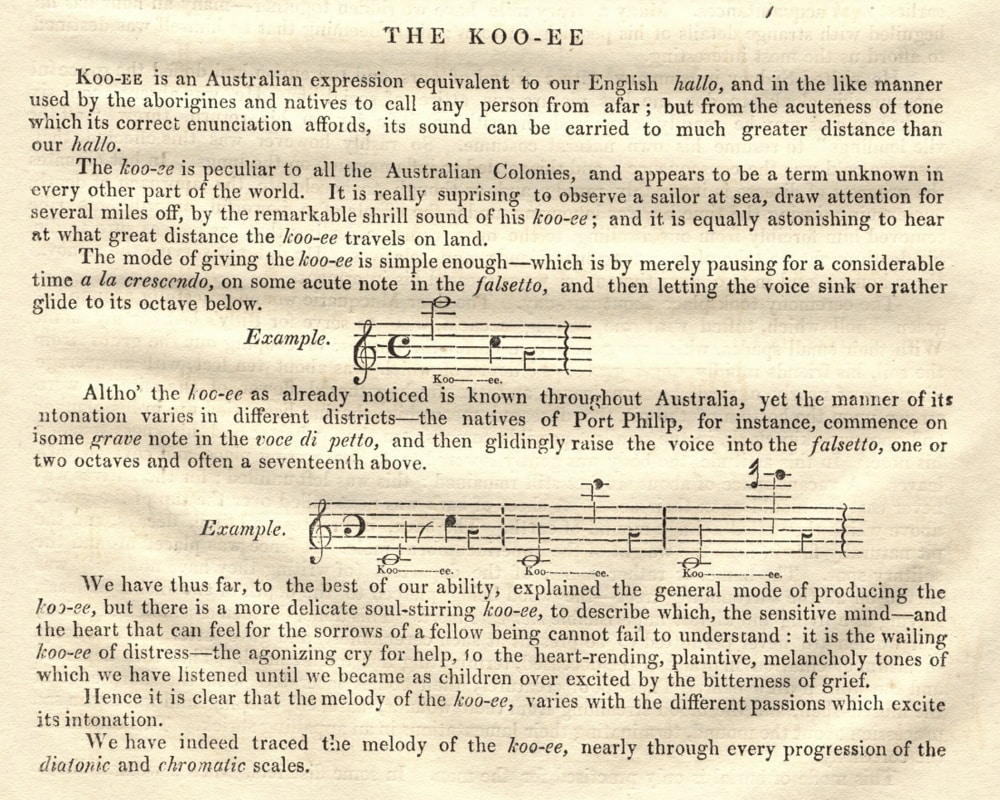
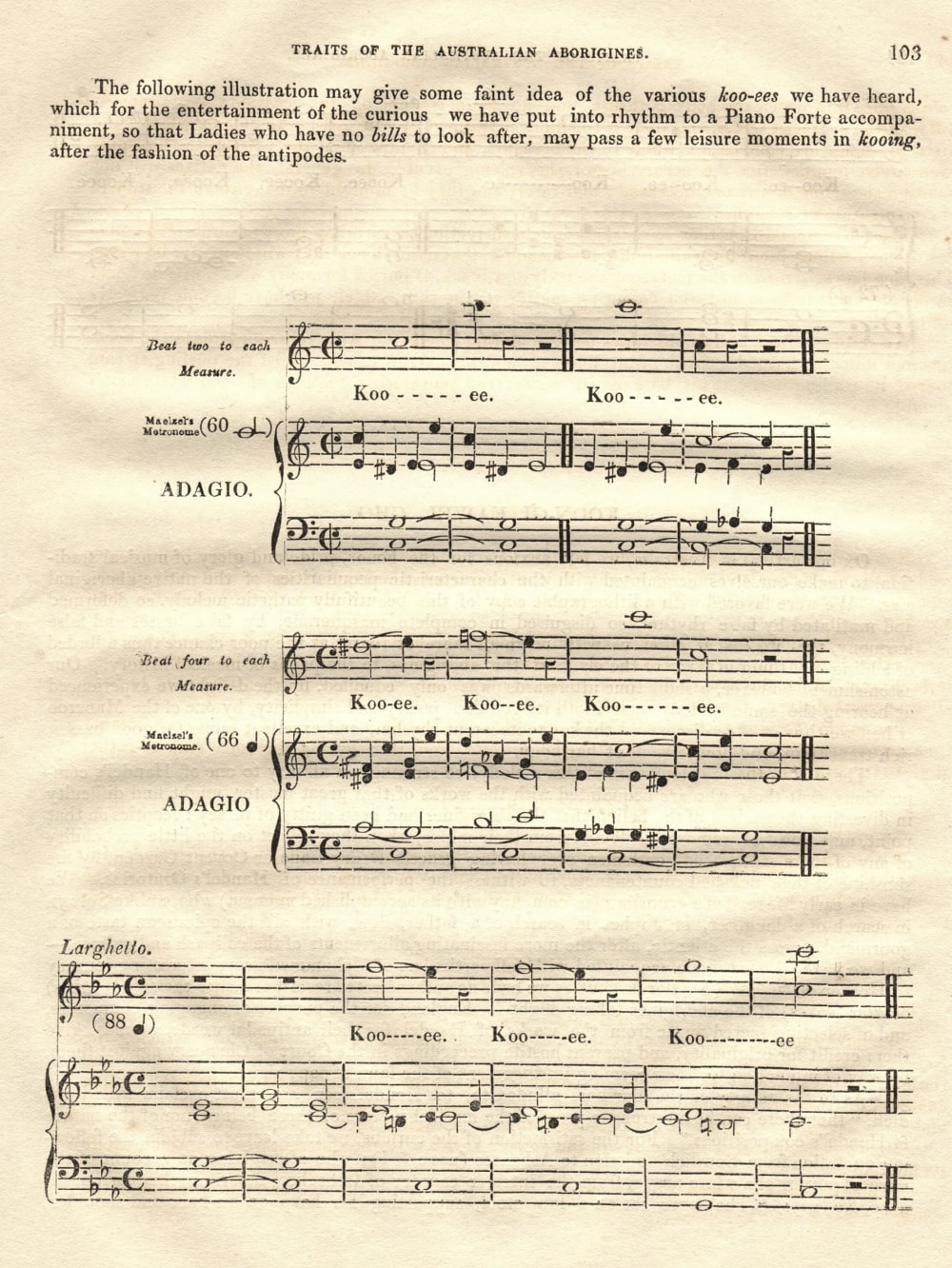
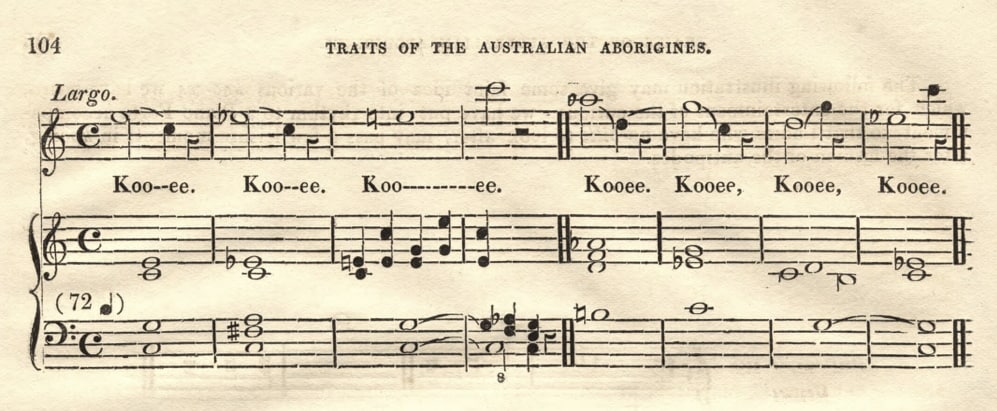
"The Koo-ee", in Isaac Nathan, The southern Euphrosyne, and Australian miscellany (Sydney: I. Nathan, [1848-49]), 102-104 (commentary and music)
https://trove.nla.gov.au/work/6685469
http://nla.gov.au/nla.obj-166023361/view#page/n111/mode/1up (DIGITISED)
https://books.google.com.au/books?id=ziwieom4lBQC&pg=PA102 (DIGITISED)
KOO-EE is an Australian expression equivalent to our English hallo, and in the like manner used by the aborigines and natives to call any person from afar; but from the acuteness of tone which its correct enunciation affords, its sound can be carried to much greater distance than our hallo.
TThe koo-ee is peculiar to all the Australian Colonies, and appears to be a term unknown in every other part of the world. It is really surprising to observe a sailor at sea, draw attention for several miles off, by the remarkable shrill sound of his koo-ee; and it is equally astonishing to hear at what great distance the koo-ee travels on land.
The mode of giving the koo-ee is simple enough - which is by merely pausing for a considerable time a la crescendo, on some acute note in the falsetto, and then letting the voice sink or rather glide to its ocatve below.
[EXAMPLE]
Altho' the koo-ee as already noticed is known throughout Australia, yet the manner of its intonation varies in different districts - the natives of Port Philip, for instance, commence on on some grave note in the voce di petto, and then glidingly raise the voice into the falsetto, one or two octaves and often a seventeenth above. [EXAMPLE]
[EXAMPLE]
We have thus far, to the best of our ability, explained the general mode of producing the koo-ee, but there is a more delicate soul-stirring koo-ee, to describe which, the sensitive mind - and the heart that can feel for the sorrows of a fellow being cannot fail to understand: it is the wailing koo-ee of distress - the agonizing cry for help, to the heart-rending, plaintive, melancholy tones of which we have listened until we became as children over excited by the bitterness of grief.
Hence it is clear that the melody of the koo-ee, varies with the different passions which excite its intonation.
We have indeed traced the melody of the koo-ee, nearly through every progression of the diatonic and chromatic scales.
[103] The following illustration may give some faint idea of the various koo-ees we have heard, which for the entertainment of the curious we have put into rhythm to a Piano Forte accompaniment, so that Ladies who have no bills to look after, may pass a few leisure moments in kooing, after the fashion of the antipodes.
[EXAMPLES]

"Koorinda Braia" [second edition, with koo-ees newly added], in Isaac Nathan, The southern Euphrosyne . . ., 129-132
http://nla.gov.au/nla.obj-166023361/view#page/n138/mode/1up (DIGITISED)
https://books.google.com.au/books?id=ziwieom4lBQC&pg=PA129 (DIGITISED)
ASSOCIATIONS: Isaac Nathan (composer, arranger, author); for full details, see main entry on Koorinda Braia
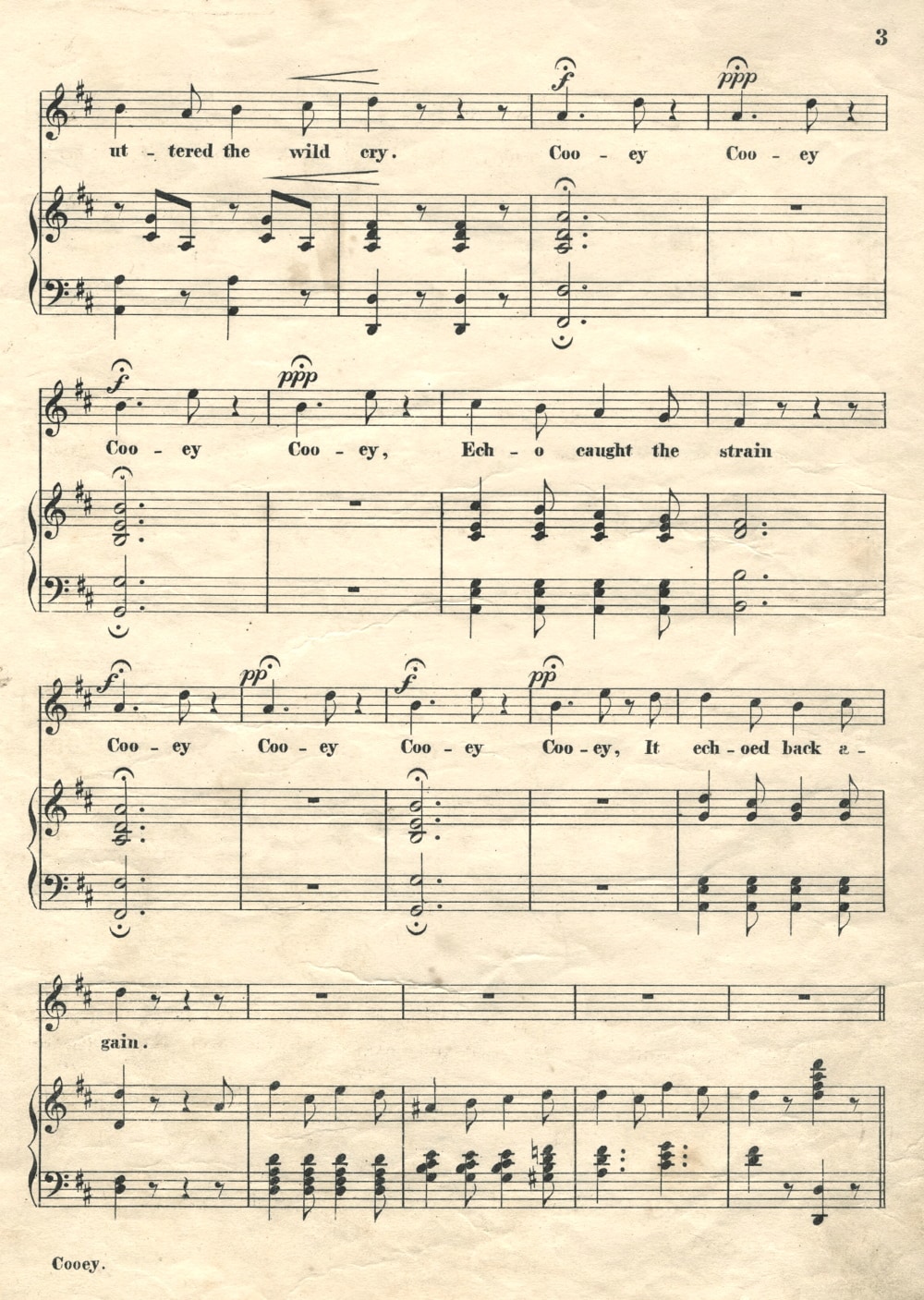
Cooey! an Australian song, words by an Australian lady, music by Spagnoletti R.A. (Sydney: John Davis, [1860])
https://trove.nla.gov.au/work/13522435
http://nla.gov.au/nla.obj-164961728 (DIGITISED)
Video recording of live performance by Elizabeth Connell (1946-2012), London, November 2010
https://www.youtube.com/watch?v=TM5FiSfDrEE (STREAMED VIDEO)
ASSOCIATIONS: Ernesto Spagnoletti (composer, arranger); "an Australian lady" = Jane Davies (lyricist)
Select bibliography (before 1901):
Peter Cunningham, Two years in New South Wales: comprising sketches of the actual state of society in that colony . . . second edition, revised and enlarged (London: Henry Colburn, 1827), volume 2, 23
https://books.google.com.au/books?id=lfxEAAAAIAAJ&pg=PA23 (DIGITISED)
. . . In calling to each other at a distance, they make use of the word Coo-ee as we do the word Hollo, prolonging the sound of the coo, and closing that of the ee with a shrill jerk. This mode of call is found to be so infinitely preferable to the Hollo, both on account of its easier pronunciation and the great distance at which it can be heard, as to have become of general use throughout the colony; and a new comer, in desiring an individual to call another back, soon learns to say "Coo-ee to him," instead of "Hollo to him" . . .
Louis de Freycinet, Voyage autour du monde entrepris par ordre du Roi . . . exécuté sur les corvettes de S. M. l'Uranie et la Physicienne, pendant les années 1817, 1818, 1819 et 1820, historique, tome deuxième - deuxième partie (Paris: Chez Pillet Ainé, 1839), 744, 774-775
http://books.google.com.au/books?id=pWNNAAAAYAAJ&pg=PA744 (DIGITISED)
. . . Cri pour se reconnaître. - Leur cri particulier pour se reconnoître de loin, est kouhi, ou encore kouh [Voyez plus bas l'article Musique], auquel répondent de la même façon ceux qui ont entendu le premier appel. A ce signal, qui n'est que d'avertissement, succède, s'il s'agit de l'arrivée d'un étranger, la phrase interrogative: qui êtes-vous! question à laquelle celui-ci doit s'empresser de satisfaire. Le nom du visiteur répété alors de bouche en bouche, se répand bientôt dans toute-la peuplade; et la réception qu'on fait ensuite au nouveau venu, est en raison de l'intérêt qu'il inspire . . .
NOTE: There is at least one extant copy of this edition (see New York Public Library exemplar) that incorrectly gives the year of publication as 1829; correctly 1839
Charles Griffith, The present state and prospects of the Port Phillip district of New South Wales (Dublin: William Curry, 1845), 65
https://archive.org/stream/presentstateand00grifgoog#page/n76/mode/2up (DIGITISED)
[FOOTNOTE] The cooey is a call in universal use amongst the settlers, and has been borrowed from the natives. The performer dwells for about half a minute [sic] upon one note, and then raises his voice to the octave. It can be heard at a great distance.
Edward E. Morris, Austral English: a dictionary of Australasian words, phrases and usages (London: Macmillan and Co., 1898), 95-96
https://archive.org/stream/australenglishdi00morruoft#page/95/mode/2up (DIGITISED)
Select bibliography (since 1901):
Roger Covell, Australia's music: themes of a new society (Melbourne: Sun Books, 1967), 69, 325
https://trove.nla.gov.au/work/21095423
See also second edition, 2016
https://trove.nla.gov.au/work/21095423/version/227555462
Nicole Saintilan, "Music - if so it may be called": perception and response in the documentation of Aboriginal music in nineteenth century Australia (M.Mus thesis, University of New South Wales, 1993), 11-16
http://hdl.handle.net/1959.4/50383 (DIGITISED)
Pru Neidorf, "Coo-ee", in John Whiteoak and Aline Scott-Maxwell (eds), Currency companion to music and dance in Australia (Sydney: Currency House, 2003), 188
https://trove.nla.gov.au/work/22233842
Graeme Skinner, Toward a general history of Australian musical composition: first national music, 1788-c.1860 (Ph.D thesis, Sydney Conservatorium of Music, University of Sydney, 2011), 62
http://hdl.handle.net/2123/7264 (DIGITISED)
Keith Vincent Smith, "1793: A Song of the Natives of New South Wales", eBLJ (Electronic British Library Journal) (2011, article 14), (1-7), 5
http://www.bl.uk/eblj/2011articles/pdf/ebljarticle142011.pdf (DIGITISED)
Jean Fornasiero and John West-Sooby, "Cross-cultural inquiry in 1802: musical performance on the Baudin expedition to Australia", in Kate Darian-Smith and Penelope Edmonds (eds), Conciliation on colonial frontiers: conflict, performance, and commemoration in Australia and the Pacific rim (New York and Oxford: Routledge, 2015), (henceforth Fornasiero and West-Sooby 2015), 17-35, esp. 25
https://books.google.com.au/books?id=VVehBgAAQBAJ&pg=PA25 (PREVIEW)
Page 25 has image of the handcopy text for the music plate of the Lesueur and Petit atlas of 1824 (Lesueur Collection, Muséum de l'Histoire Naturells, Le Harve, nos. 16057R , 16059-1)
Graeme Skinner and Jim Wafer, "A checklist of colonial era musical transcriptions of Australian Indigenous songs", in Jim Wafer and Myfany Turpin (eds), Recirculating songs: revitalising the singing practices of Indigenous Australia (Canberra: Asia-Pacific Linguistics, 2017), 365-67
http://hdl.handle.net/1885/132161
https://openresearch-repository.anu.edu.au/bitstream/1885/132161/26/17_skinner_wafer.pdf (FREE DOWNLOAD)
Commentary:
James Backhouse Walker (1890, 131) surmised that "a sound like to trumpet or small gong" heard by Abel Tasman's party in Tasmania in 1642 was 'probably a cooey'". In 1789, John Hunter reported: "We called to them in their own manner, by frequently repeating the word Cow-ee, which signifies, come here" (Hunter 1793, 120). Based on a comparison of various historical records, Jakelin Troy (1994, 79) reconstructed the phonology as /gawi/ and derives the expression from the verb gama, "to call", suffixed with (a contraction of) the third person marker -wawi (1994, 29). Dixon, Ramson and Thomas (1990, 208), on the other hand, reconstructed the phonology as /'kui/ or /ku'i/ and represented it orthographically as guuu-wi. Both analyses adopt Hunter's gloss ("come here"), although a number of the sources suggest that the expression was more a generic signal indicating one's presence and location and soliciting the same kind of response from others. Freycinet (1839, 744), for example, says that "ce signal . . . n'est que d'avertissement" (see also e. g. Cunningham 1827 v.2, 23).
References:
James Backhouse Walker, "The discovery of Van Diemen's Land in 1642: notes on the localities mentioned in Tasman's journal of the voyage", Papers and Proceedings of the Royal Society of Tasmania (1890), 274
http://eprints.utas.edu.au/16735 (DIGITISED)
. . . On [2 December 1642], early in the morning, the boat was sent to explore, and entered a bay a good 4 miles to the north-west (Blackman's Bay). The boat was absent all day, and returned in the evening with a quantity of green-stuff which was found fit to cook for vegetables. The crew reported that they had rowed some miles after passing through the entrance to the bay (now known as the Narrows). They had heard human voices, and a sound like a trumpet or small gong (probably a cooey), but had seen no one . . .
James Backhouse Walker, The discovery of Van Diemen's Land in 1642: notes on the localities mentioned in Tasman's journal of the voyage (Hobart: William Thomas Strutt, Government Printer, 1891), 6
Offprint of Walker 1890 above
http://handle.slv.vic.gov.au/10381/82203 (DIGITISED)
James Backhouse Walker, Early Tasmania; papers read before the Royal Society of Tasmania during the years 1888 to 1899 ([Hobart] Tasmania: John Vail, government printer, 1902), 131
Feprint of Walker 1890 above
https://archive.org/stream/earlytasmaniapap00walk#page/131/mode/2up (DIGITISED)
R. M. W. Dixon, W. S. Ramson and Mandy Thomas, Australian Aboriginal words in English: their origin and meaning (Melbourne: Oxford University Press, 1990)
https://trove.nla.gov.au/work/6268730
Jakelin Troy, The Sydney language (Canberra: the author, with assistance from the Australian Dictionaries Project and AIATSIS, 1994)
http://www.williamdawes.org/docs/troy_sydney_language_publication.pdf (DIGITISED)
c. 1790
2 1 song
Dharug, Sydney area, NSW
Song known to have been sung by Wangal and perhaps also Cadigal people, the words separately transcribed in or around Sydney by William Dawes (c. 1790/91), John Hunter (c. 1790/91), and David Collins (before 1796)
Music and words transcribed by Edward Jones (1752-1824), from two Wangal men, Woollarawarre Bennelong (c. 1764-1813) and Yemmerrawanne (c. 1775-1794), in London, England, mid 1793; musical transcription first published London, 1811
https://sydney.edu.au/paradisec/australharmony/checklist-indigenous-music-1.php#002 (shareable link to this entry)
Barrabu-la
2 "A SONG OF THE NATIVES OF NEW SOUTH WALES; Which was written down from the Singing of BENELONG, and YAM-ROWENY, the two Chiefs, who were brought to England some years ago from Botany Bay, by Governor Phillips [sic] (Jones 1811, 15).
text: Barrabu-la barra ma, manginè wey en-gu-na . . . [repeats] (Jones 1811, 15)
gloss: "The words are the names of deceased persons" (Collins 1798, 616); "The subject of the Song, is in praise of their Lovers" (Jones 1811, 15)
analytics: Sydney area (region); ECA (music region); South-eastern PN/ Yuin-Kuri [Sydney subgroup]/ Dharug (language)
Sources (words only):
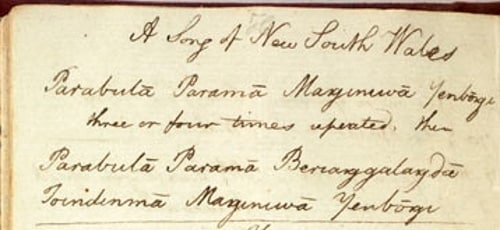
Notebooks of William Dawes, Sydney, NSW, 1790-91; University of London, School of Oriental and African Studies, MS 41645; Book B, 31: "A Song of New South Wales", perhaps taken from the singing of his regular source, the young Cadigal woman, Patyegarang:
http://www.williamdawes.org/ms/msview.php?image-id=book-b-page-31 (DIGITISED)
See also facsimile edition with introduction and commentary, David Nathan, Susannah Rayner and Stuart Brown (eds), William Dawes' notebooks on the Aboriginal language of Sydney, 1790-1791 (London: School of Oriental and African Studies, 2009), especially 41
http://www.dnathan.com/eprints/dnathan_etal_2009_dawes.pdf (DIGITISED
A Song of New South Wales
Parabulā Paramā Manginiwā Yenbōngi
three or four times repeated, then
Parabulā Paramā Berianggalangdā
Toindinmā Manginiwā Yenbōngi
ASSOCIATIONS: William Dawes (reporter, recorder); Patyegarang (singer)
John Hunter, An historical journal of the transactions at Port Jackson and Norfolk Island . . . from the first sailing of the Sirius in 1787 to the return of that ship's company to England in 1792 (London: Printed for John Stockdale, 1793), 413-14
https://collection.sl.nsw.gov.au/record/1bGMdJXY/aZKKVykrzKbJG (DIGITISED)
[413] [April 1790] . . . He [Bennelong] calls Governor Phillip, Beanga (father); and names himself Dooroow (son): the judge and commissary [David Collins] he calls Babunna (brother). He sings a great deal, and with much variety: the following are some words which were caught -
"E eye at wangewah-wandeliah chiango wandego mangenny wakey angoul barre boa lah barrema" . . .
[414] The natives sing an hymn or song of joy, from day-break until sunrise . . .
NOTE: For "E eye at wangewah-wandeliah chiango wandego" see also Fishing song (5.2) below
David Collins, An account of the English colony in New South Wales: with remarks on the dispositions, customs, manners, &c. of the native inhabitants of that country . . . (London: Printed for T. Cadell Jun. and W. Davies, 1798), 616
https://books.google.com.au/books?id=eRZcAAAAcAAJ&pg=PA616 (DIGITISED)
. . . Words of a Song:
Mang-en-ny-wau-yen-go-nah, bar-ri-boo-lah, bar-re-mah.
This they begin at the top of their voices, and continue
as long as they can in one breath, sinking to the lowest note, and then rising again to the highest. The words are the names of deceased persons . . .
Source (words and music):
Edward Jones, Musical curiosities; or, a selection of the most characteristic national songs, and airs; many of which were never before published: consisting of Spanish, Portuguese, Russian, Danish, Lapland, Malabar, New South Wales, French, Italian, Swiss, and particularly some English and Scotch national melodies, to which are added, variations for the harp, or the piano-forte, and most humbly inscribed, by permission, to her royal highness the princess Charlotte of Wales . . . (London: Printed for the author, 1811), 15 (music and words)
http://www.worldcat.org/oclc/497313581
http://www.worldcat.org/oclc/16450109
Facsimile in Keith Vincent Smith, "1793: A Song of the Natives of New South Wales", eBLJ (Electronic British Library Journal) (2011, article 14), (1-7), 1 (exemplar London, British Library, R.M.13.f.5)
http://www.bl.uk/eblj/2011articles/pdf/ebljarticle142011.pdf (DIGITISED)
Facsimile in Smith 2012, [n.p.] (exemplar London, British Library, R.M.13.f.5)
https://books.google.com.au/books?id=E0PIa25UCMAC&pg=PT96 (PREVIEW)
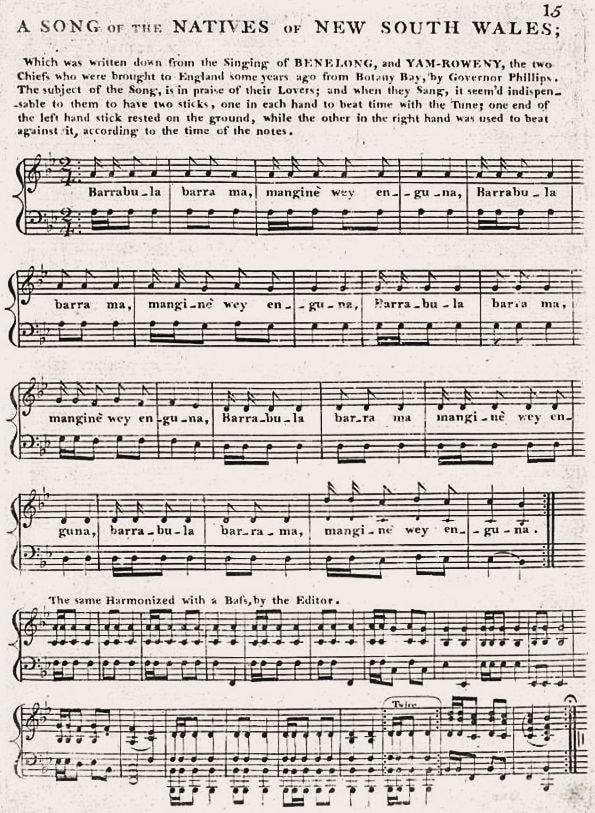
A SONG OF THE NATIVES OF NEW SOUTH WALES; Which was written down from the Singing of BENELONG, and YAM-ROWENY, the two Chiefs, who were brought to England some years ago from Botany Bay, by Governor Phillips [sic]. The subject of the Song, is in praise of their Lovers; and when they Sang, it seem'd indispensible to them to have two sticks, one in each hand to beat time with the Tune; one end of the left stick rested on the ground, while the other in the right hand was used to beat against it, according to the time of the notes.
Facsimile below, of source song only (exemplar London, British Library, R.M.13.f.5)
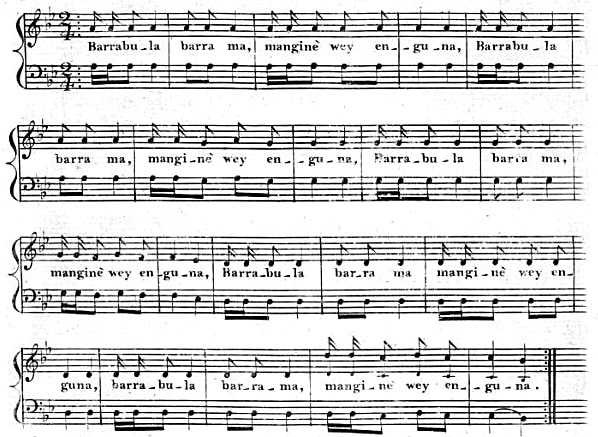
Barrabula barra ma, manginè wey enguna,
Barrabula barra ma, manginè wey enguna,
Barrabula barra ma, manginè wey enguna,
Barrabula barra ma, manginè wey enguna,
barrabula barra ma, manginè wey enguna.
The same Harmonized with a Bass, by the Editor
Facsimile below, of Jones's arrangement ("variation for the harp, or the piano-forte") only (exemplar London, British Library, R.M.13.f.5)
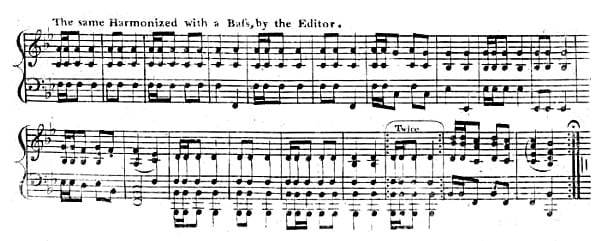
Sound:
Melody and rhythm as transcribed by Edward Jones, 1793 (Jones 1811), synthesised using bass woodwind sounds as approximations for voices, Australharmony 2016; for ease of comparison see images below from Engel 1866, 26-27
medialocal/1793-barrabula-song-mod.wav
Harmonised version (Jones 1811), synthesised for harp, Australharmony 2016
Keith Vincent Smith, "1793: A Song of the Natives of New South Wales", eBLJ (Electronic British Library Journal) (2011, article 14), (1-7), 7
http://www.bl.uk/eblj/2011articles/pdf/ebljarticle142011.pdf
Page 7 of the pdf has an embedded sound file of Barrabu-la (c.1790), and Harry's Song (c.1820) performed in traditional style by two Indigenous Australian performers, Clarence Slockee and Matthew Doyle, at the opening of the Mari Wari exhibition, State Library of New South Wales, Sydney, 24 September 2010
Another slightly varied take, by the same artists, of Barrabu-la (streamed ABC Radio)
http://mpegmedia.abc.net.au/rn/podcast/extra/2011/hht_20110403_BennelongYemmerrawanneLivePerformance.mp3 (STREAMED SOUND)
"GUYANAYA BAYUI: OLD PEOPLE, FUTURE", Deepening Histories (Australian National University)
http://deepeninghistories.anu.edu.au/sites/music-day/play.php?UUID=90f02a58-4b8c-4a0d-ab43-ad32211343f1 (STREAMED VIDEO)
Newly imagined performances in contemporary experimental idiom, by Richard Green, Karen Smith, Matt Doyle, Clarence Slockee, with Kevin Hunt, features Barabul-la (c. 1790), Chant (1802), and Harry's Song (c. 1820)
Bibliography and resources:
Carl Engel, An introduction to the study of national music: comprising researches into popular songs, traditions, and customs (London: Longmans, Green, Reader, and Dyer, 1866), 26-27 (see music images below)
https://archive.org/stream/introductiontost00enge#page/26/mode/2up (DIGITISED)
http://books.google.com.au/books?id=0k4QAAAAYAAJ&pg=PA26 (DIGITISED)
. . . In the following song of the natives of New South Wales we have a succession of diatonic intervals in descending. Edward Jones states that this air "was written down from the singing of Benelong and Yamroweny, the two chiefs who were brought to England, some years ago, from Botany Bay, by Governor Phillips. The subject of their song is in praise of their lovers; and when they sang, it seemed indispensable to them to have two sticks, one in each hand, to beat time with the tune; one end of the left-hand stick rested on the ground, while the other in the right hand was used to beat against it, according to the time of the notes. [Musical Curiosities, by Edward Jones, London, 1811, p. 15.] . . .
Reproduces words and melody only, after Jones 1811


James Bonwick, Daily life and origins of the Tasmanians (London: Samson, Low, Son, and Marston: 1870), 33
https://archive.org/stream/dailylifeandori02bonwgoog#page/n51/mode/2up (DIGITISED)
https://books.google.com.au/books?id=rQ5zAAAAMAAJ&pg=PA33 (DIGITISED)
. . . The first native song was published by Mr. Edward Jones of London in 1811, in "Musical Curiosities." It was taken from a love-song sung by Bennilong and Yamroweng [sic], on their visit to England in the beginning of this century [sic]. "It shows," says Carl Engel, "a succession of diatonic intervals in descending." It is placed in two flats . . .
Reproduces words and melody, copied from Engel 1866, cites Jones
Richard Wallaschek, Primitive music: an inquiry into the origin and development of music, songs, instruments, dances, and pantomimes of savage races (London; New York: Longmans, Green, and Co., 1893), 41
https://archive.org/stream/primitivemusicin00wall#page/41/mode/2up (DIGITISED)
. . . Bonwick quotes two Australian songs borrowed from B. Field and Edward Jones, which are said to be "similar" to the Tasmanian . . .
Reference only, after Bonwick 1870
Richard Wallaschek, Anfänge der Tonkunst (Leipzig: Johann Ambrosius Barth, 1903), 41
https://archive.org/stream/anfngedertonkuns00wall#page/41/mode/2up (DIGITISED)
From Wallaschek 1893, reference only, after Bonwick 1870
Alice M. Moyle, "Tasmanian music, an impasse?", Records of the Queen Victoria Museum, Launceston 26 (May 1968), (1-18), 6, 17
From Bonwick 1870
Keith Vincent Smith and kathryn Lamberton (eds), Mari nawi: Aboriginal odysseys 1790-1850 (Sydney: State Library of New South Wales, 2010), 20
https://collection.sl.nsw.gov.au/record/74VKMePLWedM
https://www2.sl.nsw.gov.au/archive/events/exhibitions/2010/mari_nawi/docs/marinawi_guide.pdf (DIGITISED)
Includes facsimile of Jones 1811, 15
Graeme Skinner, Toward a general history of Australian musical composition: first national music, 1788-c.1860 (Ph.D thesis, Sydney Conservatorium of Music, University of Sydney, 2011), 62-63
http://hdl.handle.net/2123/7264 (DIGITISED)
Keith Vincent Smith, "1793: A Song of the Natives of New South Wales", eBLJ (Electronic British Library Journal)
(2011, article 14), 1-7
http://www.bl.uk/eblj/2011articles/pdf/ebljarticle142011.pdf (DIGITISED)
Page 1 has facsimile of Jones 1811, 15, and page 7 embedded sound file of a 2010 performance of the song by Indigenous singers in Sydney (see sound above)
Keith Vincent Smith, "Tubowgule (Bennelong Point)", and "Bennelong's Song", in Ewen McDonald (ed.), Site (Sydney: Museum of Contemporary Art, 2012), [unpaginated]
https://trove.nla.gov.au/version/175905666
https://books.google.com.au/books?id=E0PIa25UCMAC&pg=PT93 (PREVIEW)
Includes facsimile of Jones 1811, 15 (96)
https://books.google.com.au/books?id=E0PIa25UCMAC&pg=PT96 (PREVIEW)
Graeme Skinner and Jim Wafer, "A checklist of colonial era musical transcriptions of Australian Indigenous songs", in Jim Wafer and Myfany Turpin (eds), Recirculating songs: revitalising the singing practices of Indigenous Australia (Canberra: Asia-Pacific Linguistics, 2017), 367-68
http://hdl.handle.net/1885/132161
https://openresearch-repository.anu.edu.au/bitstream/1885/132161/26/17_skinner_wafer.pdf (FREE DOWNLOAD)
Commentary:
The music and words of this song were taken down by Edward Jones (1752-1824), a Welsh harpist, in London in mid 1793 from the singing of Bennelong and Yemmerrawanne, the two Wangal men who had been brought from Sydney to England by Arthur Phillip.
The words were also separately transcribed in or around Sydney by William Dawes (c. 1790/91), John Hunter (c. 1790/91), and David Collins (before 1796).
Keith Vincent Smith (2011) reliably fixed the performance at sometime between late May and October 1793, at or near the singers' then lodgings, in the house of William Waterhouse (father of Henry Waterhouse) at 125 Mount Street, Mayfair, near Berkeley Square, London. Smith discovered that Jones, Welsh harpist and bard to the prince of Wales (later George IV), was then living at 122 Mount Street.
References:
[Review of Jones 1811], The Monthly Magazine 34 (1 August 1812), 54
http://books.google.com.au/books?id=C2eP-ZRhnOwC&pg=PA54 (DIGITISED)
Musical Curiosities, or a Selection of National Songs and Airs, by Edward Jones, Bard to His Royal Highness the Prince Regent. 10s 6d.
Mr. Jones, of whose industry, as a gleaner of national music, we have often had occasion to speak, has furnished, in the present collection, a great number of popular, and some exceedingly curious, foreign and domestic airs. The whole occupies forty-two folio pages, and forms a body of variegated and well chosen melodies, that do much credit to the selector's judgment, and will be found highly acceptable to the public.
"IN MEMORY OF YEMMERRAWANNIE", The Register (24 April 1914), 12
http://nla.gov.au/nla.news-article58499993 (DIGITISED)
Jack Brook, "The forlorn hope: Bennelong and Yemmerrawannie go to England", Australian Aboriginal Studies (2001), 36-47
http://search.informit.com.au/documentSummary;dn=593850834183257;res=IELIND (PAYWALL)
. . . By 6 July 1793, the two 'Natives' had moved from their original lodging house to the residence of Mr. Waterhouse, Mount Street, Grosvenor Square, in the fashionable West End of London. They continued to have the services of a servant and their clothes were mended and washed as required. Books were acquired and a 'Reading Master' and a 'Writing Master' were hired to school the two men in those subjects. The education of his guests had always been the intention of Governor Phillip for, once they understood English, 'much information' could be obtained from them . . .
Kate Fullagar, "Bennelong in Britain", Aboriginal History 33 (2010), 31-51
http://doi.org/10.22459/AH.33.2010 (PDF FREE DOWNLOAD)
1802
3 2 songs
Dharug, Sydney area, NSW
Transcribed by Charles Alexandre Lesueur (1778-1846) and Pierre François Bernier (1779-1803), members of the Baudin expedition, from unidentified singers, probably in the Sydney area, between late June and November 1802; first published Paris, 1824
https://sydney.edu.au/paradisec/australharmony/checklist-indigenous-music-1.php#003 (shareable link to this entry)
Source:
Charles Alexandre Lesueur and Nicolas-Martin Petit, Voyage de découvertes aux terres Australes; historique, atlas par MM. Lesueur et Petit, seconde édition (Paris: Chez Arthus Bertrand, 1824), plate 32, page 52, nos 1 and 2
https://books.google.com.au/books?id=aXVdAAAAcAAJ&pg=PA32 (DIGITISED)
https://trove.nla.gov.au/work/20117482
http://nla.gov.au/nla.obj-32726430 [plate only] (DIGITISED)
http://www.ngv.vic.gov.au/explore/collection/work/98350 [plate only] (DIGITISED)
Musique des sauvages de la Nouvelle-Galles du Sud divers airs notés [table of contents]
[Pl.] 32
1 Chant [music only]
2 Air de danse [music and words]
é é Con gô Lanmba Lamnba é é Con gô Lanmba Con gô. [rep.]
pouhé pouhé pouhé pouhé pouhé pouhé pouhé [reps.]
3 Cri de ralliement . . .
Lesueur et Bernier notaverunt . . .
Nouvelle-Hollande. N[ouv]elle Galles du Sud . . .
For no. 3 Cri de ralliement, see this page 1 above
3.1 Song
3.1 "1. Chant" ("song")
text: [music only, no words]
analytics: Sydney area (region); ECA (music region); South-eastern PN/ Yuin-Kuri [Sydney subgroup]/ Dharug (language)
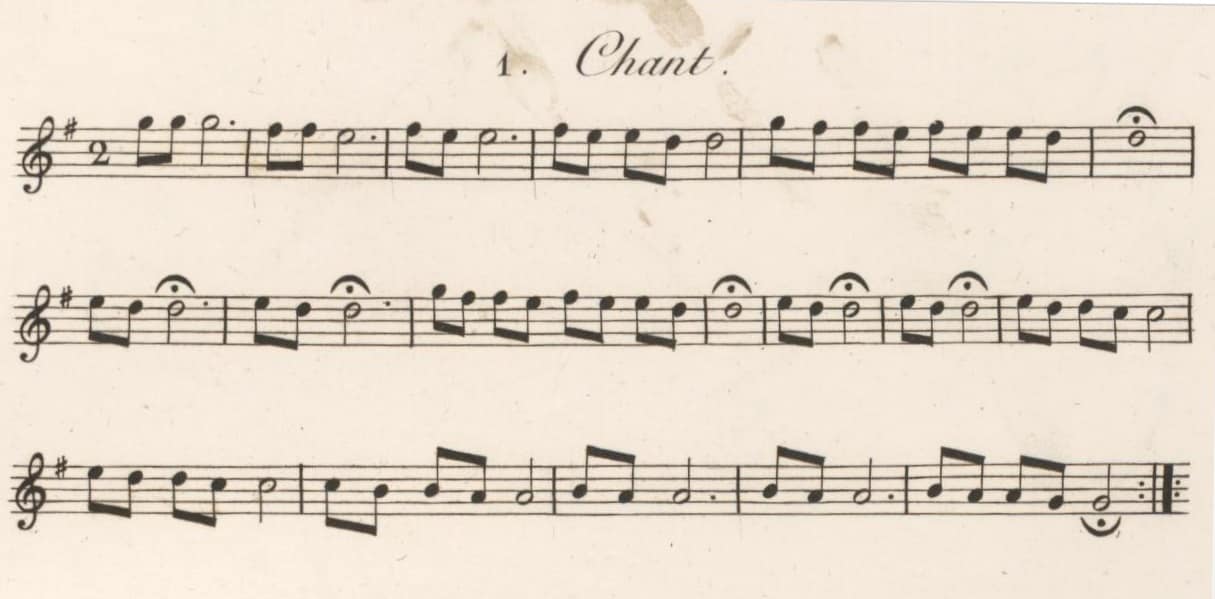
3.2 Dance chant
3.2 "2. Air de danse" ("dance song")
text: [Women] é é Con gô Lanmba Lanmba é é Con gô Lanmba Con gô . . . [repeats]; [Men] pouhé pouhé pouhé pouhé pouhé pouhé pouhé . . . [repeats] [notated in 2 parts, rhythms only, no melodies]
analytics: As for 3.1
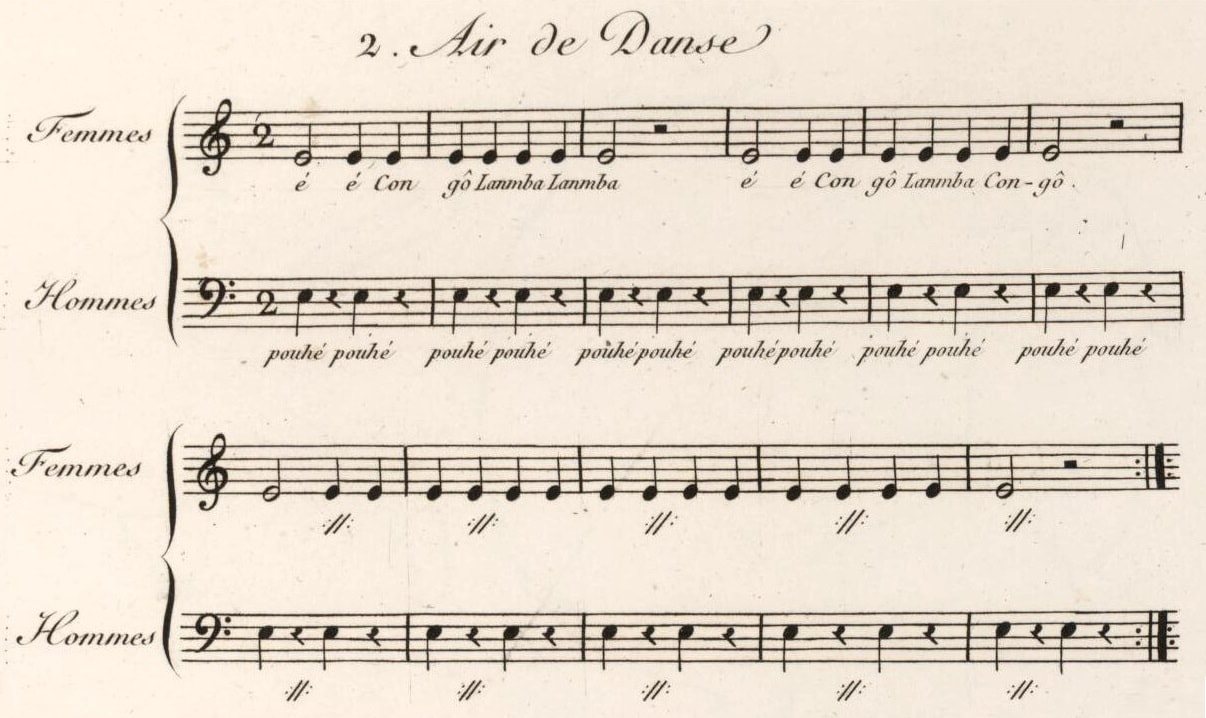
Sound:
"GUYANAYA BAYUI: OLD PEOPLE, FUTURE", Deepening Histories (Australian National University)
Newly imagined performances in contemporary experimental idiom, by Richard Green, Karen Smith, Matt Doyle, Clarence Slockee, with Kevin Hunt, features Barabul-la (c.1790), Chant (1802), and Harry's Song (c.1820)
Bibliography and resources:
Louis de Freycinet, Voyage autour du monde entrepris par ordre du Roi . . . exécuté sur les corvettes de S. M. l'Uranie et la Physicienne, pendant les années 1817, 1818, 1819 et 1820, historique, tome deuxième - deuxième partie (Paris: Chez Pillet Ainé, 1839), tome 2, 2 part, 775
http://books.google.com.au/books?id=pWNNAAAAYAAJ&pg=PA775 (DIGITISED)
https://nla.gov.au/nla.obj-32726166/view?partId=nla.obj-32726430#page/n1/mode/1up (PLATE ONLY)
No.3 Air (1839) = 1 Chant (1824), tranposed down a tone
Karl Hagen, Über die Musik einiger Naturvölker (Australier, Melanesier, Polynesier) (Dissertation, University of Jena) (Hamburg: Ferdinand Schlotke, 1892), 9-13 (commentary), plate II, example 5 (music)
https://trove.nla.gov.au/work/30068490
https://books.google.com.au/books?id=L-saAAAAYAAJ&pg=PA9 - commentary (DIGITISED)
https://books.google.com.au/books?id=L-saAAAAYAAJ&pg=PT4 - plate II (DIGITISED)
Richard Wallaschek, Primitive music: an inquiry into the origin and development of music, songs, instruments, dances, and pantomimes of savage races (London; New York: Longmans, Green, and Co., 1893), 36-37 (commentary), [343] (music example 5.3)
https://archive.org/stream/primitivemusicin00wall#page/36/mode/2up commentary (DIGITISED)
https://archive.org/stream/primitivemusicin00wall#page/n343/mode/2up music example 5.3 (DIGITISED)
Example 5.3 ("Larghetto") = 3.1 above, from Freycinet 1839
Richard Wallaschek, Anfänge der Tonkunst (Leipzig: Johann Ambrosius Barth, 1903), 36-37, 342
https://archive.org/stream/anfngedertonkuns00wall#page/36/mode/2up commentary (DIGITISED)
https://archive.org/stream/anfngedertonkuns00wall#page/342/mode/2up music example 5.3 (DIGITISED)
Example 5.3 ("Larghetto") = 3.1 above, from Freycinet 1839
Nicole Saintilan, "Music - if so it may be called": perception and response in the documentation of Aboriginal music in nineteenth century Australia (M.Mus thesis, University of New South Wales, 1993), 11-16
http://hdl.handle.net/1959.4/50383 (DIGITISED)
Graeme Skinner, Toward a general history of Australian musical composition: first national music, 1788-c.1860 (Ph.D thesis, Sydney Conservatorium of Music, University of Sydney, 2011), 62, 432
http://hdl.handle.net/2123/7264 (DIGITISED)
Keith Vincent Smith, "1793: A Song of the Natives of New South Wales", eBLJ (Electronic British Library Journal) (2011, article 14), (1-7)
http://www.bl.uk/eblj/2011articles/pdf/ebljarticle142011.pdf (DIGITISED)
Jean Fornasiero and John West-Sooby, "Cross-cultural inquiry in 1802: musical performance on the Baudin expedition to Australia", in Kate Darian-Smith and Penelope Edmonds (eds), Conciliation on colonial frontiers: conflict, performance, and commemoration in Australia and the Pacific rim (New York and Oxford: Routledge, 2015), especially 24-25
https://books.google.com.au/books?id=VVehBgAAQBAJ&pg=PA24 (PREVIEW)
Page 24 reproduces (? Bernier's original) handwritten notation of the "Air des Naturels de la N[ouve]lle Hollande au Port Jackson" (below) and page 25 the copy text for the music plate of the Lesueur and Petit atlas of 1824 (Lesueur Collection, Muséum de l'Histoire Naturells, Le Harve, nos. 16057R , 16059-1)
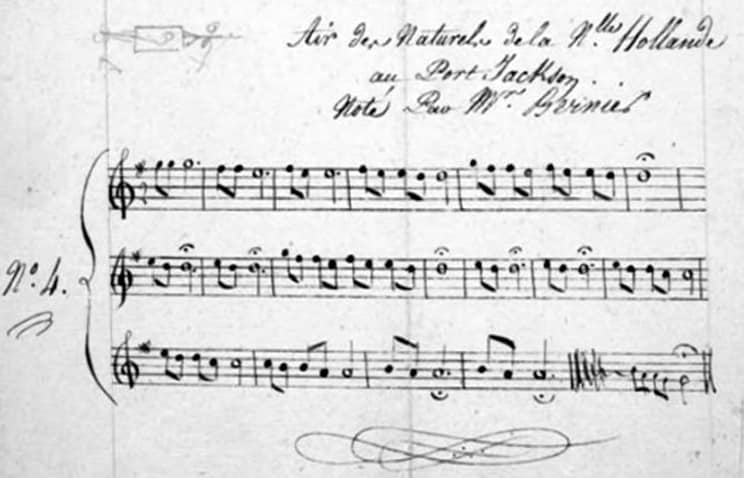
Jean Fornasiero, Lindl Lawton, and John West-Sooby (eds), The art of science: Nicolas Baudin's voyagers 1800-1804 (Mile End: Wakefield Press, 2016), 21
A higher quality colour reproduction of a manuscript fair copy of Bernier's transcription of 3.1 (c.f. lower quality image in Fornasiero and West-Sooby 2015 above)
Vivonne Thwaites, "Discovering the art of Lesueur" (pages 4-11); and Jean Fornasiero, "Music from the Littoral" (30-35), in Vivonne Thwaites (curator) and Jean Fornasiero, Littoral [exhibition catalogue] (Hobart: Carnegie Gallery, 8 April-10 May 2010, Carnegie Gallery; Burnie: Burnie Regional Art Gallery, 30 July-12 September 2010)
Graeme Skinner and Jim Wafer, "A checklist of colonial era musical transcriptions of Australian Indigenous songs", in Jim Wafer and Myfany Turpin (eds), Recirculating songs: revitalising the singing practices of Indigenous Australia (Canberra: Asia-Pacific Linguistics, 2017), 368-69
http://hdl.handle.net/1885/132161
https://openresearch-repository.anu.edu.au/bitstream/1885/132161/26/17_skinner_wafer.pdf (FREE DOWNLOAD)
Commentary:
Noted down by members of Nicolas Baudin's expedition in NSW, Winter and Spring 1802, and added by Lesueur and Petit to the second edition of their Atlas (1824); some general details of the visit are discussed in the text of volume 1 of the set (Peron and Freycinet 1824).
References:
François Péron and Louis de Freycinet, Voyage de découvertes aux terres Australes: fait par ordre du gouvernement, sur les corvettes les Géographe, le Naturaliste, et la goëlette le Casuarina, pendant les années 1800, 1801, 1802, 1803 et 1804; historique . . . seconde édition . . . tome 1 (Paris: Arthus Bertrand, 1824)
https://books.google.com.au/books?id=ZD8bAAAAYAAJ&pg=PR3 (DIGITISED)
c.1805
4 1 song
? Dharug, ? Sydney area, NSW
Music and words transcribed from unidentified singers, probably in the Sydney region, probably c.1800-05, and "brought over [to UK] by an officer from NSW"; first published in Britain (? Scotland, c.1802-10)
https://sydney.edu.au/paradisec/australharmony/checklist-indigenous-music-1.php#004 (shareable link to this entry)
Wahabindeh bang ha nel ha
4 "A New-South-Wales song"
text: Wa ha bin deh bang ha nel ha Wa ha bin deh bang ha nel ha Wa ha bin deh bang ha nel ha Hoh hoh hoh hoh hoh hoh (D.C. ad lib.)
analytics: ? Sydney area (region); ECA (music region); South-eastern PN/ ? Yuin-Kuri [Sydney subgroup]/ ? Dharug (language)
Source:
National Library of Scotland, Inglis Collection of printed music, Ing.72(1-3) [ID: 94733017], a composite music volume in 3 sections;
Section 3 (unidentified collection of "national music" of various nations, including glees, catches, rounds, etc., titlepage missing), No. 36, page [43]
http://digital.nls.uk/special-collections-of-printed-music/pageturner.cfm?id=94737053 (DIGITISED)
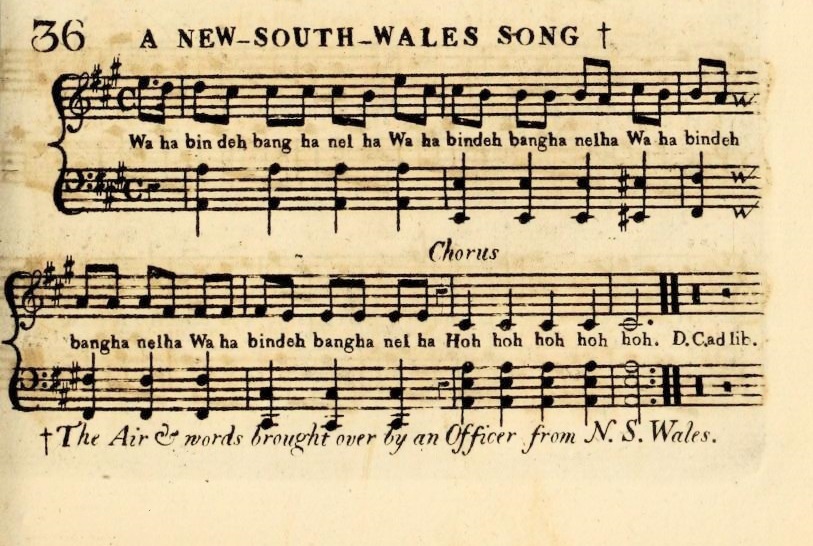
36 A NEW-SOUTH-WALES SONG. The Air & words brought over by an Officer from N. S. Wales.
Wa ha bin deh bang ha nel ha
Wa ha bin deh bang ha nel ha
Wa ha bin deh bang ha nel ha
Hoh hoh hoh hoh hoh hoh. (D.C. ad lib.)
Sound:
Melody only, synthesised using bass woodwind sounds as approximations for voices; synthesised sound file, Australharmony 2016
medialocal/1800-wa-ha-bin-deh-song.wav
Harmonised version, for piano, synthesised, Australharmony 2016
Bibliography and resources:
Graeme Skinner, "The invention of Australian music", Musicology Australia 37/2 (2015), 296-98
http://dx.doi.org/10.1080/08145857.2015.1076594 (PAYWALL)
ONSITE PDF (FREE DOWNLOAD)
Graeme Skinner and Jim Wafer, "A checklist of colonial era musical transcriptions of Australian Indigenous songs", in Jim Wafer and Myfany Turpin (eds), Recirculating songs: revitalising the singing practices of Indigenous Australia (Canberra: Asia-Pacific Linguistics, 2017), 369
http://hdl.handle.net/1885/132161
https://openresearch-repository.anu.edu.au/bitstream/1885/132161/26/17_skinner_wafer.pdf (FREE DOWNLOAD)
Commentary (GS):
In November 2014, while searching on likely word strings for possible Australian material in the digital music archive of the National Library of Scotland, I stumbled across this elsewhere undocumented and previously unrecognised source of an early colonial transcription of the words and music of an Australian Indigenous song. So far as I have been able to establish (July 2015), no one has previously registered its existence part from the NLS's own autoscanners and cataloguers. So, as another example of a very early transcription and arrangement of melody and words of an Indigenous song, it seems, for Australian music history, to be an entirely new find.
Under the title "A New-South-Wales Song . . . Air & Words brought over by an Officer from N. S. Wales", it appears as number 36 of 79 extant items (Nos 1-79) in an unidentified and possibly incomplete 98-page mixed collection of airs and duets with instrumental basses, instrumental dances, and three- and four-part glees and rounds, lacking a titlepage or any other indication of its origins.
As well as familiar English, Scottish, Welsh, and Irish numbers, there are also 2 carols from the Orkneys, some Russian dances, numerous French and German songs in the original languages, the widely occurring Death Song of the Cherokees, and a keyboard arrangement of an "Hindoostan Air" called Dandee Kala, which had appeared previously (as as "Dande ka la") in Bird's Oriental Miscellany (1789).
One item fixes the collection's publication date at no earlier than 1802. Item 34, a curious Runa of the Finlanders, in 5/4 time, was, as the source acknowledges, excerpted from Joseph Acerbi's Travels through Sweden, Finland and Lapland, published in London in 1802. There the same Runa appears on page 324 as the first items in an extensive music supplement to the second volume, signed at the end "Engrav'd by E. RILEY, No 8, Strand" (336).
A comparison of shows that the two are not only musically identical but also similar enough in format and detail for both to be the work of Edward Riley (1769-1829). Having already engraved it for Acrebi's book, he plausibly included it again in this collection, either to be issued under his own imprint, or perhaps engraved by him for another publisher. If so, since Riley sold up his music retail and publishing business and left London for New York by 1805 (possibly earlier), and assuming that this collection was indeed as most likely published in Britain, we could date the unidentified collection certainly to after 1802, and probably to before 1805.
The earliest music-and-words transcription of an Indigenous Australian song known to survive is A song of the natives of New South Wales (see 2 above), taken down in London in 1793 from the singing of Bennelong and Yemmeroweney; however, Jones published it only 18 years later, in 1811. Likewise, the three music-and-words transcriptions taken down by members of the Baudin expedition in 1802 (see 1 above and 3 above) were not published until 1824. So, if not the earliest taken down, it is, unless another so far unknown early example is belatedly discovered, the earliest in print, probably by at least five or six years.
Of the otherwise unidentified "Officer from N. S. Wales" by whom the "air and words were brought over" from New South Wales back to Britian, a retiring member of the NSW Corps, or a returning naval officer, are possible candidates.
Despite the fact that the song appears to have been imperfectly observed and somewhat remodelled, the melodic contour and the short, repeated text seem to be at least vestigially authentic.
References:
Special collections of printed music (digitised), Glen and Inglis collections of printed music, National Library of Scotland
http://digital.nls.uk/special-collections-of-printed-music
No. 34, page [41], "Runa of the Finlanders"
http://digital.nls.uk/special-collections-of-printed-music/pageturner.cfm?id=94737029 (DIGITISED)
No. 60, page [75] "The Death Song of the Cherokees"
http://digital.nls.uk/special-collections-of-printed-music/pageturner.cfm?id=94737437 (DIGITISED)
No. 66 (page [81]) "Dandee Kala. Hindoostan Air"
http://digital.nls.uk/special-collections-of-printed-music/pageturner.cfm?id=94737509 (DIGITISED)
"Dande ka la", in William Hamilton Bird (ed.), The oriental miscellany (Calcutta: Jo[se]ph Cooper, 1789), 18
https://imslp.org/wiki/Special:ReverseLookup/244380 (DIGITISED)
Joseph Acerbi, Travels through Sweden, Finland and Lapland . . . vol. 2 (London: Printed for Joseph Mawman, 1802), 325, 336
https://archive.org/stream/travelsthroughsw02inacer#page/325 (DIGITISED)
https://archive.org/stream/travelsthroughsw02inacer#page/336 (DIGITISED)
"Riley, Edward", in Frank Kidson, British music publishers, printers and engravers . . . (London: W. E. Hill, 1900), 110
https://archive.org/stream/cu31924021638402#page/n125/mode/2up (DIGITISED)
"Riley, Edward, sen.", in Nancy Groce, Musical instrument makers of New York: a directory of eighteenth and nineteenth century urban craftsmen (New York: Pendragon Press, 1999), 131
https://books.google.com.au/books?id=EjYjD4vQbCYC&pg=PA131 (PREVIEW)
Wendell Dobbs, "An early American family of flutists", The Flutist Quarterly (Fall 2008), 40-44
http://mds.marshall.edu/music_faculty/1
"Riley, Edward (b. England, 1769; d. Yonkers, NY, 18 Aug 1829). Music engraver and publisher, teacher, and composer, of English birth", The Grove Dictionary of American Music (2nd edition, New York: Oxford University Press, 2013)
1819
5 2 songs
Dharug, Sydney area, NSW
Music (and words for 5.2) transcribed by, or on behalf of, Louis de Freycinet (1779-1842), Sydney area, between 19 November and 25 December 1819; first published Paris, 1839
Words of 5.2 also recorded earlier by (1) John Hunter, from the singing of Bennelong (published 1793); and (2) David Collins (published 1798)
https://sydney.edu.au/paradisec/australharmony/checklist-indigenous-music-1.php#005 (shareable link to this entry)
Source and documentation (5.1 and 5.2):
Louis de Freycinet, Voyage autour du monde entrepris par ordre du Roi . . . exécuté sur les corvettes de S. M. l'Uranie et la Physicienne, pendant les années 1817, 1818, 1819 et 1820, historique, tome deuxième - deuxième partie (Paris: Chez Pillet Ainé, 1839), 771-75 (commentary and music)
http://books.google.com.au/books?id=pWNNAAAAYAAJ&pg=PA772 (DIGTISED)
[771] . . . Réunions de famille. - Les individus dont chaque tribu se compose [772] se rassemblent à diverses saisons de l'année, soit pour se consulter dans les affaires de quelque importance, soit pour se réjouir à l'occasion de certaines têtes. Cependant, quoiqu'il y ait communauté d'intérêt dans ces réunions, chaque famille est obligée d'avoir son feu à part et de pourvoir à sa subsistance. Cette règle est générale, hormis le cas où l'on fait la grande chasse aux kanguroos, à laquelle toute la tribu doit coopérer; aussitôt que le gibier a été cerné et pris en suffisante quantité, on le partage de bonne foi, et chacun s'en régale: telle est la fête des kanguroos.
Les autres fêtes des naturels ont toutes pour objet de manger et de danser ensemble, pendant plusieurs jours de suite. C'est tantôt la fête des huîtres, et alors ils se réunissent sur un point où ils puissent se procurer en abondance cet excellent coquillage; d'auïres fois c'est la fête des fougères ou celle [?] lis, et alors la racine du premier, ou la tige du second de ces végétaux, fait les frais du festin.
Il seroit difficile, dans ces circonstances, de persuader à un naturel de ne pas se joindre à ses compatriotes, ou même de se séparer d'eux pendant l'assemblée, quel que fût d'ailleurs le motif qu'on voulût faire valoir.
Une baleine échoue-t-elle sur la côte, tous les habitans d'alentour, qui en sont bientôt informés, se pressent autour du monstre, puis comme autant de loups affamés, ils s'acharnent sur la bête sans la quitter, tant qu'il en reste quelque débris: c'est ce qu'on nomme fête de la baleine. En pareil cas, on a vu plusieurs tribus distinctes se grouper sur le même point; mais il n'est pas rare que de telles réjouissances soient troublées par des altercations graves et même par des engagemens meurtriers.
Danses. - Les autres fêtes dont nous avons parlé sont toujours plus pacifiques, et solennisées par des danses de nuit ou korroberis, pour lesquelles les indigènes sont extrêmement passionnés. Jamais ils ne s'y rendent sans se peindre le corps et la face de blanc et de rouge, ainsi que nous l'avons exposé ailleurs. L'éclat d'un vaste brasier donne un effet pittoresque à cette scène sauvage; et la danse bientôt animant les acteurs, les conduit graduellement à une sorte d'enthousiasme.
La coutume est de danser ainsi la nuit autour d'un feu, toutes les . . .
http://books.google.com.au/books?id=pWNNAAAAYAAJ&pg=PA773 (DIGITISED)
fois qu'il survient un événement heureux ou remarquable. Cette danse est très-curieuse et amusante à voir; le pas général consiste à ployer les genoux en tenant un peu ies jambes écartées, puis à les remuer avec une sorte de tremblement ou de mouvement convulsif; le ployement des jambes et le trémoussement du corps ressemblent beaucoup à la danse de nos pantins. Les figurans rapprochent par momens leurs genoux avec vivacité, et font claquer les unes contre les autres, d'une manière assez forte, les parties internes et charnues de leurs cuisses et de leurs mollets. Ils changent de temps en temps de place, avec une confusion apparente; mais bientôt accouplés de deux en deux, on les voit se ranger avec promptitude, en une phalange régulière, sur cinq ou six personnes de hauteur.
Pendant ces korroberis, les femmes chantent en battant la mesure avec deux morceaux de bois. Une partie des danseurs fait entendre, par intervalles, sur un ton grave et non interrompu, les mots détachés prou, prou, prou, auxquels succède bientôt un grognement, qui imite celui du kanguroo, peu différent de celui d'un porc. Pour l'ordinaire la danse continue ainsi jusqu'à ce que la fatigue les oblige à s'arrêter; ils se retournent alors, sens devant derrière, et se séparent en poussant un grand cri, terminé par de bruyans éclats de rire.
Les femmes, en de telles occasions, se tiennent toujours séparées des hommes, et forment entre elles des danses à côté de leurs maris, qui ont beaucoup d'analogie avec celle que nous venons de décrire.
Pendant la guerre, et avant d'en venir aux mains, les tribus ennemies se divertissent encore les unes en présence des autres, mais sans se mêler; au reste, dans leurs danses, dans leur manière d'annoncer qu'on est prêt à commencer, et dans les chansons qui les accompagnent, il y a des différences plus ou moins marquées, suivant les tribus.
Des korroberis ont encore lieu la veille du jour où un duel se prépare; mais ici les champions qui doivent combattre prennent tous deux part à la fête, et dorment ensuite l'un à côté de l'autre, comme si nulle inimitié n'existoit entre eux.
Nous avons vu des danses tout-à-fait du même genre exécutées par les sauvages de la baie des Chiens-Marins (pl, 12); le capitaine P. P. King . . .
http://books.google.com.au/books?id=pWNNAAAAYAAJ&pg=PA774 (DIGITISED)
en a observé aussi de pareilles chez les habitans de l'île Melville, à la Terre d'Arnheim [Voyez King's Voyage to Australia].
Jeux. - Les naturels ont encore certaines réunions pacifiques où les plaisirs de la table n'ont aucune part, et dont l'objet est de se livrer à différens jeux. Tantôt c'est une boule grossière qu'ils se lancent de l'un à l'autre, tandis qu'une rangée de joueurs s'efforcent de l'atteindre au passage avec un bâton; ils excellent dans cet exercice qu'ils aiment beaucoup. Tantôt ils s'amusent à courir ou à lutter ensemble, pour mesurer leur force et leur adresse. Des chanteurs ambulans viennent aussi parfois égayer ces sortes de réunions.
Musique. - En général, les aborigènes ont l'oreille juste, quoique leur musique, on peut le présumer, ne soit ni savante ni très-variée. J'en donne ici quelques échantillons. Les deux premiers sont des airs de danse; le troisième, une chanson dont les paroles me sont inconnues; celui qui vient ensuite, un chant particulier des femmes qui vont à la pêche; et le dernier, le cri que font les sauvages pour se reconnoître de loin.
[Footnote] L'air no. 2 a été noté par M. Field, et les no. 3 et 5 par M. Lesueur, à l'époque du voyage de Baudin aux Terres Australes.
5 MUSIC EXAMPLES (note, that of the 5 music examples, only nos. 1 and 4 are first published here; for sources of the other 3 see here below)
No. 1 Danse du Kanguroo = 5.1 below
http://books.google.com.au/books?id=pWNNAAAAYAAJ&pg=PA775 (DIGITISED)
No. 2 Air de danse, from Field 1825, see 6 below
No. 3 Air, from Lesueur and Petit 1824 = 3.1 above
No. 4 Air de pêche = 5.2 below
No. 5 Cri pour se reconnoître de loin (Kou-hi), from Lesueur and Petit 1824 = 1 above
Instrumens de musique. - Doit-on donner le nom d'instrument de musique aux deux simples morceaux de bois dont les femmes, comme nous venons de le voir, se servent pour battre la mesure? Collins en cite une autre sorte, d'un mètre de longueur, taillé à trois faces, par l'une desquelles on le tient; les deux autres sont grossièrement ciselées en lignes onduleuses, et l'on frappe dessus avec un casse-tête.
5.1 Kangaroo dance-song
5.1 "No. 1. Danse du Kanguroo" ("Kangaroo dance")
text: [music only, no words]
analytics: Sydney area (region); ECA (music region); South-eastern PN/ Yuin-Kuri [Sydney subgroup]/ Dharug (language)
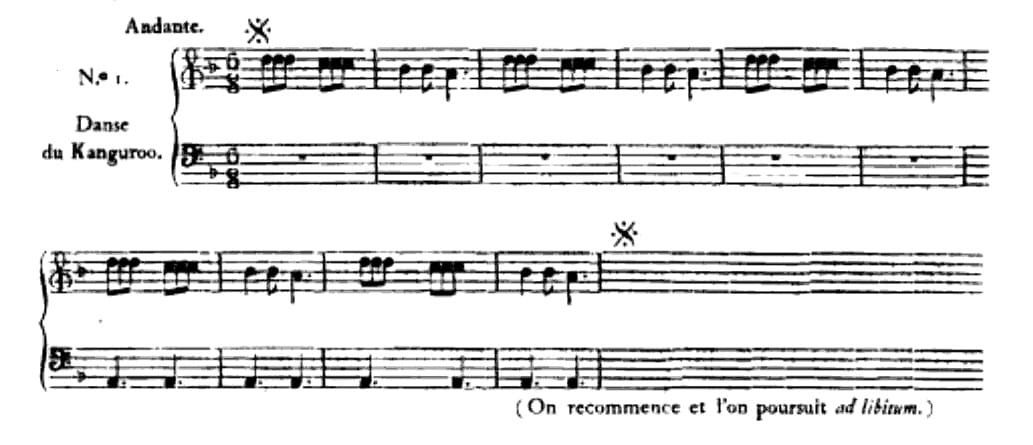
5.2 Fishing song
5.2 "No. 4. Air de pêche" ("Fishing song")
text: E-ya Wan-djé-oua, Tché-en-go Wan-dé-go . . . ["Je n'ai pu avoir les dernières paroles de cet air"]
analytics: As for 5.1

No 4. Air de pêche. E-ya Wan-djé-oua. Tchi-an-go Wan-dé-go [Je n'ai pu avoir les dernières paroles de cet air.]
Other sources and documentation (5.2):
John Hunter, An historical journal of the transactions at Port Jackson and Norfolk Island . . . [full version] (London: Printed for John Stockdale, 1793), 413-14 (5.2 words only)
https://collection.sl.nsw.gov.au/record/1bGMdJXY/XBj3Bol5keJyQ (DIGITISED - PAGE 413)
[413] . . . He [Bennelong] calls Governor Phillip, Beanga (father); and names himself Dooroow (son): the judge and commissary [David Collins] he calls Babunna (brother). He sings a great deal, and with much variety: the following are some words which were caught -
"E eye at wangewah-wandeliah chiango wandego mangenny wakey angoul barre boa lah barrema" . . .
NOTE: For the remaining text see 2 above
David Collins, An account of the English colony in New South Wales: with remarks on the dispositions, customs, manners, &c. of the native inhabitants of that country . . . (London: Printed for T. Cadell Jun. and W. Davies, 1798), 616 (5.2 words only)
https://books.google.com.au/books?id=eRZcAAAAcAAJ&pg=PA616 (DIGITISED)
Words of a Song:
Mang-en-ny-wau-yen-go-nah, bar-ri-boo-lah, bar-re-mah.
This they begin at the top of their voices, and continue
as long as they can in one breath, sinking to the lowest note, and then rising again to the highest. The words are the names of deceased persons.
E-i-ah wan-ge-wah, chian-go, wan-de-go. The words of another song, sung in the same manner as the preceding, and of the same meaning. I met with only two or three words which bore a resemblance to any other language.
NOTE: For the remaining text see 2 above
David Collins, An account of the English colony in New South Wales . . . (1798) [as above], 592-93
https://books.google.com.au/books?id=eRZcAAAAcAAJ&pg=PA592 (DIGITISED)
. . . I had long wished to be a witness of a family party, in which I hoped and expected to see them divested of that restraint which perhaps they might put on in our houses. I was one day gratified in this wish when I little expected it. Having strolled down to the Point named Too-bow-gu-lie, I saw the sister and the young wife of Ben-nil-long coming round the Point in the new canoe which the husband had cut in his last excursion to Parramatta. They had been out to procure fish, and were keeping time with their paddles, responsive to [593] the words of a song, in which they joined with much good humour and harmony. They were almost immediately joined by Ben-nil-long, who had his sister's child on his shoulders. The canoe was hauled on shore, and what fish they had caught the women brought up. I observed that the women seated themselves at some little distance from Ben-nil-long, and then the group was thus disposed of - the husband was seated on a rock, preparing to dress and eat the fish he had just received. On the same rock lay his pretty sister War-re-weer asleep in the sun, with a new born infant in her arms; and at some little distance were seated, rather below him, his other sister and his wife, the wife opening and eating some rock-oysters, and the sister suckling her child, Kah-dier-rang, whom she had taken from Ben-nil-long . . .
David Collins, An account of the English colony in New South Wales . . . (1798) [as above], 601
https://books.google.com.au/books?id=eRZcAAAAcAAJ&pg=PA601 (DIGITISED)
. . . As they never make provision for the morrow, except at a whale-feast, they always eat as long as they have any thing left to eat, and when satisfied, stretch themselves out in the sun to sleep, where they remain until hunger or some other cause calls them again into action. I have at times observed a great degree of indolence in their dispositions, which I have frequently seen the men indulge at the expence of the weaker vessel the women, who have been forced to sit in their canoe, exposed to the fervour of the mid-day sun, hour after hour, chaunting their little song, and inviting the fish beneath them to take their bait; for without a sufficient quantity to make a meal for their tyrants, who were lying asleep at their ease, they would meet but a rude reception on their landing.
David Collins, An account of the English colony in New South Wales, from its first settlement in January 1788 to August 1801 . . . second edition (London: For T. Cadell and W. Davies, 1804), 387
https://archive.org/stream/AccountEnglishC00Coll#page/n455/mode/2up (DIGITISED)
. . . As they never make provision for the morrow, except at a whale-feast, they always eat as long as they have any thing left, and when satistied, stretch themfelves out in the sun to sleep, where they remain until hunger or some other cause calls them again into action. The men frequently indulge a great degree of indolence at the expence of the women, who are compelled to sit in their canoe, exposed to the fervour of the mid-day sun, hour after hour, chaunting their little song, and inviting the fish beneath them to take their bait; for without a sufficient quantity to make a meal for their tyrants, who are lying asleep at their ease, they would meet but a rude reception on their landing . . .
Bibliography and resources:
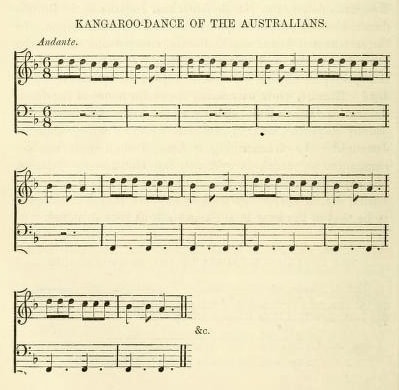
Carl Engel, An introduction to the study of national music: comprising researches into popular songs, traditions, and customs (London: Longmans, Green, Reader, and Dyer, 1866), 238 (music image above)
https://archive.org/details/introductiontost00enge/page/238/mode/2up (DIGITISED)
https://books.google.com.au/books?id=0k4QAAAAYAAJ&pg=PA238 (DIGITISED)
. . . The Kangaroo dance of the natives of Australia is performed by the men only, while the women are singing and beating time by striking two pieces of wood together. The dancers imitate the grunting of the kangaroo, whereby they produce a kind of bass to the singing of the women, as shown in the following notation, which is taken from Freycinet's "Voyage autour du Monde."
KANGAROO-DANCE OF THE AUSTRALIANS . . .
Reproduces music of 5.1 Danse du Kanguroo
James Bonwick, Daily life and origins of the Tasmanians (London: Samson, Low, Son, and Marston: 1870), 31
https://archive.org/stream/dailylifeandori02bonwgoog#page/n50/mode/2up (DIGITISED)
https://books.google.com.au/books?id=rQ5zAAAAMAAJ&pg=PA31 (DIGITISED)
But Captain Freycinet has given us a true Tasmanian tune of the oldest date [MUSIC EXAMPLE]
Reproduces, without title, melody of 1 Kangaroo dance from Freycinet 1839 (? from Engel 1866)
C. Hubert H. Parry, The art of music (London: Kegan Paul, Trench, Trübner, & Co., 1893), 54
https://archive.org/stream/artofmusic00parrrich#page/54/mode/2up (DIGITISED)
Parry, The art of music (1897), 49, and many later editions
https://archive.org/stream/evolutionofartof00parruoft#page/49/mode/2up (DIGITISED)
Reproduces, without title, first four bars of melody of 1 Kangaroo dance from Engel 1866
Nicole Saintilan, "Music - if so it may be called": perception and response in the documentation of Aboriginal music in nineteenth century Australia (M.Mus thesis, University of New South Wales, 1993), 11-15
http://hdl.handle.net/1959.4/50383 (DIGITISED)
Graeme Skinner, Toward a general history of Australian musical composition: first national music, 1788-c.1860 (Ph.D thesis, Sydney Conservatorium of Music, University of Sydney, 2011), 433
http://hdl.handle.net/2123/7264 (DIGITISED)
Graeme Skinner, "The invention of Australian music", Musicology Australia 37/2 (2015), 296
http://dx.doi.org/10.1080/08145857.2015.1076594 (PAYWALL)
ONSITE PDF (FREE DOWNLOAD)
Graeme Skinner and Jim Wafer, "A checklist of colonial era musical transcriptions of Australian Indigenous songs", in Jim Wafer and Myfany Turpin (eds), Recirculating songs: revitalising the singing practices of Indigenous Australia (Canberra: Asia-Pacific Linguistics, 2017), 369-70
http://hdl.handle.net/1885/132161
https://openresearch-repository.anu.edu.au/bitstream/1885/132161/26/17_skinner_wafer.pdf (FREE DOWNLOAD)
Commentary:
Five music examples were printed in Freycinet's 1839 published account of his 1819 return visit to Australia (19 November to 26 December), but of these only nos. 1 and 4 appeared for the first time.
As noted in the respective entries, nos. 3 and 5 were reproduced belatedly in the published reports of the 1802 visit of the Baudin expedition (Lesueur and Petit 1824; for no. 3 see 3.1 above, and for no. 5 see 1 above); and No. 2 was taken from Field 1825 (see 6 below).
Freycinet's accompanying account of Indigenous music making, and "korroberis" also draws partly on some later sources, such as Dawson 1830 (cited by Freycinet elsewhere, though not specifically in this instance). As evidence of the breadth of his more recent reading, Freycinet (830) also noted the existence of John Lhotsky's 1834 transcription (see below), in order to correct Lhostky's claim that his was the "premiere spécimen de musique australienne", by citing the priority of the transcriptions made for Baudin in 1802 (Lesueur and Petit 1824) and by Barron Field (citing Field 1825, but not Field 1823).
In his account of this 1819 visit, Freycinet recorded social and scientific contacts with Macquarie, Field, and many leading colonists. But in preparing the 1839 printed account, he also noted more recent reports (from the 1830s) of music in the theatre and concerts among the dilettanti (872-73) and in school education (881-82).
Collins 1798 also describes a women's fishing song.
Kangaroo songs and dances were widely documented, from Tasmania to Western Australia, for instance:
Bonwick 1870 (31) claimed, on no evidence other than that Kangaroo dances were also performed in Tasmania, that the Kangaroo dance melody from Freycinet 1839 is "a true Tasmanian tune of the oldest date".
There are two other, much earlier transcriptions of words of the fishing song, 5.2, in Hunter 1793 (413) and Collins 1798 (616) (see below); our thanks to Tom Allinson (producer of the History Lab, 2SER 107.3FM) for bringing this to our attention (July 2018).
References:
"Ship News", The Sydney Gazette and New South Wales Advertiser (20 November 1819), 3
http://nla.gov.au/nla.news-article2179095 (DIGITISED)
The French corvette l'Uranie, Captain FRECINET, arrived on Thursday, engaged in a voyage of discovery, with many Officers in the various departments essential to a voyage of this general utility to the world at large. The Officers accompanying Captain Frecinet, who 17 years ago visited this Colony, as we are given to understand with Commodore Baudin, on his voyage of discovery into these seas with the Geographe and Naturaliste, are Gentlemen of the most kind and polished manners; which mention may be considered as a redundancy of expression as affects the Gentlemen of any Nation; but the descriptive writer cannot avoid observations which are so pleasing to the polished circle, and accord so sensibly with the feelings of a refined and liberal Nation.
"Ship News", The Sydney Gazette and New South Wales Advertiser (25 December 1819), 2
http://nla.gov.au/nla.news-article2179163 (DIGITISED)
Sailed this day to resume her voyage of discovery, the French corvette l'Uranie, commanded by Monsieur Freycinet. On getting under weigh, she saluted the fort, which was returned by the battery from Dawes' Point.
Robert Dawson, The present state of Australia a description of the country, its advantages and prospects, with reference to emigration: and a particular account of the manners, customs, and condition of its Aboriginal inhabitants (London: Smith, Elder, 1830)
https://books.google.com.au/books?id=5ngIAAAAQAAJ (DIGITISED)
c.1820
6 1 song
Dharug, Sydney area, NSW
Music and words (no translation) transcribed by Barron Field (1786-1846), from the singing of Harry (c.1787-?), or Corrangie, brother-in-law of Bennelong, between c.1820 and early 1823; first published London, November 1823; second edition London, 1825
https://sydney.edu.au/paradisec/australharmony/checklist-indigenous-music-1.php#006 (shareable link to this entry)
Iah, iah, gumbery jah (Harry's song)
6 "Australian national melody"
text: I-ah i-ah i-ah i-ah i-ah i-ah i-ah i-ah gumbery jah jingun velah gumbery jah jingun velah i-ah i-ah i-ah i-ah i-ah i-ah i-ah i-ah i-ah &c. [1825 version has a-bang . . . instead of i-ah . . .)
analytics: Sydney area (region); ECA (music region); South-eastern PN/ Yuin-Kuri [Sydney subgroup]/ Dharug (language)
Sources and documentation:
B. F. [Barron Field], "Journal of an excursion across the Blue Mountains of New South Wales (October 1822)", The London magazine (November 1823), 465-66
http://books.google.com.au/books?id=o9gYAAAAMAAJ&pg=PA465 (DIGITISED)
. . . From the neighbourhood of our settlements we have scared the kangaroo and the emu, and left these poor lords of the creation no created food but a few opossums, and a tenancy in common with us of fish. Together with their numbers, their customs and manners are in a state of decay . . . But the corrobory, or night-dance, still obtains. This festivity is performed in very good time and not unpleasing tune. The song is sung by a few males and females, who take no part in the dance. One of the band beats time by knocking one stick against another. The music begins with a high note, and gradually sinks to the octave, whence it rises again immediately to the top. I took down the following Australian national melody from Harry, who married Carangarang, the sister of the celebrated Bennilong; and I believe it to be the first that was ever reduced to writing.
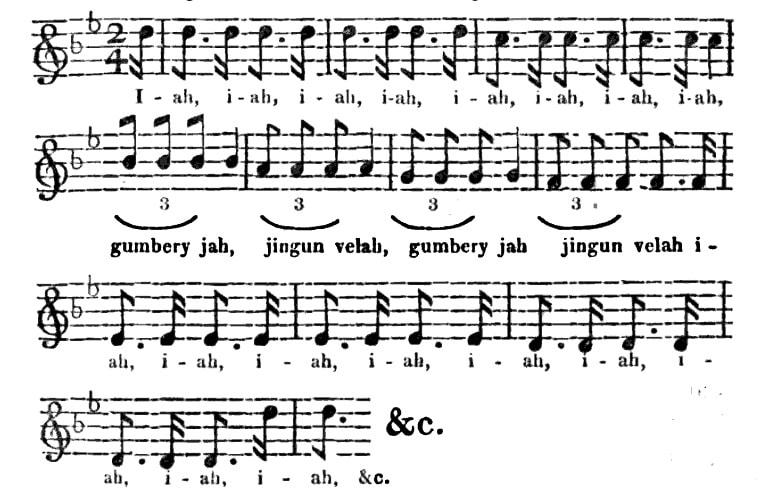
I-ah, i-ah, i-ah, i-ah, i-ah, i-ah, i-ah, i-ah,
Gumbery jah, jingun velah, gumbery jah jingun velah, i-
ah, i-ah, i-ah, i-ah, i-ah, i-ah, i-ah, i-ah, i-ah, &c.
The dancers breathe in chorus like paviours, and the general step consists in opening the knees with a convulsive shake to the music; but occasionally they thrid the mazes of one another without any confusion. They stripe themselves down the waist, and paint their faces with [466] white clay and red ochre; and in compliment to European delicacy, wear boughs round their loins. The glare of large fires gives a picturesque effect to the savage scene, and the dance works up the performers to a sublime enthusiasm. I have been thus minute, because in a few years perhaps even the corrobory will be no more . . .
http://books.google.com.au/books?id=o9gYAAAAMAAJ&pg=PA467 (DIGITISED)
[467]. . . When all thy simple race is extinct, thy name, gentle and wellbred Harry! shall be recorded at least in the pages of this journal. Our courtiers say, all's savage but at court; but of this, at least, I am sure, that thou wert the most courte-[468]-ous savage that ever bade good morrow. Compliments are difficult things to an unpractised tongue; but thou wert naturally polite; and I-owe thee, at least, this poor return for the grace and dignity of thy compliments. And thou too, Cogy! never shall I forget thy intoxicating laugh; and the recollection of thy good-humoured face will come across me in other climes, and at distant days, like a picture that will never lose its interest. Very pleasant wert thou to me, Cogy, when pleasures with me were very rare . . .
"Auszüge aus einem Journal einer Reise über die blauen Berge in Neu-Süd-Wales", Morgenblatt für gebildete stände (28 August 1824), (825), 826
https://babel.hathitrust.org/cgi/pt?id=uc1.b3235610;view=1up;seq=386 (DIGITISED)
https://books.google.com.au/books?id=GO8cAQAAMAAJ&pg=PA826 (DIGITISED)
German translation of the above with music and words of the song
Barron Field, Geographical memoirs on New South Wales; by various hands (London: John Murray, 1825), 433-34
http://books.google.com.au/books?id=P7kBAAAAYAAJ&pg=PA433 (DIGITISED)

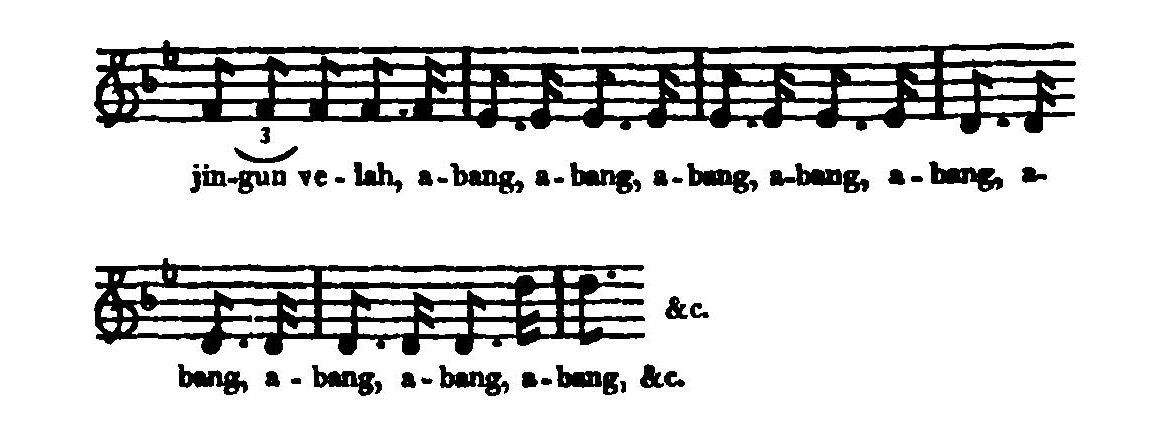
All printed text as for 1823 above, except word underlay of song
A-bang, a-bang, a-bang, a-bang, a-bang, a-bang, a-bang, a-bang,
gum-be-ry jah, jin-gun ve-lah, gum-be-ry jah, jingun velah,
a-bang, a-bang, a-bang, a-bang, a-bang, a-bang, a-bang, a-bang, a-bang, &c.
As Field indicated, this was merely a reprint of the article Field 1823; but he neither noted nor explained the reason for the change of the repeated first word of the song text from I-ah in 1823, to A-bang in 1825.
Sound:
https://dictionaryofsydney.org/artefact/gumberry_jah
https://dictionaryofsydney.org/media/58525 (STREAMED AUDIO)
Harry's Song performed in traditional style by two Indigenous Australian performers, Clarence Slockee and Matthew Doyle, recorded for the opening of the Mari Wari exhibition, State Library of New South Wales, Sydney, 24 September 2010
Keith Vincent Smith, "1793: A Song of the Natives of New South Wales", eBLJ (Electronic British Library Journal) (2011, article 14), (1-7), 7
http://www.bl.uk/eblj/2011articles/pdf/ebljarticle142011.pdf (SOUND FILE)
Page 7 of the pdf has an embedded sound file of Barrabu-la (c. 1790) and Harry's Song (c. 1820) performed in traditional style by two Indigenous Australian performers, Clarence Slockee and Matthew Doyle, recorded for the opening of the Mari Wari exhibition, State Library of New South Wales, Sydney, 24 September 2010
"GUYANAYA BAYUI: OLD PEOPLE, FUTURE", Deepening Histories (Australian National University)
http://deepeninghistories.anu.edu.au/sites/music-day/play.php?UUID=90f02a58-4b8c-4a0d-ab43-ad32211343f1 (STREAMED VIDEO)
Newly imagined performances in contemporary experimental idiom, by Richard Green, Karen Smith, Matt Doyle, Clarence Slockee, with Kevin Hunt, features Barabul-la (c.1793),0Chant (1802), and Harry's Song (c.1820)
Bibliography and resources:
Hannover, Stadtbibliothek, Musikabteilung (D-HVs), MS Kestner No. 140 (Nr. 19) [RISM ID no.: 451010544], "Neuholländisches Lied, Jahiah gumbery jah" [ = Field 1823]; copied by Hermann Kestner (1810-1890), 1836
On this MS see Theodor Georg Wilhelm Werner, "Die Musikhandschriften des Kestnerschen Nachlasses im Stadtarchiv zu Hannover" (Hannoversche Geschichtsblätter), Zeitschrift für Musikwissenschaft 1/8 (1919), 241-372
Louis de Freycinet, Voyage autour du monde entrepris par ordre du Roi . . . exécuté sur les corvettes de S. M. l'Uranie et la Physicienne, pendant les années 1817, 1818, 1819 et 1820, historique, tome deuxième - deuxième partie (Paris: Chez Pillet Ainé, 1839), 775
http://books.google.com.au/books?id=pWNNAAAAYAAJ&pg=PA775 (DIGITISED)
Music example no. 2, "Air de danse", from Field 1825
See also 830 footnote 1
http://books.google.com.au/books?id=pWNNAAAAYAAJ&pg=PA830 (DIGITISED)
Charles Wilkes, Narrative of the United States Exploring Expedition during the years 1838, 1839, 1840, 1841, 1842 Volume 2 (Philadelphia: Lee and Blanchard, 1845) [edition A], 200
https://archive.org/stream/narrativeofunite02wilk#page/200/mode/2up (DIGITISED)
Wilkes 1845 [edition B], 2, 190
https://books.google.com.au/books?id=EXAaAQAAIAAJ&pg=PA190 (DIGITISED)
Final music example = slightly varied version of Field 1825
According to Wilkes, Joseph Drayton claimed to have obtained the songs given as examples 2, 3, and 4 from "a native, who was on his way with the new song [presumably no 2] to his tribe". Whether this is in fact true of no. 4, Drayton version of the text and music is so close to Field 1825 as to leave no room for reasonable doubt that Drayton used it as his copy text; see also this page 11.1-3 below
James Bonwick, Daily life and origins of the Tasmanians (London: Samson, Low, Son, and Marston: 1870), 31
https://archive.org/stream/dailylifeandori02bonwgoog#page/n49/mode/2up (DIGITISED)
https://books.google.com.au/books?id=rQ5zAAAAMAAJ&pg=PA31 (DIGITISED)
After Field 1825
Henry Ling Roth, "Australian tunes", Journal of the Anthropological Institute of Great Britain and Ireland 16/4 (1888), 425
https://archive.org/stream/journalofroyalan16royauoft#page/425/mode/2up (DIGITISED)
Diplomatic facsimile of Field 1825
Richard Wallaschek, Primitive music: an inquiry into the origin and development of music, songs, instruments, dances, and pantomimes of savage races (London; New York: Longmans, Green, and Co., 1893), 36-37 (commentary), [342] (music example 5.2)
https://archive.org/stream/primitivemusicin00wall#page/36/mode/2up commentary (DIGITISED)
https://archive.org/stream/primitivemusicin00wall#page/n342/mode/2up music example 5.2 (DIGITISED)
Example 5 no 2 ("Wilkes") from Wilkes 1845
Richard Wallaschek, Anfänge der Tonkunst (Leipzig: Johann Ambrosius Barth, 1903), 36-37 (commentary), 342 (music example 5.2)
https://archive.org/stream/anfngedertonkuns00wall#page/36/mode/2upcommentary (DIGITISED)
https://archive.org/stream/anfngedertonkuns00wall#page/342/mode/2up music example 5.2 (DIGITISED)
Example 5 no 2 ("Wilkes") from Wilkes 1845
Roger Covell, Australia's music: themes of a new society (Melbourne: Sun Books, 1967), 65-66, 324
Music example = Field 1823
Alice M. Moyle, "Tasmanian music, an impasse?", Records of the Queen Victoria Museum, Launceston 26 (May 1968), (1-18), 6, 17
Nicole Saintilan, "Music - if so it may be called": perception and response in the documentation of Aboriginal music in nineteenth century Australia (M.Mus thesis, University of New South Wales, 1993), 36-39
http://hdl.handle.net/1959.4/50383 (DIGITISED)
Graeme Skinner, Toward a general history of Australian musical composition: first national music, 1788-c.1860 (Ph.D thesis, Sydney Conservatorium of Music, University of Sydney, 2011), 11, 43, 47, 106, 433, 434, 439
http://hdl.handle.net/2123/7264 (DIGITISED)
Keith Vincent Smith, "1793: A Song of the Natives of New South Wales", eBLJ (Electronic British Library Journal)
(2011, article 14), (1-7)
http://www.bl.uk/eblj/2011articles/pdf/ebljarticle142011.pdf (FREE DOWNLOAD)
Graeme Skinner and Jim Wafer, "A checklist of colonial era musical transcriptions of Australian Indigenous songs", in Jim Wafer and Myfany Turpin (eds), Recirculating songs: revitalising the singing practices of Indigenous Australia (Canberra: Asia-Pacific Linguistics, 2017), 370-71
http://hdl.handle.net/1885/132161
https://openresearch-repository.anu.edu.au/bitstream/1885/132161/26/17_skinner_wafer.pdf (FREE DOWNLOAD)
Keith Vincent Smith, "Corrangie / Harry", Dictionary of Sydney, 2017
https://dictionaryofsydney.org/entry/corrangie_harry
"Gumbery jah (Harry's song)", Dictionary of Sydney
https://dictionaryofsydney.org/artefact/gumberry_jah
By 1830
7 1 song
Arnhem Land, NT
Music only, transcribed by, or on behalf of, Grégoire Louis Domeny de Rienzi (1789-1843), c. late 1820s (by 1830); first published Paris, 1836
https://sydney.edu.au/paradisec/australharmony/checklist-indigenous-music-1.php#007 (shareable link to this entry)
Arnhem Land song
7 "No. 12. Air australien des sauvages de la terre d'Arnheim"
text: [music only, no words]
analytics: Arnhem Land (region); ? NW ? NE ? BMI (music region); ? Australian (language)
Source and documentation:
Grégoire Louis Domeny de Rienzi, Océanie; ou cinquième partie du monde . . . tome premier (Paris: Firmin Didot Frères, 1836), 78 (commentary), 81 (music)
http://books.google.com.au/books?id=Qbs0AAAAIAAJ&pg=PA81 (DIGITISED)
https://archive.org/stream/ocanieoucinqui01dome#page/81/mode/2up (DIGITISED)

Domeny de Rienzi 1836, volume 1, 78 (discussion)
https://books.google.com.au/books?id=mdg1AAAAMAAJ&pg=PA78 (DIGITISED)
MUSIQUE. Tous les peuples, civilisés ou sauvages, de l'Océanie, aiment passionnément la musique; mais elle a fait plus de progrès a Java que dans le reste de cette partie du monde; car nous ne comptons pas la musique des habitants des Philippines, qui ont adopté celle des Espagnols ou des créoles du Mexique et du Pérou, établis à Manila. Pour donner une idée du caractère de la musique de ces peuples, nous publierons ici douze morceaux, savoir: un de Célèbes, un de Java, un des Chinois qui habitent le nord de l'île Bornéo; un de Zamboanga, dans l'île de Maïndanao; un air de danse des îles Haouaï ; un chant de l'île Gouap, dans l'archipel des Carolines; un chant de mort de l'île Taïti; un air des Papouas de la Nouvelle-Guinée; un des indigènes de l'île Traman, la plus méridionale du groupe d'Arou, et enfin un air australien des sauvages de la terre d'Arnheim. Nous avons rapporté ces morceaux de l'Océanie, et nous avons eu soin de les noter nous-même. Ils sont tous inédits . . . La plupart des instruments de la Malaisie viennent de la Chine ou de l'Europe, sauf les flûtes et les rababs. Les Polynésiens et les Papouas possèdent le syrinx . . .
See also on "Les Endamènes et les Australiens", 21-23
https://books.google.com.au/books?id=mdg1AAAAMAAJ&pg=PA21 (DIGITISED)
Domeney de Rienzi 1837, volume 3, 480-81
https://books.google.com.au/books?id=LZlQAAAAYAAJ&pg=PA481 (DIGITISED)
[480] S'il est permis de nous citer encore nous-méme, nous répéterons ce que nous avons dit dans un de nos écrits: Ce qui doit le plus surprendre de [481] la part des indigènes de la terre d'Arnheim, c'est que la curiosité, qui parait être le trait caractéristique et dominant de l'espèce humaine, n'a presque fait aucun progrès chez eux. Rien de ce qu'on leur offre ne paraît exciter leur admiration, leur étonnement ou leur désir. En effet, pour admirer les productions de l'industrie ou des arts, il faut au moins posséder les premières idées de ces productions. Mais ces hommes simples considèrent les ouvrages les plus parfaits et les plus compliqués, du même oeil qu'ils voient les lois et les phénomènes de la nature; et à leurs yeux il n'y pas de différence entre le mécanisme d'un chronomètre de Breguet et le casuarina qui croit sans culture dans leurs immenses forêts. L'orgueilleux Européen qui, après s'être exposé à de nombreux dangers pour arriver dans ces régions lointaines, pense qu'il s'abaissa en les questionnant ou en s'asseyant auprès d'eux , n'est-il pas humilié en voyant la parfaite indifférence avec laquelle ils regardent nos chefs-doeuvre? Ils sont cependant curieux de voir si notre peau et nos habits ne font qu'un. La musique aussi a quelque attrait pour eux. Ils sont assez discrets et reconnaissants , niais vindicatifs à l'excès. On trouve chez ces Australiens plusieurs guides qui servent avec zèle et probité les Bouguis ou autres étrangers, surtout s'ils appartiennent à la race malaie (Rienzi, loco cit) . . .
Bibliography:
Nicole Saintilan, "Music - if so it may be called": perception and response in the documentation of Aboriginal music in nineteenth century Australia (M.Mus thesis, University of New South Wales, 1993), 16-21
http://hdl.handle.net/1959.4/50383 (DIGITISED)
Graeme Skinner, "The invention of Australian music", Musicology Australia 37/2 (2015), 296
http://dx.doi.org/10.1080/08145857.2015.1076594 (PAYWALL)
ONSITE PDF (FREE DOWNLOAD)
Skinner and Wafer 2017
Graeme Skinner and Jim Wafer, "A checklist of colonial era musical transcriptions of Australian Indigenous songs", in Jim Wafer and Myfany Turpin (eds), Recirculating songs: revitalising the singing practices of Indigenous Australia (Canberra: Asia-Pacific Linguistics, 2017), 371-72
http://hdl.handle.net/1885/132161
https://openresearch-repository.anu.edu.au/bitstream/1885/132161/26/17_skinner_wafer.pdf (FREE DOWNLOAD)
Commentary:
It is not known when, or indeed whether Domeny de Rienzi actually set foot in Northern Australia; but he had reportedly arrived at Bombay, via the Red Sea, as early as late 1825. Arnhem Land is the most linguistically complex and diverse region in Australia. It is home to numerous non-Pama-Nyungan languages as well as members of the Pama-Nyungan Yongu group, so it is impossible even to speculate which language or language group the music might be associated with.
1834
8 1 song
Ngarigu, Monaro area, south east NSW
Music and words transcribed by John Lhotsky (1795-1866), Monaro area, NSW, from unidentified singers, March 1834; first published Sydney, November 1834
https://sydney.edu.au/paradisec/australharmony/checklist-indigenous-music-1.php#008 (shareable link to this entry)
Kongi kawelgo
8 "Song of the women of the Menero tribe"
text: Kon-gi kawel-go yue-re/ con-gi kawel-go yue-re/ Kuma gi ko-ko kawel-go/ kuma-gi ka-ba/ ko-ma gi ko-ko/ koma-gi ko-ko kabel-go/ Koma gi ka-ba/ ko-ma-gi yue-re (Lhotsky)
gloss: Unprotected race of people, unprotected all we are; and our children shrink so fastly, unprotected why are we? (Lhotsky); but see in bibliography Troy and Barwick 2021
analytics: Monaro area, south east NSW (region); ECA (music region); South-eastern PN/ Yuin/ Ngarigu (language)
Source A and documentation
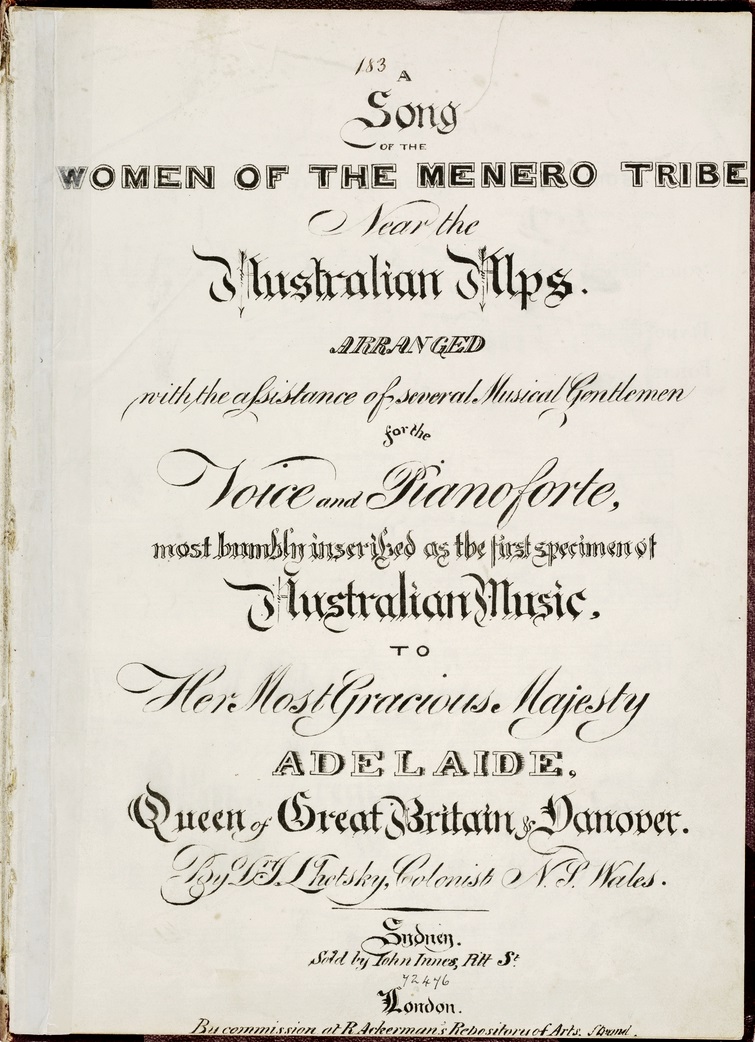
A song of the women of the Menero Tribe arranged with the assistance of several musical gentlemen for the voice and pianoforte, most humbly inscribed as the first specimen of Australian music, to her most gracious majesty Adelaide, queen of Great Britain & Hanover, by Dr. J. Lhotsky, colonist N. S. Wales (Sydney: Sold by John Innes, Pitt St.; London: By commission at R. Ackerman's Repository of Arts, Strand, [1834]); "I. G. Austin, Litho'r, Sydney"
https://trove.nla.gov.au/work/33504891 (TROVE)
https://collection.sl.nsw.gov.au/record/74VK3gvR5MOg (DIGITISED)
https://trove.nla.gov.au/search?l-publictag=A+song+of+the+women+of+the+Menero+tribe (TROVE tagged by Australharmony)
ASSOCIATIONS: Adelaide (dedicatee); John Gardner Austin (lithographer); John Innes (bookseller); Rudolph Ackermann's "repository" was the name both of his premises in the Strand, and the journal published by him Ackermann's repository
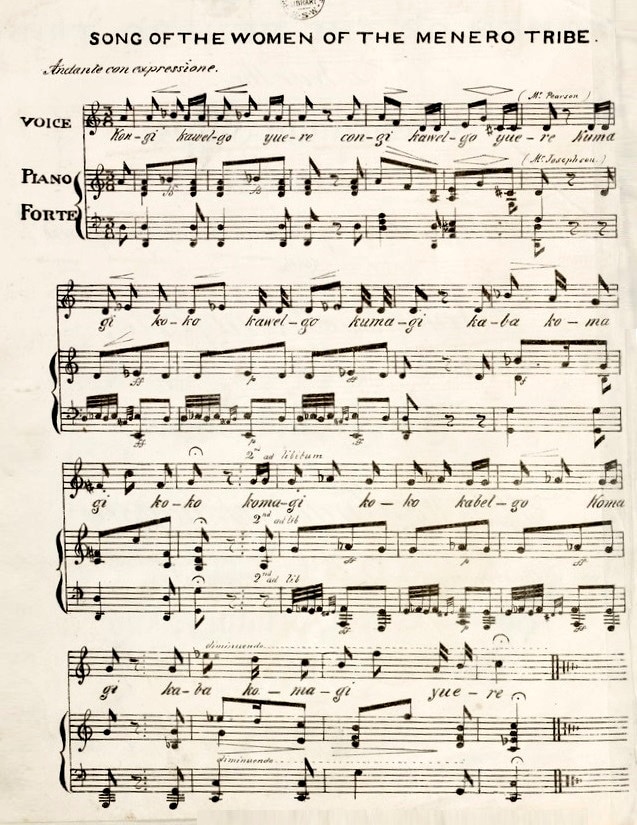
[page 2] SONG OF THE WOMEN OF THE MENERO TRIBE
Kongi kawelgo yuere congi kawelgo yuere Kuma
gi koko kawelgo kumagi kaba koma
gi koko komagi koko kabelgo koma
gi kaba komagi yuere
[Vocal line arranged by:] Mr. Pearson
[Piano part arranged by:] Mr. Josephson
ASSOCIATIONS: James Pearson (musician, arranger); Joshua Frey Josephson (musicial, arranger)
Sound:
Synthesised sound file, Australharmony 2016
[page 3] Arranged in a more easy manner (Mr. Sippe)
ASSOCIATIONS: George Sippe (musician, arranger)
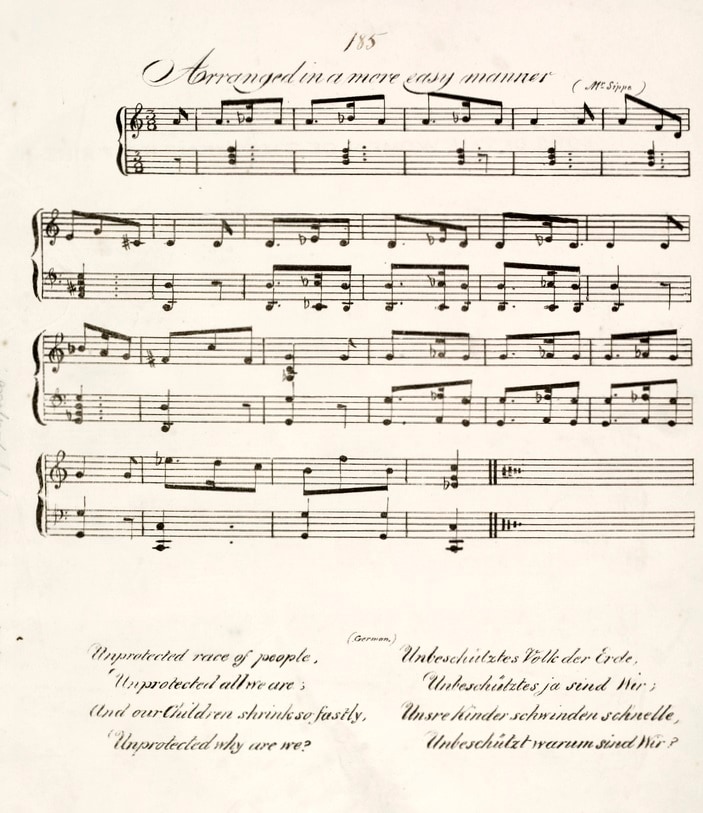
Unprotected race of people,
Unprotected all we are;
And our children shrink so fastly;
Unprotected why are we?
(German)
Unbechülztes Volk der Erde,
Unbechülztes ja sind Wir;
Unsre Kinder schwinden schnelle,
Unbechülzt warum sing Wir?
"Domestic Intelligence", The Australian (7 November 1834), 2
http://nla.gov.au/nla.news-article42007225 (DIGITISED)
We were shewn a Lithographic Sketch of the title page to a Native Melody, got up in his Journey to the Australian Alps, by Dr. J. Lhotsky; the execution is as good as could be expected in a rough draft and first attempt, and a little polishing will probably present to the public a very fair specimen of Lithography; we would suggest a Vignette to be composed of a native chief, and the Doctor and his Horse in the attitude usually given to the Three Graces!
[Advertisement], The Sydney Gazette and New South Wales Advertiser (11 November 1834), 3
http://nla.gov.au/nla.news-article2217523 (DIGITISED)
SHORTLY WILL BE PUBLISHED,
A SONG OF THE WOMEN OF THE MENERO TRIBE, NEAR THE AUSTRALIAN ALPS.
ARRANGED With the assistance of several Musical Gentlemen, FOR THE VOICE AND PIANO-FORTE,
Most humbly inscribed as the first specimen of AUSTRALIAN MUSIC,
TO Her Most Gracious Majesty, ADELAIDE, QUEEN OF GREAT BRITAIN AND HANOVER,
BY Dr. J. LHOTSKY, Colonist, New South Wales.
TO BE SOLD BY JOHN INNIS, PITT STREET.
THIS SONG has been declared by the most competent judges as "very pretty;"
by others, even as a "sublime" production. Subscription list 2s 6d. per copy, to be found at the Banks, &c.
The next sheet of the Australian Alps expedition is now in the press, and will be published in a few days.
[Advertisement], The Sydney Monitor (27 November 1834), 3
http://nla.gov.au/nla.news-article32147678
AUSTRALIAN Philosophical Repository . . .
Published at this establishment. 1. A Journey from Sydney to the Australian Alps . . .
2. A Song of the Menero tribe near the Australian Alps, arranged with the kind assistance of several Musical Gentlemen for the Voice and Piano Forte,
and most humbly inscribed to Her Most Gracious Majesty, Adelaide, Queen, &c.
The collaborating at this song of such able musicians as Pearson, Josephson and Sippe demonstrate clearly that it is neither (as some of my enemies say) a Portuguese air,
nor any thing else than a wild air, carrying however a great depth of feeling.
Several families having expressed their wishes to buy this Air for their children, its present price at Sydney is one shilling and sixpence.
J. LHOTSKY. Castlereagh-street, near Hunter-street, Nov. 25th 1834.
[Advertisement], The Hobart Town Courier (16 January 1835), 1
http://nla.gov.au/nla.news-article4182296 (DIGITISED)
NEW MUSIC. Just received, and on Sale at the Courier Office, Collins-street; price 1s. 6d.
A Song of the women of the Menero tribe, near the Australian Alps -
arranged with the assistance of several Musical Gentlemen for the voice and piano forte -
most humbly inscribed as the first specimen of Australian music, to her most gracious Majesty Adelaide,
Queen of Great Britain and Hanover, by Dr. J. Lhotsky, Colonist, New South Wales.
ALSO, By the same author, price 1s, the last number of a journey to the Australian Alps, undertaken in the months of January, February, and March 1834 . . .
"THE DOCTOR AND THE DEMONS", The True Colonist Van Diemen's Land Political Despatch (2 March 1838), 7
http://nla.gov.au/nla.news-article203145655 (DIGITISED)
On Wednesday night, Dr. Lhotsky made his appearance, to give his long promised lecture, on the stage of the new Theatre. The Doctor certainly has more self possession than any man we ever knew and he did humbug the people very much. Although the music was a treat well worth the whole price of admission . . . But we can tell the Doctor it will not do another time, unless he tries some new scheme, he must get "an Andrew" in addition to his Demons, sing his Menaro native song, and announce all in the bills of the performance, or the people good natured as they are will not be again humbugged out of their, time and their money too.
A journey from Sydney to the Australian Alps, undertaken in the months of January, February, and March, 1834, being an account of the geographical & natural relation of the country traversed, its Aborigines, &c., together with some general information respecting the colony of New South Wales, by Dr. John Lhotsky, colonist, N. S. Wales, F. R. Bot. S. Bavaria, etc. (Sydney: Sold by J. Innes, bookseller, Pitt-street; London: By commission at R. Ackerman's Repository of Arts, Strand, 1835), 1-118 (incomplete at end), see especially 44-45
https://trove.nla.gov.au/work/19342482
https://nla.gov.au/nla.obj-495608964 (DIGITISED)
https://nla.gov.au/nla.obj-495608964/view?partId=nla.obj-509638061#page/n50/mode/1up (DIGITISED)
[Saturday 25 January 1834] [44] . . . As it soon after became one of those supernatural Australian full moon nights, I confidently expected that a Corrohery (a dance and song) would be performed. Without fear of the "not budged you" I proceeded (again with some tobacoo in my pockets) to their camp, where they were painting themselves with white clay and red ochre. However the dance could not commence before the affair with the wild blacks was terminated. We were all in expectation of the things to come. But as I am in no case fond of long waiting, I soon returned to my tent, leaving Walker behind to tell me the sequel of the story. He informed me, that a short [45] time after, the wild blacks (few in number) were heard and that he was hidden by the people in the camp under a large piece of bark, to prevent his being injured. Probably our tribe was too numerous for their enemies, and the only hostility committed was, that a few Bauerings (a sort of crooked wooden projectile) were thrown into the camp as the enemy passed by. After this the Corrobery began, to which I listened, pleasantly extended on my cloak. Their strain was in 2-4 time, which they marked by beating crotchets, and in moments of greater excitement, quavers.
I will hereafter describe a like scene I witnessed near the Alps, and give the music and words of one of our Papua songs, which for majestic and deep melancholy, would not dishonor a Beethoven or a Handel.
The tones weakened by degrees, the tones died away, and grand silence and setherial clearness tilled the Plain and all the wilderness about my camp.
Sunday (26th Jan.), the camp of the Blacks was entirely silent, when we left the bank of the Fish River at an early hour. The road tended now towards Mr. Kennedy's farm, about which Granite is the predominant formation. The latter farm is situated in what is called Goneng Valley, (Gonning in the Surveyor General's Map) . . .
Source B (altered arrangement) and documentation
Isaac Nathan's "corrected" edition of the same song
The Aboriginal father, a native song of the Maneroo Tribe . . . the melody, as sung by the Aborigines, put into rhythm & harmonized with appropriate Symphonies & accompaniments . . . by I. Nathan (Sydney: T. Bluett, Litho[grapher], [1843])
https://trove.nla.gov.au/work/16497064
http://nla.gov.au/nla.obj-165998456 (DIGITISED)
ASSOCIATIONS: Isaac Nathan (arranger)
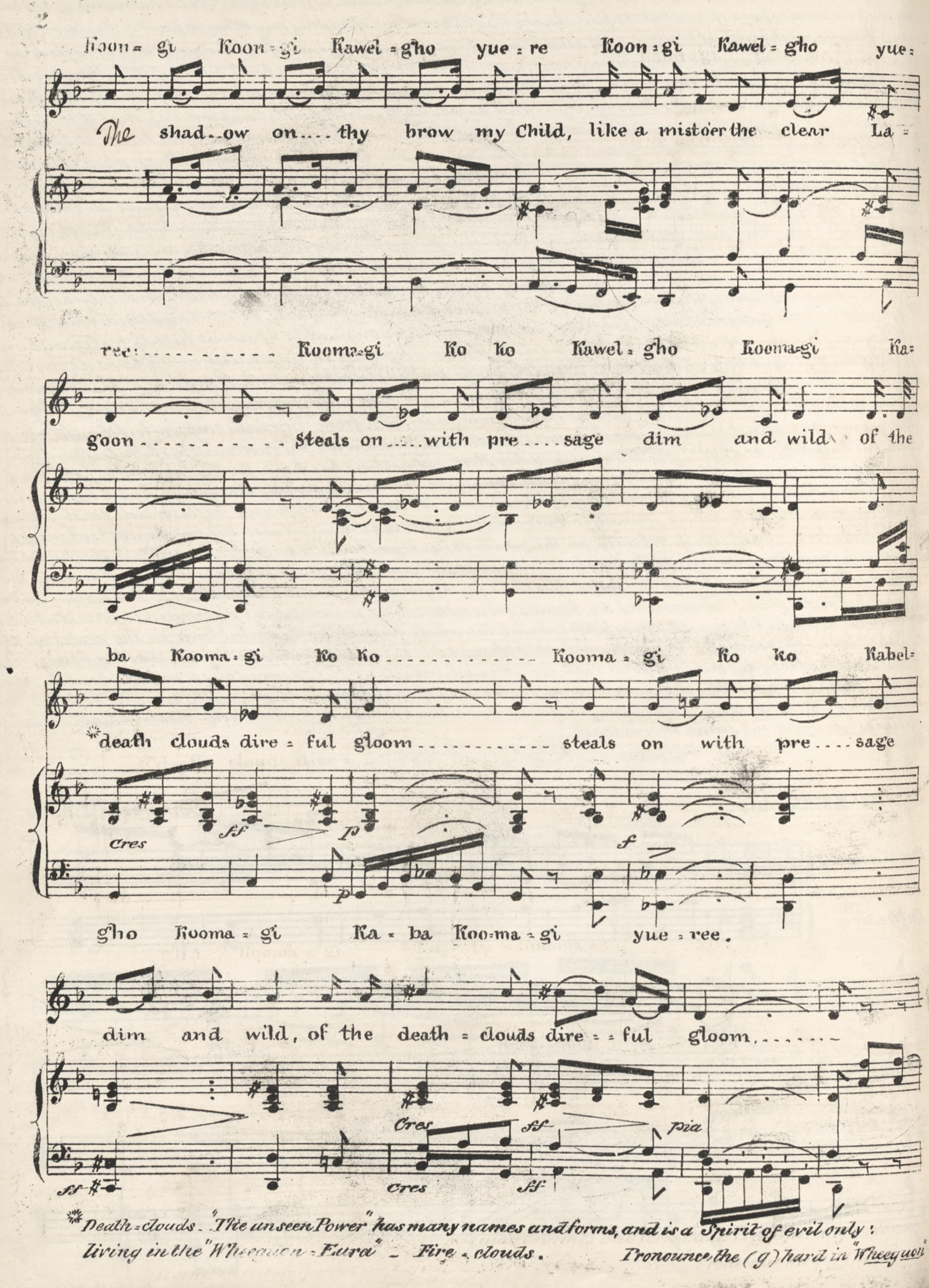
Sound:
Synthesised sound file, Australharmony 2016
The Aboriginal Father, a Native Song of the Maneroo Tribe.
The Shadow on thy brow, my child,
Like a mist o'er the clear Lagoon,
Steals on with presage dim & wild
Of the death clouds' [1] direful gloom.
Our Tribes droop by each Native stream
Where the founts which have fed them lie;
And White Man's fire sends forth its gleam,
O'er the Balwan [2] where they die.
And thou my boy! the last - the first
Green leaf of a smouldering Tree!
A stranger's eye will crush the burst
Of a Warrior's lament o'er thee.
VERSIFIED FROM THE ORIGINAL WORDS,
"Koon-gi Koon-gi Kawel-gho yueree Koon-gi Kawel-gho-yueree,
Kooma-gi Ko Ko Kawel-gho Koomagi Ka-ba Kooma-gi Ko Ko
Kooma-gi Ko Ko Kawel-gho Koomagi Ka-ba Kooma-gi yueree."
By Mrs. E. H. Dunlop.
1. Death clouds. The unseen power has many names & forms & is a Spirit of evil only, living in the Wheeguon-eura
2. Balwan-nuan. The water of the creek.
[Commentary] On my arrival in Australia, I felt anxious for the honor, pride and glory of musical tradition, to make myself acquainted with the characteristic peculiarities of the native Aboriginal airs. I was favored with a lithographic copy of this beautiful pathetic melody, so deformed and mutilated by false rhyme, so disguised in complete masquerade, by false basses and false harmony, that I cast it from me with no small share of regret at the poor chance thus afforded me of adding any thing in favor of the claim of the Aborigines to the pages of musical history. My astonishment, however, a short time afterwards, was only equalled by the delight I experienced at hearing the same melody sung in all its genuine purity and simplicity, by one of the Maneroo tribe. I at once discovered the key to its latent rhyme and excellent scope for good basses and rich transitions and progressions of harmony.
There is in the first four bars of this melody, so striking an affinity to one of Handel's compositions, that those who are acquainted with the works of that great master might find difficulty in divesting themselves of the belief, that the Aborigines had been guilty of piracy: sceptics on that point however may remove all doubt from their minds, when they reflect on the little probability of any one of these sable-faced gentlemen ever having graced Drury Lane or Covent Garden, by the sunshine of their polished countenances, to witness the performance of Handel's Oratorios. I have in early life read of a gruntling (in company with its accomplished mamma) who, unlike Selwyn in search of a daughter, or Japhet in search of a father, flew, with all the epicurean taste of a gourmand, across the Atlantic, after the more fascinating allurements of the calipash and calipee; and we have all been made acquainted with full particulars of Mohawne's journey to heaven on his ass (Al. Borak); but as we have no authenticated record of either the Loobras ["Loobra" - A girl] or Gins ["Gin" - A wife] of the Aborigines taking flight to England for the purpose of engaging composers, and of selecting sacred music from the works of Handel for their antipodal words, we must give them credit for originality, and prevent hostile proceedings in the Court of Chancery against them, by way of injunction for their seeming infringement on the laws of copy-right. As to the affinity of the four bars alluded to, to Handel's song, we must exclaim with Bowdick, that there can be no stronger proof of the musical powers of these beings, nor of the nature of Handel's compositions. For the satisfaction of the curious I take leave to subjoin the following quotation from Bowdick's [sic] mission to Ashantee, page 451.
After giving an account of the musical powers of a white negro from the interior country of Imbeekee, describing his person, his harp, &c., he says,
"The negro sat on a low stool, supporting his harp on his knee and shoulder, when he proceeded to time it to great nicety: his hands appeared to wander among the strings until he performed a running accompaniment to extra ordinary vociferations. At times one deep and hollow note burst forth and became broken; presently he looked up, pursuing all the actions of a maniac, whilst the one hand continued playing, he rung forth a peal which vibrated on the ear long after it was produced; he became silent, the running accompaniment revived again, as a prelude to loud recitative, uttered witli the greatest volubility, and ending with one word, on which he ascended and descended divisions far beyond the extent (in pitch) of his harp, with the most beautiful precision. Sometimes be became more collected, and a mournful air succeeded the recitative without the least connexion, and he would again burst out with the whole force of his powerful voice in the notes of the Hallelujah Chorus of Handel. To meet with this chorus in the wilds of Africa and from such a being, had such an effect I can scarcely describe; I was lost in astonishment at the coincidence: there could not be a stronger proof of the nature of Handel nor of the powers of the negro. I naturally enquired if this man was in his senses, and the reply was, he was always rational but when he played, at which time he invariably used the same gestures and evinced the same incoherency.
ASSOCIATIONS: Thomas Edward Bowdich (traveller, author), Mission from Cape Coast Castle to Ashantee (London, J. Murray, 1819), 450-51
https://archive.org/details/missionfromcapec00bowd/page/450/mode/2up (DIGITISED)
Nathan had earlier this passage in his Musurgia vocalis: an essay on the history and theory of music (London: Fentum, 1836), 39
https://archive.org/details/musurgiavocalise00nathuoft/page/39/mode/2up (DIGITISED)
"NEW MUSIC", The Sydney Morning Herald (19 January 1843), 2
http://nla.gov.au/nla.news-article12411279 (DIGITISED)
"The Aboriginal Father, a Native Song of The Maneroo Tribe," put into rhythm and harmonised by J. Nathan, versified from the original words by Mrs. E. H. Dunlop, dedicated by Mr. Nathan to the Mayoress.
Among the many compositions with which Mr. Nathan has favoured us during his residence in Australia, none has pleased us more than the above song: it is in every respect worthy of the composer of the Hebrew Melodies. The melody (in D minor) is very beautiful, and capable of great effects from harmonization. Mr. Nathan has realised all these in the most judicious and scientific style. The air was taken by Mr. Nathan from one of the Maneroo tribe, but it certainly savours strongly of the compositions of Handel and Neukomm. Mr. Nathan is struck by this, and to save his black vocalists from the charge of plagiarism, enters into an amusing effusion by way of preface. It appears that we may yet discover much reason to be proud of our aboriginal composers, as the first four bars of this their own melody, is identical with four bars composed by the greatest musician that ever lived-and that, long before any white man came to live in these parts. But if this native melody is worthy of Handel, the arrangement by Mr. Nathan is no less so,-and we feel confident that it will be admired long after we of the present age have done with these matters. Many persons labour under the error that good music is necessarily complicated and difficult: the above song of Mr. Nathan's may undeceive them. It is replete with scientific progressions and combinations, and may he performed by any player who can count three in a bar. There are others who fancy that scientific harmonization is only to be appreciated by the musical theorist, - let them compare this song by Mr. Nathan with a former arrangement of the same air by another composer. We hope to see the "Aboriginal Father" an universal favourite, as the study of music of this sort must beget a correct taste for the science.
"NEW PUBLICATION", Australasian Chronicle (19 January 1843), 2
http://nla.gov.au/nla.news-article31738598 (DIGITISED)
The Aboriginal Father, a Native Australian Song; translated by Mrs. Dunlop. The music put into rythm and harmonised by I. Nathan.
THE publication in quick succession of these Australian melodies (this is No. 7 of the series), and their steady improvement in character as they proceed, would seem to falsify the opinion that genius is fostered by patronage. We do not mean to say that each of these melodies: is without the name of a patron or patroness on the title page, but if we are not misinformed, the author has in most cases found it "a name and nothing more." Be this as it may, we shall not fail in our duty of drawing the notice of our readers to the present song, which, simple as it looks, if it were to appear in London or Vienna as the first work of a young composer, would at once place that composer in the ranks of the great harmonists of the age. The songs that preceded it, under the title of "Australian Melodies," had all some marks of science and skill, but this is truly a harmonic gem, which Handel himself might have been proud to own. The melody is not here published for the first time It was given to the world some years ago by Dr. Lhotsky, but in a very unattractive state, from the absurd harmonies with which it was accompanied. Those who have seen it before will barely recognise it now, and they will be very agreeably surprised at the metamorphosis it has undergone. The English words added by Mrs. Dunlop are pretty, and relate but "o'er true a tale."
The shadow on the brow, my chlld,
Like a mist o'er the clear lagoon,
Steals on with presage dim and wild,
Of the death cloud's direful gloom.
Our tribes droop by each native stream,
Where the forests which have fed them lie,
And white man's fire sends forth its gleam,
O'er the batwan where they die.
And thou my boy the last - the first
Green leaf of a smould'ring tree,
A stranger's eye will crush the burst,
Of a warrior's lament o'er thee.
[Advertisement], The Sydney Morning Herald (21 January 1843), 3
http://nla.gov.au/nla.news-article12417181 (DIGITISED)
THIS DAY is published for the composer, Elizabeth-street South,
THE ABORIGINAL FATHER, A NATIVE MELODY; Inscribed to the MAYORESS.
Poetess, Mrs, Dunlop. Composer, J. Nathan . . .
"THE ABORIGINAL FATHER", The Australian (27 January 1843), 3
http://nla.gov.au/nla.news-article37116848 (DIGITISED)
Mr. Nathan has forwarded us a copy of "The Aboriginal Father." We must postpone our remarks relative to the melody, but the note prefixed to the song being so peculiar, we deem it advisable to transfer it to our columns. Competent judges speak in high terms of the composer's merits.
"On my arrival in Australia, I felt anxious . . . [as above] . . . used the same gestures and evinced the same incoherency."
[News], South Australian Register (25 February 1843), 4
http://nla.gov.au/nla.news-article27444047 (DIGITISED)
A Poem, entitled the "Aboriginal Father," has been published in Sydney, by Mrs. Dunlop. In a note prefixed to the song, the author [Nathan] says: -
"On my arrival in Australia, I felt anxious . . . [largely as above] . . . As to the affinity of the four bars alluded to, to Handel's song, we must exclaim with Bowdick, that there can be no stronger proof of the musical powers of these beings, nor of the nature or Handel's compositions."
Competent judges speak in high terms of the composer's merits.
Isaac Nathan, The southern Euphrosyne, and Australian miscellany: containing oriental moral tales, original anecdote, poetry and music (Sydney: I. Nathan, [1848-49]), 104-07
https://books.google.com.au/books?id=ziwieom4lBQC&pg=PA104 (DIGITISED)
http://nla.gov.au/nla.obj-166023361/view#page/n113/mode/1up (DIGITISED)
KOON-GI KAWEL GHO. On our arrival in Australia, we felt anxious for the honor . . . [as above] . . . the same gestures and evinced the same incoherency".
The plaintive wild aboriginal melody before mentioned, was sung by the Maneroo tribe to the following native words:
"Koon-gi koon-gi kawel-gho yueree, koon-gi kawel-gho yueree, Kooma-gi ko ko kawel-gho koomagi ka-ba kooma-gi ko ko Kooma-gi ko ko kawel-gho koomagi ka-ba kooma-gi yue-ree." Which we forwarded to Mrs. Dunlop, the talented writer of several elegant poems. This Lady kindly favoured us with the subjoined characteristic stanzas - versified from the original words . . .
We regret that our Euphrosyne's appearance cannot now be delayed for a new edition of this melody, which we published a few years ago, but we look forward to the time when, if it should please the great geometrician of the universe to permit us to visit some land of civilization, where science and literature may hold a small portion of conversation in the drawing room, as well as lambs wool and mutton fat, to re-publish this beautiful native air, with several other extraordinary musical relics - which, but for our timely arrival in this Colony, might for ever have sunk into oblivion . . .
[106] . . . These poor children of the forest had not a Scarlatti, a Leo, a Vinci, a Sarro, a Hasse, a Porpora, a Feo, an [ ], or a Pergolese [sic] to lay a foundation for composing music to express words - with an Apostolo, a Zeno, and a Metastasio at their elbows, to furnish poems replete with purity and eloquence, to inspire them with corresponding energetic or pathetic melodies - nor had they the equally celebrated professors who succeeded those geniuses, to improve on their style of composition, such as Jomelli, Piccini, Sacchini, Guglielmi, Traetta, Anfossi, Terradellas, Paisiello, Cimarosa and others, no, they had not the benefit of such exquisite polish of art - but they had, and they still have, their composers or inventors of songs, possessing that glorious gift of God, instinct, which enables them to express their passions of joy and sorrow in melody, founded on sounds laid down in the divine law of nature, making those sounds as it were an echo of the sense of their words.
We here allude to those true sounds given to us by the laws of nature, such as major and minor tones, with other intervals and minute portions of sound, the intonation of which cannot possibly be produced on our present imperfect tho' beautifully constructed Organ and Piano Forte, but which may he produced to perfection on the Violin, in the hands of that profound musician, who possesses the gift of expression with masterly execution . . . But to return to the aborigines.
We can easily imagine how the ear that has been cultivated to the temperament of our arti-[107]-ficial tones of an Organ or Piano Forte, may be dissatisfied with the true and perfect sound of nature - and consequently make every allowance for the abuse that has been lavished on the vocal capabilities of these sable characters. But we are a little skilled in the science of acoustics, and with that little, have by comparing the mathematical proportions of sound of the ancient Greeks in the days of Aristoxenus, Pythagoras, and others; with the intonation of the aborigines of Australia, discovered beauties, which in some of their native airs are worthy of our strictest attention: and which we shall for the glory of musical tradition transmit as relics to the British Museum.
We regret that our limited fount of music type, and the little time left us for publication - will deprive us of the satisfaction we should have experienced, in laying all the beautiful native melodies we have collected before our readers, in the present work; - but we do trust at some future period to send them forth to the musical world, where it is hoped for the honor of the intellectual race of the creation, they will be appreciated.
Bibliography and resources (source A):
Louis de Freycinet, Voyage autour du monde entrepris par ordre du Roi . . . exécuté sur les corvettes de S. M. l'Uranie et la Physicienne, pendant les années 1817, 1818, 1819 et 1820, historique, tome deuxième - deuxième partie (Paris: Chez Pillet Ainé, 1839), 830
http://books.google.com.au/books?id=pWNNAAAAYAAJ&pg=PA830 (DIGITISED)
Le docteur Lhotsky, parti de Sydney au commencement de janvier, étoit allé visiter les Alpes australiennes; ce voyage, qui dura plusieurs mois, eut pour résultat le plus intéressant (1) . . .
(1) Dans la Sydney Gazette du 22 novembre 1834 on annonce comme prochaine la publication d'une chanson des femmes menero, tribu voisine des Alpes-australiennes, que M. Lhotsky dédie, comme un premier spécimen de musique australienne, à la reine d'Angleterre. On peut voir à ce sujet ce que nous avons dit plus haut au chapitre XXXI, page 74, et ce qui est contenu dans le Voyage de Baudin aux Terres australes, ainsi que dans les Geographical memoirs de M. Field, pag. 433.
John Lhotsky, "Some remarks on a short vocabulary of the natives of Van Diemen Land; and also of the Menero Downs in Australia", Journal of the Royal Geographical Society of London 9 (1839), 157-162
https://archive.org/details/jstor-1797719 (DIGITISED)
https://books.google.com.au/books?id=UCY7AQAAIAAJ&pg=PA157 (DIGITISED)
A Song of the Women of the Menero Tribe ([? Sydney]: [?], [? c. late 19C])
https://trove.nla.gov.au/version/43674485 (DIGITISED)
Facsimile reprint of 1834 edition (? from State Library of New South Wales)
"WOMEN'S COLLEGE LOAN EXHIBITION", The Sydney Morning Herald (27 May 1895), 3
http://nla.gov.au/nla.news-article13996719 (DIGITISED)
There was a fair attendance at the Women's College Loan Exhibition on Saturday, considering the adverse nature of the weather . . .
ARTISTIC AND HISTORICAL CURIOUS . . .
The song of the women of the Menero tribe stated to be the first piece of music published in Sydney . . .
"A Song OF THE WOMEN OF THE MENERO TRIBE", The lone hand 1/6 (1 October 1907), 690-91
http://nla.gov.au/nla.obj-407866070/view#page/n145/mode/1up
Facsimile reprint of the titlepage and page 2 (from State Library of New South Wales)
"MUSIC FOR THE WEEK", The Newcastle Sun (14 July 1938), 10
http://nla.gov.au/nla.news-article167302322
The first piece of music published in Australia was composed by Dr. I. Lhotsky, published by John Innes, Pitt street, Sydney. It was dedicated to Queen Adelaide, consort of William the Fourth, and was entitled, "A Song of the Women of the Menero Tribe, Near the Australian Alps."
W. Arundel Orchard, Music in Australia: more than 150 years of development (Melbourne: Georgian House, 1952), 7, 212 (modern edition, melody and words only)
https://archive.org/details/in.ernet.dli.2015.28983/page/n252/mode/1up (DIGITISED)
Roger Covell, Australia's music: themes of a new society (Melbourne: Sun Books, 1967), 67, 325 (music example 21b)
"MIDWEEK MAGAZINE. Waves of Poles, differing problems", The Canberra Times (11 May 1988), 27
http://nla.gov.au/nla.news-article111972620 (DIGITISED)
Harold Hort, "An aspect of interaction between Aboriginal and western music in the songs of Isaac Nathan", Miscellanea musicologica: Adelaide Studies in Musicology 12 (1987), 205-06, 205-06
Nicole Saintilan, "Music - if so it may be called": perception and response in the documentation of Aboriginal music in nineteenth century Australia (M.Mus thesis, University of New South Wales, 1993), 53-57
http://hdl.handle.net/1959.4/50383 (DIGITISED)
Prue Neidorf, A guide to dating music published in Sydney and Melbourne, 1800-1899 (M.A. thesis, University of Wollongong, 1999), 190-91, and passim
http://ro.uow.edu.au/theses/2926 (DIGITISED)
Graeme Skinner, Toward a general history of Australian musical composition: first national music, 1788-c.1860 (Ph.D thesis, Sydney Conservatorium of Music, University of Sydney, 2011), 105-116, 196-202
http://hdl.handle.net/2123/7264 (DIGITISED)
Graeme Skinner, "Recovering musical data from colonial era transcriptions of Indigenous songs: some practical considerations", in Jim Wafer and Myfany Turpin (eds), Recirculating songs: revitalising the singing practices of Indigenous Australia (Canberra: Asia-Pacific Linguistics, 2017), 355-56
http://hdl.handle.net/1885/132161
https://openresearch-repository.anu.edu.au/bitstream/1885/132161/25/16_skinner.pdf (FREE DOWNLOAD)
Graeme Skinner and Jim Wafer, "A checklist of colonial era musical transcriptions of Australian Indigenous songs", in Jim Wafer and Myfany Turpin (eds), Recirculating songs: revitalising the singing practices of Indigenous Australia (Canberra: Asia-Pacific Linguistics, 2017), 372-73
http://hdl.handle.net/1885/132161
https://openresearch-repository.anu.edu.au/bitstream/1885/132161/26/17_skinner_wafer.pdf (FREE DOWNLOAD)
Jakelin Troy and Linda Barwick, "Claiming the 'Song of the women of the Menero tribe'", Musicology Australia (published online 17 September 2021)
https://doi.org/10.1080/08145857.2020.1945254 (OPEN ACCESS)
"Song of the women of the Menero tribe", Austlit
http://www.austlit.edu.au/austlit/page/C766232
[Lhotsky], Austlit
http://www.austlit.edu.au/austlit/page/C803695
Bibliography and resources (source B):
Robert Etheridge, Contributions to a catalogue of works, reports, and papers on the anthropology, ethnology, and geological history of the Australian and Tasmanian Aborigines . . . part 2 (Memoirs of the geological survey of New South Wales, palaeontology 8) (Sydney: Government Printer, 1891), 36
https://archive.org/stream/contributionsto00ethegoog#page/n83/mode/2up (DIGITISED)
Charles H. Bertie, Isaac Nathan: Australia's first composer: a lecture (Sydney: Angus and Robertson, 1922), 18-21
http://www.archive.org/details/isaacnathanaustr00bertuoft (DIGITISED)
Leo Butler, "Australia's first musician", Newcastle Morning Herald and Miners' Advocate (10 March 1951), 5
http://nla.gov.au/nla.news-article139516204 (DIGITISED)
James Lincoln Hall, "A history of music in Australia - 15: Early period - New South Wales, 1841: Isaac Nathan - 'Australia's first composer'", The canon: Australian journal of music 5/8 (March 1952), 362
Roger Covell, Australia's music: themes of a new society (Melbourne: Sun Books, 1967), 67-68
Harold Hort, "An aspect of interaction between Aboriginal and western music in the songs of Isaac Nathan", Miscellanea musicologica: Adelaide Studies in Musicology 12 (1987), 53-57
Nicole Saintilan, "Music - if so it may be called": perception and response in the documentation of Aboriginal music in nineteenth century Australia (M.Mus thesis, University of New South Wales, 1993), 59-61
http://hdl.handle.net/1959.4/50383 (DIGITISED)
Prue Neidorf, A guide to dating music published in Sydney and Melbourne, 1800-1899 (M.A. thesis, University of Wollongong, 1999), 211 (main), and 139
http://ro.uow.edu.au/theses/2926 (DIGITISED)
Graeme Skinner, Toward a general history of Australian musical composition: first national music, 1788-c.1860 (Ph.D thesis, Sydney Conservatorium of Music, University of Sydney, 2011)
http://hdl.handle.net/2123/7264 (DIGITISED)
Graeme Skinner, "Recovering musical data from colonial era transcriptions of Indigenous songs: some practical considerations", in Jim Wafer and Myfany Turpin (eds), Recirculating songs: revitalising the singing practices of Indigenous Australia (Canberra: Asia-Pacific Linguistics, 2017), 355-56
http://hdl.handle.net/1885/132161
https://openresearch-repository.anu.edu.au/bitstream/1885/132161/25/16_skinner.pdf (FREE DOWNLOAD)
Graeme Skinner and Jim Wafer, "A checklist of colonial era musical transcriptions of Australian Indigenous songs", in Jim Wafer and Myfany Turpin (eds), Recirculating songs: revitalising the singing practices of Indigenous Australia (Canberra: Asia-Pacific Linguistics, 2017), 372-73
http://hdl.handle.net/1885/132161
https://openresearch-repository.anu.edu.au/bitstream/1885/132161/26/17_skinner_wafer.pdf (FREE DOWNLOAD)
Jakelin Troy and Linda Barwick, "Claiming the 'Song of the women of the Menero tribe'", Musicology Australia (published online 17 September 2021)
https://doi.org/10.1080/08145857.2020.1945254 (OPEN ACCESS)
1831
9 1 song
Tasmanian language, "Van Diemans Land" [sic], TAS
Earliest words only transcription, by George Augustus Robinson (1791-1866), 13 August 1831, several other later independent words only transcriptions
Music and words transcribed by Maria Logan (1808-1886), Hobart area, 1835 or 1836 (2 unpublished MS copies, ? c.1840s and 1890s); music (facsimile of earlier manuscript) published 1968
Also, listed separately as 31.1 below, three sound recordings of at least two distinct versions of the song, as sung by Fanny Cochrane Smith, Hobart, 1899 and 1903
https://sydney.edu.au/paradisec/australharmony/checklist-indigenous-music-1.php#009 (shareable link to this entry)
Popela
9 "Song of the Aborigines of Van Diemans Land"
text: Popela ranea gonne ne popela ranea gone ne na lea me gonne a lea me gonne a to kea me gun ne a to kea me gun ne a lea me gun ne a lea me gun ne a ni na te pea ra nea po ne na ni na te pea ra nea po ne na ni na te pea ra ne ni na na re bu wil la pa ne na ra bur wil la bal la hoo! bal la hoo! ni na na ra bu wil la pa na pa ra bu wil la bal la hoo! bal la hoo! (Logan earlier MS)
gloss: G. A. Robinson first transcribed a similar version of the words in 1831 (Plomley 1966, 469 note 250) with a translation "the evil spirit in the native / the ankle / sole of the foot / to evacuate / to clean the wobbeltenn". G. W. Walker, who collected another similar version of the text in 1832, noted that it was "a popular song among all the [Tasmanian] aboriginal tribes, of which I have not obtained the meaning, it being involved by them in some mystery" (Moyle 1968, 2)
analytics: Tasmania (region); TAS (music region); Tasmanian (language)
Sources and documentation:
George Augustus Robinson, journal, 13 August 1831; Plomley 1966, 399, 401 (route map 18), 469-70 note 250
[13 August 1831] Whilst myself and servant was erecting a tent, the whole of the male aborigines went out on an hunting excursion. Self busy in writing. Pm, the native men returned loaded with kangaroo and swans' eggs. The natives in these parts have no regular beaten tracks as those on the south and west part of the island, but travel by observation, from landmarks as hills, burnt ground, mountains &c. The chief said there was a tree over the Brougham River where the natives cross. Today wrote down one of the native songs: [note 250] the tune is very pleasing but the language is indelicate.
[469 note 250] This song is written out on the end pages of the journal, dated 13 August Mount Cameron and entitled "song belonging to the NE part of the island":
POP.PER.RANE.NEN.ER the evil spirit in the native
GOEN.NER.ER
Repeat five times
LUR.ME.GUN.NE.YER the ankle
Repeat four times.
TOKE.HER.ME.GUN.NE.YER sole of the foot
Repeat three times.
NEEN.NER.TAPE.ER.RANE.NER to evacuate
PONE.NEN.NER to clean the wobbeltenn
Repeat five times.
NEE.NAR NEE.NAR
PUE.WIL.LE (sick) PARN.NER
PUE.WIL.LE BAL.LER.HOO BAL.LER.HOO
Repeat twice.
[270] Another version of this song is found on the end pages of the journal for 3l Jan.-24 Apr., 1834:
KAR.HE.GEN.ER
PAP.EL.ER
RANE.ER.GUN.NEN.ER
LUR.ME.GUN.NE
LUR.ME.GUN.NE
TAKE.ER.ME.GUN.NE
TAKE.ER.ME.GUN.NE
NEEN.ER
PAPE.ER.RANE.NER
RONE.NEN.ER.NEEN.ER
PAPE.ER.RANE.ER
NEEN.ER
NAR.ER
BUE.MEL.ER.PAR.NER
NAR.ER
BUE.WEL.ER
BAL.ER.HOO
BAL.ER.HOO
DRUE.DE.CUM
MINE.DIM
1834.
George Washington Walker, journal, 15 October 1832; ed. in George Washington Walker (James B. Walker, ed.), "Notes on the Aborigines of Tasmania, extracted from the manuscript journals of George Washington Walker, with an introduction by James B. Walker, F.R.G.S." Papers and Proceedings of the Royal Society of Tasmania (1897), 172
https://archive.org/stream/papersproceeding1897roya#page/172/mode/2up (DIGITISED)
A popular song among all the aboriginal tribes, of which I have not obtained the meaning, it being involved by them in some mystery -
Poppyla-renung - onnyna - Poppyla, &c., Poppyla, &c., Poppyla, &c.,
lemingannya - lemingannya - leming, &c.
Nyna tepe rena ponnyna - Nyna, &c., Nyna, &c.,
Nyna nara pewilly para. Nyna nara, &c., Nyna nara, &c.,
Nara pewilly pallawoo! pallawoo!
Nyna nara pewilly para pewilly pallawoo! pallawoo!
Nyna nara, &c., Nyna nara, &c., &c.
[editorial note, 1897] In Milligan's Vocabulary this song, with certain differences, is given. It is there entitled "Aboriginal Verses in honour of a Great Chief," sung as an accompaniment to a native dance or Biawe. - Papers of the Royal Society of Tasmania, Vol. III., p. 273. Also by Davies, with other variations - Tasmanian Journal, II, p. 411.
Plomley 1987, 289
Plomley gives the above extract from Walker's journal, but, ? following the MS, precedes it with the following:
[15 October 1832] A favourite song chiefly of the men - stated to be learned from the Sydney blacks, but known by most of the aborigines of V.D. Land.
poppyla renungonnyna poppyla, &c., poppyla, &c.
leminganya leminganya lemingganya, &c.
taukumminganya taukumminganya, &c.
nyna tepe rena ponnyna nyna tepe rena, &c.
nyna nara pewilly para nyna nara pewilly
pallawoo pallawoo nyna nara, &c., nyna nara, &c.
George Augustus Robinson, journal, Sunday 22 October 1836; as transcribed in Plomley 1987, 391
Spent the evening at Logan's in Macquarie Street. Mr. [? Mrs.] Logan set to music a song of the aborigines, POPELLER etc., the first ever attempted.
Song of the Aborigines of Van Diemen's Land (arranged by Mrs. Logan); manuscript, copy, ? c. 1840s; original at Tasmanian Museum and Art Gallery; Archives Office of Tasmania, holographic copies (digitised by Libraries Tasmania)
https://stors.tas.gov.au/AB713-1-4961 page 1 (DIGITISED)
https://trove.nla.gov.au/work/234973807 page 1 (TROVE)
https://stors.tas.gov.au/AB713-1-4960 page 2 (DIGITISED)
https://trove.nla.gov.au/work/234973806 page 2 (TROVE)
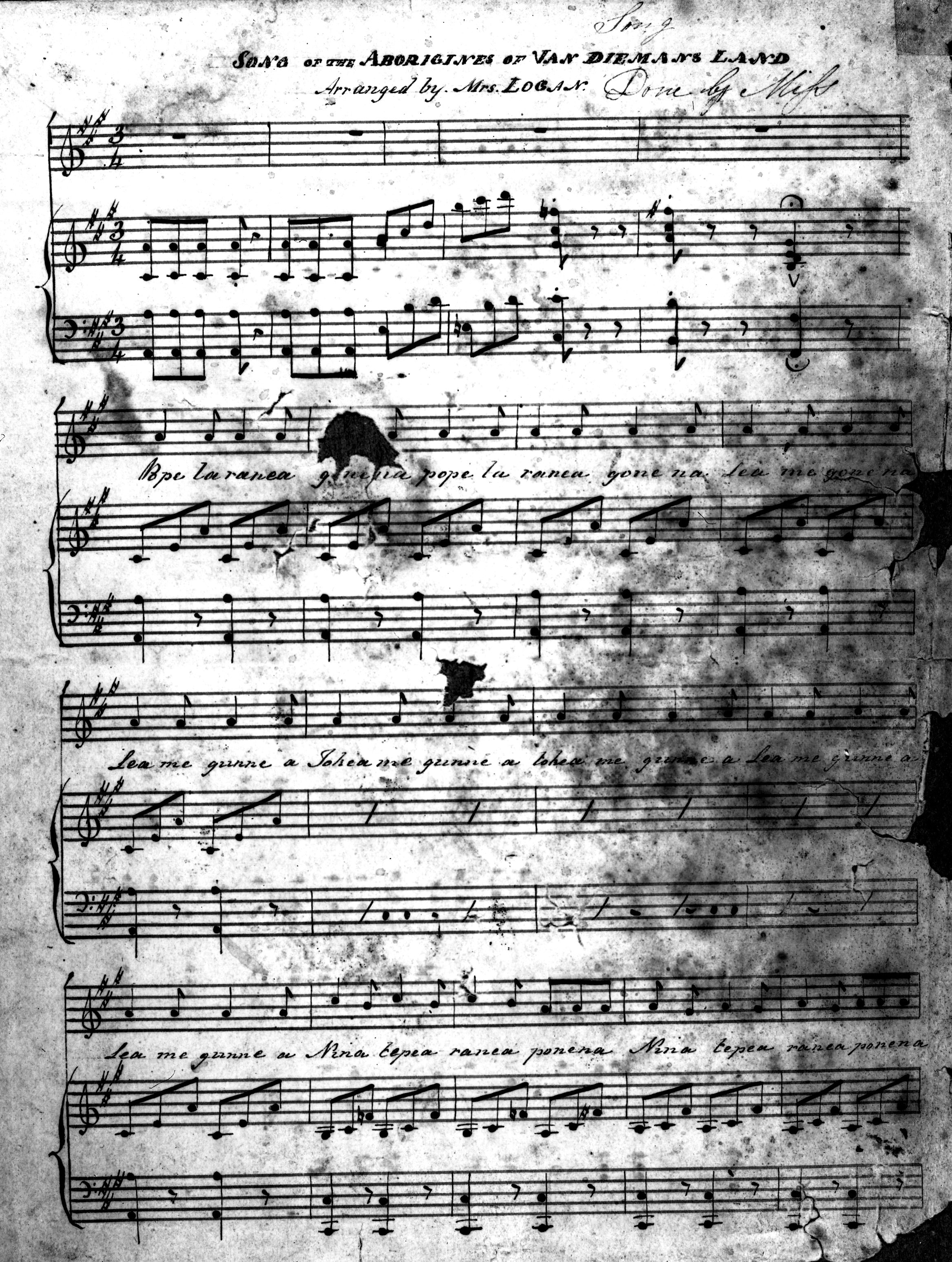
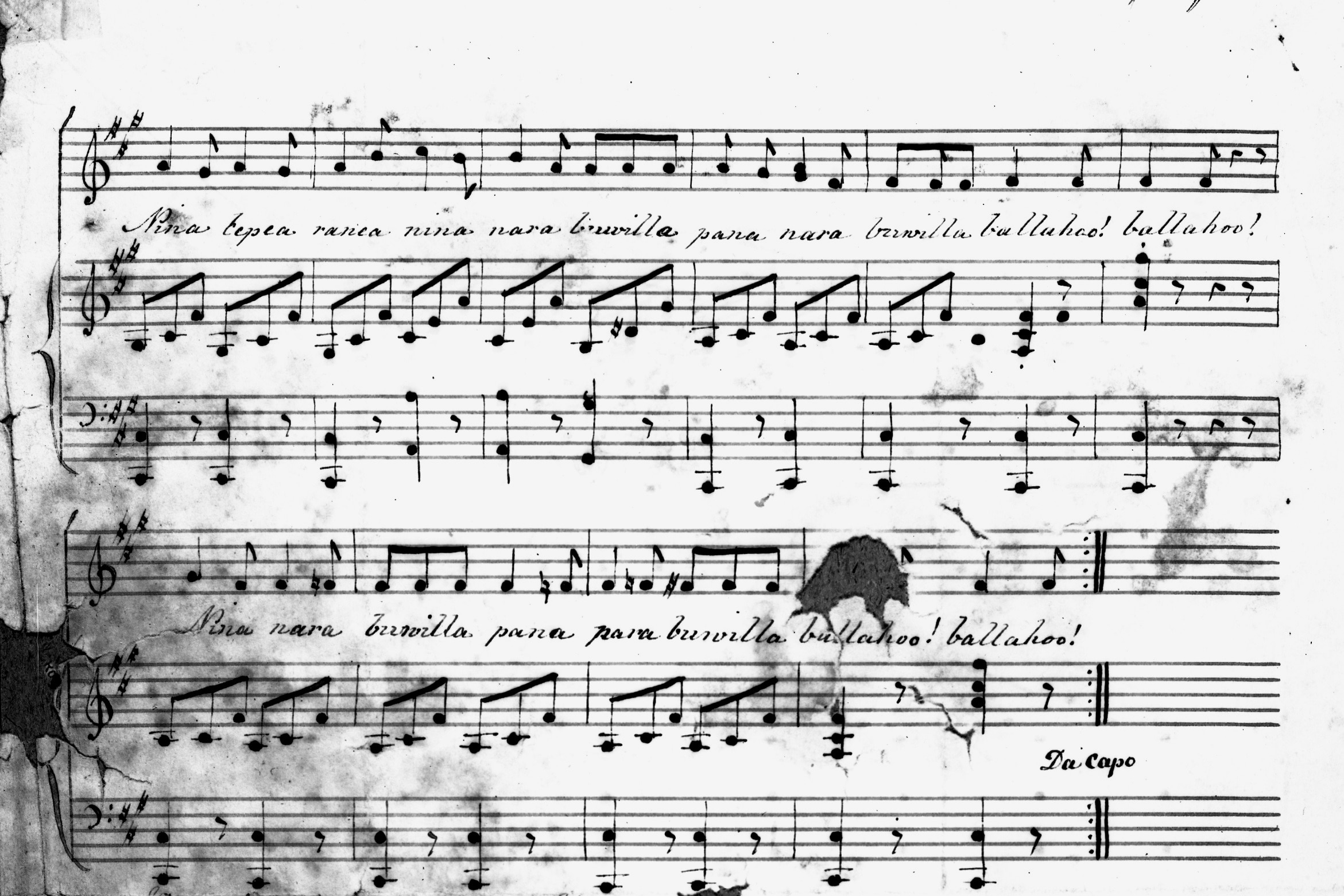
Popela ranea gonne ne popela ranea gone ne na lea me gonne a lea me gonne a to kea me gun ne a to kea me gun ne a lea me gun ne a lea me gun ne a ni na te pea ra nea po ne na ni na te pea ra nea po ne na ni na te pea ra ne ni na na re bu wil la pa ne na ra bur wil la bal la hoo! bal la hoo! ni na na ra bu wil la pa na pa ra bu wil la bal la hoo! bal la hoo!
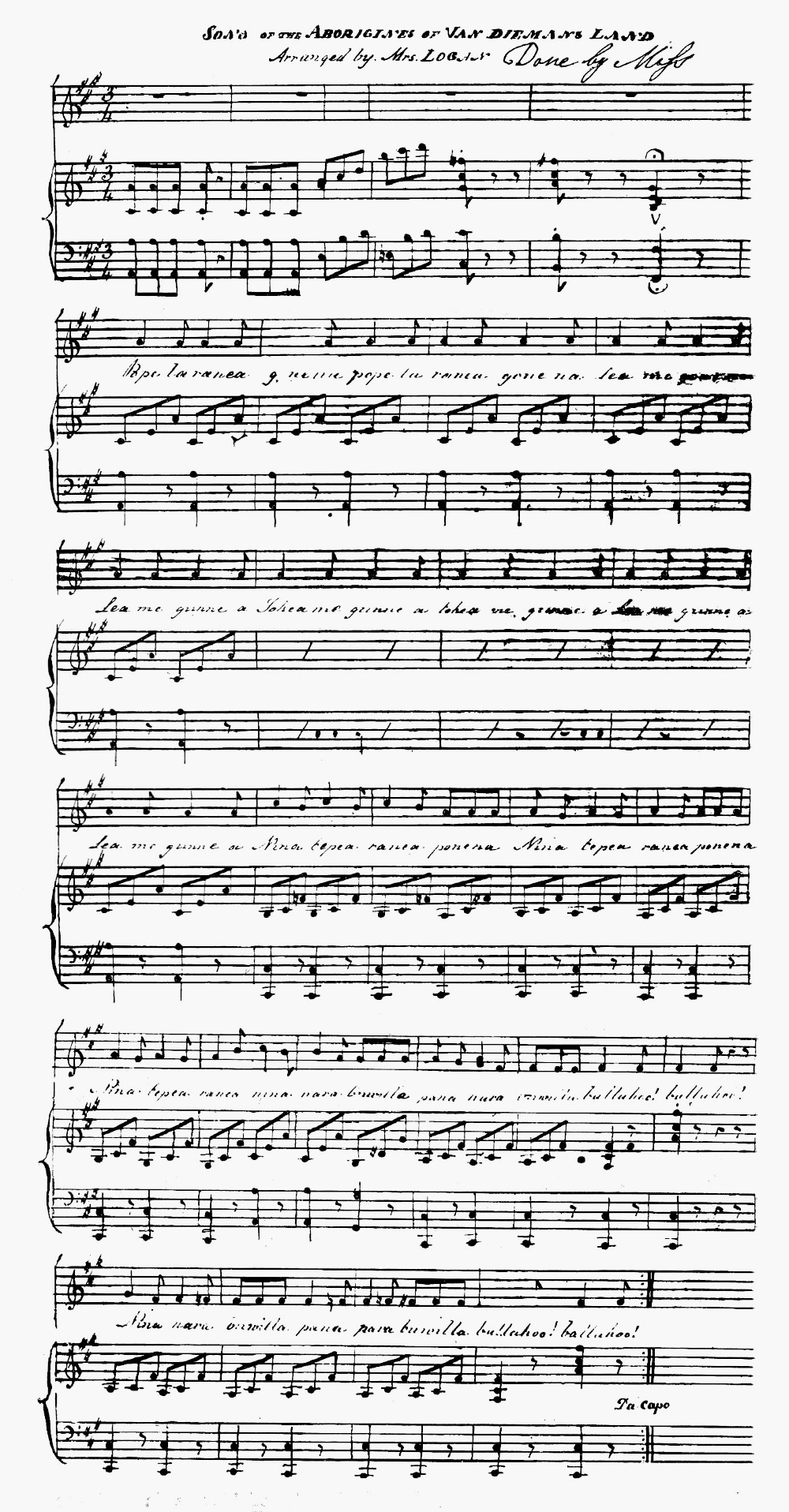
Above, a "cleaned" fascimile of the earlier manuscript, first published in Moyle 1968, unnumbered plate between pages 10 and 11
http://eprints.utas.edu.au/14095 (DIGITISED)
Reproduced here by kind permission of her estate © 1968, 2016
See also Canberra, AIATSIS, Alice Moyle Collection, MS 3501
https://aiatsis.gov.au/sites/default/files/catalogue_resources/MS3501_Moyle_2021.pdf
Sound:
Synthesised sound file, Logan 1836 earlier MS (corrected), Australharmony 2016
R. H. Davies, "ON THE ABORIGINES OF VAN DIEMEN'S LAND", Tasmanian Journal (January 1846), 411
http://aiatsis.gov.au/sites/default/files/catalogue_resources/m0041246v2p409-420.pdf (DIGITISED)
"ON THE ABORIGINES OF VAN DIEMEN'S LAND. BY R. H. DAVIES, Esq.", The Courier (7 March 1846), 4
http://nla.gov.au/nla.news-article2946174
The following is a song of the Ben Lomond tribe; I cannot translate it, nor, could I do so, is the subject very select:
Ne popila raina pogana,
Ne popila raina pogana,
Ne popila raina pogana.
Thu me gunnea,
Thu me gunnea,
Thu me gunnea.
Thoga me gunnea,
Thoga me gunnea,
Thoga me gunnea.
Naina thaipa raina pogana,
Naina thaipa raina pogana,
Naina thaipa raina pogana.
Kiara paara powella paara,
Naara paara powella paara,
Naara paara powella paara.
Ballahoo, Ballahoo,
Hoo, hoo !
(Their war-whoop, very gutteral [sic])
Joseph Milligan, "On the dialects and language of the Aboriginal Tribes of Tasmania, and on their manners and customs", Papers & Proceedings of the Royal Society of Tasmania 3/2 (1866), 273
http://eprints.utas.edu.au/19369 (DIGITISED)
ABORIGINAL VERSES in honour of a Great Chief, sung as an accompaniment to a Native Dance or Riawé.
Pappela Rayna 'ngonyna, Pappela Rayna 'ngonyna,
Pappela Rayna 'ngonyna!
Toka mengha leah, Toka mengha leah,
Toka mengha leah!
Lugha mengha leah, Lugha mengha leah,
Lugha mengha leah!
Nena taypa Rayna poonyna, Nena taypa Rayna poonyna,
Nena taypa Rayna poonyna!
Nena nawra pewyllah, Pallah nawra pewyllah,
Pellawah, Pellawah!
Nena nawra pewyllah, pallah nawra pewyllah,
Pellawah, Pellawah!
Song of the Aborigines (arranged by Mrs. Logan)
Manuscript, copy, 1890s, at University of Tasmania Library (the catalogue record dates this sketch MS to 1856)
http://eprints.utas.edu.au/1866 (DIGITISED)
https://trove.nla.gov.au/work/3882084 (TROVE)
This later copy appeared to have been made, c.1890s, by Henry Lloyd, of Prahran, VIC.
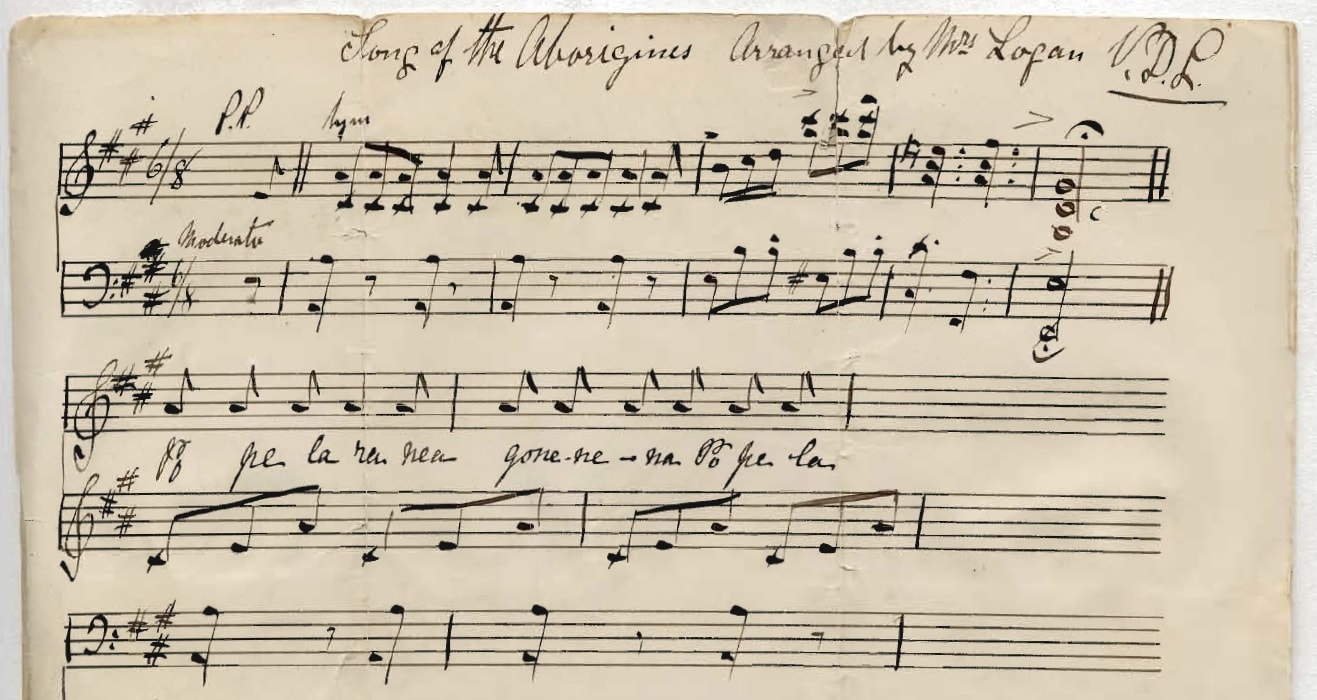
Modern edition:
Logan 1836, earlier and later MSS compared, melody line only
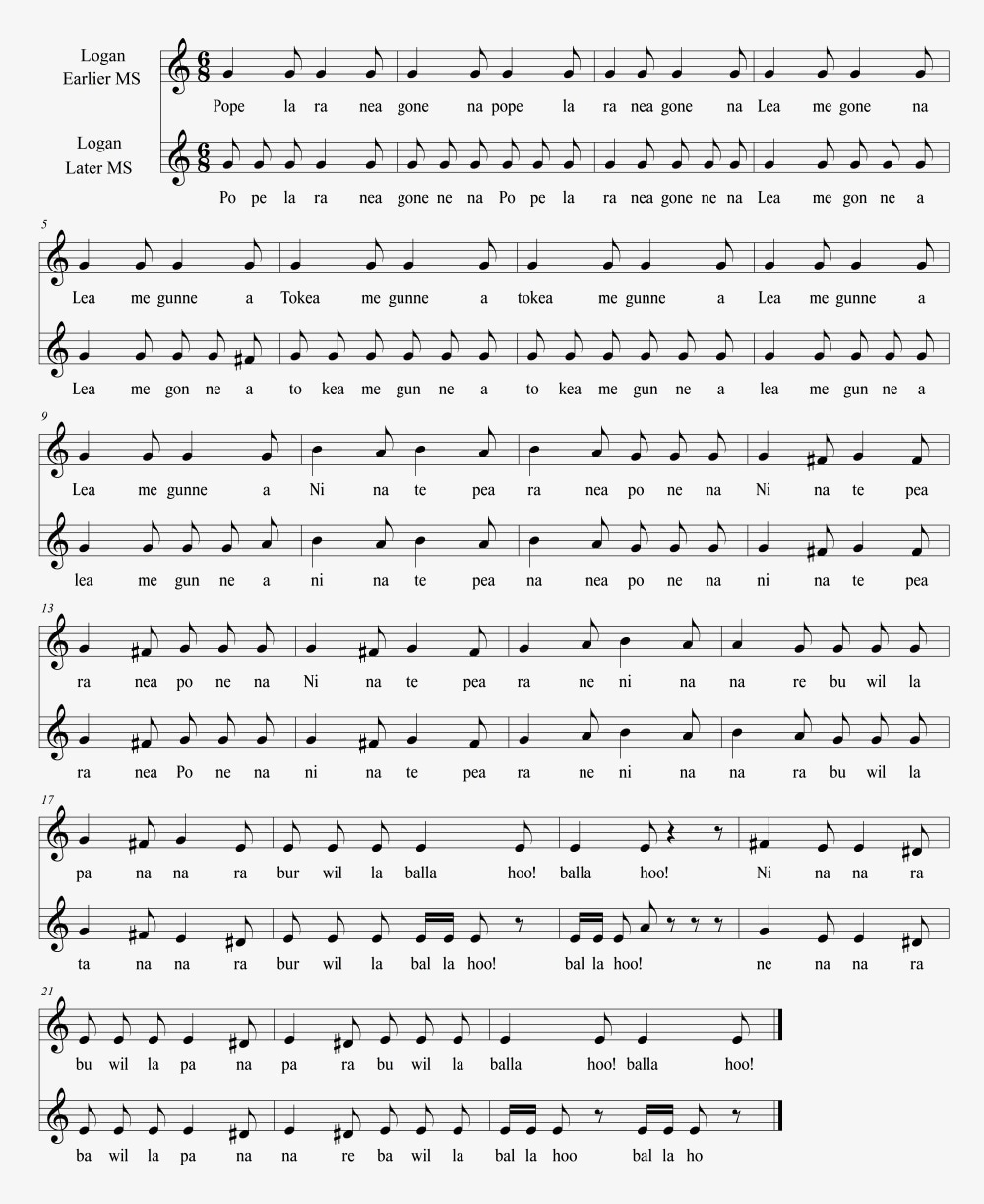
Bibliography:
? "Y.M.C.A. MEETING", Launceston Examiner (31 August 1883), 3
http://nla.gov.au/nla.news-article38288849 (DIGITISED)
One of those social reunions which have popularised the Y.M.C.A. Association to the general public took place last evening at the Wesleyan Sunday schoolroom . . . A Tasmanian Aboriginal song, contributed by the Rev. C. Price, who accompanied himself on a bell, proved highly amusing and aceptable . . .
ASSOCIATIONS: Charles Price (Congregational clergyman)
Hermann B. Ritz, "An introduction to the study of the Aboriginal speech of Tasmania (read November 16, 1908)", Papers and Proceedings of the Royal Society of Tasmania (1908), 73-83
http://eprints.utas.edu.au/16462 (DIGITISED)
"ABORIGINAL SONGS", Daily Post (21 November 1908), 10
http://nla.gov.au/nla.news-article181621319 (DIGITISED)
Murray Longman, "Songs of the Tasmanian aborigines as recorded by Mrs. Fanny Cochrane Smith", Papers and Proceedings of the Royal Society of Tasmania 94 (1960), 79-86 (henceforth Longman 1960)
http://eprints.utas.edu.au/14096 (DIGITISED)
Alice Moyle, "Two native song-styles recorded in Tasmania", Papers and Proceedings of the Royal Society of Tasmania 94 (1960), 73-78 (henceforth Moyle 1960)
http://eprints.utas.edu.au/14095 (DIGITISED)
N. J. Brian Plomley (ed.), Friendly mission: the Tasmanian journals and papers of George Augustus Robinson, 1829-1834 (Hobart: Tasmanian Historical Research Association, 1966), 399, 469-70 note 250
https://trove.nla.gov.au/work/8477354
Alice M. Moyle, "Tasmanian music, an impasse?", Records of the Queen Victoria Museum, Launceston 26 (May 1968), 1-10 (henceforth Moyle 1968)
http://qvmag.slimlib.com.au:81/vufind/Record/715547
N. J. B. Plomley (ed.), Weep in silence: a history of the Flinders Island Aboriginal settlement with the Flinders Island journal of George Augustus Robinson, 1835-1839 (Hobart: Blubber Head Press , 1987), 391, 657 note (22 October 1836, note 1)
https://trove.nla.gov.au/work/9658451
Cassandra Pybus, "Oyster Cove 1988" [Aboriginal history associated with Oyster Cove], Meanjin 47/4 (Summer 1988), 583
Graeme Skinner, Toward a general history of Australian musical composition: first national music, 1788-c.1860 (Ph.D thesis, Sydney Conservatorium of Music, University of Sydney, 2011), 127, 442
http://hdl.handle.net/2123/7264 (DIGITISED)
Graeme Skinner, "Recovering musical data from colonial era transcriptions of Indigenous songs: some practical considerations", in Jim Wafer and Myfany Turpin (eds), Recirculating songs: revitalising the singing practices of Indigenous Australia (Canberra: Asia-Pacific Linguistics, 2017), 341-48
http://hdl.handle.net/1885/132161
https://openresearch-repository.anu.edu.au/bitstream/1885/132161/25/16_skinner.pdf (FREE DOWNLOAD)
Graeme Skinner and Jim Wafer, "A checklist of colonial era musical transcriptions of Australian Indigenous songs", in Jim Wafer and Myfany Turpin (eds), Recirculating songs: revitalising the singing practices of Indigenous Australia (Canberra: Asia-Pacific Linguistics, 2017), 373-74
http://hdl.handle.net/1885/132161
https://openresearch-repository.anu.edu.au/bitstream/1885/132161/26/17_skinner_wafer.pdf (FREE DOWNLOAD)
c.1836-38
10 2 songs
Ngarigu, Monaro area, southern NSW
Music and words collected (? and transcribed) by Henry Tingcombe (1810-1874), probably during his residence there, c. 1836-40; arranged by Isaac Nathan (1792-1864), 10.1 by May 1842, first published Sydney, July 1842; 10.2 by July 1844; first published Sydney, 1848-49
https://sydney.edu.au/paradisec/australharmony/checklist-indigenous-music-1.php#010 (shareable link to this entry)
10.1 Koorinda braia
10.1 "Koorinda braia"
text: Koorinda braia . . . [repeat]
gloss: "the red and white chalk with which the paint their faces on days of festivity" (Nathan 1848-49, 107)
analytics: Monaro area, southern NSW (region); ECA (music region); South-eastern PN/ Yuin/ Ngarigu (language)
Source and documentation:
[Advertisement], The Sydney Gazette and New South Wales Advertiser (24 May 1842), 3
http://nla.gov.au/nla.news-article2556557 (DIGITISED)
THE SPACIOUS HALL, SYDNEY COLLEGE, having been kindly granted for this occasion to MR. NATHAN,
A GRAND SELECTION OF VOCAL AND INSTRUMENTAL MUSIC WILL BE PERFORMED On FRIDAY Evening, 27th May, 1842 . . .
PROGRAMME . . . Koorinda Braia, Solo Quartetto, and Chorus - Inscribed to Mrs E. Deas Thomson. A genuine Aboriginal Melody, sung by the Maneroo tribe of Australia -
presented to Mr. Nathan, by a highly respectable merchant of this Colony, and its authenticity identified and fully established by several native blacks . . .
"MR. NATHAN'S CONCERT", The Sydney Herald (30 May 1842), 2
http://nla.gov.au/nla.news-article12875453 (DIGITISED)
. . . We were much delighted with some of Mr. Nathan's new Australian Melodies, which we had on this occasion an opportunity of hearing performed under his own direction . . . the most striking of these is Koorinda Braia, a solo, quartette, and chorus. This melody and words are aboriginal; in the accompaniment the idea of the stick-beating by the gins is most cleverly maintained; the Cooee is introduced with really a most pleasing effect, and the variety of harmonics which are ingrafted upon the paucity of melody, says very much for Mr. Nathan's knowledge of the science. The introduction of these harmonics is certainly a liberty; but we cannot help forgiving it in our admiration of the beauty and cleverness of the composition.
"ORIGINAL CORRESPONDENCE. CONCERT. To the Editor of . . .", The Australian (31 May 1842), 2
http://nla.gov.au/nla.news-article37115169 (DIGITISED)
Sir, - I am induced to trouble you with a letter, for the purpose of congratulating the inhabitants of Sydney on the very good Concert which was given last evening in the Hall of the College, by Mr. Nathan and his talented family . . . The genuine Aboriginal "Koorinda Braia" was genuine no doubt, but it is to be doubted if the introduction of such sounds in a Concert Room be calculated to inspire a refined taste for music . . .
"Mr. Nathan's Concert", The Sydney Gazette and New South Wales Advertiser (2 June 1842), 3
http://nla.gov.au/nla.news-article2556644 (DIGITISED)
. . . Koorinda Braia was a fine specimen of good music, well performed. The solo part was by a young lady, whom we congratulate on her successful debut, and whom we hope to have frequent opportunities of hearing again . . .
Koorinda braia, an Aboriginal native song, put into rhythm, harmonised, and inscribed to Mrs. E. Deas Thomson, by I. Nathan, Sydney, 1842
https://trove.nla.gov.au/work/21236841
http://nla.gov.au/nla.obj-168218284 (DIGITISED)
The complete musical and linguistic content of the source song appears in the first 12 bars of the vocal line only below
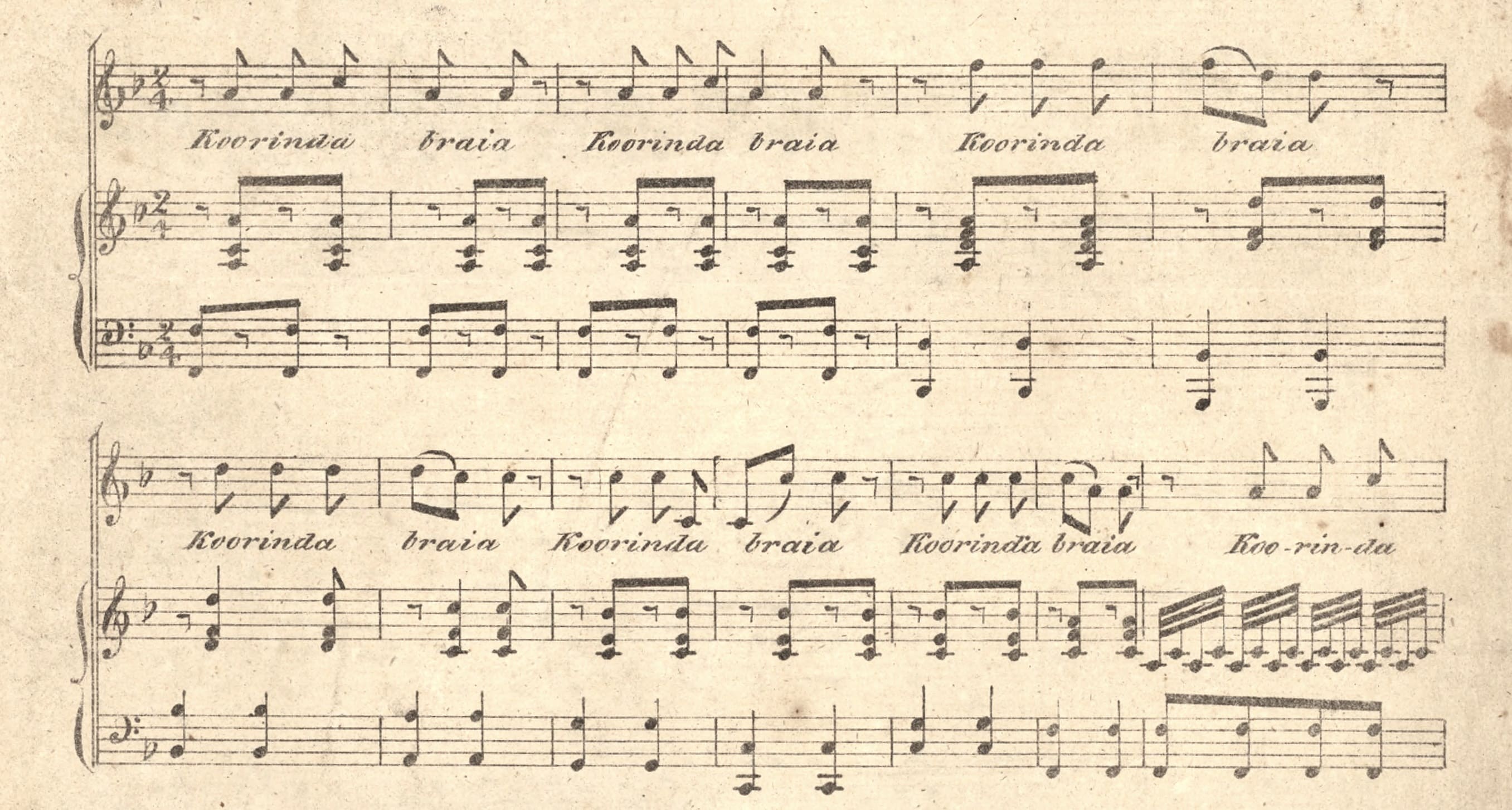
Sound:
Koorinda braia (1842), synthesised performance with score, Australharmony 2019
https://www.youtube.com/embed/gig8EpkWqaU (STREAMED)
Synthesised sound file, Australharmony 2016
"NEW MUSIC", Australasian Chronicle (2 July 1842), 3
http://nla.gov.au/nla.news-article31736395
"Koorinda Braia," an Aboriginal Native Song, put into rhythm, harmonised, and inscribed to Mrs. E. Deas Thomson, by I. Nathan. Sydney. 1842.
This, if not the most elaborate, is, to our taste, the most interesting, of Mr. Nathan's colonial compositions, inasmuch as it is destined to be preserved as a memorial of ancient Australian melody after the race of ill fated aborigines shall have ceased for ever to sing and hold their corroborees on their invaded territories. The melody is extremely simple, and is preserved with great propriety by the composer in its original state. The harmony is also simple, but it is that kind of simplicity in which the master hand appears to the greatest possible advantage. Before commencing the song, which is in common time, the natives, by striking two pieces of wood against each other, beat two or three bars of perfect measure in treble time. Mr. Nathan has given a very good imitation for the piano of this kind of invocation as a prelude to the air, which he gives first as a solo, with varied accompaniments, and concludes the whole with a chorus for two trebles, two tenors, and bass, the stick beating process being again partially introduced in the accompaniment, as well as the singular Australian coo-ey, which, how-ever, Mr. Nathan very properly states, has no relation to the melody, and is merely introduced ad libitum. The effect is certainly very curious. We would recommend the composer to have this interesting piece published in London, where it cannot fail to attract attention from the many who feel an interest in every thing tending to illustrate the manners and habits of savage tribes. We wish we could add that we hope the publication will be appreciated in the colony as we are convinced it deserves to be.
"COOING WITHOUT BILLING", The Australian (8 August 1842), 2
http://nla.gov.au/nla.news-article37118235 (DIGITISED)
We have often heard of one man being infected with he Cacaethes Scribendi, and another with the Cacaethes Loquendi; and we have known thousands infected with the Cacaethes Curpendi, but until lately we had never heard of any individual who had been infected with the "Cacaethes Kooi." It now appears that ever since Nathan, not the prophet who said unto David "thou art the man," but Nathan our Anstralain composer, has sent forth to the musical world his Aboriginal melody "Koorinda Braia," the ladies, of Sydney have all become infected with a mania for cooing: there in scarcely a party now given where the visitors are not greeted with a cooey or a "Koorinda Braia."
Joking apart, we are happy to find this ingenious production introduced into the drawing room, and likely to become so general a favourite; it is no more than what we anticipated when we first heard it performed under the composer's own direction at the Sydney College, in June last; there was then but one opinion expressed in admiration of the singular and pleasing effect it produced upon the delighted audience. Those who are capable of appreciating the beautiful richness of harmony which Nathan generally introduces into all his compositions, must admire to enthusiasm his ingenious mode of treating this simple Aboriginal Melody, which in common treatment, gives only for its bass the tonic and dominant. Who but a true musical genius and theorist like our English composers could have repeated, as he has done, this short melody of only eight bars, seven times, and excite in the listener a desire to hear it again repeated seven times without dread of offending the ears by the least shadow of monotony? monotony which the composer has most ingeniously avoided by his brilliant bursts of scientific and characteristic discords elegantly resolving into concords to every repetition of the melody; and what makes this singular relief from monotony so very extraordinary is the fact, that we have but two words to the whole composition, namely, "Koorinda Braia," and these two words are repeated two and forty times; thus, an an encore gives us eighty-four "Koorinda Braia's" - which the audience at the Sydney College listened to with delight, and appeared as if they could have listened to it again with pleasure, exclaiming with our immortal bard, "Go on? had I three ears I would hear thee."
With regard to the cooey so effectively introduced at the conclusion of the composition, we cannot pass a greater compliment on Nathan than quote what a contemporary has already said, that "when we first heard the cooey we thought it issued from some person lost in the Bush." We have now only to offer our best apology to the ladies, for presuming to interfere with their cooing, and are ready to admit that every excuse must be allowed for the fascinating appearance of "KOORINDA BRAIA."
"MR. NATHAN AND HIS AIRS IN AUSTRALIA", The Sydney Gazette and New South Wales Advertiser (18 August 1842), 3
http://nla.gov.au/nla.news-article2557151 (DIGITISED)
. . . Mr. Nathan, since his arrival amongst us, has earned "golden opinions of all sorts of men,"
and his endeavours to set to music the poetry of the highly gifted Mrs. Dunlop, adds another laurel to the crown won by his meritorious adaptation of Byron's Hebrew melodies.
Still, "Koorinda Braia" strikes us, with all its nativeness, as a hoax on that science which is a kin to mathematics;
and if any one more gifted than another with the rudiments of Apollo's school can descry a refinement of harmony in the aforesaid "Koorinda Braia,"
we lay our judgment on the shelf . . .
[We insert the above facetious paragraph which has been written for our columns by an itinerant musician.
Mr. N. cannot take offence at the jealousy of the poor unfortunate whose pocket and elbows bear a great similitude, being both out, - ED. SYD. GAZ.]
[Advertisement], The Sydney Morning Herald (27 August 1842), 1
http://nla.gov.au/nla.news-article12408146 (DIGITISED)
AUSTRALIAN MELODIES, AUSTRALIAN and ABORIGINAL MELODIES, by Nathan . . .
KOORINDA BRAIA - Inscribed to Mrs. E. Deas Thomson.
THE EAGLE CHIEF - Inscribed to Lady O'Connell.
THE ABORIGINAL MOTHER - Inscribed to Lady Gipps . . .
Published by the Composer, Ada Cottage, Prince-street.
[Advertisement], The Australian (9 July 1844), 1
http://nla.gov.au/nla.news-article37123781 (DIGITISED)
SONS OF AUSTRALIA, THE fifth Philharmonic Concert will take place at the Royal Hotel, on
Thursday next, July 11th, under the patronage of THE AUSTRALIANS,
On which occasion will be performed two Aboriginal melodies,
WARGOONDA MINYARA and KORUNDA BRAIA [sic] . . .
CONDUCTOR - MR. NATHAN . . .
"BERRIMA", The Australian (31 May 1845), 3
http://nla.gov.au/nla.news-article37157263 (DIGITISED0
. . . The day being the sabbath of the Jews, and the next day being the sabbath of the Christians, their commemoration of the anniversary of the birth of the Queen, to whom they as a body are much indebted for the many privileges which they now enjoy, was postponed until Monday, when Mr. Joseph Levy, of the "Queen Victoria Inn," entertained at a dinner seventeen of the aborigines, men and women, the King and Queen of Berrima presiding in state on the occasion. The toast was a sumptuous one. A sheep, with abundance of vegetables and bread, a plum pudding, diluted at intervals with potations of good porter, and the whole seasoned with a plentiful and generous supply of grog. After dinner, pipes and tobacco were handed round, and the male blacks having been supplied with musical instruments, consisting of bones from the slaughter-yard, the King commenced to sing, beating time on the table with his "truncheon;" the Queen followed his example; the rest all joined, keeping good time with their several instruments, and equally good time with their voices. Koorinda Braia, and several national airs, were sung with much spirit. In the evening the merry dance was begun; they tripped it merrily, loudly and lustily, dancing the Emu and Kangaroo dances, and many others, with a good will, and such life and true animation, that the observer could at once pronounce that they enjoyed themselves without one shade of care or sorrow . . .
Second edition (with additional kooees):
Isaac Nathan, The southern Euphrosyne, and Australian miscellany: containing oriental moral tales, original anecdote, poetry and music (Sydney: I. Nathan, [1848-49]):
99-101 (commentary)
https://books.google.com.au/books?id=ziwieom4lBQC&pg=PA101 (DIGITISED)
http://nla.gov.au/nla.obj-166023361/view#page/n108/mode/1up (DIGITISED)
A SCENE FROM THE DISTRICT OF PORT MACQUARIE. AMONG the numerous ceremonies peculiar to the aborigines of this vast island, perhaps there are none more really imposing than that of the Kibbarah; and as it rarely falls to the lot of a white man to witness its orgies in detail, the following attempt at describing them (the writer having been an eye-witness on more than one occasion) may not prove uninteresting . . . [101] . . . This final rite duly accomplished, a loud koo-ee rings out its warning note for the women to return to the encampment. Sufficient time having elapsed, the tribes follow, singing the "Koorinda-braia" (the song of peace) as they return in procession. Everything finished, they separate to their own respective encampments . . .
107, 126 (commentary, see also 108)
https://books.google.com.au/books?id=ziwieom4lBQC&pg=PA107 (DIGITISED)
http://nla.gov.au/nla.obj-166023361/view#page/n116/mode/1up (DIGITISED)
KOORINDA-BRAIA.
The Koorinda-braia is a song of rejoicing, held in great estimation by the aborigines, and sung by them at their Corrobories and Kibbarahs; their mode of singing this and all their native strains, whether the subject be plaintive or cheerful is somewhat singular: the following description may not prove uninteresting.
Before they commence the Koorinda-braia which is in 2/4 time, they first [by stricking two peices [sic] of stick against each other] beat two or three bars in perfect measure to triple-time, seemingly as if trying to excite inspiration; they then continue beating and marking the time and rhythm, with accuracy not to be surpassed by the best musicians at the Italian Opera, of the melody which is sung with equal correctness, repeating the song several times; each repetition with increased energy and animated gestures-until the singers become completely exhausted by their enthusiasm.
It is perfectly ludicrous to see, as we have seen, one of these wild aboriginal music directors or time keepers, with all the grimace, gestures, and consequence of a connoisseur, stop his sablefaced singers, and compel them to re-commence their song-at the slightest innovation or defect of time, rhythm, or accent.
Shortly after our arrival in Sydney, we published this Koorinda-braia. as sung by the Maneroo tribe; which we shall at some future period re-print.
Maneroo is by the aborigines pronounced "Minaroo" which signifies an open space or plain; hence the Maneroo tribe literally means the "Tribe of the Plains."
What "Koorinda-braia" really imports, we could never satisfactorily ascertain: many persons whom we have consulted, are of opinion, that it is the name of one of their cheifs [sic], whose memory they venerate, and always eulogise in song. We have questioned the aborigines on the subject, but, either from some superstitious motive, or a desire to prevent us from becoming as wise as themselves, no two of them give the same translation. One of them who alternately laughed and wept from excessive joy, at hearing his own native, melody, sung and accompanied by us on our Piano Forte, most positively affirmed, that "Koorinda-braia," meant nothing more nor less than the red and white chalk with which they paint their faces on days of festivity.
[126] Having trespassed largely on the limited number of pages originally set apart in our Euphrosyne, for the publication of music, we must now conclude our examples and illustrations of aboriginal airs, with a new edition of KOO-RIN-DA BRAI-A; which may be thought acceptable, since the melody is as popular and well-known to every Australian, as God save the Queen to every Englishman.
127-32 (music and words, second "new" edition, with koo-ees added, see 1 above)
https://books.google.com.au/books?id=ziwieom4lBQC&pg=PA127 (DIGITISED)
http://nla.gov.au/nla.obj-166023361/view#page/n136/mode/1up (DIGITISED)
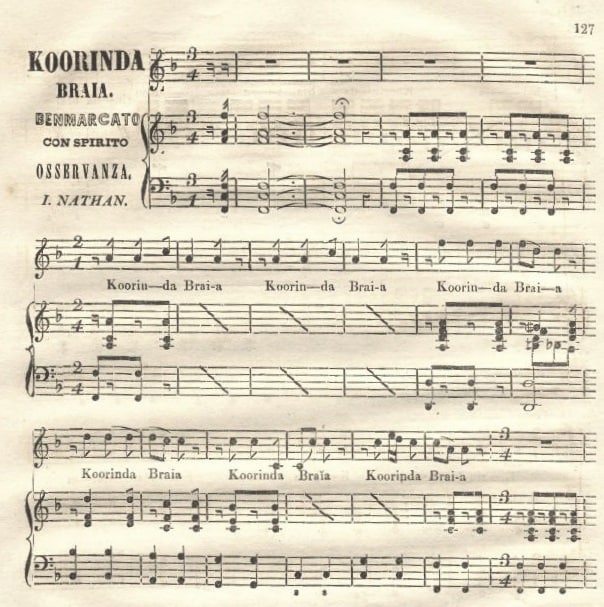
10.2 Wargoonda minyarah
10.2 "War-goon-da min-ya-rah"
text: Wargoonda min-ya-rah / min-ya-kol-ba-wan-de-re?/ Wargoonda min-ya-rah / min-ya kol-ba wan-de-re?/ Wande-re wande-re / min-ya kol-ba wande-re / wande-re wande-re/ wande-re wande-re/ wande-re wande-re wande-re/ Wan-de-re wan-de-re / min-ya kol-ba wan-de-re/ wan-de-re wan-de-re/ min-ya kol-ba wan-de-re / wan-de-re wan-de-re / wan-de-re wandere wande-re (Nathan 1848-49, 109-13)
gloss: What is the matter? Where were you? (or:) What did you do? How is this? What have you been doing? On the Rocky Mountains. Did white man give bread? (Nathan 1848-49, 108)
analytics: As for 10.1
Source and documentation:
[Advertisement], The Australian (8 July 1844), 2
http://nla.gov.au/nla.news-article37122508 (DIGITISED)
SONS OF AUSTRALIA,
THE fifth Philharmonic Concert will take place at the Royal Hotel, on
Thursday next, July 11th, under the patronage of THE AUSTRALIANS,
On which occasion will be performed two Aboriginal melodies,
WARGOONDA MINYARA and KORUNDA BRAIA [sic] . . .
CONDUCTOR - MR. NATHAN . . .
"THE FIFTH PHILHARMONIC CONCERT", The Australian (11 July 1844), 3
http://nla.gov.au/nla.news-article37124057 (DIGITISED)
We are glad to find that Mr. Nathan has been honored by the patronage of the Natives of Australia, under whose auspices the fifth Philharmonic Concert will take place this evening at the Royal Hotel . . . and the programme includes some original native melodies which have been arranged by Mr. Nathan . . .
"THE PHILHARMONIC CONCERT", The Australian (12 July 1844), 3
http://nla.gov.au/nla.news-article37118975 (DIGITISED)
. . . Two original Aboriginal Melodies, arranged by Mr. Nathan, attracted much attention, and were deservedly successful.
NOTE: This first documented performance of Nathan's arrangement of Wargoonda predates its publication, in 1848-49 (see below), by three and a half years.
Isaac Nathan, The southern Euphrosyne, and Australian miscellany (Sydney: I. Nathan, [1848-49]), 108 (description), 109-13 (music)
https://books.google.com.au/books?id=ziwieom4lBQC&pg=PA108 (DIGITISED)
http://nla.gov.au/nla.obj-166023361/view#page/n117/mode/1up (DIGITISED)
WAR-GOON-DA MIN-YA-RAH.
WAR-GOON-DA MIN-YA-RAH is another genuine aboriginal song of the Maneroo tribe, in great request among our antipodal brethren, and is sung by them after the fashion of the Koorinda-braia, at the "Corrobories" and "Kibbarahs." The melody which is short and simple, comprehending only four measures, but capable of producing great variety of effect, from the animated mode of the natives singing: was kindly presented to us by the Revd. Henry Tincombe [sic, Tingcombe], together with the Koorinda-braia; a gentleman who resided for several years at Maneroo, where he had frequent opportunities of hearing it sung by the aborigines of that district.
Altho' the whole of the melody of Wargoonda min-ya-rah, as sung by the Maneroo tribe, is contained within the first four bars of the music subjoined to this article by way of illustration; we have added several phrases to the original melody, with a coda in imputation of the several varieties of styles we have heard from the Goulburn tribe, the Wellington, and other tribes, each tribe having its own peculiar melody.
It may be here necessary to remark, that the aborigines throughout Australia have no musical instrument of any description, not even that instrument of concussion, the drum, so generally used by every other uncivilized nation in the known world: our Piano Forte accompaniment, therefore, must be considered as an effort on our part, to convey to the unskilled some faint notion of the energetic style of the aboriginal music: - and altho' we have been favored by some characteristic stanzas [an impromptu] from the pen of the talented author of "Merry Freaks in troublous times," [Charles Nagel] well adapted to the melody; the true character and expression of the music, cannot be properly appreciated without the original words, we therefore submit the best literal translation we can command, for the accomodation of those-who desire to try the effect, a la "black fellow."
LITERAL TRANSLATION.
War-goon-da or Wear-goon-da - What is the matter?
Min is an abbreviation of Mina-winda - Where were you? What did you do?
Ya is an abbreviation of Yaninda - How is this?
Min-ya - What have you been doing?
Kol-ba or Koll-ba - On the Rocky Mountains.
Wandere, perhaps from Wandago-dere - Did white man give bread?
THE PRONUNCIATION.
War-goon-da.- The a in both syllables war and da has the same broad open-mouthed sound, as the a in the cry of the lambs ba: g in the middle syllable goon is hard, and is pronounced like goo in good.
Min-ya-rah. - The first syllable has the intonation of Mint, without the t; yah has the same sound as the first two letters in Yarmouth: the a in rah has the same broad sound as noticed in War-goon-da, but the final h requires a particular aspiration, leaving off with a sudden jerk.
Kol-ba pronounced Koll-ba, to make this word particularly characteristic of the aboriginal style of singing, the ba must be produced by snapping the lips asunder, with a strong expulsion of breath, and then keeping the mouth well open on the broad-sounding a, so as to vie in expression with the ba of a whole flock of sheep.
Wandere - The a in wan cannot be too broad: the e in de has the sound of our English a in David; and re has the sound of ra in raven.
War-goon-da min-ya-rah, an aboriginal melody, sung by the Maneroo tribes of Australia, put into modern rhythm, harmonized and arranged, with characteristic additions, by I. Nathan, esq. . . ., 109-13 [music]
https://books.google.com.au/books?id=ziwieom4lBQC&pg=PA109 (DIGITISED)
http://nla.gov.au/nla.obj-166023361/view#page/n118/mode/1up (DIGITISED)
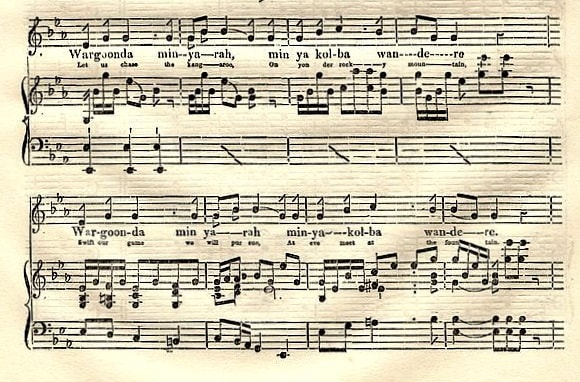
Bibliography:
"ORANGE", Bathurst Free Press and Mining Journal (1 December 1858), 2
http://nla.gov.au/nla.news-article64376514 (DIGITISED)
The "magic spell is broken," and the elite of Orange (notwithstanding the magniloquent exhibition of their "Travelling" champion to the contrary a short time ago,) actually listened to and expressed applause at the performances of the Buckingham family on Wednesday evening last . . . Nathan's "Koorinda Braia," embracing all the known "Kooee's" for sixteen, and chorus for twenty-one voices, would as certainly attract the dwellers of the bush, as the production of a good Kooee in the streets of London has been proved to assemble all the Australians within hearing . . .
Robert Etheridge, Contributions to a catalogue of works, reports, and papers on the anthropology, ethnology, and geological history of the Australian and Tasmanian Aborigines . . . part 2 (Memoirs of the geological survey of New South Wales, palaeontology 8) (Sydney: Government Printer, 1891) (henceforth Etheridge 1891), 36
https://archive.org/stream/contributionsto00ethegoog#page/n83/mode/2up (DIGITISED)
[S. M. Mowle], Aboriginal songs: a few words of their language and mis-spelt names of places ([Sydney: Government Printer], 1891)
S. M. Mowle, "Aboriginal songs and words", Australian Town and Country Journal (16 May 1896), 24
http://nla.gov.au/nla.news-article71245725 (DIGITISED)
. . . ABORIGINAL SONGS. (A few words of their language and mis-spelt names of places.)
Korindabria, korindabria, bogarona, bogarona. Iwariniang, iwaringdo, iwariniang, iwaringdo, iwariniang, iwaringdo, iwariniang, iwaringdo, iwaringime. Iwaringiang, iwaringdoo, ilanenienow, coombagongniengowe, ilanenienow, coombagongiengowe, ilanenienowe, coombagoniengowe, ilanenienimme.
"SONGS BY AUSTRALIAN BLACKS, COLLECTED BY MESSRS. DOHERTY, PITT, AND HASSEL", Australasian anthropological journal 1/3 (27 February 1897), 8
https://nla.gov.au/nla.obj-568402794/view#page/n9/mode/1up (DIGITSED)
Three songs obtained through the kindness of Mr. W. M. Doherty, F.C.S., as sung by blacks in the Domain 40 years ago, and taken down by Mr. Nathan, a musician of that time.
No. I. - Each line sung in different notes.
De-tol, de-tol, Bah-loo-nay, Bah-loo-nay,
Bah-loo-nay, Bah-loo-nay, Bah-loo-nay;
De-tol, de-tol, Bah-loo-nay.
No. 2. - Each line sung differently, the last in falsetto voice.
Kah-rin-dah, Brah-yah, kah-rin-dah, Brah-yah,
Kah-rin-dah, Brah-yah, kah-rin-dah, Brah-yah,
Kah-rin-dah, Brah-yah, kah-rin-dah, Brah-yah,
Coo-ee-h.
No. 3. - The air changes all through.
Wog-gan-dah, mim-yee-rah, mee-nah-col-bah,
Wun-dag-er-ree, wun-dag-er-ree, mee-nah,
Col-bah, wun-dag-er-ree.
The following is the song of the blacks, as heard 70 years ago by Mr. G. M. Pitt, at Richmond, on the Hawkesbury:
Murring anna juriwanna,
Woodgeree wanna,
Geeli, geeli. Angi, Argo, Bah.
(This sung many times.)
Go at Poto Pah, coogee Mia-a.
W. Arundel Orchard, Music in Australia: more than 150 years of development (Melbourne: Georgian House, 1952), 213 (Koorinda braia only, melody and words)
https://archive.org/details/in.ernet.dli.2015.28983/page/n253/mode/1up (DIGITISED)
Roger Covell, Australia's music: themes of a new society (Melbourne: Sun Books, 1967), 68
Nicole Saintilan, "Music - if so it may be called": perception and response in the documentation of Aboriginal music in nineteenth century Australia (M.Mus thesis, University of New South Wales, 1993), 68-72
http://hdl.handle.net/1959.4/50383 (DIGITISED)
Graeme Skinner, Toward a general history of Australian musical composition: first national music, 1788-c.1860 (Ph.D thesis, Sydney Conservatorium of Music, University of Sydney, 2011), 189-196, 198-200
http://hdl.handle.net/2123/7264 (DIGITISED)
Graeme Skinner, "Recovering musical data from colonial era transcriptions of Indigenous songs: some practical considerations", in Jim Wafer and Myfany Turpin (eds), Recirculating songs: revitalising the singing practices of Indigenous Australia (Canberra: Asia-Pacific Linguistics, 2017), 355-56
http://hdl.handle.net/1885/132161
https://openresearch-repository.anu.edu.au/bitstream/1885/132161/25/16_skinner.pdf (FREE DOWNLOAD)
Graeme Skinner and Jim Wafer, "A checklist of colonial era musical transcriptions of Australian Indigenous songs", in Jim Wafer and Myfany Turpin (eds), Recirculating songs: revitalising the singing practices of Indigenous Australia (Canberra: Asia-Pacific Linguistics, 2017), 374-75
http://hdl.handle.net/1885/132161
https://openresearch-repository.anu.edu.au/bitstream/1885/132161/26/17_skinner_wafer.pdf (FREE DOWNLOAD)
1839
11 3 songs
? Dharug, Sydney area, NSW
Transcribed by Joseph Drayton (1798-1877), member of the United States Exploring Expedition (1838-42), from unidentified singer or singers, December 1839; first published Philadelphia, USA, 1845
https://sydney.edu.au/paradisec/australharmony/checklist-indigenous-music-1.php#011 (shareable link to this entry)
Source and documentation:
Charles Wilkes, Narrative of the United States Exploring Expedition during the years 1838, 1839, 1840, 1841, 1842 (Philadelphia: Lee and Blanchard, 1845) [edition A], volume 2, 198-200 (commentary), 199-200 (music)
https://archive.org/stream/narrativeofunite02wilk#page/n245/mode/2up (DIGITISED)
Wilkes 1845 [edition B], volume 2, 189-90
https://books.google.com.au/books?id=EXAaAQAAIAAJ&pg=PA189 (DIGITISED)
Also many later editions
[Edition A, 198] . . . They have not, properly speaking, any distribution into tribes. In their conflicts, those speaking the same language, and who have fought side by side, are frequently drawn up in battle-array against [188] each other, and a short time after may be again seen acting together . . . When one of either party is killed, a separation takes place, succeeded by another course of recrimination, after which explanations are made, the affair terminates, and hostility is at an end; the two parties meet amicably, bury the dead, and join in the corrobory dance.
These dances are not only the usual close of their combats, but are frequent in time of peace. They appear almost necessary to stir up their blood ; and under the excitement they produce, the whole nature of the people seems to be changed. To a spectator, the effect of one of these exhibitions almost equals that of a tragic melodrame.
A suitable place for the performance is selected in the neighbour-hood of their huts. Here a fire is built by the women and boys, while such of the men as are to take a share in the exhibition, usually about twenty in number, disappear to arrange their persons. When these preparations are completed, and the fire burns brightly, the performers are seen advancing in the guise of as many skeletons. This effect is produced by means of pipe-clay, with which they paint broad white lines on their arms and legs, and on [199]
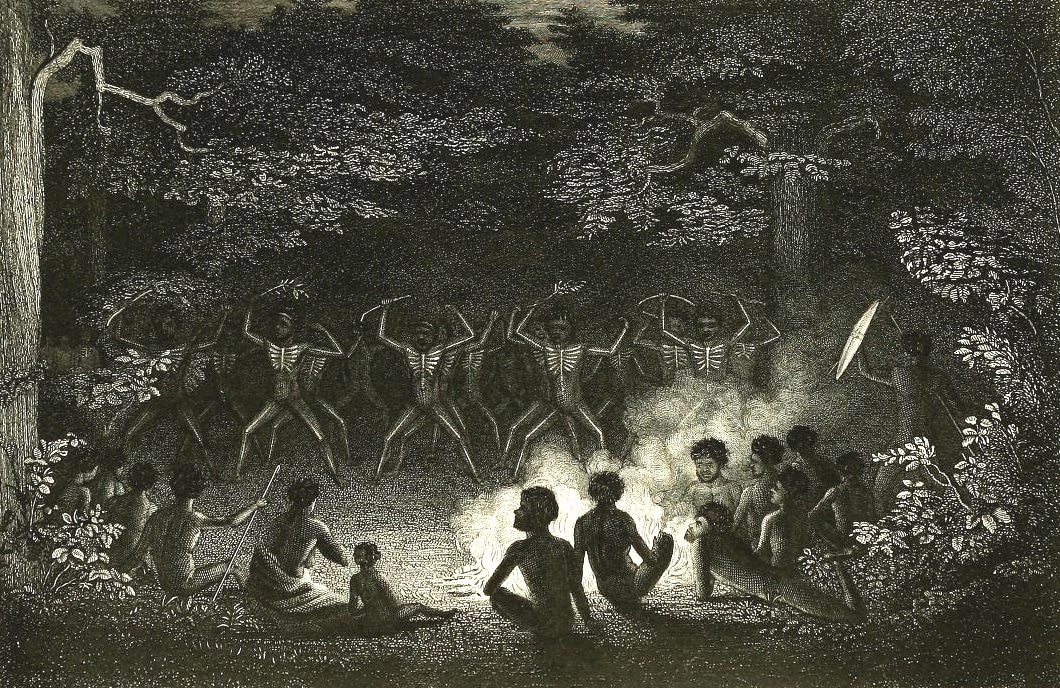
[ABOVE] "Corrobory (Dance), N. H." [New Holland], from Wilkes 1845 [A], plate after page 198
https://archive.org/stream/narrativeofunite02wilk#page/198/mode/2up (DIGITISED)
[199] the head, while others of less breadth are drawn across the body, to correspond to the ribs. The music consists in beating time on their shields, and singing, and to it the movements of the dancers conform. It must not be supposed that this exhibition is a dance in our sense of the word, nor is it like any thing that we saw in the South Sea Islands. It consists of violent and odd movements of the arms, legs, and body, contortions and violent muscular actions, amounting almost to frenzy. The performers appear more like a child's pasteboard supple-jack than any thing human in their movements.
This action continues for a time, and then the skeletons, for so I may term them, for they truly resemble them, suddenly seem to vanish and reappear. The disappearance is effected by merely turning round, for the figures are painted only in front, and their dusky forms are lost by mingling with the dark background. The trees illuminated by the fire, are brought out with some of the figures in bold relief, while others were indistinct and ghost-like. All concurred to give an air of wildness to the strange scene. As the dance proceeds, the excitement increases, and those who a short time before appeared only half alive, become full of animation, and finally were obliged to stop from exhaustion.
These corroborys are the occasion of much intercourse among the tribes, as they frequently make visits to each other for the sole purpose of carrying a new song for the dance. They have several kinds of these dances, which appear to be their only amusement. In their music they do not sound any of the common chords, and the only accompaniment was a kind of bass, as written below, which was in fact only a very deep-toned grunt, sounded, as ho, ho, ho, very deep in the throat. At the end of each dance they finished with a loud whoo, or screech, an octave above the key-note.
11.1 Dance chant
11.1 [No. 1] [music example 1 of 4]
text: [music only, no words]: "The above [i.e. 11.1] is thought by Mr. Drayton not to be entirely native music, but the following [i.e.] he has no doubt of; the words are given as he heard them"
analytics: Sydney area (region); ECA (music region); South-eastern PN/ Yuin-Kuri [Sydney subgroup]/ Dharug (language)
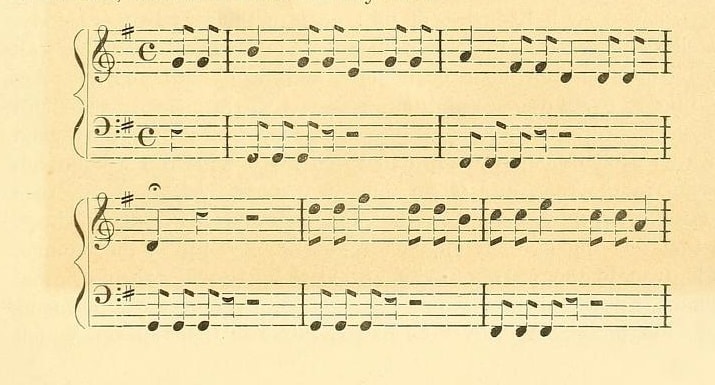
[200] The above is thought by Mr. Drayton not to be entirely native music, but the following he has no doubt of; the words are given as he heard them.
11.2 Merry dunbar aroa
11.2 [No. 2] [music example 2 of 4]
text: Mer-ry dunbar a-roa Merry dunbar a-roa O man gar merry own dunbar run mun gar
analytics: As for 11.1

Merry dunbar aroa Merry dunbar aroa Oman gar merry own dunbar run mun gar.
The above, as well as those which follow, were obtained from a native who was on his way with the new song to his tribe.
11.3 New song
11.3 [No. 3] [music example 3 of 4]
text: [music only, no words]: "The above [i.e. 11.2], as well as those which follow [i.e. 11.3 and Drayton's version of 6.1], were obtained from a native who was on his way with the new song to his tribe."
analytics: As for 11.1

Other documentation (in expedition publications):
Horatio Hale, United States exploring expedition, during the years 1838, 1839, 1840, 1841, 1842, under the command of Charles Wilkes, U.S.N., volume 6, ethnography and philiology . . . (Philadelphia: Printed by C. Sherman, 1846), 110
https://archive.org/stream/unitedstatesexpl06unitrich?ref=ol#page/110/mode/2up (DIGITISED)
https://books.google.com.au/books?id=u_AiPUJHaMYC&pg=PA110 (DIGITISED)
RELIGION. The lack of religious feeling in these natives has already been mentioned. The missionaries have found it impossible, after many years' labor, to make the slightest impression upon them. They do not ascribe this to any attachment, on the part of the blacks, to their own creed, if such it may be called, for they appear to care little about it. Some of their ceremonies, which partook of a religious character, have been lately discontinued, but nothing has been substituted in their place. It is not true, however, as has been frequently asserted, that the natives have no idea of a supreme being, although they do not allow this idea to influence their actions. The Wellington tribe, at least, believe in the existence of a deity called Baiamai, who lives on an island beyond the great sea to the east. His food is fish, which come up to him from the water, when he calls to them. Some of the natives consider him the maker of all things, while others attribute the creation of the world to his son Buramhin. They say of him, that Baiamai spoke, and Burambin came into existence. When the missionaries first came to Wellington, the natives used to assemble once a year, in the month of February, to dance and sing a song in honor of Baiamai. This song was brought there from a distance by strange natives, who went about teaching it. Those who refused to join in the ceremony were supposed to incur the displeasure of the god. For the last three years the custom has been discontinued. In the tribe on Hunter's River, there was a native famous for the composition of these songs or hymns, which, according to Mr. Threlkeld were passed from tribe to tribe, to a great distance, until many of the words became at last unintelligible to those who sang them.
Dararnirgal, a brother of Baiamai, lives in the far west. It was he who lately sent the small-pox among the natives, for no better [111] reason than that he was vexed for want of a tomahawk. But now he is supposed to have obtained one, and the disease will come no more. The Bálumbal are a sort of angels, who are said to be of a white color, and to live on a mountain at a great distance to the southeast. Their food is honey, and their employment to do good "like missionaries" . . .
Bibliography:
George Washington Peck, Melbourne, and the Chincha Islands: with sketches of Lima, and a voyage round the world (New York: Scribner, 1854), 122
http://www.archive.org/stream/melbourneandchi00peckgoog#page/n126/mode/2up (DIGITISED)
. . . When I inform them that the performance is almost as painful as that of the Euterpians, or the Music Club of Boston, our dilettanti will understand to what an intolerable degree of civilization the other end of the world has arrived. The native corrobories, described and sketched in Wilkes, where the dancers are shewn imitating a dance of skeletons, was but a rude attempt at the refined horrors of amateur music clubs . . .
ASSOCIATIONS: George Washington Peck (journalist, American visitor to Australia)
Karl Hagen, Über die Musik einiger Naturvölker (Australier, Melanesier, Polynesier) (Dissertation, University of Jena) (Hamburg: Ferdinand Schlotke, 1892), 9-13 (commentary), plate 2 (music)
https://trove.nla.gov.au/work/30068490
https://books.google.com.au/books?id=L-saAAAAYAAJ&pg=PA9 - commentary (DIGITISED)
https://books.google.com.au/books?id=L-saAAAAYAAJ&pg=PT4 - music (DIGITISED)
Joseph Lauterer, Australien und Tasmanien: nach eigener Anschauung und Forschung (Freiburg im Breisgau: Herdersche Verlagshandlung, 1900), 293
https://archive.org/stream/australienundta00lautgoog#page/n316/mode/2up (DIGITISED)
Nicole Saintilan, "Music - if so it may be called": perception and response in the documentation of Aboriginal music in nineteenth century Australia (M.Mus thesis, University of New South Wales, 1993), 22-25, 86, 88
http://hdl.handle.net/1959.4/50383 (DIGITISED)
Graeme Skinner, Toward a general history of Australian musical composition: first national music, 1788-c. 1860 (Ph.D thesis, Sydney Conservatorium of Music, University of Sydney, 2011), 116, 445
http://hdl.handle.net/2123/7264 (DIGITISED)
Graeme Skinner and Jim Wafer, "A checklist of colonial era musical transcriptions of Australian Indigenous songs", in Jim Wafer and Myfany Turpin (eds), Recirculating songs: revitalising the singing practices of Indigenous Australia (Canberra: Asia-Pacific Linguistics, 2017), 375-76
http://hdl.handle.net/1885/132161
https://openresearch-repository.anu.edu.au/bitstream/1885/132161/26/17_skinner_wafer.pdf (FREE DOWNLOAD)
Commentary:
When the United States Exploring Squadron was anchored in Sydney Harbour in December 1839, one of the expedition's artists, Joseph Drayton transcribed and later published four "Australian native chants", claiming to have taken them from live performances, all by the same "native", including a "new song" that he was taking back to his tribe (11.3), and another (11.1) that Drayton suspected "not to be entirely native music". Despite the claim also to have sourced it directly from the "native", a fourth chant, the last given on page 200, to the words Abang abang . . ., was clearly sourced from the print of Barron Field's "Australian National Melody" (Field 1825, see 6 above).
In the Unites States, Drayton also transcribed several native American songs
References:
Victoria Lindsay Levine (ed.), Writing American Indian music: historic transcriptions, notations, and arrangements (Music of the United States of America 11) (Middleton: A-R Editions, 2002), 21
https://books.google.com.au/books?id=igp1_08V8AwC&pg=PA21 (PREVIEW)
Elaine Keillor, Tim Archambault, John M. H. Kelly (eds), Encyclopedia of Native American music of North America (Santa Barbara: ABC-CLIO, 2013), xxvii
https://books.google.com.au/books?id=HkuaQRR23K4C&pg=PR27 (PREVIEW)
c.1845
12 1 song
Yuin, Ulladulla, South Coast, NSW
Music and words transcribed by, or for, Joseph Phipps Townsend (1812-1888), mid 1840s, perhaps from the information of Jimmy Woodbury; first published London, 1849
https://sydney.edu.au/paradisec/australharmony/checklist-indigenous-music-1.php#012 (shareable link to this entry)
Malayah
12 "An Aboriginal chant"
text: Ma-la-yah, Ma-la-yah,/ In-go-bra-yah, Mah-la-yah,/ Ma-la-yah, Ma-la-yah/ In-go-bra-yah, Ma-la-yah, Ma-la
gloss: -
analytics: Ulladulla, South Coast, NSW (region); ECA (music region); South-eastern PN/ Yuin/ ? Dhurga ? Dharumba (language)
Source:
Joseph Phipps Townsend, Rambles and observations in New South Wales with sketches of men and manners, notices of the Aborigines, glimpses of scenery, and some hints to emigrants (London: Chapman and Hall, 1849), 90 and 98-100 (commentary), 91 (music and words)
https://archive.org/stream/ramblesandobser01towngoog#page/n104/mode/2up (DIGITISED)
https://books.google.com.au/books?id=ifENAAAAYAAJ&pg=PA90 (DIGITISED)
About Ulladulla were many smart, active, young black men, who occasionally made themselves useful, especially in reaping, and in felling timber; and in the former employment they were very expert. In order to make them work, it was essential to keep them in good humour; and the occasional discharge of a broadside of jokes produced great vigour and activity in their operations. Their reward generally consisted of beef and flour, with the occasional gift of a shirt; but, their greatest treat, and most favourite dish, was boiled rice, with abundance of sugar sprinkled over it. Round a huge dish of this they would sit luxuriating, and carefully licking their spoons after each mouthful. At night, they made a gunyah, and lined it with straw, over which they spread their blankets, if they had any. A fire was lighted in front, and the dogs curled up at their backs. There they would long sit singing; but I cannot say much for their musical taste. To borrow from Mr. Ford, "When they joined in doleful chorus,/How those happy blacks did bore us."
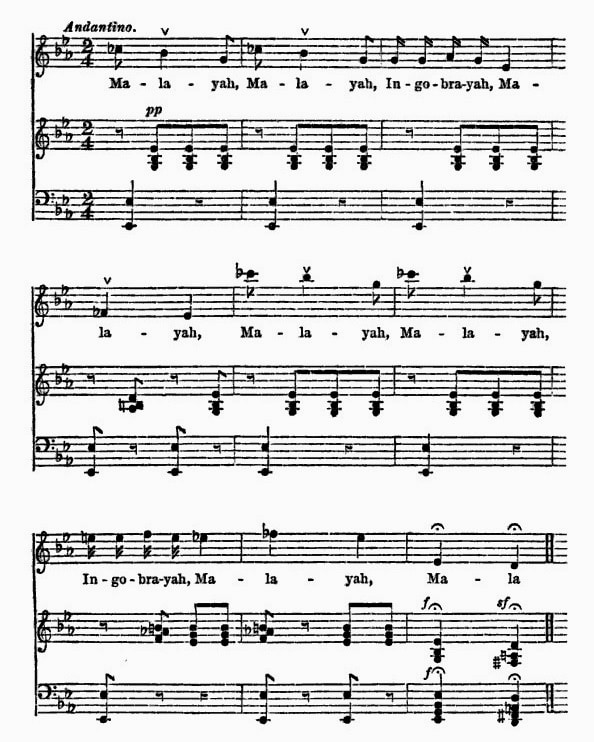
AN ABORIGINAL CHANT.
Malayah, malayah, ingobrayah, malayah
Malayah, malayah, ingobrayah, malayah, mala.
The key is frequently changed; and the measure is sometimes slow, sometimes very quick.
Sound:
Synthesised sound file, Australharmony 2016
Documentation:
Townsend 1849, 88-89, also 105 (on Jimmy Woodbury)
https://archive.org/stream/ramblesandobser01towngoog#page/n102/mode/2up (DIGITISED)
https://books.google.com.au/books?id=ifENAAAAYAAJ&pg=PA88 (DIGITISED)
[88] . . . That symmetrical, manly fellow, with broad shoulders and a deep chest, is "Jimmy Woodbury," and a great personage in his own tribe; for, though the aborigines recognise no chiefs, such a man as Jimmy acquires much influence among them. He is a good bruiser, and once thrashed three white men who combined to molest him . . .
[89] This man was often employed, as a stockman, in taking cattle and horses up the coast, and was a great favourite wherever he went . . . He was a great man at corrobbories, and was as well satisfied, when daubed from head to foot with white clay, having his hair powdered with the downy feathers of the white cockatoo, and a reed stuck through the cartilage of his nose, as when representing a Sunday buck; and I know that he has walked fifty miles, in one day, in order to join in a dance at night . . .
Townsend 1849, 98-101 (on "corrobbories"):
https://archive.org/stream/ramblesandobser01towngoog#page/n112/mode/2up (DIGITISED)
https://books.google.com.au/books?id=ifENAAAAYAAJ&pg=PA98 (DIGITISED)
[98] . . . During the fine summer nights, the blacks held frequent corrobbories, dancing, by the light of the moon, to the chant of the gins, which was accompanied by the clapping together of sticks.
"He treads the dance, through all its raptarous rounds.
To the wild music of barbarian sounds."
In these dances they often imitate the motions of animals, the kangaroo for instance. A shout, in the stronger voices of the men, formed an occasional period in the chant. By the bye, it has happened that certain settlers, inspired by rum and water, have adopted the kangaroo dance; springing round the table, after dinner, hand in hand, as if practising a new variation of the game of leap-frogging; but such indications of a convivial spirit are considered to belong only to those who have gone irremediably to the dogs.
Sir Thomas Mitchell giaphically describes the corrobbory: - "This amusement always takes place at night . . ." - Three Expeditions, &c., vol. ii. p. 5.
[99] . . . In "Savage life and Scenes in Australia and New Zealand," by Mr. Angas, we have also an accoimt of the corrobbory: - "The dance of the frogs consisted of a number of men painted and armed with wirries . . ."
[100] . . . When our blacks visited Sydney, and saw the military paraded, and heard the bands, they said that was "white fellows' corrobbory" . . .
. . . In the bush they used often to sing, in chorus, the famous song, "Jim Crow," saying, "Jim Crow tister went to de ball," and so forth. Their own songs are monotonous, and consist of the frequent repetition of a few words, such as, "Water, water, where is water? There is water, welling out of the ground;" but this, of course, is sung in their own dialect. They have their bards or rhymers, who compose their songs; and, when a new song is produced, it passes quickly from tribe to tribe . . .
[101] . . . I should imagine that the number of aborigines on the coast-line between Jervis Bay and the River Moruya, a distance of one hundre miles, is about four hundred. They sometimes assembled to hold corrobories, and to play at foot-ball. They are now peaceable and well conducted - in fact, polite and gracious in their manners . . .
[Review of the above with extracts], The athenaeum [London, England] 1122 (28 April 1849), 433-34
https://books.google.com.au/books?id=RZRHAQAAIAAJ&pg=PA433 (DIGITISED)
Bibliography:
Robert Etheridge, Contributions to a catalogue of works, reports, and papers on the anthropology, ethnology, and geological history of the Australian and Tasmanian Aborigines . . . part 2 (Memoirs of the geological survey of New South Wales, palaeontology 8) (Sydney: Government Printer, 1891), 45
https://archive.org/stream/contributionsto00ethegoog#page/n91/mode/2up (DIGITISED)
Graeme Skinner, Toward a general history of Australian musical composition: first national music, 1788-c.1860 (Ph.D thesis, Sydney Conservatorium of Music, University of Sydney, 2011), 202, 468
http://hdl.handle.net/2123/7264 (DIGITISED)
Graeme Skinner and Jim Wafer, "A checklist of colonial era musical transcriptions of Australian Indigenous songs", in Jim Wafer and Myfany Turpin (eds), Recirculating songs: revitalising the singing practices of Indigenous Australia (Canberra: Asia-Pacific Linguistics, 2017), 376-77
http://hdl.handle.net/1885/132161
https://openresearch-repository.anu.edu.au/bitstream/1885/132161/26/17_skinner_wafer.pdf (FREE DOWNLOAD)
Commentary:
Townsend arrived in the colony in 1842, and between then and his return to England in 1846, he travelled country New South Wales, from Ulladulla to the Illawarra. He reported that one of his most admired native guides, "Jimmy Woodbury" was "a great man at corrobbories . . . and I know that he has walked fifty miles, in one day, in order to join in a dance at night" (Townsend 1849, 89, also 97). Townsend also noted: "When our blacks visited Sydney, and saw the military paraded, and heard the bands, they said that was 'white fellow' corrobbory" (100). And, evidently following Threlkeld, he also observed that "new songs" passed quickly from tribe to tribe:
Their own songs are monotonous, and consist of the frequent repetition of a few words, such as, 'Water, water, where is water? There is water, welling out of the ground'; but this, of course, is sung in their own dialect. They have their bards or rhymers, who compose their songs; and, when a new song is produced, it passes quickly from tribe to tribe (100)
But as to the Aboriginal Chant, unfortunately, Townsend gave only vague hints as to where, when and how he collected it ("About Ulladulla . . ."?), or indeed whether he himself transcribed and/or arranged it.
References:
Papers of Joseph Phipps Townsend (State Library of New South Wales)
https://trove.nla.gov.au/work/35931388
https://collection.sl.nsw.gov.au/record/1xqZ8DEY
"Timothy, Chief of Merricumbene", Aboriginal Breastplates, NSW, National Museum of Australia
https://www.nma.gov.au/explore/features/aboriginal-breastplates/list/new-south-wales/timothy
Letter from R. Fitzgerald, Nelligen, 1910, to Edward Milne; National Museum of Australia, Edward Milne Collection, 85/310, fols. 160 and 166:
After a lot of hunting I have found the peice [sic] of Blackfellows Plat [sic] which I am sending to you under seperate [sic] cover. When you receive it you will see it is not the piece of Plate I thought it should be as this one has been presented to a Blackfellow by name Timothy but cannot say by who, the other plate was presented to a Blackfellow by the name of Jimmy by Capt Oldrey R.N. and it had the words "Bale Me Jarrad", on it, I dont think I cut it up But I cannot find it, you will think it silly of me to cut this one up as I have but at the time I was Building a Wager Boat and wanted some peices [sic] of Brass to finish it with so that is my excuse for doing so.
The motto on Jimmy's plate in New South Wales Pidgin means bale "not", me "I", jarrad "fear", or "I fear not." "The Jimmy mentioned by Fitzgerald was probably Jimmy Woodbury, an Aboriginal man who belonged to Timothy's 'tribe'".
By 1848
13 2 songs
Wiradjuri, Wellington Valley, NSW
Music and words, unidentified singers and transcribers, ? between c. 1835-45; arranged by Isaac Nathan (1792-1864); published Sydney, 1848-49
https://sydney.edu.au/paradisec/australharmony/checklist-indigenous-music-1.php#013 (shareable link to this entry)
13.1 Ah! Wy-a-boo-ka
13.1 "Ah! Wy-a-boo-ka, the turtle song"
text: Ah wyabooka . . . [repeat]
gloss: "a species of turtle" (Nathan 1848-49, 114)
analytics: Wellington Valley, NSW (region); ECA (music region); South-eastern PN/ Central NSW/ Wiradjuri (language)
Source:
Isaac Nathan, The southern Euphrosyne, and Australian miscellany: containing oriental moral tales, original anecdote, poetry and music (Sydney: I. Nathan, [1848-49]), 114 (commentary)
https://books.google.com.au/books?id=ziwieom4lBQC&pg=PA114 (DIGITISED)
http://nla.gov.au/nla.obj-166023361/view#page/n123/mode/1up (DIGITISED)
TURTLE SONG.
AH! WY-A-BOO-KA.
"Wy-a-boo-ka," in the aboriginal language of the Wellington Valley tribe, signifies a species of turtle - and never did the late Sir William Curtis, of turtle-devouring memory, yearn more for this Aldermanic dainty, than does a Wellington Valley native for the oily wy-â-boo-kâ-. The following scene is related by a gentleman who was a spectator: -
"Having occasion to perform a journey on horseback through the district of Wellington Valley, my progress was arrested on reaching the bank of a river I had to cross, by finding its waters swollen, and a rapid current flowing. The water being discoloured, and ignorant of its depth, I hesitated to venture in with a tired horse. Anxious to pursue my way, I began to consider what was to be done, as the shades of evening began to descend, and looking around, could see but a vast forest of tall gum and eucalyptus trees. On a sudden, I heard the hum of voices, which I knew to be those of natives. I approached the spot from whence the sound proceeded, and came upon a tribe of aboriginals, who were ranged along the bank of the river. I perceived one of them to point at the stream, and sing out lustily "Ah! ah! Wy-a-boo-ka-!" then jump and dance about grotesquely. A second one then took up the same strain, and so on each in succession. On looking into the river to try and discern the cause of their excitement, I saw a description of turtle carried past by the stream now and then. On its appearance, the strain ah! ah! wy-a-boo-ka-! was immediately raised, and from the gestures of the natives, it was evident that one was trying to induce the other to plunge in and make a prize of this tit bit. The river flowing rapidly, their mutual power of persuasiviness seemed unavailing, and thus were they doomed, in the sadness of their hearts and epicurian cravings of their stomachs, to view those precious objects "like fairy gifts fleeting away." On questioning one of the tribe, who spoke a little English, he pointed to a turtle that just swept by, and exclaimed with a heavy sigh and watering mouth, "I say, you fellow, by G-d dat budgeree, budgeree pattar (beautiful, beautiful food). Bail black fellow, jump in; get it." Having ascertained from him that the river was impassible, by his direction I made my way to a cattle station in the vicinity for the purpose of obtaining shelter for the night, but ever and anon, as I proceeded on my way, the sound "ah! ah! wy-a-boo-ka!" was wafted to my ears on the evening air. The notes of the last three bars of the strain, are pathetically expressive of the loss of the turtle.
Strange as the tale may appear yet it is not the less true that we have frequently seen the aborigines dive after the fresh water turtle, or tortoise, and by out swimming fairly catch him in his own element. The native never ventures upon this feat unless the sky is perfectly clear, and the water as transparent as glass. At the distance of a quarter of a mile perhaps he sees the wy-a-boo-ka basking on a snag ore half of which rises from the water and leans upon the acclivity of the bank, the diver warily creeps behind trees until he reaches the shelter of some broad flooded gum close to his unsuspecting game, he then ceases to hide, for he knows that the sense of sight and hearing are as acute in the turtle that the crushing of a branch would startle it, but makes one bold plunge, and pursuer and pursued dash into the water together, we have often witnessed the chase which rarely lasts a minute, and nine times out often the human being is the victor.
Isaac Nathan, The southern Euphrosyne, and Australian miscellany (Sydney: I. Nathan, [1848-49]), 115-18 (music and words)
https://books.google.com.au/books?id=ziwieom4lBQC&pg=PA115 (DIGITISED)
http://nla.gov.au/nla.obj-166023361/view#page/n124/mode/1up (DIGITISED)
Ah! Wy-a-boo-ka, the turtle song, an Aboriginal melody sung by the Wellington Valley Tribe of Australia, put into modern rhythm, harmonized and arranged, with a piano forte accompaniment, by I. Nathan.
The complete musical and linguistic content of the source song appears in the first 8 bars of the vocal line, as shown below
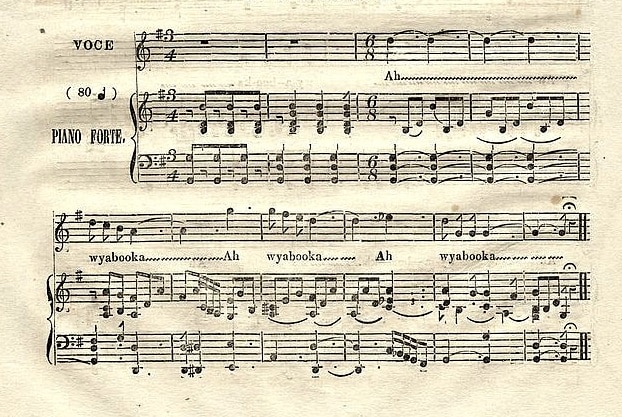
Sound:
Synthesised sound file, Australharmony 2016
13.2 Dital dital baloonai
13.2 "Dital dital baloonai" ("The battle song")
text: Dital dital baloonai . . . [repeat]
gloss: "Brothers, brothers, on we go, / to meet the foe" (etc. Nathan 1848-49, 113). The following five lines of Nathan's free rendition probably constitute a fanciful elaboration of the first two lines as given here)
analytics: As for 13.1
Source:
Isaac Nathan, The southern Euphrosyne, and Australian miscellany (Sydney: I. Nathan, [1848-49]) (as above), 113 (commentary)
https://books.google.com.au/books?id=ziwieom4lBQC&pg=PA113 (DIGITISED)
http://nla.gov.au/nla.obj-166023361/view#page/n122/mode/1up (DIGITISED)
DITAL DITAL BA-LOO-NAI.
THE BATTLE SONG
Dital Dital Ba-loo-nai is a bold energetic martial air, sung with great emotions of excitement, by the Wellington Valley Tribe, on their march to battle. The ideas it expresses may be freely rendered thus, and with nearly parallel accentuation.
Brothers, brothers, on we go,
To meet the foe,-
Altho' we know,
Dark strife will grow,
On our path,
Yet shall wrath
Nerve our arms to meet the foe.
Isaac Nathan, The southern Euphrosyne, and Australian miscellany (Sydney: I. Nathan, [1848-49]), 119-26 (music and words)
https://books.google.com.au/books?id=ziwieom4lBQC&pg=PA119 (DIGITISED)
http://nla.gov.au/nla.obj-166023361/view#page/n128/mode/1up (DIGITISED)
The complete musical and linguistic content of the source song appears in the 10 bars of the vocal line, as shown below
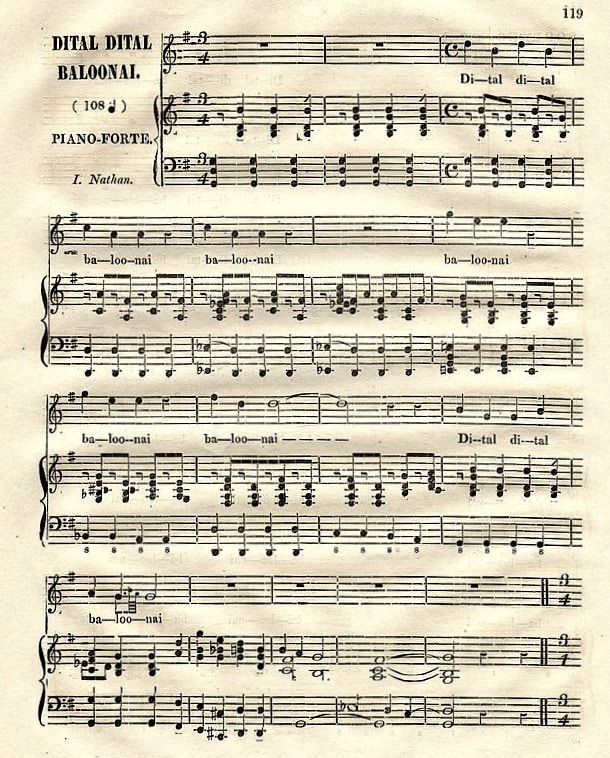
Sound:
Synthesised sound file, Australharmony 2016
Note:
Nathan also reported the existence of a third song arrangement he had made, the context suggests also sourced in the Wellington Valley, but due to lack of musical type, he was unable to publish either the music, or any words beyond the title; see below:
Isaac Nathan, The southern Euphrosyne, and Australian miscellany (Sydney: I. Nathan, [1848-49]), 114 (description)
https://books.google.com.au/books?id=ziwieom4lBQC&pg=PA119 (DIGITISED)
http://nla.gov.au/nla.obj-166023361/view#page/n123/mode/1up (DIGITISED)
Ah ! Warin-ee Ah! Warin-e is a sweetly flowing melancholy strain, supposed to be a song of lamentation, sung over the body or grave of a departed relative. It is the custom of the aborigines, occasionally to pay this tribute of respect to the memory of their relatives and distinguished Chiefs, periodically for several days after their interment.
The melody admits of exquisite pathos-great variety of harmony, and free scope for fanciful accompaniments,-which our limited fount of music type, will not at present allow us to lay before the public.
Bibliography:
"AH WY-A-BOO-KA, THE TURTLE SONG", Australian Town and Country Journal (28 January 1888), 33 (music and words from Nathan 1848-49)
http://nla.gov.au/nla.news-article71093723 (DIGITISED)
Robert Etheridge, Contributions to a catalogue of works, reports, and papers on the anthropology, ethnology, and geological history of the Australian and Tasmanian Aborigines . . . part 2 (Memoirs of the geological survey of New South Wales, palaeontology 8) (Sydney: Government Printer, 1891), 36
https://archive.org/stream/contributionsto00ethegoog#page/n83/mode/2up (DIGITISED)
"SONGS BY AUSTRALIAN BLACKS", Australasian anthropological journal 1/3 (27 February 1897), 8
https://nla.gov.au/nla.obj-568402794/view?partId=nla.obj-568407595#page/n9/mode/1up (DIGITSED)
Three songs obtained through the kindness of Mr. W. M. Doherty, F.C.S.,
as sung by blacks in the Domain 40 years ago, and taken down by Mr. Nathan, a musician of that time.
No. I. - Each line sung in different notes.
De-tol, de-tol, Bah-loo-nay, Bah-loo-nay,
Bah-loo-nay, Bah-loo-nay, Bah-loo-nay;
De-tol, de-tol, Bah-loo-nay . . .
"THE WELLINGTON DISTRICT . . . A ROMANTIC EPISODE", Freeman's Journal (12 August 1899), 13-14
http://nla.gov.au/nla.news-article111077522 (DIGITISED)
. . . In connection with the old Wellington convict days a romantic anecdote is told. Among the convicts sent to the penal settlement in the spring of 1823 was an Englishman named Saville, who came from a class many grades above his companions. What his crime was no one in Wellington knew. The poor wretch over and over proclaimed his innocence, but he was convicted and transported for life. It transpired that by the judicious use of money his real name, which was Mr. John Luscombe, junr., had been kept from the papers, and the prisoner was travelling under the alias of "John Saville." Luscombe, it appeared, was a nephew of the late Sir John Luscombe, Bart. Lincolnshire, England . . . Luscombe, or Saville, arrived in Sydney in 1822, and was then forwarded to Wellington. One day when the Bell River was in flood a number of aboriginals stationed at various distances apart along the west bank, opposite the prison settlement, now and again saw turtles borne down by the current, and then would the cry arise, "Ah, ah! Wyabooka;" whilst fingers would be pointed at the passing turtle, and one would try and induce another to plunge in and secure the much-coveted prize. But it was a remarkable fact that, with all their longings for the turtle and their notable swimming powers, no black would plunge into the water when it was muddy, or when there was a cloudy sky. A young girl at last, more daring than the others, plunged into the seething water as a turtle of large size massed by . . .
James Duff Brown, Characteristic songs and dances of all nations (London: Bayley and Ferguson, 1901), 257
https://archive.org/stream/characteristicso00brow2#page/257/mode/2up (DIGITISED)
http://digital.nls.uk/special-collections-of-printed-music/pageturner.cfm?id=91251901 (DIGITISED)
Eumalga; or, The white chief, an historical story by Robert Porter ([? Wellington: ?, c. 1910]), 8, 29
https://nla.gov.au/nla.obj-52789640/view?partId=nla.obj-92640030#page/n8/mode/1up (DIGITISED)
https://nla.gov.au/nla.obj-52789640/view?partId=nla.obj-92649026#page/n29/mode/1up (DIGITISED)
"EUMALGA", Leader [Orange, NSW] (2 July 1912), 4
http://nla.gov.au/nla.news-article117798877 (DIGITISED)
W. Arundel Orchard, Music in Australia: more than 150 years of development (Melbourne: Georgian House, 1952), 214 (Ah Wyabooka only, words and melody)
https://archive.org/details/in.ernet.dli.2015.28983/page/n254/mode/1up (DIGITISED)
Graeme Skinner, Toward a general history of Australian musical composition: first national music, 1788-c. 1860 (Ph.D thesis, Sydney Conservatorium of Music, University of Sydney, 2011)
http://hdl.handle.net/2123/7264 (DIGITISED)
Graeme Skinner, "Recovering musical data from colonial era transcriptions of Indigenous songs: some practical considerations", in Jim Wafer and Myfany Turpin (eds), Recirculating songs: revitalising the singing practices of Indigenous Australia (Canberra: Asia-Pacific Linguistics, 2017), 355-56
http://hdl.handle.net/1885/132161
https://openresearch-repository.anu.edu.au/bitstream/1885/132161/25/16_skinner.pdf (FREE DOWNLOAD)
Graeme Skinner and Jim Wafer, "A checklist of colonial era musical transcriptions of Australian Indigenous songs", in Jim Wafer and Myfany Turpin (eds), Recirculating songs: revitalising the singing practices of Indigenous Australia (Canberra: Asia-Pacific Linguistics, 2017), 377-78
http://hdl.handle.net/1885/132161
https://openresearch-repository.anu.edu.au/bitstream/1885/132161/26/17_skinner_wafer.pdf (FREE DOWNLOAD)
c.1846-48
14 1 song
? Nyungar, south-west WA
Music only transcribed from unidentified singers, and "reduced to the piano forte", by Rosendo Salvado (1814-1900), south-east WA, c.1846-48; first published Barcelona, Spain, 1853
https://sydney.edu.au/paradisec/australharmony/checklist-indigenous-music-1.php#014 (shareable link to this entry)
Dance song
14 "Maquielo: cancion de baile de los Australianos Occidentales" (Dance song of the Western Australians)
text: [music only, no words]
analytics: south-west WA (region); CA (music region); Western PN/ Nyungar/ ? Nyungar (language)
Source:
Maquielo: cancion de baile de los Australianos occidentales reducida á piano forte por el Ilu'mo D. R. S.
National Library of Australia, photocopy of original MS, New Norcia, WA
https://trove.nla.gov.au/work/14887408
https://nla.gov.au/nla.obj-2840073628 (DIGITISED)
Published version (image below)
Rosendo Salvado, Memorias históricas sobre la Australia: y particularmente acerca la mision Benedictina de Nueva Nursia y los usos y costumbres de los salvajes, obra escrita en italiana por el Ilmo. P. Fr. Rosendo Salvado, de la órden de San Benito, y obispo de Puerto Victoria; traducida al español por D. F. de D. (Barcelona: Impr. de los Herederos de la V. Pla, 1853), page after 314 (music only)
https://books.google.com.au/books?id=z_YaZIk1YLQC&pg=PA314-IA2 (DIGITISED)
Maquielo: Cancion de baile de los Australianos Occidentales, reducida a forte-piano par el Illu[strissi]mo] D[on] R[osendo] S[alvado]
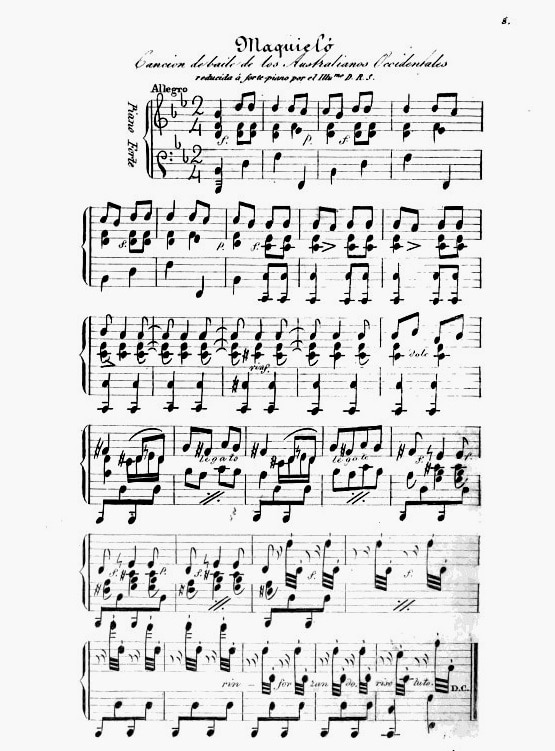
Sound:
Synthesised sound file, Australharmony 2016
medialocal/salvado-maquielo.wav
Documentation:
Rosendo Salvado, Memorie storiche dell'Australia, particolarmente della missione Benedettina di Nuova Norcia e degli usi costumi degli Australiani per Rudesindo Salvado (Roma: S. Congreg. de Propaganda Fide, 1851), 305-06
https://books.google.com.au/books?id=t-XgjXh9cpkC&pg=PA305 (DIGITISED)
8. la loro lingua poetica . . .
[306] 9. Il genere della musica australiana . . .
Salvado 1853, 314-16
https://books.google.com.au/books?id=z_YaZIk1YLQC&pg=PA315 (DIGITISED)
8. Su poesía, como la de todo pueblo salvaje, es un conjunto de algunas ideas expresadas en pocas palabras. Sus canciones, por lo tanto, consisten en algunas voces unidas, cuya armonía hacen resaltar con mayor énfasis cada vez que las repiten; en lo que llegan á ocuparse hasta una ó dos horas siempre con el mismo gusto, ó mas, si cabe, que al principio: y lo que á un europeo le fastidiaría á mas no poder, á los australianos les dá unos trasportes de alegría y entusiasmo indescribibles. Algunas de sus poesías son improvisadas con motivo de algun suceso fausto ó fúnebre; otras son trasmitidas con una especie de veneracion tradicional, y otras les han venido de paises lejanos, sucediendo no pocas veces que las primitivas palabras de la cancion, ó por el decurso del tiempo, ó por lo remoto del lugar de donde proceden, son del todo desconocí-[215]-das y sustituidas por otras; de suerte que solo queda de la cancion el motivo musical. Cuando un salvaje va á visitar algun amigo que habite en un pais lejano, vuelve de la visita llevando, entre otras novedades, alguna de las canciones que ha aprendido en el pais de sus huéspedes. Si la cancion es de su gusto, la canta con toda la expresion, y aun la enseña á los demás; pero si es fea ó no le gusta, estropea perfectamente sus palabras y su canto, haciéndolo con un chiste y con un donaire de gesticulaciones y de voz, capaces de excitar la risa del hombre mas grave y serio del mundo. Este es uno de los momentos mas felices de la vida de un salvaje; y yo debo confesar que las muchas veces que lo presencié sentado en su compañía junto al fuego, me divertí tanto como ellos.
[TRANSLATION] . . . Some of their verses are improvised in response to a happy or sad event; other verses are transmitted with a type of traditional veneration, and others have come from distant regions, in such a way that not infrequently the original words of the song, either through the passage of time, or because of the remoteness of the place from which they come, are completely unknown and substituted for another, with the result that all that remains of the song is the musical motive. When an Aboriginal is going to visit some friend who lives in a distant country, he will return from the visit carrying, among other new acquisitions, some of the songs that he has learned in the country of his guests. If the song is to his liking, he will sing it with great expressivity, even teaching it to the others, but if the song is ugly and he doesn't like it, he will perfectly distort its lyrics and its melody, making of it a joke with such exaggerated gesticulations as would excite laughter . . .
[315] 9. La música australiana tiene su parte bella y graciosa como la fenicia, y su parte grave y seria como la dórica. Un himno de guerra, que para nosotros de fijo no merecería tal nombre, á ellos les excita hasta ponerlos frenéticos; y como si les trasportase fuera de sí, los precipita furiosos á la pelea: y al contrario los cantos tristes les conmueven de tal manera, que sus fisonomías, en especial las de las mujeres, toman un gesto verdaderamente lagrimoso. Si el tema de la música les convida á la caza ó al baile, entonces se vén moverse contentos y festivos, y llenos de vivacidad. ¿Cuántas veces me he valido yo de sus canciones de baile para animarles y alentarles en los trabajos del campo? No una sino mil veces, estando echados en el suelo, abatidos, ó fastidiados del trabajo, al oirme cantar Maquieló, Maquielé, que es una de sus mas comunes y favoritas canciones de baile, obligados, como de una fuerza irresistible, no solo se levantaban y seguian mi canto, sino que se echaban á bailar gozosos y placenteros, mayormente viéndome cantar y bailar á mí cual si fuese otro de ellos. Esto me proporcionaba la ventaja de que, despues de algunos minutos de descanso, diciendo yo en tono alegre mingo, mingo, que, aunque propiamente significa el pecho, equivale tambien á nuestro ¡ánimo! insensiblemente volvían á tomar el trabajo, haciéndolo tan gustosos y con tanto ardor, que no parecía sino [316] que el Maquieló les habia infundido nuevos brios y nuevo vigor.
"NEWS OF THE DAY", The Daily News (5 March 1886), 3
http://nla.gov.au/nla.news-article76479103
At the concert held at Fremantle last Wednesday eveuing, under the auspices of the "Star of the Sea" branch of the H.A.C.B. Society, Bishop Salvado created no small amount of amusement among the large audience present by saying that he would give them some "genuine Western Australian music." His Lordship fulfilled his promise by playing an Australian corroborrie, and singing an aboriginal song in the native lauguage to his accompaniment. This unique performance was loudly applauded.
Bibliography:
Théophile Bérengier, La Nouvelle-Nursie: histoire d'une colonie bénédictine dans l'Australie occidentale (1846-1878) (Paris: Lecoffre fils et cie., 1879), 194
https://archive.org/stream/lanouvellenursi00brgoog#page/n226/mode/2up (DIGITISED)
Joseph Lauterer, Australien und Tasmanien: nach eigener Anschauung und Forschung (Freiburg im Breisgau: Herdersche Verlagshandlung, 1900), 293-94
https://archive.org/stream/australienundta00lautgoog#page/n316/mode/2up (DIGITISED)
E. J. Stormon (ed.), The Salvado memoirs: historical memoirs of Australia . . . (Nedlands: University of Western Australia Press, 1977), 132-35, plate facing 125
Xoan-Manuel Carreira, "The piano music of Rosendo Salvado", Studies in Music [WA] 23 (1989)
Eladio Ros, La música en Nueva Nursia ([Madrid]: Ministerio de Asuntos Exteriores, [1992])
https://trove.nla.gov.au/work/14865548
Xavier Groba González, O legado musical de casto sampedro folgar (1848-1937): o canto galego de tradición oral (doctoral thesis, University of Santiago de Compostella, 2011), 76-79
http://dspace.usc.es/handle/10347/3621 (DIGITISED)
Graeme Skinner, Toward a general history of Australian musical composition: first national music, 1788-c.1860 (Ph.D thesis, Sydney Conservatorium of Music, University of Sydney, 2011), 347, 475
http://hdl.handle.net/2123/7264 (DIGITISED)
Carreira 2014
Xoan-Manuel Carreira, La música para piano de Dom Rosendo Salvado, Mundoclassico.com, posted 2015
https://www.mundoclasico.com/ed3/documentos/19025/musica-para-piano-Rosendo-Salvado (DIGITISED)
Skinner and Wafer 2017
Other resources:
Navea: Arreglo para grupo de percusión sobre a obra Maquielo de Fray Rosendo Salvado (posted 6 April 2014)
https://www.facebook.com/Navea.es/videos/717239464966131 (STREAMED VIDEO)
A video of another very European interpretation of the song, but modern, with the melody sung and partly audible toward the end
Commentary:
Salvado's transcription is evidently based on a song he heard during his first Australian sojourn, between his arrival at Fremantle in January 1846 and his return to Europe in January 1849. Salvado's short commentary on Aboriginal song and dance appears in all three original editions of his book, in Italian (1852), Spanish (1853), and French (1854), however the musical transcription appears only in the Spanish (1853) edition.
In discussing languages, song and music, Salvado clearly drew on the work of Grey (Grey 1841) and Eyre, and referred to studies by Lancelot Threlkeld and observations by Thomas Mitchell (Salvado 1853, 313). Some of his own commentary on song poetry (314) is probably derived largely from Threlkeld or Eyre.
c.1840s-80s
15 1 song
Wiradjuri, Upper Murray, NSW
? c.1840, transcribed ? 1886; unknown provenance
https://sydney.edu.au/paradisec/australharmony/checklist-indigenous-music-1.php#015 (shareable link to this entry)
Wein brabra wie wie
15 "Aboriginal chant . . . Woradgery Tribe, upper Murray, 1840"
text: Ah-a-a-a Wein bra-bra wie wie Bun-gam-bin-yah th'longa-la jung-ar mekel boom'ry-ah-a-a wein bra-bra, wein bra-bra ber-gan yel-ar yel-ar yan- lay gunning yea, gunning yea ber-gan yel-ar boon-mar yel-ar boon-mar boon-mar boon-mar-a-a boon-mar-a-a
analytics: Upper Murray, NSW (region); ECA (music region); South-eastern PN/ Central NSW/ Wiradjuri (language)
Sources:
"SONG", Albury Banner and Wodonga Express (27 May 1904), 34 (words only, ? gloss)
http://nla.gov.au/nla.news-article100603667 (DIGITISED)
SONG.
In Peaceful Happy Days.
Wein brar-Bra wee wee
Bunganbinyah therlonga-la
Jung-ar mekel bumery ah
Wein brar-bra, wein brar-bra
Wein brar-bra, wein brar-bra
Wein brar-bra-arar-aa.
Bergan ye-lar, ye-lar yan lay gunning yea
Bergan ye-lar, boon mar
A murrumun-belar gunning yea
Bergan ye-lar boon-mar
Boon-mar, boon-mar-ar-ar
Bergan ye-lar boon mar-ar-ar.
Photocopy at AIATSIS; original manuscript, one sheet, 2 pages, provenance and current whereabouts unknown (music and words)
https://trove.nla.gov.au/work/33792258
Below, the "Aboriginal chant" only
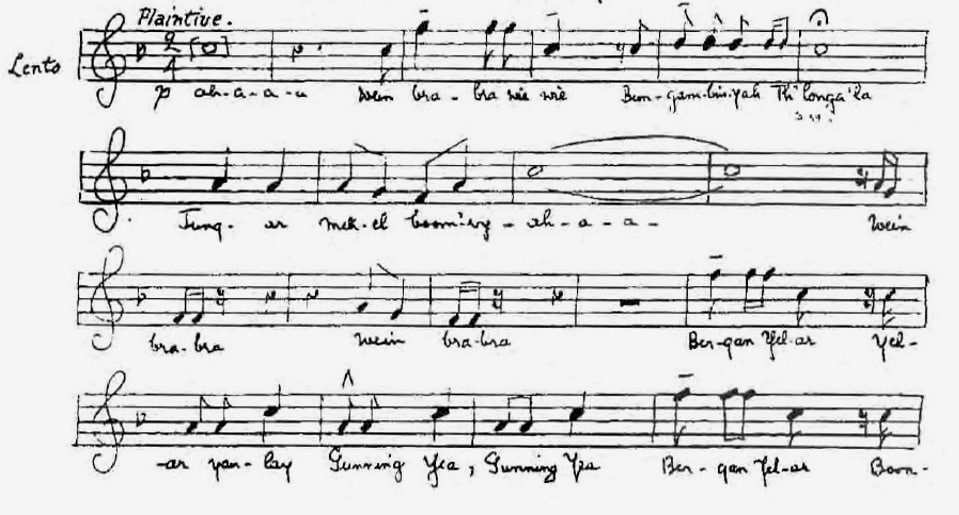

Ah-a-a-a Wein bra-bra wie wie Bun-gam-bin-yah th'longa-la
Jung-ar mekel boom'ry-ah-a-a Wein
ar yan- lay gunning yea, gunning yea Ber-gan Yel-ar, Boon-
mar Yel-ar boon-mar
Boon-mar, boon-mar-a-a Boon-
mar-a-a.
Below, Australian song with Aboriginal chant (complete)
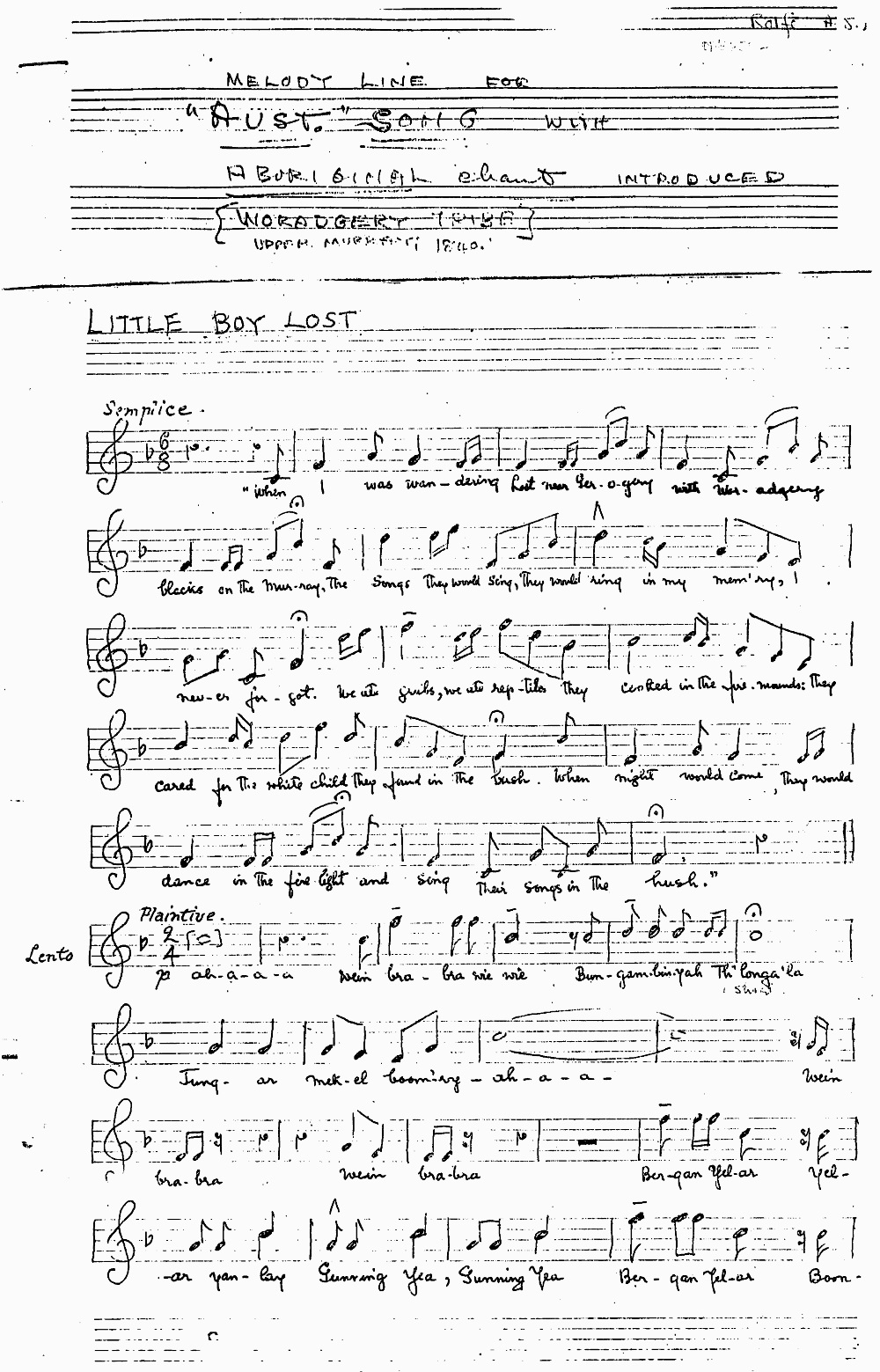
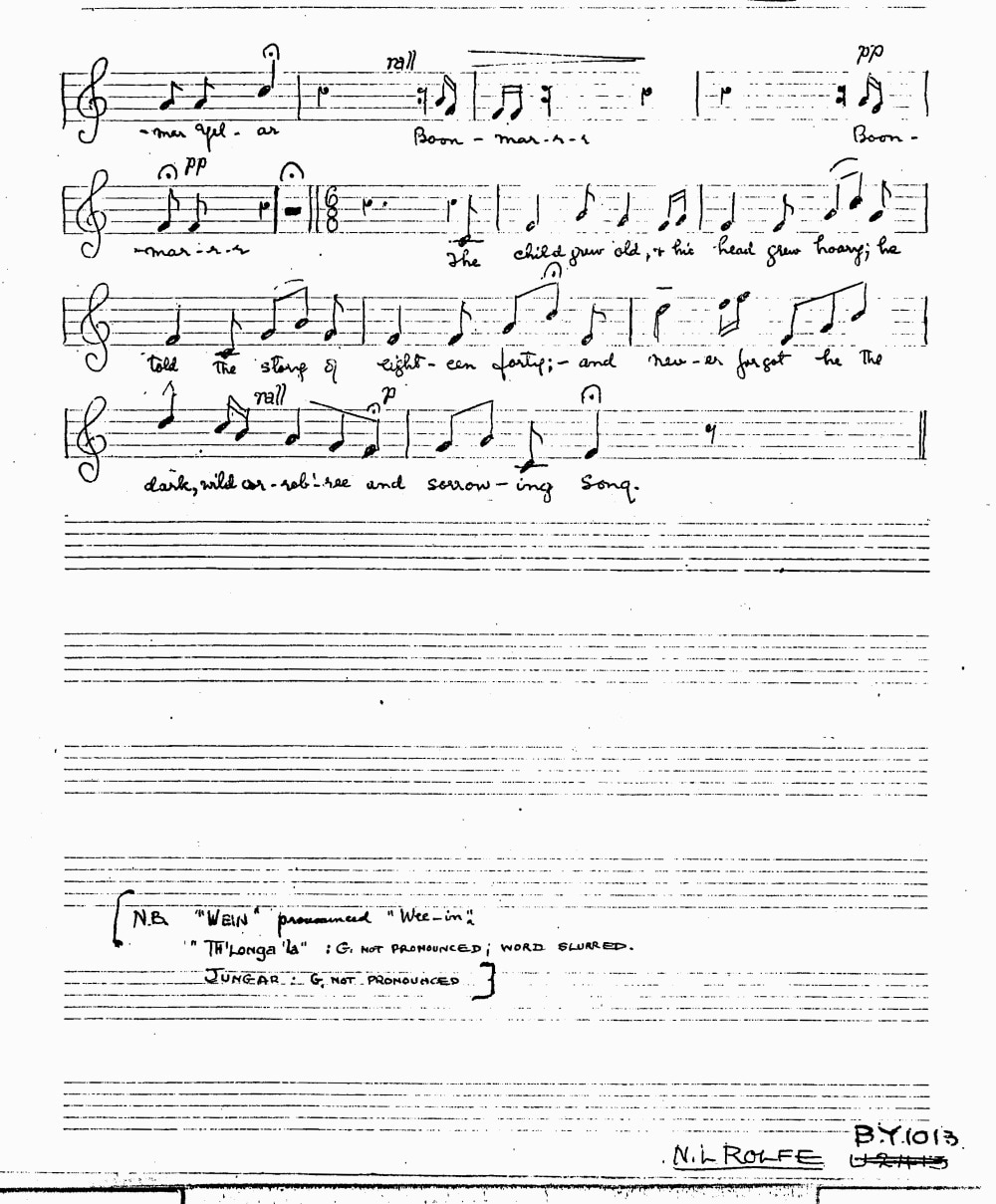
Select bibliography:
Nicole Saintilan, "Music - if so it may be called": perception and response in the documentation of Aboriginal music in nineteenth century Australia (M.Mus thesis, University of New South Wales, 1993), 46-50
http://hdl.handle.net/1959.4/50383 (DIGITISED)
Graeme Skinner and Jim Wafer, "A checklist of colonial era musical transcriptions of Australian Indigenous songs", in Jim Wafer and Myfany Turpin (eds), Recirculating songs: revitalising the singing practices of Indigenous Australia (Canberra: Asia-Pacific Linguistics, 2017), 379
http://hdl.handle.net/1885/132161
https://openresearch-repository.anu.edu.au/bitstream/1885/132161/26/17_skinner_wafer.pdf (FREE DOWNLOAD)
Commentary:
The manuscript appears to have been copied at the latest in the early 20th-century. It bears the name "N. L. Rolfe", perhaps the compiler and composer of the framing song "Australian song", entitled Little boy lost. Apparently about a lost settler child found by the Wiradjuri around 1840s, the framing song, and the "Aboriginal chant", might perhaps connect the song personally with John Francis Huon Mitchell (1831-1923).
References:
"A VOCABULARY OF ABORIGINAL TERMS", Albury Banner and Wodonga Express (27 May 1904), 34
http://nla.gov.au/nla.news-article100603675 (DIGITISED)
W. M. Sherrie, "THE WORADGERY TRIBE", The Argus (23 June 1906), 5
http://nla.gov.au/nla.news-article10038425 (DIGITISED)
"PERSONAL", The Argus (3 March 1923), 30
http://nla.gov.au/nla.news-article1880156 (DIGITISED)
"A PIONEER OF RIVERINA", Daily Advertiser (9 March 1923), 2
http://nla.gov.au/nla.news-article143183376 (DIGITISED)
G. P. Walsh, "Mitchell, James (1835-1914)", Australian dictionary of biography 5 (1974)
http://adb.anu.edu.au/biography/mitchell-james-4211/text6783 (DIGITISED)
c.1840-1850
16 2 songs
? Yagara, Brisbane district, southern QLD
Music and words transcribed by Williamina Anderson Ogg (c.1878-1948), c.1900, from the singing of Tom Petrie (1831-1910), songs he had learned as a child, c.1840-1850, with commentary by Petrie; first published Brisbane 1904
https://sydney.edu.au/paradisec/australharmony/checklist-indigenous-music-1.php#016 (shareable link to this entry)
Source and documentation:
Constance Campbell Petrie, Tom Petrie's reminiscences of early Queensland (dating from 1837) recorded by his daughter (Brisbane: Watson, Ferguson & Co., 1904), 25-28
https://archive.org/stream/cu31924063745495#page/n49/mode/2up (DIGITISED)
16.1 Jabalkan
16.1 "Bobbiwinta's mysterious disappearance"
text: Tabal-kan wad-li/ tabal-kan wad-li/ tabal-kan wad-li/ 'ngo kun-dul nga-ri wai-yar/ ngat-la in-en-in-go/ tal-lo car-bu / ngat-la ye-ri du-wa
gloss: "The words had this meaning: 'My oar is bad, my oar is bad; send me my boat, I'm sitting here waiting,' and so on, sung slowly. Then quickly, 'dulpai-i-la ngari kimmo-man' (jump over for me friends), and so to the finish. The following [musical transcription with words] is the first portion of the song" (Petrie 1904, 25)
analytics: Brisbane district, Southern QLD (region); ? YCA ? ECA (music region); South-eastern PN/ Durubulic/ ? Yagara (language)
Petrie 1904, 25
https://archive.org/stream/cu31924063745495#page/n49/mode/2up (DIGITISED)
[25] . . . The story of Bobbiwinta's mysterious disappearance was told from tribe to tribe; the natives seemed as though they could never get over the sadness of it. One night the man already mentioned belonging to the Pine was supposed to have had a dream, in which a corrobboree came to him descriptive of the event. The song ran as though the man from under the water, appealed for help - pitifully, pleadingly, all in vain. This corrobboree was sung and danced everywhere, and years afterwards the mere mention of it was enough to cause tears and wailings. The words had this meaning: "My oar is bad, my oar is bad; send me my boat, I'm sitting here waiting," and so on, sung slowly. Then quickly, "dulpai-i-la ngari kimmo-man" (jump over for me friends), and so to the finish. The following is the first portion of the song. [Music arranged by W. A. OGG]
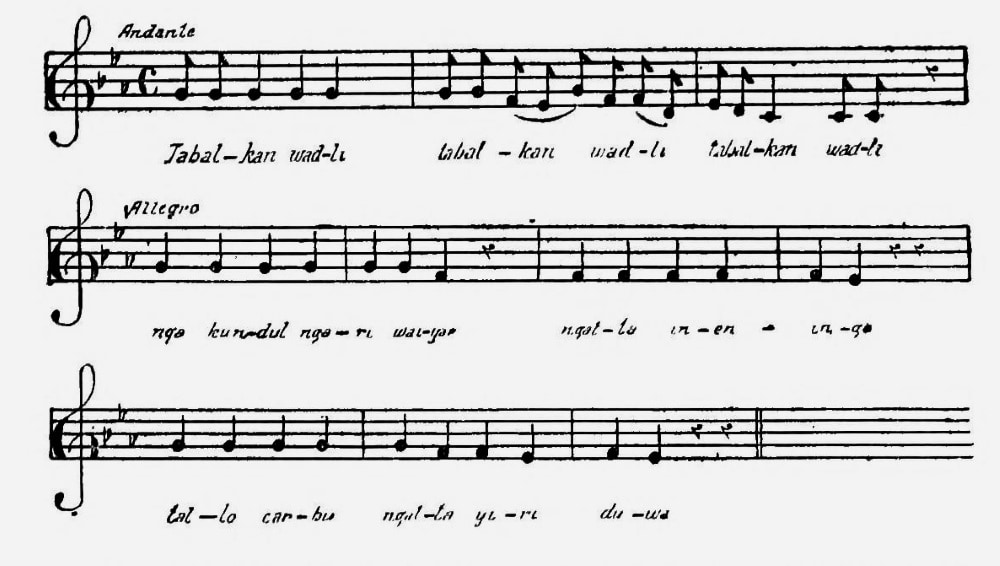
Jabalkan wadli Jabalkan wadli Jabalkan wadli
nga kundul ngari waiyar ngalla inenonga
tallo carbi ngalla yiri duwa
16.2 Mina loranda
16.2 "Mina"
text: Mi-na lo-ran-da/ mi-na mar-man-do-yar-ni/ mar-man-do-yar-ni/ ko-ko-je-kó-ni/ dam-an-da-dum/ Wa! Wa!
gloss: Petrie's account (1904, 28) indicates that this is a lullaby, but no gloss of words or phrases is given.
analytics: As for 16.1
Petrie 1904, 25-28
https://archive.org/stream/cu31924063745495#page/n49/mode/2up (DIGITISED)
[25] Another good corrobboree was based on an incident which happened when my father was a boy. This time it had refer-[26]-ence to a young gin - Kulkarawa - who belonged to the Brisbane or Turrbal tribe. A prisoner, a coloured man (an Indian), Shake Brown by name, stole a boat, and making off down the bay, took with him this Kulkarawa, without her people's immediate knowledge or consent. The boat was blown out to sea, and eventually the pair were washed ashore at Noosa Head - or as the blacks called it then, "Wantima," which meant "rising up," or "climbing up." They got ashore all right with just a few bruises, though the boat was broken to pieces. After rambling about for a couple of days, they came across a camp of blacks, and these latter took Kulkarawa from Shake Brown, saying that he must give her up, as she was a relative of theirs; but he might stop with them and they would feed him. So he stayed with them a long time, and the bon-yi season coming round, he accompanied them to the Blackall Range, joining in the feast there.
Before the bon-yi gathering had broken up. Shake Brown, grown tired of living the life of the blacks, left them to make his way to Brisbane. He got on to the old Northern Road going to Durundur, and followed it towards Brisbane. Coming at length to a creek which runs into the North Pine River, there, at the crossing, were a number of Turrbal blacks, who, recognising him, knew that he was the man who had stolen Kulkarawa. They asked what he had done with her, and he replied that the tribe of blacks he had fallen in with had taken her from him, and that she was now at the bon-yi gathering with them. But this, of course, did not satisfy the feeling for revenge that Shake Brown had roused when he took off the young gin from her people, and they turned on him and killed him, throwing his body into the bed of the creek at the crossing. A day or two later, men with a bullock dray going up to Durundur with rations, passing that way, came across Brown's body lying there, and they sent word to Brisbane, also christening the creek Brown's Creek, by which name it is known to this day.
Kulkarawa, living with the Noosa blacks, fretted for her people, and she made a song which ran as follows: "Oh, flour, where oh where are you now that I used to eat? Oh [27] oh, take me back to my mother, there to be happy, and roam no more." She evidently missed the flour which her own tribe got from the white people. The Noosa blacks made a dance to suit the song, and the corrobboree was considered a grand one.
Kulkarawa, after living with the Noosa blacks for about two years, was at length brought back to her own people. Father happened to be out at the Bowen Hills or "Barrambin" camp, with two or three black boys, looking for some cows, at the time she arrived. The strange blacks bringing her, both went and sat down at the mother's hut without speaking, and the parents of the young gin, and all her friends, started crying for joy when they saw her, keeping the cry going for some ten minutes in a chanting sort of fashion, even as they do when mourning for the dead. Then a regular talking match ensued, and Kulkarawa was told all that had happened during her absence, including the finding and murder of Shake Brown (or " Marri-dai-o " the blacks called him), on his way to Brisbane. Then she told her news, and Father heard afterwards again from her own lips of her experiences.
The Noosa blacks introduced the corrobboree at the "Barrambin" camp, and so it was sung and danced all round about, spreading both near and far.
In the song of a corrobboree there were not generally many words, but these were repeated over and over again with different shades of expression. Once my father had the honour of being the subject of a corrobboree; they sang of him as he was seen sailing with a native crew through the breakers over Maroochy Bar. The incident and its danger I will mention later. The song described the way he threw the surf from his face, etc. Who knows but what it hves somewhere yet, for it was possible for a corrobboree to travel to the other end of the continent.
A Manila man (who afterwards died at Miora, Dunwich, and whose daughter lives there now) once taught a song he knew to the Turrbal blacks. They did not understand its meaning in the least, but learnt the words and the tune, and it became a great favourite with all. My father also picked it up when a boy, and it has since soothed to sleep [28] in turn all his children and two grandchildren. Indeed Baby Annour (the youngest of the tribe) at one time refused to hear anything else when his mother sang to him. "Sing Mi-na" (Mee-na), he would say, if she dared try to vary the monotony. Here is the song:
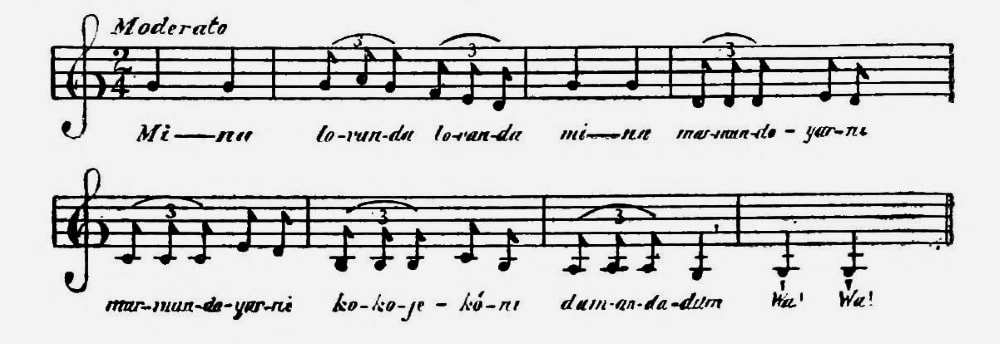
Mina loranda loranda marmandoyarni
marmundoyarni kokojekoni dumandadum Wa! Wa!
Margaret Ann Ogg manuscript; John Oxley Library, State Library of Queensland
https://trove.nla.gov.au/version/223807860
includes the melodies of two aboriginal songs taken down by Miss Ogg's sister, Williamina Anderson Ogg (c.1878-1948), from Tom Petrie's singing of them, pp 58-62
Bibliography:
Henry Tate, "Aboriginal music: its artistic possibilities", The Argus (30 June 1923), 7
http://nla.gov.au/nla.news-article2002080 (DIGITISED)
Henry Tate, Australian musical possibilities (Melbourne: Edward A. Vidler, 1924), 33-34
http://nla.gov.au/nla.obj-52821442/view#page/n34/mode/1up (DIGITISED)
From Tate 1923 above
Nicole Saintilan, "Music - if so it may be called": perception and response in the documentation of Aboriginal music in nineteenth century Australia (M.Mus thesis, University of New South Wales, 1993), 43-46
http://hdl.handle.net/1959.4/50383 (DIGITISED)
Skinner and Wafer 2017
References:
Betty Crouchley, "Ogg, Margaret Ann (1863-1953)", Australian dictionary of biography 11 (1988)
http://adb.anu.edu.au/biography/ogg-margaret-ann-7887
c.1850
17 1 song
? Nyungar, south-west WA
Music only, collected by Philip Chauncy (1816-1880) from unidentified singers, Swan River, WA, probably between 1841 and 1853; published 1878
https://sydney.edu.au/paradisec/australharmony/checklist-indigenous-music-1.php#017 (shareable link to this entry)
A line of one of their chants
17 "A line of one of their chants"
text: [music only, no words]
analytics: south-west WA (region); CA (music region); Western PN/ Nyungar/ ? Nyungar (language)
Philip Chauncy, "Notes and anecdotes of the Aborigines of Australia", in R. Brough Smyth (ed.), The Aborigines of Victoria: with notes relating to the habits of the natives of other parts of Australia and Tasmania (Melbourne: John Ferres, Government Printer, 1878), volume 2, 266
https://archive.org/stream/aboriginesofvict02smyt#page/266/mode/2up (DIGITISED)
[266] Monotonous and harsh as their chants are, the natives are by no means unsusceptible of the power of music. The young people readily learn to sing, and some of them to play on [Western] instruments. Often, when approaching a native encampment on one of those lovely mornings which, at Swan River, shed an indescribably balmy influence on all around, I have heard the plaintive morning song - the men as they sat sharpening their spears, the women as they lazily put together the smouldering embers, while the others slept around. The following is a line of one of their chants.

Bibliography:
Karl Hagen, Über die Musik einiger Naturvölker (Australier, Melanesier, Polynesier) (Dissertation, University of Jena) (Hamburg: Ferdinand Schlotke, 1892), 9-13 (commentary)
https://trove.nla.gov.au/work/30068490
https://books.google.com.au/books?id=L-saAAAAYAAJ&pg=PA9 - commentary (DIGITISED)
Joseph Lauterer, Australien und Tasmanien: nach eigener Anschauung und Forschung (Freiburg im Breisgau: Herdersche Verlagshandlung, 1900), 297
https://archive.org/stream/australienundta00lautgoog#page/n320/mode/2up (DIGITISED)
Nicole Saintilan, "Music - if so it may be called": perception and response in the documentation of Aboriginal music in nineteenth century Australia (M.Mus thesis, University of New South Wales, 1993), 85-86, 89
http://hdl.handle.net/1959.4/50383 (DIGITISED)
Skinner and Wafer 2017
Commentary:
Philip Chauncy served as a government assistant surveyor in the colony of Western Australia from 1841 to 1853. In the notes he published in 1878, he reproduced 10 portrait sketches of King George's Sound people that he had made in 1846.
References:
Philip Chauncy, diaries and survey books, 1840-1875; DLMSQ 11, State Library of New South Wales
http://archival.sl.nsw.gov.au/Details/archive/110347579
"Chauncy, Philip Lamothe Snell (1816-1880)", Encyclopedia of Australian Science
http://www.eoas.info/biogs/P001135b.htm
"Chauncy, Philip Lamothe Snell (1816-1880)", NLA persistent identifier
http://nla.gov.au/nla.party-1476952
1857-c.1861
18 7 songs
? Barunggam, Darling Downs, QLD
Music only, 18.1, collected by Hermann Beckler (1828-1914), Darling Downs, 25 March 1858; 18.2, Darling Downs, 9 April 1858; published 1868
Paakantyi, Menindee ("Meninder"), QLD
Music and words, 18.3, collected by Beckler "some years later" (? 1861); published 1868
? Barunggam, Gayndah, QLD
Music only, 18.4, "Corroberri 3", collected by "a German friend [of Beckler's], who was superintendent of a sheep station . . . vicinity of Gayndah"; published 1868
? Geynyan, Warwick, QLD
Manuscript items, music and words of 2 further songs, 18.5 and 18.6, and music only of 18.7, collected near Warwick, 28 November 1857, 25 March and 9 April 1858; sent by Beckler in letter(s) to his brother in Germany; first published (facsimile of MS) 1991
https://sydney.edu.au/paradisec/australharmony/checklist-indigenous-music-1.php#018 (shareable link to this entry)
Source and documentation:
Hermann Beckler, letter to his brother, MS music examples reproduced in Voigt 1991, and Parsons 2003
Hermann Beckler, "Corroberri: Ein Beitrag zur Kenntnis der Musik bei den australischen Ureinwohnern", Globus: illustrierte Zeitschrift für Länder-und Völkerkunde 13 (1868), 82-84 [18.1-4]
http://digi.evifa.de/viewer/!image/DE-11-001723742/94/-/ (DIGITISED)
https://books.google.com.au/books?id=D6BBAAAAcAAJ&pg=PA82 (DIGITISED)
http://reader.digitale-sammlungen.de/de/fs1/object/goToPage/bsb10359027.html?pageNo=94 (DIGITISED)
18.1 Darling Downs corroboree 1
18.1 "Corroberri I. Darling Downs"
text: [music only, no words]
analytics: Darling Downs, QLD (region); YCA (music region); South-eastern PN/ Waka-Kabi/ ? Barunggam (language)
sources: (MS version = Parsons 2003, 77, top of page)

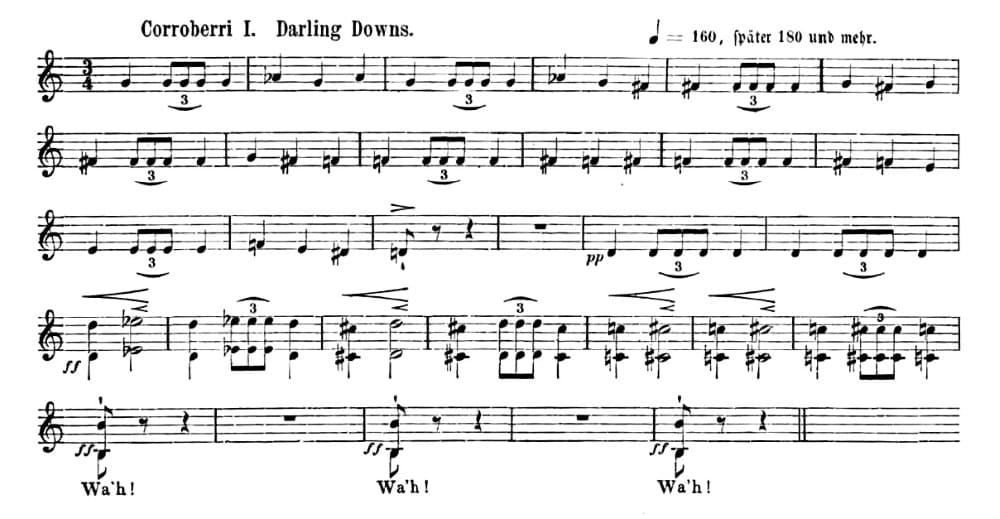
18.2 Darling Downs death song
18.2 "Klage oder Todtenlied [lament or death song"], Darling Downs"
text: [music only, no words]
analytics: As for 18.1
sources: (MS version = Parsons 2003, 77, bottom of page)


18.3 Darling Downs corroboree 2
18.3 "Corroberri II. Upper Darling River. Meninder" [Menindee]
text: Bai indi bai indi balema balegna onbai indi bai indi gan on bale
gloss: "Hier möge nur noch der den Anfang machende Gesang, eine Hymne, wenn man will, Musik und Text treu wiedergegeben, Platz finden. Ich ließ mir nachher sagen , es sei ein Gebet, eine Bitte an ihren Gott, um ein großes Uebel, vielleicht eine Krankheit, von ihnen abzuwenden" (Beckler 1868, 84): "Here there is only space for the opening song, a hymn, if you like, with music and text faithfully represented. I heard from later enquiries that it was a prayer, a request to their god, to avert a great evil, perhaps an illness."
analytics: Menindee ("Meninder"), Darling River, NSW (region); CA (music region); South-eastern PN/ Darling Group/ Paakantyi (language)
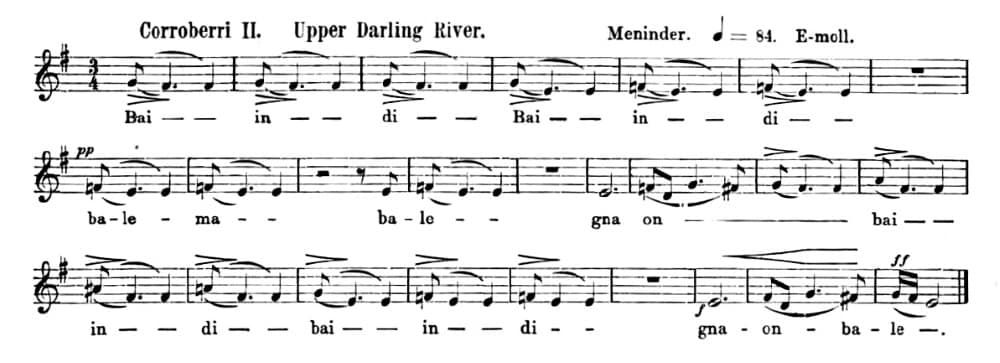
18.4 Gayndah corroboree
18.4 "Corrobberri III. Gayndah"
text: [music only, no words]
analytics: Gayndah, QLD (region); YCA (music region); South-eastern PN/ Waka-Kabi/ ? Waga-Waga (language)
source: MS = Voigt 1991, Parsons 2003, 79 [example 3 of 4]


18.5 Song
18.5 [Beckler MS]
text: [? indecipherable]
analytics: Warwick, QLD (region); ECA (music region); South-eastern PN/ Bandjalangic/ Geynyan (language)
source: Voigt 1991, Parsons 2003, 79 [example 1 of 4]

18.6 Song
18.6 "I" [Beckler MS]
text: [? indecipherable]
analytics: As for 18.5
source: Voigt 1991, Parsons 2003, 79 [example 2 of 4]

18.7 Song
18.7 "IV" [Beckler MS]
text: (music only, no words)
analytics: As for 18.5
source: Voigt 1991, Parsons 2003, 79 [example 4 of 4]

Source:
Beckler 1868
http://reader.digitale-sammlungen.de/de/fs1/object/goToPage/bsb10359027.html?pageNo=94 (DIGITISED)
http://digi.evifa.de/viewer/!image/DE-11-001723742/94/-/ (DIGITISED)
http://digi.evifa.de/viewer/resolver?urn=urn:nbn:de:kobv:11-D-1269719 (DIGITISED)
https://books.google.com.au/books?id=D6BBAAAAcAAJ&pg=PA82 (DIGITISED)
Clark and Cahir 2013, 111-14 (English translation)
https://books.google.com.au/books?id=pBL0_JLLOhMC&pg=PA111 (PREVIEW)
Bibliography:
Karl Hagen, Über die Musik einiger Naturvölker (Australier, Melanesier, Polynesier) (Dissertation, University of Jena) (Hamburg: Ferdinand Schlotke, 1892), 9-13 (commentary), plate I examples 1-4 (music)
https://trove.nla.gov.au/work/30068490
https://books.google.com.au/books?id=L-saAAAAYAAJ&pg=PA9 - commentary (DIGITISED)
https://books.google.com.au/books?id=L-saAAAAYAAJ&pg=PT2 - music (DIGITISED)
Wallascheck 1893 (reproduces 18.2)
https://archive.org/stream/primitivemusicin00wall#page/n343/mode/2up
Wallascheck 1903 (reproduces 18.2)
J. H. Voigt, "Die Musik der Aborigines im südlichen Queensland: eine frühe Quelle", in Martin Kintzinger, Wolfgang Sturner, and Johannes Zahlten (eds.), Das andere Wahrnehmen; Beiträge zur europäischen Geschichte; August Nitschke zum 65. Geburtstag gewidmet (Cologne: Bohlau Verlag, 1991), 547-552
Reproduces Beckler's manuscript transcriptions
Stephen Jeffries and Michael Kertesz (eds), A journey to Cooper's Creek: Hermann Beckler (Carlton: Melbourne University Press, Miegunyah Press, State Library of Victoria, 1993)
Nicole Saintilan, "Music - if so it may be called": perception and response in the documentation of Aboriginal music in nineteenth century Australia (M.Mus thesis, University of New South Wales, 1993), 74-76, 86-87
http://hdl.handle.net/1959.4/50383 (DIGITISED)
David Parsons, Waringh waringh: a history of Aboriginal people in the Warwick area and their land (Maryvale: David Parsons, 2003)
http://eprints.usq.edu.au/4687 (DIGITISED)
On pages 77 and 79 reproduces Beckler's manuscript transcriptions from Voigt 1991
Ian D. Clark and Fred Cahir (eds), The Aboriginal story of Burke and Wills: forgotten narratives (Collingwood: CSIRO Publishing, 2013), 85 (commentary), 111-13 (appendix 5.2: English translation of Beckler 1868 by D. M. Dodd), 114 (facsimile of music, Beckler 1868, 83)
https://books.google.com.au/books?id=pBL0_JLLOhMC&pg=PA111 (PREVIEW)
Skinner and Wafer 2017
Commentary:
The artist and photographer William Knibb Morris (1833-1912) made notes describing a "Corroboree of the Blacks at Gayndah" on 14 October 1860.
References:
Loyau 1897
William Knibb Morris, letters to his brother Thomas John Morris, July 1860 to July 1862, M13/3
William Knibb Morris, DAAO
https://www.daao.org.au/bio/william-knibb-morris
1860
19 1 song
Paakantyi, far west NSW
Music and words sung and translated by Walwallim, transcribed by Ludwig Becker (1808-1861), Menindee NSW, November 1860; MS; translation first published 1860; music and words first published 1979
https://sydney.edu.au/paradisec/australharmony/checklist-indigenous-music-1.php#019 (shareable link to this entry)
Anaruka walli
19 Anaruka-song (Creek-song) (Song of Walwallim)
text: Anaruka wal-li walli madin haa na-ruk car rol-gun na ge all san-u-ri wai ki-wai ki yen dai lom hnai geng na da mi
gloss: "Anaruka! you must be quick, come down, I can not wait for you long; No man can wait for you long I am going to sleep (to die)" (Becker 1860). Becker precedes this gloss with a note: "Anaruka is the word for creek but often given as a name to girls. There is a truly poetical conception in the double meaning of this word. Wallwallim (name of a Blackfellow) sings:- "
analytics: Menindee, Darling River, far west NSW (region); ? CA (music region); South-eastern PN/ Darling Group/ Paakantyi (language)
Source and documentation:
Ludwig Becker, despatch to the Royal Society of Victoria, from Menindee NSW, 27 November 1860; State Library of Victoria, MS13071, Box 2082/4; Tipping 1979, 190
Online transcripts, without music
http://www.burkeandwills.net.au/Despatches/Becker/Beckers_Letter_09.htm
http://www.burkeandwills.net.au/Despatches/Becker/Beckers_Letter_11.htm
Modern edition, music, Australharmony 2015 (after Tipping 1979, 190)
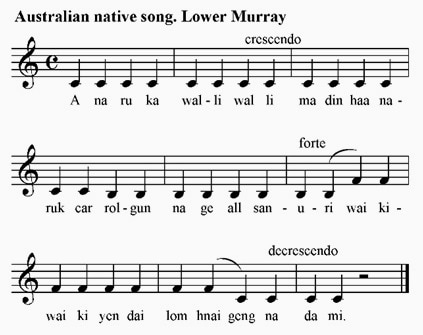
Anaruka walli walli
madin haa naruk car rolgun
na ge all sanuri wai kiwai ki yen dai
lom hnai geng na da mi
"ROYAL SOCIETY OF VICTORIA", The Argus (11 December 1860), 5
http://nla.gov.au/nla.news-article5694801 (DIGITISED)
Meninda, Nov. 27. To Dr. Macadam, M.L.A., Hon. Secretary, Royal Society, Victoria.
Sir, - Together with a continuation of my "notes on the road," I have the honour to send you this time, I am sorry to say, only a few illustrations, viz., shells from the Darling, a parasite found on Gecko No. 2, and a sketch of the large meteor I observed on October 11. I also enclose appendix No. 1, containing some specimens of aboriginal poetry and music. I have nearly finished half a dozen sketches of life in an aboriginal camp, of festivities, and of fighting among the blacks. I made also a sketch of a beautiful moth, but it wants still the details as seen under the microscope. A drawing of the Darling depot is in hand. My meteorological observations of November will also accompany my next communication.
I have the honour to remain, yours truly, LUDWIG BECKER.
A SPECIMEN OR TWO OF A SONG AND TUNE OF ONE OF THE MURRAY TRIBES.
Remark. - I had not had much opportunity as yet to converse sufficiently with the natives so as to offer something new or of great interest to others unacquainted with the Lower Murray and the Upper Darling tribes. However, I was fortunate enough to hear from an intelligent native something which may prove interesting enough to lovers of primitive songs and tunes. It is a translation of a corroboree song, and which that young Murray black dictated to me in English. I wrote it down word for word. The same young man also favoured me with a love-song, repeating it several times, so as to enable me to note correctly words and melody. LUDWIG BECKER. Darling Depot, Nov. 27.
YAAM-SONG (CORROBOREE SONG). (Lower Murray.)
I am with the white people,
But all my tribe in the camp at home,
And I am living with the white people;
And I am amongst other blacks,
And cannot understand their speaking.
Wheregara was my country,
But I am covering myself with the blanket now,
And I am not covered with the opossum rug,
And I cannot make it:
Cannot get the opossum to make the rug,
I am with the white people now.
And I cannot go to my home yet.
I cannot get married to my colour.
Being now with the white people;
And if I want to marry my colour
I must go home.
And if I marry to my colour,
And if I go to another country
With the white people,
And leave behind my lubra,
Perhaps white people take her,
And give her to another black.
And this I do not like! Ugh!
ANARUKA-SONG (CREEK-SONG).
Note. - "Anaruka" is the word for "creek," but often given as a name to girls. There is a truly poetical conception in the double moaning of the word. Walwallim (name of a black fellow) sings -
Anaruka! you must be quick, come down,
I cannot wait for you long;
No man can wait for you long.
I am going to sleep (to die).
Bibliography:
Marjorie Tipping (ed.), Ludwig Becker: artist & naturalist with the Burke & Wills expedition (Melbourne: Melbourne University Press, The Library Council of Victoria, 1979), 190
Skinner and Wafer 2017
Other resources:
[Picture by Becker] Depot Junction: The Bamamoro Cr. with the Darling, 7 miles from Minindie [sic], up the Darling, Nov. 1. 60; State Library of Victoria
http://handle.slv.vic.gov.au/10381/140047
c.1861
20 1 song
Narrinyeri (Ngarrindjeri), south-east SA
Music and words collected by George Taplin (1831-1879), "written down as it sung by the aborigines about eighteen years ago" (that is, about 1861), probably near Lake Alexandrina (Raukkan); words first published 1878, music published 1879
https://sydney.edu.au/paradisec/australharmony/checklist-indigenous-music-1.php#020 (shareable link to this entry)
Puntin narrinyeri
20 "Narrinyeri corrobbery"
text: Puntin Narrinyerar Puntin Narrinyerar O, O, O/ Puntin Narrinyerar O, O, O, O, O/ Yun terpulani ar/ Tuppun an wangamar/ Tyiwewar ngoppun ar O, O, O, O/ Puntin Narrinyerar, &c. (Taplin 1879b, 39)
gloss: The Narrinyeri are coming, soon they will appear, carrying kangaroos, quickly they are walking (Taplin 1879b, 39)
analytics: Lake Alexandrina, south-east SA (region); ECA (music region); South-eastern PN/ Lower Murray/ Ngarrindjeri (language)
Sources and documentation:
George Taplin, The Narrinyeri: an account of the tribes of south Australian aborigines inhabiting the country around the Lakes Alexandrina, Albert and Coorong, and the lower part of the river Murray, their manners and customs, also, an account of the mission at Point Macleay (Adelaide: J. T. Shawyer, printer, 1874), 28
https://books.google.com.au/books?id=pzA-AAAAYAAJ&pg=PA28 (DIGITISED)
https://babel.hathitrust.org/cgi/pt?id=nyp.33433089899490;view=1up;seq=38 (DIGITISED)
I have often been asked for one of the corrobery songs, and a translation of it. It is exceedingly difficult to get. Their songs consist principally of words descriptive of incidents of travel or hunting or war. I never heard of one which was not of this character. A party will go to the country of another tribe; then one of them, who has the talent, will make up a song, descriptive of what they saw, and the adventures which happened to them. This will be learnt by the others; and they will sing it at the first corrobery in the tribe. At other times a hunting adventure will form the subject of such a song, and, having been learnt, will be sung. Once, when I was coming up in the boat from Goolwa, Captain Jack kept on singing. I asked him what he was singing. He replied about that turkey upon the front of the house at the Goolwa. On making more particular inquiry I found that the said turkey was the gilt figure-head of a ship, representing an eagle, which had been saved from a wreck and fastened up over a shop front in that township. This had attracted the attention of my native friends; and so Captain Jack had set himself to make a song about it, and succeeded in constructing a ditty, which, after a line or two descriptive, broke out in a chorus-"O the turkey at the Goolwa, O the turkey at the Goolwa!"
The following is a song in native:-
Puntin Narrinyerar Puntin Narrinyerar O, O, O
Puntin Narrinyerar O, O, O, O, O
Yun terpulani ar
Tuppun an wangamar
Tyiwewar ngoppun ar O, O, O, O
Puntin Narrinyerar, &c.
Translated this is-"The Narrinyeri are coming, soon they will appear, carrying kangaroos, quickly they are walking."
George Taplin, The Narrinyeri . . . second edition revised (Adelaide: E.S. Wigg, 1878)
https://trove.nla.gov.au/version/22724351
George Taplin (1879a), "The Narrinyeri", in J. D. Woods (introd.), The native tribes of South Australia: comprising the Narrinyeri by the Rev. George Taplin . . . (Adelaide: E. S. Wigg & Son, 1879b), 38-39 (words and translation, no music)
https://archive.org/stream/nativetribessou00taplgoog#page/n103/mode/2up (DIGITISED)
Woods's compilation, including the 1878 revised edition of Taplin's study, had appeared and was being reviewed in December 1878, the titlepage year 1879 notwithstanding. Taplin's Folklore appeared posthumously in October 1879.
George Taplin (1879b), The folklore, manners, customs, and languages of the South Australian Aborigines: gathered from inquiries made by authority of South Australian government (Adelaide: E. Spiller, 1879), 106 (music and words), 107 (commentary)
https://archive.org/stream/folkloremannersc00taplrich#page/106/mode/2up (DIGITISED)
THE ABORIGINAL "CORROBBERY"
A specimen of the music of a genuine aboriginal "corrobbery", or song, written down as it was sung by the aborigines about eighteen years ago: -
"NARRINYERI" CORROBBERY
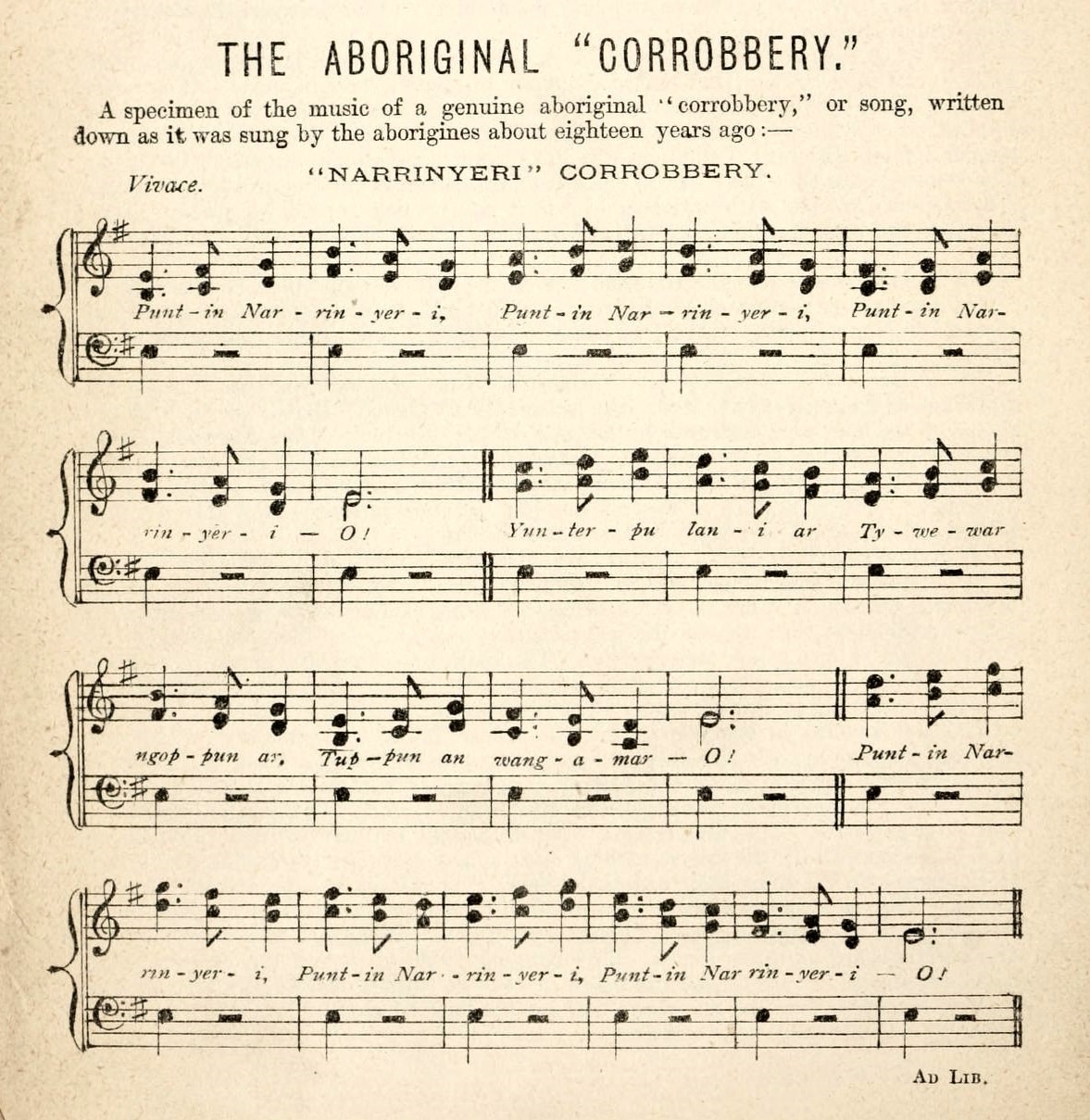
Puntin narrinyeri puntin narrinyeri puntin narrinyeri-o!
yunterpu lani ar tywewar ngoppun ar tuppun an wangamar-o!
puntin narrinyeri puntin narrinyeri puntin narrinyeri-o!
Synthesised sound file, with "a couple of clarionets, with a flute, and, for the bass, drum", Australharmony 2016
[107] A couple of clarionets, with a flute, and, for the bass, a drum, would give the best idea of this corrobbery. Our music makes it too melodious, and the harshness of the aboriginal song is lost. Perhaps the bagpipes might imitate it.
A great deal of conjecture has been made by various persons as to the true character of the corrobery. Some have fancied that they saw in it a religious significance. It may have in some tribes, but I do not believe that it has amongst the Narrinyeri. I think that amongst them it possesses rather a dramatic character, or, perhaps, more of the nature of the ballet. The main idea is of a spectacle. There are a number of figures all moving in uniform time, and to a regular cadence. The measure is intended either to express joy, or warlike passion, or some other feeling. The song which accompanies corresponds with the dance. The corrobbery song given above is intended to be merry, and the dance which belonged to it was very graceful. And over this song and dance there is always cast a sort of mistiness by the smoke of fires in the moonlight, so as to impart a weirdness to it. Very often, though, great war dances have been held in open daylight. I will now describe a corrobbery at which I was present.
The scene of it was a long low gully amongst the hills. It was a bright moonlight night. There were present about two hundred natives of all ages. In onf part of the gully there was a row of fires lighted and made to emit a great deal of smoke which rolled up the gully. On the same side of the fires as that which I occupied there were seated a number of old men and women of various ages with the drums called plangge, made by rolling up a skin tightly. They are beaten with the hand or fist, and keep the time of the dance. The beaters accompanied the planggar with the song. On the other side of the fires, which were in the middle of the gully, a little to the left of the drummers, there was a moving crowd of naked men - I should think seventy or eighty. They were all painted with white stuff in a grotesque manner - rings round the eyes, spots on the cheeks, white lines on the ribs, white lines down the legs and arms, so that in the gloom they looked liked dancing skeletons. Each man had a bunch of gum leaves tied to his legs, which made a rustling noise as he stepped. They all bore in their hands a pair of waddies, called "kanakar," which they beat to the same time as the drums with a sharp metallic clank. This is called the "tartengk." The sound of eighty pairs going furiously together made a tremendous clangour. On my side of the fires there stood with me a crowd of native spectators. To us the dancers appeared through the smoke a tossing crowd of moving heads and arms, the women's voices rose on our side in shrill tones, the men shouted in hoarse chorus. Just then there was a sudden turn in the song, and from out the moving mass of dancers there darted a dozen men right into the quivering firelight: instantly they spread themselves in a rank facing the drummers and spectators, and with legs spread wide apart, arms rapidly beating the tartengk, heads stretched forwards, they danced with a peculiar kind of jump or stamp in exact time, but with great energy. This continued about five minutes, and then the chorus changed, and back they sprang and vanished in the crowd. Then the song went on a while, and, as it turned, another party leaped out in the same manner, and danced as the others did. Fine ! fine ! said the spectators with many notes of acclamation. And thus the corrobbery proceeded until they all got tired, and had to stop and rest. The whole scene was of a wild and weird nature scarcely to be conveyed by words, but far more of a dramatic or spectacular character than any other.
Other documentation:
George Taplin, diary 1859-79, State Library of South Australia, PRG 186-1/3
Joe Lane (ed.), The journals of the reverend George Taplin, missionary to the Ngarrindjeri people of the Lower Murray, Lakes and the Coorong, 1859-1879 (1997)
http://www.firstsources.info/uploads/3/4/5/4/34544232/taplins_diary_1859-79.pdf (DIGITISED)
P. A. Clarke, "Myth as history? The Ngurunderi Dreaming of the Lower Murray, South Australia", Records of the South Australian Museum 28/1 (1995), 143-157, esp. 146
https://archive.org/stream/RecordsSouthAus28Sout#page/146/mode/2up (DIGITISED)
[Taplin's journal, 30 June 1859, makes reference to similar chants]: Two of their songs in particular attracted my attention. One was called "The Nurundere", and is about God, and the other is about "Shall I ever see my country again", a sort of native "Raus des vaches". The former began with a low chant as if they were chanting Latin. However, all through the piece they say the same words over and over again, then the chant rose higher and higher with beat of the Tartengk and native drum, then it sank again and the men's voices broke in shouting in time to the chant and brandishing the weapons with tartengk. Then the shrill treble of the women broke in like an imploring vociferation in answer to the shouts of the men. These ceased, and the whole concluded with a loud chant to the beat of the tartengk and drum. The latter piece was to slower time, and was very plaintive and wild. One of the men asked while I listened if I could write what they sang in a letter.
Bibliography:
"THE NARRINYERI", South Australian Register (28 May 1874), 5
http://nla.gov.au/nla.news-article39819493 (DIGITISED)
R. Brough Smyth, The Aborigines of Victoria: with notes relating to the habits of the natives of other parts of Australia and Tasmania . . . vol. 1 (Melbourne: John Ferres, Government Printer, 1878), 173
https://archive.org/stream/aboriginesofvict01smyt#page/173/mode/2up (DIGITISED)
Mr. Taplin says that it is exceedingly difficult to get a corrobboree song, which consists principally of words descriptive of incidents of travel, or hunting, or war. He gives, however, one native song in his pamphlet: [gives words and translation from Taplin 1874]
James Duff Brown, Characteristic songs and dances of all nations (London: Bayley and Ferguson, 1901), 258
http://digital.nls.uk/special-collections-of-printed-music/pageturner.cfm?id=91251913 (DIGITISED)
https://archive.org/stream/characteristicso00brow2#page/258/mode/2up (DIGITISED)
Henry Tate, "Aboriginal music: its artistic possibilities", The Argus (30 June 1923), 7
http://nla.gov.au/nla.news-article2002080 (DIGITISED)
Henry Tate, Australian musical possibilities (Melbourne: Edward A. Vidler, 1924), 32-33
http://nla.gov.au/nla.obj-52821442/view#page/n33/mode/1up (DIGITISED)
W. W. T., "Music, Aboriginal", in Arthur Wilberforce Jose and James Carter (eds), Australian encyclopaedia, volume 2 (Mab-Z) (Sydney: Angus & Robertson, 1926), 169 (music and words from Taplin 1879b)
W. Arundel Orchard, Music in Australia: more than 150 years of development (Melbourne: Georgian House, 1952), 213
https://archive.org/details/in.ernet.dli.2015.28983/page/n253/mode/1up (DIGITISED)
Skinner and Wafer 2017
c.1863-65
21 4 songs
Gureng-Gureng, Three Moon Creek, Upper Burnett River, QLD
Spelt phonetically in the "Goorang-Goorang" dialect, obtained by Reginald Byard Buchanan Clayton (1845-1927), Moon Creek, Upper Burnett River, Queensland, about the years 1863-5
Musical transcription/notation by Miss Isabel S. Clayton (1873-1925); published 1910
https://sydney.edu.au/paradisec/australharmony/checklist-indigenous-music-1.php#021 (shareable link to this entry)
Source:
R. R. Marett, "Queensland corroboree songs", Folklore 21/1 (March 1910), 86-88 (music and words)
http://www.jstor.org/stable/1253801
https://en.wikisource.org/wiki/Page:Folk-lore_-_A_Quarterly_Review._Volume_21,_1910.djvu/114 (DIGITISED)
QUEENSLAND CORROBOREE SONGS. [Communicated by Mr. R. R. Marett.]
THE following four Corroboree Songs, spelt phonetically in the Goorang-Goorang dialect, were obtained by Mr. R. B. B. Clayton,
Moon Creek, Upper Burnett River, Queensland, about the years I863-5. The musical notation is by Miss I. S. Clayton.
21.1 Yar yungein marar moonie
21.1 "No. I" (Queensland corroboree song 1)
text: Yar yung-ein mar-ar moon-ie yung-ein mar-ar ce-leen-bar ar ce-leen-bar ar ce-leen-bar ar. Joo vari yung-ein mar-ar ce-leen-bar ar ar. Joo-oo-vari yar yung-ein mar-ar moonie
analytics: Three Moon Creek, Upper Burnett River, QLD (region); YCA (music region); South-eastern PN/ Waka-Kabic/ Gureng-Gureng (language)
Marett 1910, 87
https://en.wikisource.org/wiki/Page:Folk-lore_-_A_Quarterly_Review._Volume_21,_1910.djvu/115 (DIGITISED)
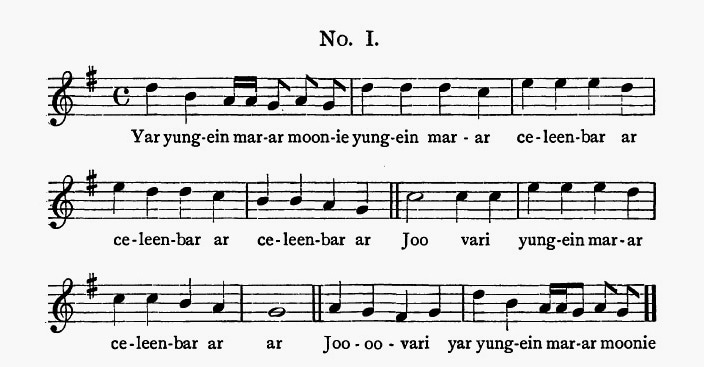
Yar yung-ein mar-ar moon-ie yung-ein mar-ar ce-leen-bar ar
ce-leen-bar ar ce-leen-bar ar. Joo vari yung-ein mar-ar
ce-leen-bar ar ar. Joo-oo-vari yar yung-ein mar-ar moonie.
21.2 A milearah vungah
21.2 "No. II" (Queensland corroboree song 2)
text: A milearah vun-gah tooey bithera beera too varina bithera berra anama-danava ar-ar merah anadadanava ava our our merah anamadanava our anama-danava our iddlety way
analytics: As for 21.1
Marett 1910, 87
https://en.wikisource.org/wiki/Page:Folk-lore_-_A_Quarterly_Review._Volume_21,_1910.djvu/115 (DIGITISED)
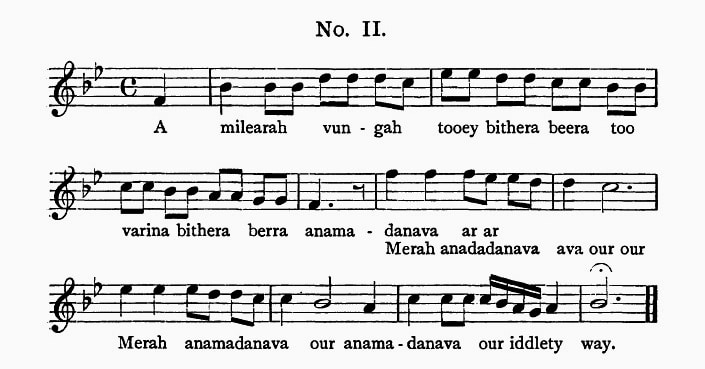
A milearah vun-gah tooey bithera beera too
varina bithera berra anama-danava ar-ar
Merah anadadanava ava our our
Merah anamadanava our anama-danava our iddlety way.
21.3 Animularine mong
21.3 "No. III" (Queensland corroboree song 3)
text: Animularine mong aliong animularine mong aliong amarabula la la clang amarabula la la clang animularine mong aliong amarabula la la clang animularine mong aliong
analytics: As for 21.1
Marett 1910, 87-88
https://en.wikisource.org/wiki/Page:Folk-lore_-_A_Quarterly_Review._Volume_21,_1910.djvu/115 (DIGITISED)
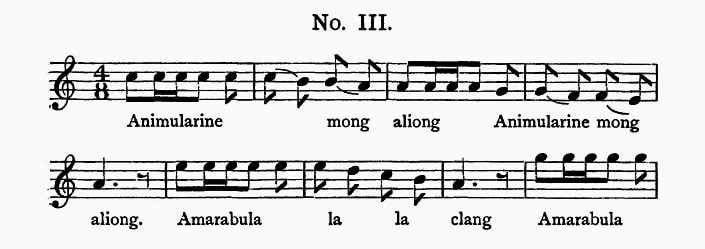

Animularine mong aliong Animularine mong
aliong. Amarabula la la clang. Amarabula
la la clang. Animularine mong aliong
Amarabula la la clang. Animularine mong aliong.
21.4 Cuniem cuniem ia
21.4 "No. IV" (Queensland corroboree song 4)
text: Cuniem cuniem ia cawar barney vous bundah boomerah lar bundah boomerah lar ar bundah boomerah lar
analytics: As for 21.1
Marett 1910, 88
https://en.wikisource.org/wiki/Page:Folk-lore_-_A_Quarterly_Review._Volume_21,_1910.djvu/116 (DIGITISED)
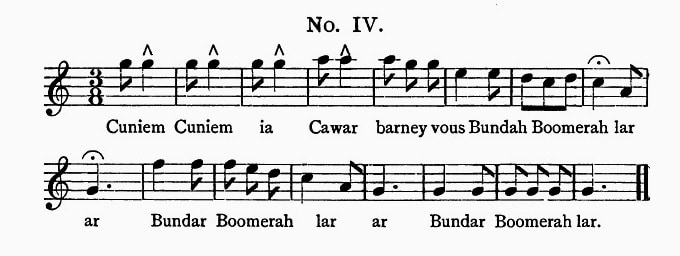
Cuniem cuniem ia Cawar barney vous Bundah Boomerah lar
Bundah Boomerah lar ar Bundah Boomerah lar.
Bibliography:
R. C. Riley and M. Curr, "No. 165 - Upper Burnett River, Mount Debateable, and Gayndah", Edward Micklethwaite Curr (ed.), The Australian race: its origin, languages, customs, place of landing in Australia and the routes by which it spread itself over the continent . . . volume 3 (Melbourne: John Ferres, Government Printer, 1887), 150-51
https://archive.org/stream/cu31924026093835#page/n163/mode/2up (DIGITISED)
Lisa Marcussen, Selected bibliography of the Gooreng Gooreng / Gureng Gureng / Gurang Gurang language and people held in the AIATSIS Library (Canberra: AIATSIS, April 2015)
http://aiatsis.gov.au/research/guides-and-resources/language-and-people-bibliographies
Skinner and Wafer 2017
References:
"OUR LONDON LETTER", The Brisbane Courier (1 July 1898), 5
http://nla.gov.au/nla.news-article3674411
"TO AUSTRALIA IN 61. PIONEERING IN THE BURNETT. MR. R. B. B. CLAYTON'S REMINISCENCES", The Queenslander (31 October 1925), 11
http://nla.gov.au/nla.news-article25107759
"THE LATE MR. R. B. B. CLAYTON", Maryborough Chronicle, Wide Bay and Burnett Advertiser (28 October 1927), 4
http://nla.gov.au/nla.news-article150971047
c. 1858-75
22 4 songs
Uutaalnganu, Cape York Peninsula, north QLD
Music and words transcribed by Edouard Garnier, France, 1876, from the singing of adoptive Uutaalnganu man, Narcisse Pelletier (1844-1894), or "Anco", who learned them there between 1858 and 1875; published 1876
https://sydney.edu.au/paradisec/australharmony/checklist-indigenous-music-1.php#022 (shareable link to this entry)
Source and documentation:
Constant Merland, Dix-sept ans chez les sauvages: Narcisse Pelletier avec portrait, fac-simile, musique et dessin d'armes (Paris: E. Dentu, 1876)
Appendice: Édouard Garnier, "Observations musicales sur les chants de Narcisse Pelletier", 127-35 (music transcriptions, unpaginated, follow p. 135, PDF pages 148-51)
https://trove.nla.gov.au/version/166472107
https://trove.nla.gov.au/version/211572266
http://aiatsis.gov.au/sites/default/files/catalogue_resources/a394874.pdf (DIGITISED)
For a full transcription of Garnier's "Observations musicales", see
https://sydney.edu.au/paradisec/australharmony/pelletier-narcisse.php#garnier-transcription
Garnier's specific information on the four songs:
[130] . . . Pelletier, peu communicatif, comme, du reste, tous ceux qui ont vécu longtemps dans la solitude ou avec des êtres à la conversation rare, nous a donné fort peu de détails sur ses refrains, et nous regrettons de ne pouvoir entrer dans des explications plus intéressantes à leur sujet.
Les Nos. 1 et 3 sont des airs de danse.
Le Hiento (No 2) se chante la nuit.
La ponghé lapon (No 4) est une invocation à la lune.
Les naturels marquent le rhythme alternativement dans les mains et sur les genoux. Ces airs et d'autres se répètent ainsi un nombre indéterminé et considérable de fois pendant les longues heures de la nuit, pour se tenir éveillés et ne pas se laisser surprendre par les ennemis qui rôdent dans les environs.
22.1 Pakiéro aré
22.1 "No. 1" (Air de danse [dance tune])
text: Pakiéro aré pakiéro aré ia méouais kia pour naré ia méouais kia pour naré ia men kaaié ia men kaaié
analytics: Cape York (region); YCA (music region); Northern PN/ Northern Paman/ Uutaalnganu (language)
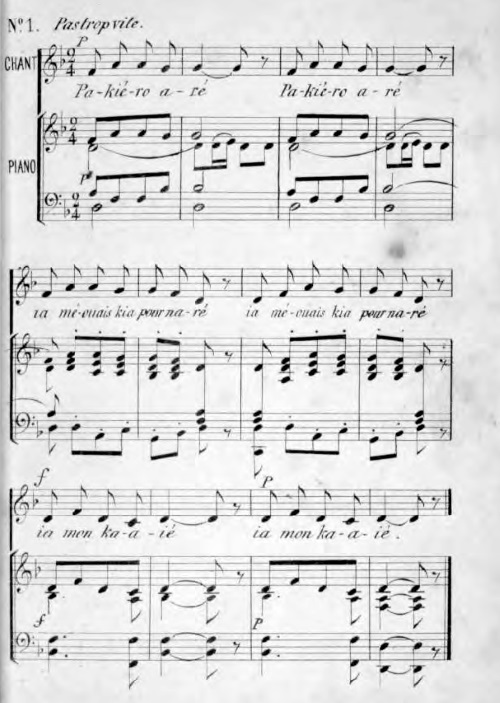
Pakiéro aré Pakiéro aré
ia méouais kia pour naré ia méouais kia pour naré
ia men kaaié ia men kaaié.
22.2 Hiento gallinand
22.2 "No. 2" (Le Hiento - se chante la nuit [sung at night])
text: Hiento gallinand galliand hiento gallinand gallinand para gallinand gallinand para gallinand gallinand
gloss: Waterlily root carry-we, carry-we. Waterlily root carry-we, carry-we. White man carry-we, carry we. White man carry-we, carry we (see Commentary below)
analytics: As for 22.1
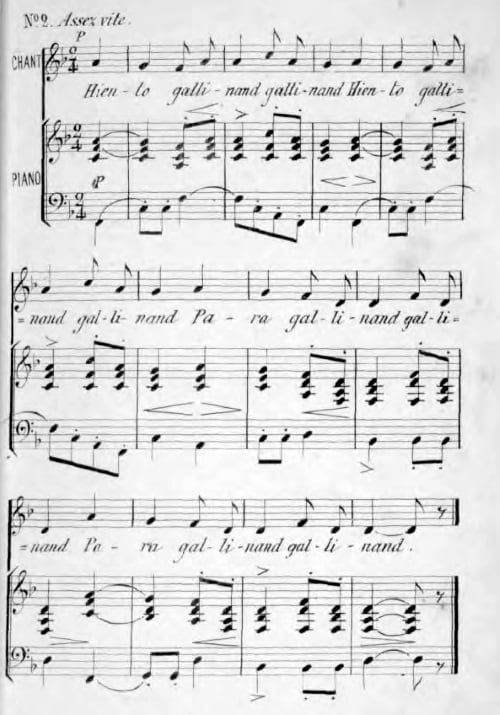
Hiento gallinand galliand Hiento galli-
nand gallinand Para gallinand galli-
nand Para gallinand gallinand.
22.3 Boba ia boba
22.3 "No. 3" (air de danse [dance tune])
text: Boba ia boba boba ia boba turba turba turba vouloi turba turba turba vouloi boba ia boba
analytics: As for 22.1
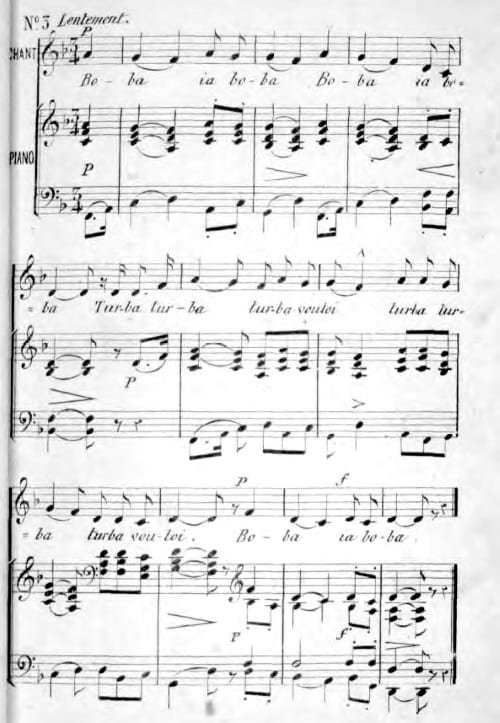
Boba ia boba Boba ia bo-
ba Turba turba turba vouloi turba tur-
ba turba vouloi. Boba ia boba.
22.4 La ponghé lapon
22.4 "No. 4" (La ponghéeacute; lapon - une invocation à la lune [an invocation of the moon])
text: La ponghé lapon la ponghé lapon laniméné laniméné cout chiava tcher poulai cout chiava tcher poulai la ponghé lapon
analytics: As for 22.1
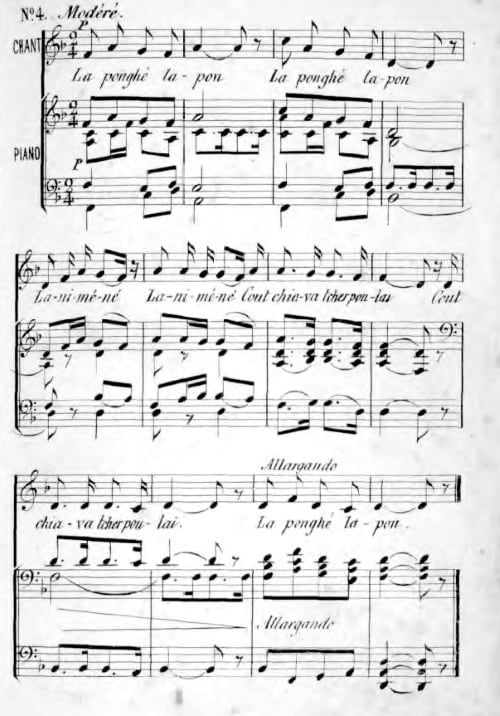
La ponghé lapon La ponghé lapon
Laniméné Laniméné Cout chiava tcher poulai Cout
chiava tcher poulai La ponghé lapon.
Bibliography:
Stephanie Anderson (trans.), Pelletier: the forgotten castaway of Cape York, introductory essay and translation . . . from the original book Dix-sept ans chez les sauvages: les aventure de Narcisse Pelletier by Constant Merland; ethnographic commentary by Athol Chase (Melbourne: Melbourne Books, 2009)
English translation of Merland 1876, including Garnier's musical appendix
Graeme Skinner, "Narcisse Pelletier", Australharmony (an online resource toward the early history of music in colonial Australia)
https://sydney.edu.au/paradisec/australharmony/pelletier-narcisse.php
Skinner 2017
Skinner and Wafer 2017
Commentary:
See also https://sydney.edu.au/paradisec/australharmony/pelletier-narcisse.php
Narcisse Pelletier sailed from Marseilles in August 1857 as a cabin boy on the Saint-Paul. Having meanwhile taken on some 300 Chinese passengers bound for the Australian goldfields, in September 1858, the ship struck a reef in the Louisiade Archipelago off New Guinea. Captain Emmanuel Pinard and a small party of crew then set out from Rossel Island (Yela) in an open boat, and twelve days (and 1200 kms) later landed on Cape York Peninsula and abandoned Pelletier, who was gravely ill, near Cape Direction. The castaway was taken in by a family of Uutaalnganu speakers, Sandbeach People (Pama Malngkana), and for the next 16 years lived an entirely traditional life with them, going by the name Anco (Merland: Amglo), having no contact with whites, until, on 11 April 1875, he was taken aboard a pearling lugger, the John Bell, by his own account "kidnapped". In Sydney, by June 1875, copies of photographs of Pelletier, probably taken in Queensland, were published by A. H. Lemartinière. Pelletier himself then spent about a month in Sydney, before sailing for New Caledonia, and from there, on 7 August 1875, on the Jura for France. In Paris in 1876, to raise money for Pelletier and to tell his story, Constant Merland published the book in which these songs appear.
There has been no detailed discussion of the music of songs transcribed from Pelletier's multiple performances by Edouard Garnier. Garnier explained that his task was not easy: Pelletier had no Western musical knowledge, would alter his rendition each time, his rhythm was often hard to discern. However, he claims, and indeed appears, to have been meticulous in matching, in the notation of the melody, what he heard Pelletier singing. He also transcribed the sung text as best he could, inventing the spelling.
Pelletier told him that the first and third songs were dance tunes, the second sung at night, and the fourth was an invocation of the moon. However, the words of songs 1, 3, and 4 meant nothing to Pelletier, who understood they belonged to "another tribe". The second song, however, he was able to explain. Based on Garnier's account and transcription, anthropologist David Thompson (Anderson, 357 note 2) gives the second song as:
Yunthu kalinan, kalinan, Yunthu kalinan, kalinan. Para kalinan, kalinan. Para kalinan, kalinan.
(Waterlily root carry-we, carry-we. Waterlily root carry-we, carry-we. White man carry-we, carry we. White man carry-we, carry we.)
Garnier's full account (transcribed here, translated in Anderson, 283-293) shows many unfortunate prejudices expected for the time, and many evidently wilful misinterpretations. However, I tend to think that, like Merland, he was genuinely trying to grapple with music that he found difficult to explain. To Garnier, the tunes, at least as fitted by him into Western tonal schemes, had a "liturgical character . . . reminiscent of church plain-song and especially Breton choruses". He noted that Pelletier was born and educated until age 12 in a communal school "a stone's throw from Brittany", and since Pelletier had been exposed to sacred and secular music in his home village, Garnier wondered whether the tunes, as recollected, had been influenced by childhood memory. Less persuasively, Garnier suggested that Pelletier's renditions recollected the sadness he felt remembering his childhood while exiled on Cape York, and accounted for their melancholic, religious character. He also concluded that his added harmonisations were essential to European reception of the song:
These airs, given with their single vocal line alone, would have little meaning. Presented with the accompaniment, they acquire, we believe, a certain character; they take on a distant flavour; and, as such, perhaps will be of some interest to musical readers.
c. 1867-1884
23 2 songs
Gabi Gabi, Mary River, Burnett River district, central QLD
Music and words collected and transcribed by John Mathew (1849-1929); published 1887
https://sydney.edu.au/paradisec/australharmony/checklist-indigenous-music-1.php#023 (shareable link to this entry)
Source and documentation:
John Mathew, "Mary River and the Bunya Bunya country", in Edward Micklethwaite Curr (ed.), The Australian race: its origin, languages, customs, place of landing in Australia and the routes by which it spread itself over the continent . . . volume 3 (Melbourne: John Ferres, Government Printer, 1887), 167-69 (commentary), 170-73 (music)
https://archive.org/stream/cu31924026093835#page/n179/mode/2up (DIGITISED)
[167] . . . The corroborees, or "yauar," as the Kabi people call them, fall naturally into two classes, the dramatic and the lyric. When a grand or dramatic corroboree had been composed, the poet trained the members of his own tribe to produce it. The intelligence that a new corroboree had been composed was received with pleasurable excitement by the surrounding tribes, and in due course gatherings were convened, at which it was performed. The poet having [168] introduced his work to the neighbouring tribes, these in turn invited their allies to witness it and aid in the performance. In this manner a corroboree travelled, and was sung with great enthusiasm where not a word of it was intelligible. The dramatic part in these performances was sometimes very considerable . . . [169] . . . The corroboree music is much like a chant. A string of words often runs to the one note. All the parts are variations of one tune, sung in different kinds of time, and at various rates of speed. There is a peculiar tendency to slide in semitones from one key into another, and the effect of the music is almost invariably minor. A favorite practice is to raise the pitch suddenly an octave, and in order to effect this it is sometimes necessary to allow it to slide to a low pitch in the manner spoken of above. Instead of intimating the conclusion of one part of the piece by two or three yells, a more musical practice is often followed of trilling the sound of r at a high pitch.
In the corroboree marked No. I. there is an example of the dramatic kind. Only a portion is given, but sufficient to indicate the character of the whole. The words are not Kabi. This is easily apparent from the feet being Iambic if from nothing else, as there is hardly an Iambic foot in Kabe. The lyrics are short simple ditties, comprising at most two parts. The subject is some exploit or custom of the composer, or perhaps the charms of his sweetheart. Such songs are only known to a few individuals, and are sung in private. In both examples that I give there seems to be an attempt at rhyme. I am pretty sure the effect is not accidental. If we take the words of the second example, which seem to be of the lyric kind, and is written in Kabi, we find a rhyme recurring containing the vowel a. That this is intentional is evident from the fact that the word kalaNa in the song is always in conversation pronounced kalaNur, that the word kariNga has not in conversation the hard g sound, and that a meaningless a is affixed to the word Nuyum. The words of the second part of No. II. are not intelligible to me. In the aboriginal voice there is a great deal of timbre, a quality which is greatly affected in private singing. Falsetto and tremulo are often used, and the force and expression are much varied.
23.1 Milo longo
23.1 "Corroboree I"
text: Milo longo wombo laililaiya . . . guvai alinge, guvai alingo . . . ye lingo
gloss: ("The words are not Kabi" - Mathew 1887, 169)
analytics: Mary River, Burnett River district, central QLD (region); ECA (music region); South-eastern PN/ Waka-Kabic/ Gabi Gabi (language)
Mathew 1887, 170-71 (music and words)
https://archive.org/stream/cu31924026093835#page/n183/mode/2up (DIGITISED)
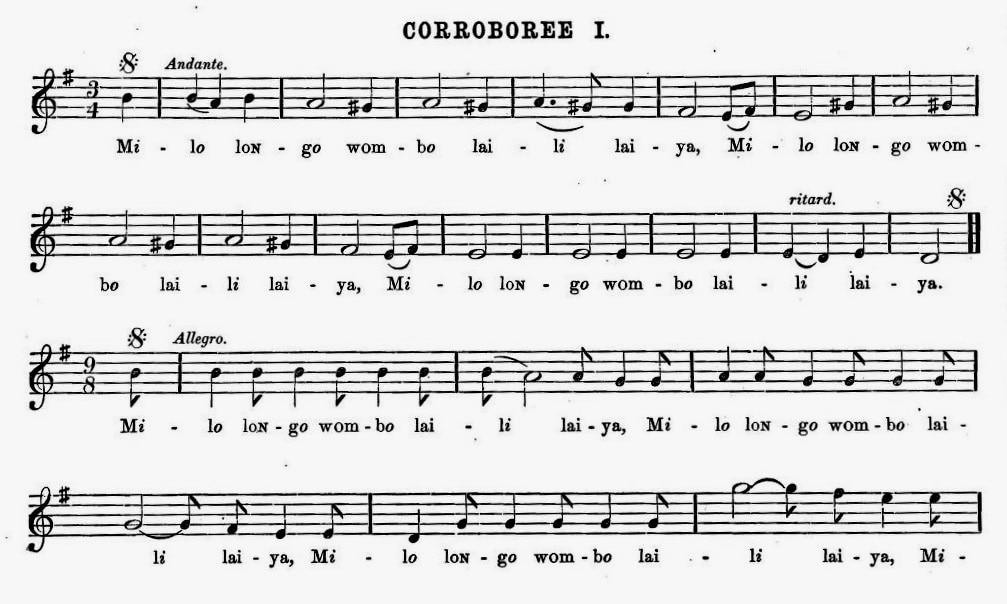
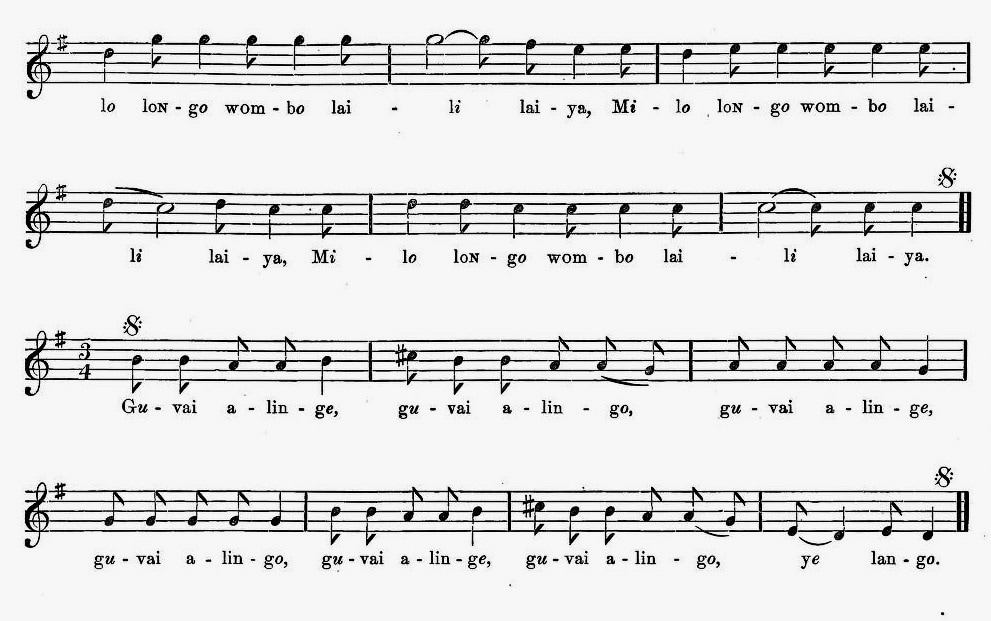
23.2 Weño karinga
23.2 "Corroboree II" [Mary River]
text: Weño karinga dha kalana nuyum nuyuma . . . tuanboroma buburindika wone dhomkiya worethe . . .
gloss: ("the second example . . . is written in Kabi" - Mathew 1887, 169)
analytics: As for 23.1
Mathew 1887, 172-73 (music)
https://archive.org/stream/cu31924026093835#page/n183/mode/2up (DIGITISED)
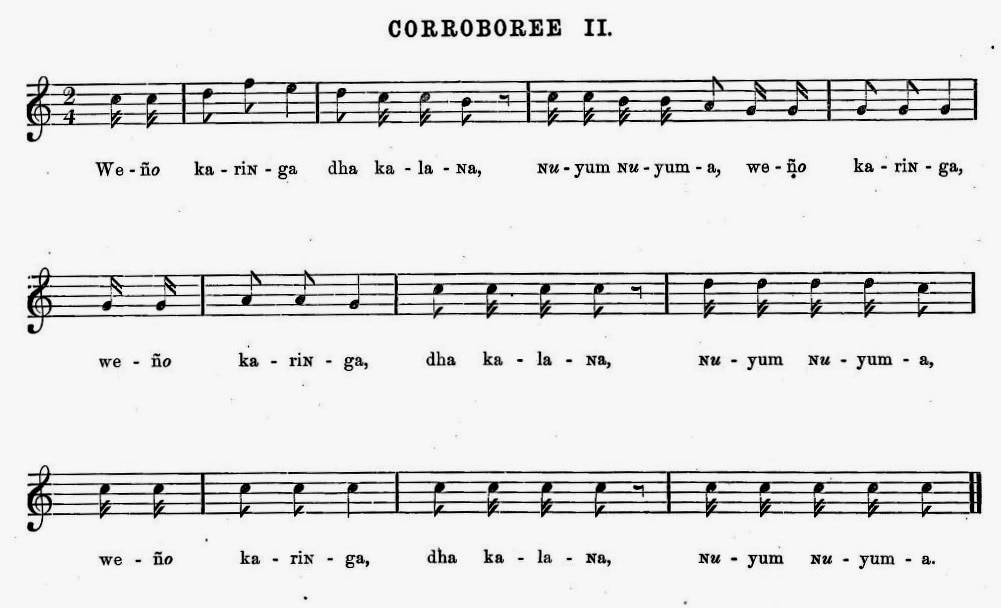
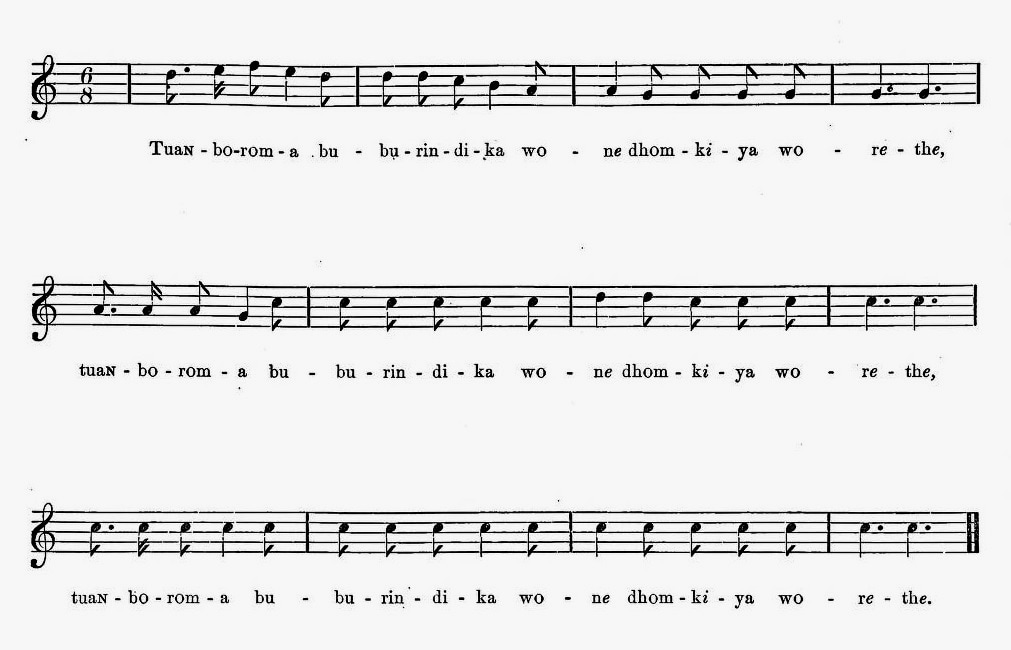
Bibliography:
John Mathew, Eaglehawk and crow; a study of the Australian Aborigines, including an inquiry into their origin and a survey of Australian languages (London: David Nutt; Melbourne: Mullen and Slade, 1899), 140-41
https://archive.org/stream/eaglehawkcrowstu00math#page/140/mode/2up (DIGITISED)
Henry Tate, "Aboriginal music: its artistic possibilities", The Argus (30 June 1923), 7
http://nla.gov.au/nla.news-article2002080
The books of the Rev. J. Mathew contain many references to native songs and descriptive details of the performances that are of interest musically. All these melodies are full of suggestion, and are likely to be valuable to composers who may wish to incorporate and develop traits of native minstrelsy in their own work . . .
Henry Tate, Australian musical possibilities (Melbourne: Edward A. Vidler, 1924), 32-33
http://nla.gov.au/nla.obj-52821442/view#page/n33/mode/1up (DIGITISED)
Nicole Saintilan, "Music - if so it may be called": perception and response in the documentation of Aboriginal music in nineteenth century Australia (M.Mus thesis, University of New South Wales, 1993), 83-85 (reproduces No. 1)
http://hdl.handle.net/1959.4/50383 (DIGITISED)
Malcolm D. Prentis, "Research and friendship: John Mathew and his Aboriginal informants", Aboriginal History 22 (1998), 62-93
http://press.anu.edu.au/wp-content/uploads/2016/02/article0516.pdf (DIGITISED)
Skinner and Wafer 2017
References:
"DR. J. MATHEW DEAD. CHURCHMAN AND ETHNOLOGIST", The Telegraph (16 March 1929), 20 (SECOND EDITION)
http://nla.gov.au/nla.news-article183807231
. . . Throughout his life Dr. Mathew's chief interest was always in philology and he is thought by many to be the greatest scholar we have had in Australia who studied the dialects of the Stone Age men. He was greatly helped in this work by his contact with the Kabi tribe, when he lived near the Burnett River, in Queensland. Much of his life was spent at Coburg, where he was minister for many years. He was inducted there in 1889. His earlier life was spent on his uncle's station in Queensland, where he later became manager of a property . . .
John Gladstone Steele, Aboriginal pathways in Southeast Queensland and the Richmond River (St. Lucia: University of Queensland Press, 1984), 216-24, 237-44
http://espace.library.uq.edu.au/view/UQ:200785 (DIGITISED)
M. D. Prentis, "Mathew, John (1849-1929)", Australian Dictionary of Biography 10 (1986)
http://adb.anu.edu.au/biography/mathew-john-7516/text13109 (DIGITISED)
. . . In 1864 Mathew migrated with a brother and sister to Queensland to live with their uncle John Mortimer on his station, Manumbar, on the Burnett River. Stockrider, bookkeeper, and storeman for six years, he became familiar with the language and culture of the Kabi and Wakka peoples, towards whom his Calvinist uncle acted humanely . . . From youth Mathew was a keen musician . . .
1882-83
24 3 songs
? Pirriya, Thomson River, western QLD (24.1)
? Wargamay, Herbert River, north QLD (24.2 and 24.3)
Music and words of all three collected and transcribed by Carl Lumholtz (1851-1922) between August 1882 and July 1883; published 1889
https://sydney.edu.au/paradisec/australharmony/checklist-indigenous-music-1.php#024 (shareable link to this entry)
24.1 Korroboree - La la la la la
24.1 "Korroboree . . . the melody sung to this dance"
text: La la la la la . . . altogether yarn away . . . Bahl bood'gry borando . . .
gloss: "melody sung to this dance was genuine Australian, but the text was mixed with English words" (Lumholtz 1889, 41)
analytics: Thomson River, western QLD (region); YCA (music region); Northern PN/ Maric/ ? Pirriya (language)
Carl Lumholtz, Among cannibals: an account of four years' travels in Australia and of camp life with the aborigines of Queensland . . . translated by Rasmus B. Anderson (New York: Charles Scribner's Sons, 1889), 41-42
https://archive.org/stream/amongcannibalsac1889lumh#page/41/mode/2up (DIGITISED)
Carl Lumholtz, Among cannibals: an account of four years' travels in Australia and of camp life with the aborigines of Queensland (London: J. Murray, 1889), 41-42
https://archive.org/stream/amongcannibalsa01lumhgoog#page/n80/mode/2up (DIGITISED)
[41] At Westlands station I had the good fortune to witness a korroboree, that is, a festive dance by the natives in the neighbourhood. The melody sung to this dance was genuine Australian, but the text was mixed with English words. The air was as follows : -
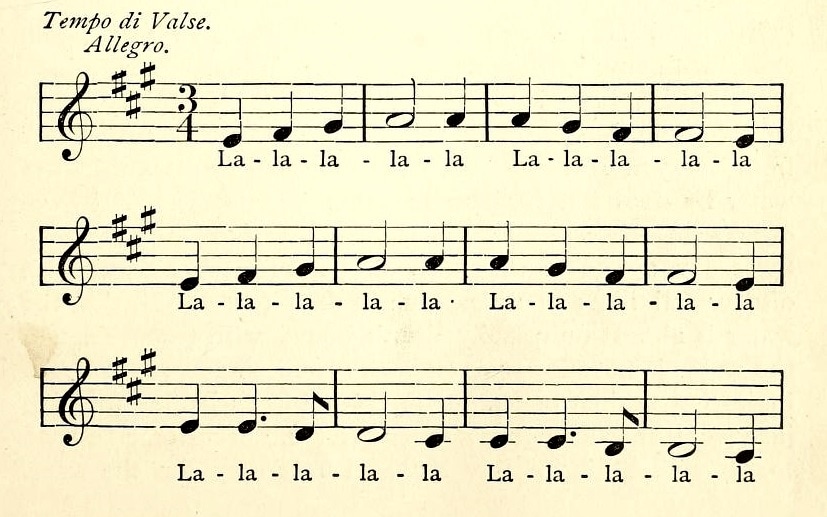
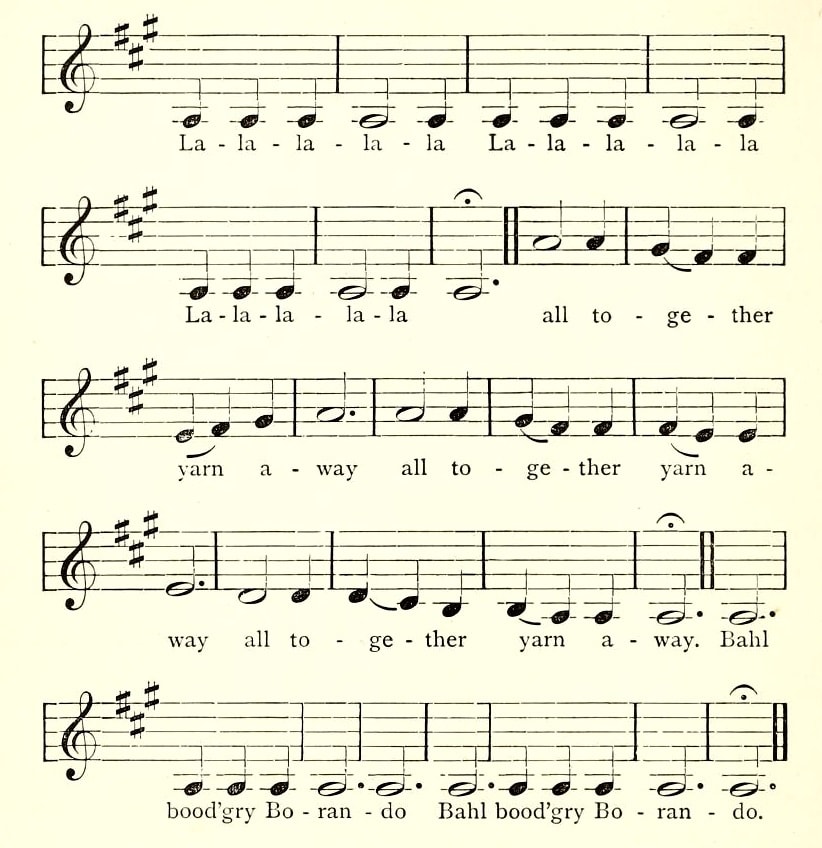
24.2 Mollemonbâ varinâ
24.2 "The song in vogue at this time, and which was sung repeatedly"
text: Mollemombâ (à) mombâ varinâ katsuburâ indangô gângoril-la
gloss: ("Doubtless it originated in the vicinity of Rockhampton . . . [but] on the Herbert River . . . it was sung without being understood", Lumholtz 1889, 157)
analytics: Herbert River, north QLD (region); YCA (music region); Northern PN/ Dyirbalic/ ? Wargamay (language)
Lumholtz 1889, 156-57 (US edition)
https://archive.org/stream/amongcannibalsac1889lumh#page/156/mode/2up (DIGITISED)
Lumholtz 1889, 156-57 (UK edition)
https://archive.org/stream/amongcannibalsa01lumhgoog#page/n216/mode/2up (DIGITISED)
[156] We spent several nights at our headquarters in this beautiful and invigorating mountain region. When we had eaten our supper and put all things to rights we laid ourselves round the fire, feeling very comfortable after the fatiguing journeys of the day. One of the natives then usually sang a song while lying on his back, accompanying himself with two wooden sticks. The song was, as usual, a ceaseless repetition of a couple of strophes, each one of which ended in a long monotonous series of deep tones by which the strophe was repeated. To be able to hold the last tone very long is a sign of ability to sing well. If a song has been known a long time in a tribe, it gradually loses its popularity, and gives place to a new composition, which is either original or borrowed from a neighbouring tribe. But they do not often have the opportunity of learning new songs, and consequently their repertoire is very limited. The song in vogue at this time, and which was sung repeatedly, was as follows: -
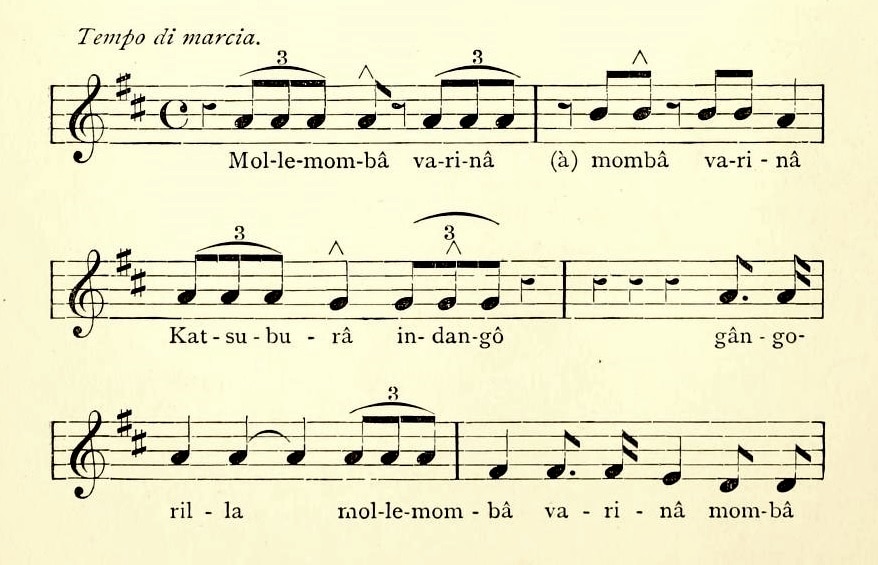
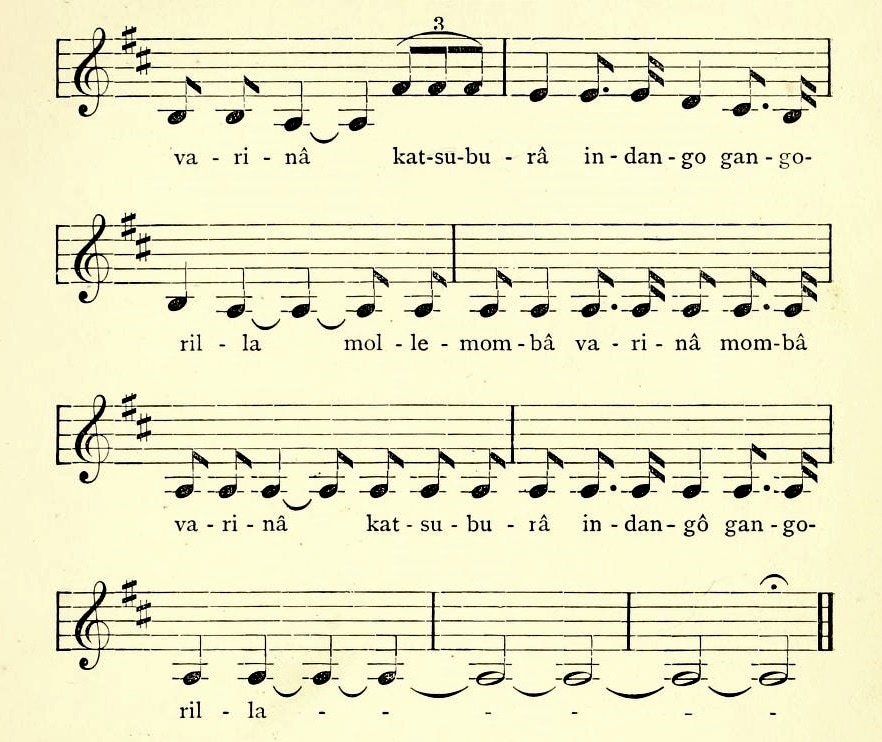
Mollemombâ (a) mombâ varinâ
Katsuburâ indangô gângo-
ril-la mollemombâ varinâ mombâ
varinâ katsuburâ indangô gângo-
ril-la mollemombâ varinâ mombâ
varinâ katsuburâ indangô gângo-
ril-la
It is a remarkable fact that they themselves sometimes do not understand the words which they sing, the song having been learned from a tribe which speaks another dialect. Thus a good song will travel from tribe to tribe. I heard the above-quoted song sung by "civilised" blacks near Rockhampton, 500 miles due south of Herbert Vale. Doubtless it originated in the vicinity of Rockhampton, and accordingly it must have travelled through "many lands" before it came to the savages in the mountains on Herbert river, where it was sung without being understood . . .
24.3 Wombon maraery!
24.3 "War-song"
text: Wombon maraery! wombon maraery! moridan koby beebon bindalgoh!
gloss: "war-song, which celebrates the knob on the throwing stick" (Lumholtz 1889, 158)
analytics: As for 24.2
Lumholtz 1889, 158 (US edition)
https://archive.org/stream/amongcannibalsac1889lumh#page/158/mode/2up (DIGITISED)
Lumholtz 1889, 156-57 (UK edition)
https://archive.org/stream/amongcannibalsa01lumhgoog#page/n218/mode/2up (DIGITISED)
[158] The following war-song, which celebrates the knob on the throwing- stick, I used to hear in the woods on Herbert river: -
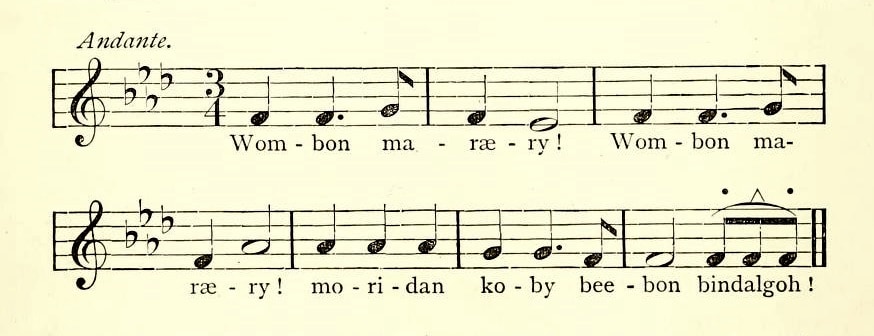
Wombon maraery! Wombon ma-
raery! moridan koby beebon bindalgoh!
Bibliography:
Roger Covell, Australia's music: themes of a new society (Melbourne: Sun Books, 1967), 67, 325
Terry G. Birtles, "Carl Lumholtz: a translation of answers to a questionnaire", Queensland Heritage 3/4 (1976), 4-22
http://espace.library.uq.edu.au/view/UQ:246314 (DIGITISED)
Grace Koch, "Dyirbal Gama songs of Cape York", in Margaret Clunies Ross et al., Songs of Aboriginal Australia (Sydney: University of Sydney, 1987), 46-47
Nicole Saintilan, "Music - if so it may be called": perception and response in the documentation of Aboriginal music in nineteenth century Australia (M.Mus thesis, University of New South Wales, 1993), 39-43
http://hdl.handle.net/1959.4/50383 (DIGITISED)
Skinner and Wafer 2017
c.1840-c.1885
25 3 songs
Kulin, Yarra region, VIC
Song 1 (25.1) (in "Woiwurrung") composed by or about Kurburu (c.1798-1849), c.1840s
Song 2 (25.2) composed by or about Wenberi/Winberri (c.1817-1840), c 1840s
Song 3 (25.3) (in "Wurunjerri")
All sung by William Barak (1824-1903), music and words transcribed by George William Torrance (1835-1907), Melbourne, VIC, c.1885, published 1887; words transcribed and translated separately by Alfred William Howitt (1830-1908), published 1887
https://sydney.edu.au/paradisec/australharmony/checklist-indigenous-music-1.php#025 (shareable link to this entry)
25.1 Kurburu's song
25.1 "Kurburu's song"
text: Enagūréa nūng ngalourma barein gūrūkba mūrnein būrūnbai nganŭngba lilira mŭringa (Howitt 1877, 333)
gloss: "You cut across my track, you spilled my blood, and broke your tomahawk on me" (translated by Barak, Howitt 1887, 333)
analytics: Yarra River, VIC (region); ECA (music region); South-eastern PN/ Kulin/ Woiwurung (language)
A. W. Howitt, "Notes on songs and songmakers of some Australian tribes", Journal of the Anthropological Institute of Great Britain and Ireland 16 (1887), 332-33
https://archive.org/stream/journalofroyalan16royauoft#page/332/mode/2up (DIGITISED)
[332] . . . A favorite song of this kind with the Murring is about "going to Melbourne in the steamer" and I have heard the Kurnai sing one inviting a friend to come to a "cool shady place with a bottle."
As connected with magic, or rather with the supernatural, the following song may serve as an example. It brings into view a curious belief in some connection supernaturally between beasts and man which is found in so many Australian beliefs and tales. [333] It was composed and sung by a bard named "Kurburu" who lived many years ago in the early days of the settlement of the country by the whites, near where the town of Berwick now stands, in the Western Port District. He was supposed to have killed a "native bear" and being possessed by its spirit (mūrŭp) thenceforth chaunted its song.
Kurburu's Song.
Enagūréa nūng ngalourma
There now cut-a-cross
barein gūrūkba mūrnein
track blood ?
būrūnbai nganŭngba
hurt myself
lilira mŭringa.
chipped tomahawk (with).
The singer, Berak, gave me the following free translation, "You cut across my track, you spilled my blood, and broke your tomahawk on me."
G. W. Torrance, "Music of the Australian Aboriginals", The Journal of the Anthropological Institute of Great Britain and Ireland 16 (1887), 337
https://archive.org/stream/journalofroyalan16royauoft#page/337/mode/2up (DIGITISED)
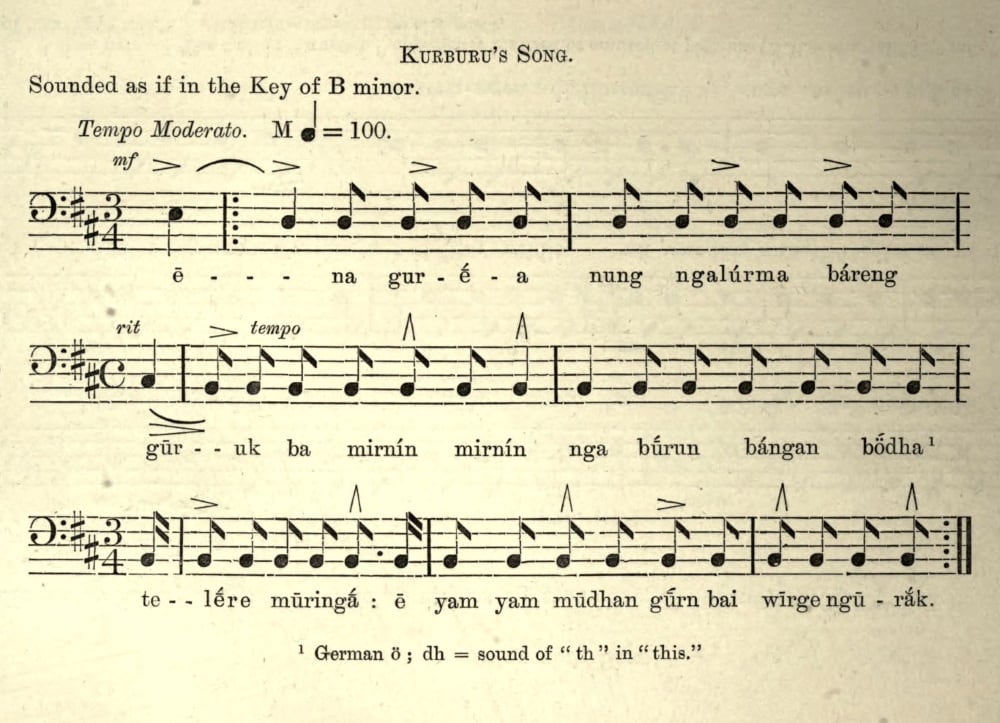
[337] The above was repeated several times, without break or pause, omitting the "intonation" at each repetition, and ending abruptly at the double bar.
A. W. Howitt, The native tribes of south-east Australia (London: Macmillan and Co., 1904), 420-22
https://archive.org/stream/nativetribesofso00howiuoft#page/420/mode/2up (DIGITISED)
Reprints music and words from Torrance 1887, 420; Howitt's commentary, 421-22
[421] Kurburu's song serves as an example of those which are connected with the supernatural, and it brings into view a curious belief, which is found in so many Australian legends and tales, of a supernatural relation of men and beasts. It was composed and sung by a bard called Kurburu, who [422] lived during the early settlement of the country by the whites near where the town of Berwick now stands. He was supposed to have killed a "native bear," and being possessed by its Murup or spirit, thenceforth sang its song. I was not able to obtain a verbatim translation of it, but Berak gave me the following free translation: "You cut across my track, you spilled my blood, and you broke your tomahawk on my head."
25.2 Wenberi's song
25.2 "Wenberi's song"
text: Nge tuigár ngalá ngibnba ngalūgá
diudirŭnding nga Dŭlŭr wílūit
wa weindŭng bŭnjil mameng-ngata yenin
thŭlŭrmeik nga wŭrngalŭk-eik (Howitt 1887, 331)
gloss: "We go all (the) bones to all of them/ shining white (in) this Dulur country./ The noise rushing (of) Bunjil father ours singing / (in) breast mine this inside-mine" (Howitt 1887, 331. Howitt notes that the song is "a good example of the belief held by these 'sacred singers' that they were inspired by something more than mortal when composing them. In this case it is 'Bunjil' himself who 'rushes down' into the heart of the singer."
analytics: Mount Macedon (region); ECA (music region); South-eastern PN/ Kulin/ Woiworung (Mount Macedon dialect) (language)
A. W. Howitt, "Notes on songs and songmakers of some Australian tribes", Journal of the Anthropological Institute of Great Britain and Ireland 16 (1887), 330-31
https://archive.org/stream/journalofroyalan16royauoft#page/330/mode/2up (DIGITISED)
[330] In the tribes with which I have acquaintance I find it a common belief that the songs, using that word in its widest meaning, as including all kinds of aboriginal poetry, are obtained by the bards from the spirits of the deceased, usually their relatives, during sleep in dreams. Thus the Biraark of the Kurnai professed to receive their poetic inspirations from the ghosts (mrart) as well as the dances which they were supposed to have first seen performed in ghostland. An interesting example of such an "inspired song" is found among the Woiworung. According to my informant, Berak, it was composed by the headman of that section of the Woiworung tribe which was located about Mount Macedon, and in the males of whose family, from one generation to the other, was the custody of the quarry from which the surrounding tribes obtained the stone for their tomahawks. The bard who composed this song came of a poetic stock. His father and his father's father before him are said to have been "the makers of songs which made men sad or joyful when they heard them." The old man who sang this song to me was moved almost to tears by the melancholy which the words conveyed to him as he chaunted it.
One must be struck by the existence in an Australian tribe of a family of bards, the prototypes of the "sacred singers" of olden times. The song is a good instance of this class of compositions, and also a good example of the belief held by these "sacred singers" that they were inspired by something more than mortal when composing them. In this case it is "Bunjil" himself who "rushes down" into the heart of the singer.
The words of the song are as follows, and in the Appendix will be found another slightly different version. I am under very great obligations to the Rev. G. W. Torrance, M.A., Mus.D., for most kindly writing down the music from the lips of the singer [331] Berak, and for the most valuable remarks which he has made upon the songs given in the Appendix and on the singers' musical powers. To the Rev. Lorimer Fison, M.A., my valued fellow-worker in this part of the anthropological field, I am also greatly obliged for the trouble he has taken in bringing about the meeting between Dr. Torrance and the native bard, and for writing down with such care the words of the songs.
Wenberi's Song.
Nge tuigár ngalá ngibnba ngalūgá
We go all (the) bones to all of them
diudirŭnding nga Dŭlŭr wílūit.
shining white (in) this Dulur country.
Wa Weindŭng Bŭnjil mameng-ngata yenin
The noise rushing (of) Bunjil father ours singing
thŭlŭrmeik nga wŭrngalŭk-eik.
(in) breast mine this inside-mine.
Berak said that this song was made on the death of Wenberi's brother, who died through evil magic in the Dullur country beyond Geelong.
ASSOCIATIONS: Lorimer Fison (transliterator)
G. W. Torrance, "Music of the Australian Aboriginals", The Journal of the Anthropological Institute of Great Britain and Ireland 16 (1887), 338
https://archive.org/stream/journalofroyalan16royauoft#page/338/mode/2up (DIGITISED)
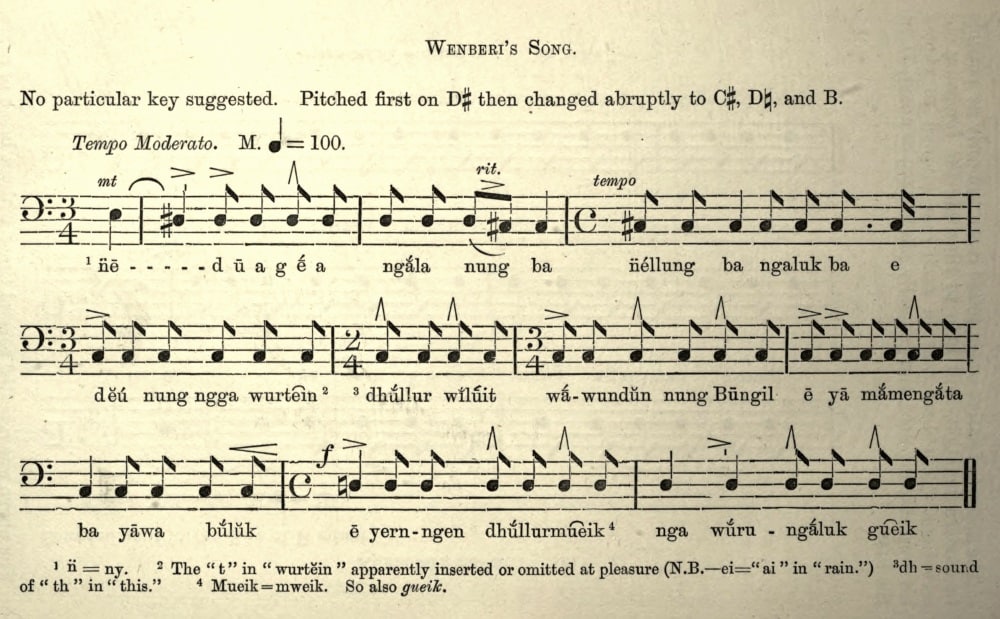
[338] This song was repeated on B, a third lower, and sung through to the same sound.
A. W. Howitt, The native tribes of south-east Australia (London: Macmillan and Co., 1904), 420-422
https://archive.org/stream/nativetribesofso00howiuoft#page/420/mode/2up (DIGITISED)
Music and words copied from Torrance 1887, 421-22; Howitt's commentary, 422
[422] Wenberi's song, as given by Dr. Torrance, differs slightly from it as I wrote it down from Berak's dictation some time before, which with its translation runs as follows: -
Nge tuigar ngala ngibenba ngaluga
We go all the bones to all of them
diudirunding nga Dullur wiluit
shining white in this Dullur country
waweinduing Bunjil mamen-ngata yennin
the rushing noise Bunjil father ours singing
thulurm-eik nga wur-galuk-eik.
breast mine this inside mine.
25.3 Corroboree song
25.3 "Corroboree song" (Barak)
text: ē ngā waajëlaiya bŭn-dea genunwil/ ngā burdangala yelengea gonowara/ ngā wagelaiya bŭn-dea, &c. (Torrances 1887, 339) [see image below for all diacritics]
gloss: This "corrobboree song . . . is one used by the Wurunjerri, but of which I have no translation" (Howitt 1904, 422)
analytics: Yarra region (region); ECA (music region); South-eastern PN/ Kulin/ Wurunjeri
G. W. Torrance, "Music of the Australian Aboriginals", The Journal of the Anthropological Institute of Great Britain and Ireland 16 (1887), 339
https://archive.org/stream/journalofroyalan16royauoft#page/339/mode/2up (DIGITISED)
[339] CORROBOREE SONG. Sung on D, with nasal "intonation" preceding, and no change of note till repetition.
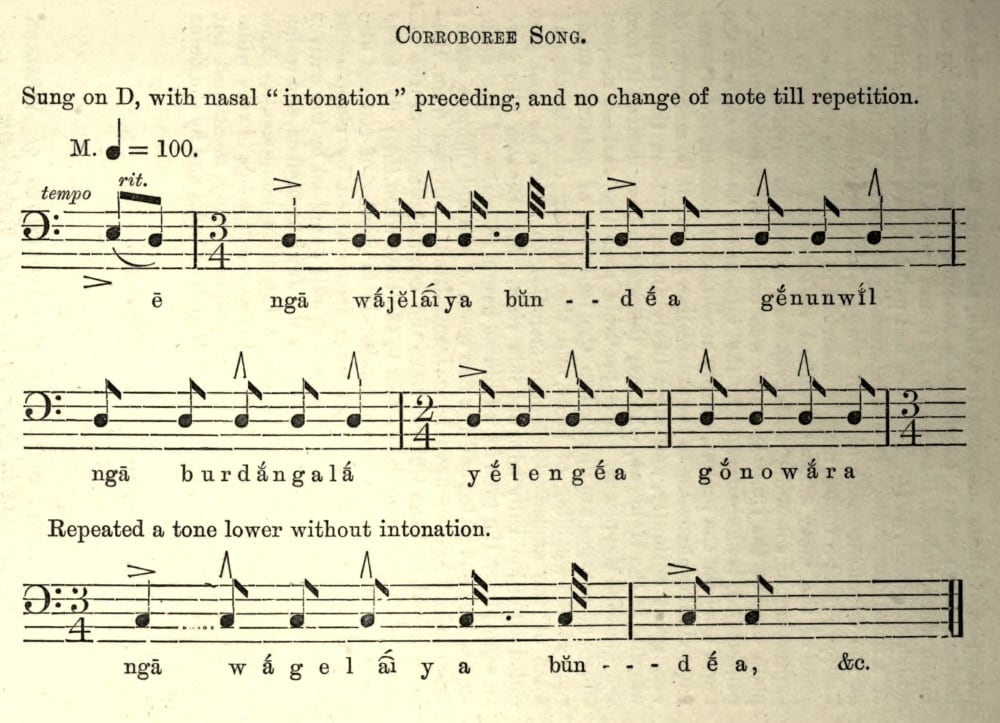
This drone or chaunt is repeated ad lib. as long as the ceremony lasts, a tone lower each time, and accompanied throughout with clapping of hands and stamping of feet.
A. W. Howitt, The native tribes of south-east Australia (London: Macmillan and Co., 1904), 421-22
https://archive.org/stream/nativetribesofso00howiuoft#page/421/mode/2up (DIGITISED)
Music and words from Torrance 1887, 421; Howitt's commentary, 422
[422] The corrobboree song given by Dr. Torrance is one used by the Wurunjerri, but of which I have no translation.
Documentation:
William Barak, Corroboree, c.1885; National Gallery of Australia
http://artsearch.nga.gov.au/Detail.cfm?IRN=104077 (DIGITISED)
G. W. Torrance, "Music of the Australian Aboriginals", The Journal of the Anthropological Institute of Great Britain and Ireland 16 (1887), 335-37 (music and discussion)
https://archive.org/stream/journalofroyalan16royauoft#page/335/mode/2up (DIGITISED)
[335] THE following brief description of the music of the Australian aboriginals, with specimens of their songs from an authentic source, is offered as a contribution to Mr. Howitt's paper on "Songs and Song Makers." Being the result of but a single interview with a native bard, the particulars here noted are of necessity imperfect and superficial. Such as they are, however, it is hoped that they may prove of some little historic value, and lead to further inquiry into a subject which cannot fail to be one of interest to the anthropological student.
Generally speaking, the rude attempts at melody exhibited by these untaught natives may be described as a kind of nasal monotone, or chaunt, usually preceded by a downward progression somewhat resembling the "intonation" in Gregorian music. The songs are marked throughout by sudden, frequent [336] and ever varying inflections of voice, in compass rarely exceeding the distance of a third, and minor intervals predominating.
Much of the character of the music depends upon the rhythm which, while very strongly marked, is also most irregular, changing suddenly, and alternating frequently between duple and triple; the changes, moreover, being sometimes introduced by a slackening of the time, and a curious sliding of one sound into another, not unlike the slow tuning of a violin string.
In the "Corroboree" the rhythmic measures are emphasized by clapping of hands and stamping of feet. When one singer or set of singers is exhausted, others in turn take up and continue the chaunt ad lib., till the wild dance is concluded.
The native bard alluded to above (William Berak, from whom the illustrations were obtained), is an intelligent representative of his race. His voice is a baritone of average compass and not unpleasing quality. His ear also is fairly quick and accurate, though occasionally he would pause long as if trying to recall the test sounds before repeating them; and his patience, good temper, and evident pleasure at seeing his songs committed to paper, were very remarkable . . .
[337] . . . The bard was in each case allowed to choose his own starting note, and generally pitched on, or about, D in the bass . . .
Bibliography:
Robert Etheridge, Contributions to a catalogue of works, reports, and papers on the anthropology, ethnology, and geological history of the Australian and Tasmanian Aborigines . . . part 2 (Memoirs of the geological survey of New South Wales, palaeontology 8) (Sydney: Government Printer, 1891), 45
https://archive.org/stream/contributionsto00ethegoog#page/n91/mode/2up (DIGITISED)
Henry Tate, "Aboriginal music: its artistic possibilities", The Argus (30 June 1923), 7
http://nla.gov.au/nla.news-article2002080
Vivid and detailed accounts of the picturesque ceremonies that inspired the music of the aborigines may be found in the pages of many eminent Australian scientists and observers. Yet so little is actually recorded in musical notation of the remarkable and characteristic sound fantasies that once rang throughout the length and breadth of Australia that the scattered fragments which have been preserved gather a constantly increasing musical interest and value as time goes on in Dr. A. W. Howitt's "Native Tribes of Southern Australia" three dirge-like songs recorded by Dr. Torrance possess considerable rhythmic interest. One of them is a song of the Wurrunjerri, the tribe that once occupied the site of Melbourne. Another was composed by Kurburu, a native minstrel who lived where the town of Berwick now stands. It was generally believed by the native composers that they were inspired by some mystic power, something "that rushes down into the breast of the singer." This belief is exhibited in Kurburu's song. Kurburu had killed a native bear and its murup or spirit entered his breast and made him sing, "You cut across my track, you spilled my blood, and you broke your tomahawk on my head." Another of these songs of the Victorian tribes is a lament for a native who died through "evil magic" in the Duklur country near Geelong . . .
Henry Tate, Australian musical possibilities (Melbourne: Edward A. Vidler, 1924), 32-33
http://nla.gov.au/nla.obj-52821442/view#page/n33/mode/1up (DIGITISED)
Nicole Saintilan, "Music - if so it may be called": perception and response in the documentation of Aboriginal music in nineteenth century Australia (M.Mus thesis, University of New South Wales, 1993), 80-82
http://hdl.handle.net/1959.4/50383 (DIGITISED)
Marie Hansen Fels, "I succeeded once": the Aboriginal protectorate on the Mornington Peninsula, 1839-1840 (Aboriginal History Monograph 22) (Canberra: ANU Press; Aboriginal History Inc, 2011), 114-15, 241-44
http://press.anu.edu.au/?p=110711 (DIGITISED)
Lisa Marcussen (comp.), Selected bibliography of material on the Woiwurrung / Wurundjeri / Woiwurung language and peopleheld in the AIATSIS Library (2015)
Graeme Skinner, "Recovering musical data from colonial era transcriptions of Indigenous songs: some practical considerations", in Jim Wafer and Myfany Turpin (eds), Recirculating songs: revitalising the singing practices of Indigenous Australia (Canberra: Asia-Pacific Linguistics, 2017), 352
http://hdl.handle.net/1885/132161
https://openresearch-repository.anu.edu.au/bitstream/1885/132161/25/16_skinner.pdf (FREE DOWNLOAD)
Graeme Skinner and Jim Wafer, "A checklist of colonial era musical transcriptions of Australian Indigenous songs", in Jim Wafer and Myfany Turpin (eds), Recirculating songs: revitalising the singing practices of Indigenous Australia (Canberra: Asia-Pacific Linguistics, 2017), 388-90
http://hdl.handle.net/1885/132161
https://openresearch-repository.anu.edu.au/bitstream/1885/132161/26/17_skinner_wafer.pdf (FREE DOWNLOAD)
Commentary:
Torrance's meeting with Barak appears to have been arranged not only by Howitt but also by their mutual friend, the anthropologist Lorimer Fison (1832-1907). Wenberi's song dates from the 1840s.
References:
R. Brough Smyth (ed.), The Aborigines of Victoria: with notes relating to the habits of the natives of other parts of Australia and Tasmania (Melbourne: John Ferres, Government Printer, 1878), volume 1, 447-48 footnote
https://archive.org/stream/aboriginesofvict01smyt#page/446/mode/2up
"Kur-bo-roo, a well-known Western Port black, and held in high esteem as a sorcerer, a dreamer, and diviner, was named 'The Bear,' under the following circumstances. Kur-bo-roo was born at the foot of a tree, and during his mother's trouble a bear in the tree growled and grunted until Kur-bo-roo was born, when he ceased his noise. By this, it was said, the bear intended to show that the male child born at the foot of the tree should have the privilege of consulting the bears, and the child was called Kur-bo-roo. Kur-bo-roo attained to some excellence in his profession, [448] and was regarded by all as a very wise man and doctor. When a black man dreams of bears, it is a sad omen. All the people are afraid when any one dreams of bears. One time, when there were about two hundred blacks at Nerre-nerre-Warreen (on the Yarra), including about eighteen children attending the school, Kur-bo-roo had a dream. He dreamt that he was surrounded by bears. He awoke in a great fright about one o'clock in the morning, and at once aroused the whole encampment. It was half an hour or more before I could discover the cause of the great excitement everywhere apparent. Fires were suddenly set ablaze. The young blacks climbed the trees, cut down boughs, and fed the fires. The men, women, and children rushed hither and thither, displaying the greatest terror. I reasoned with them, sought to soothe them, endeavoured to control them; but all my efforts were useless. They fled from the spot where they had so long lived in comfort. By eight o'clock in the morning the forest was a solitude - not a soul remained; and all because of a dream of Kur-bo-roo." - The late Wm. Thomas's MS.
ASSOCIATIONS: Smyth's informant was William Thomas (1791-1867)
Florence Ada Fuller (1867-1946), Barak: last chief of the Yarra Yarra Tribe of Aborigines, 1886; State Library of Victoria
https://trove.nla.gov.au/work/18883462
Alison Petch and Jason Gibson, "The ablest Australian anthropologists': two early anthropologists and Oxford"
https://www.anthro.ox.ac.uk/sites/default/files/anthro/documents/media/jaso5_1_2013_60_85.pdf
1888
26 1 song
Thursday Island, QLD
Western Torres Strait dialect ("Mabuiagic"), Western Torres Strait Islands, QLD
Music and words transcribed by Alfred Haddon, November 1888, from performance by Mabuiag and Naghir Islanders (Kudumu of Nagirm and Marudĕn and Zagăra of Muralug) on Thursday Island, QLD; first published 1890
https://sydney.edu.au/paradisec/australharmony/checklist-indigenous-music-1.php#026 (shareable link to this entry)
Saw-fish dance song
26 "Waiitut kap kudu" (Saw-fish dance song)
text: Ngai natan he! Danabi he! Mari naidĕm he! he, he, wa! / Ngita kai he! Ngai keka he! - he - ! Tuwa patan he! He - he! / Yawa bōi he! Wa pōnipan he! Yawa bōi he! he, he, wa! / Wapi sĕnu ngapa! Iaubu ulaipa he! Pula sena ngapa. Iabu mulsipa! Sandĕral he!
gloss: Now I can see myself reflected in the pools on the reef as in a mirror / You cut the shoot of the coco palm for me / Farewell dead coco palm leaves. Ho! there's the lightning / Fish now approach the shore, and we must build fish-weirs in their route.
analytics: Western Torres Strait (region); TSI (music region); Northern PN/ Western Torres Strait/ Kala Lagaw Ya (language)
Source and documentation:
A. C. Haddon, "Ethnography of the western tribes of Torres Straits", The Journal of the Anthropological Institute of Great Britain and Ireland 19 (1890), 376-80
https://archive.org/stream/journalanthropo08irelgoog#page/n411/mode/2up (DIGITISED)
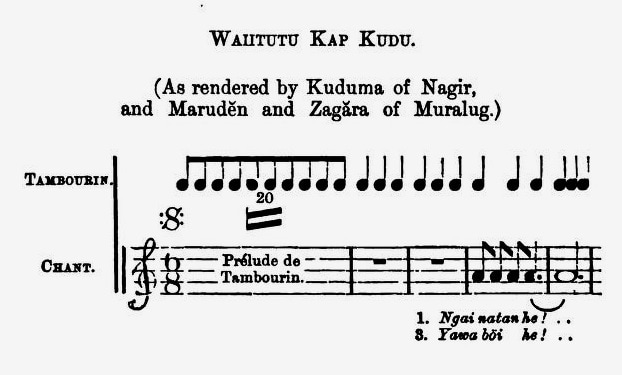
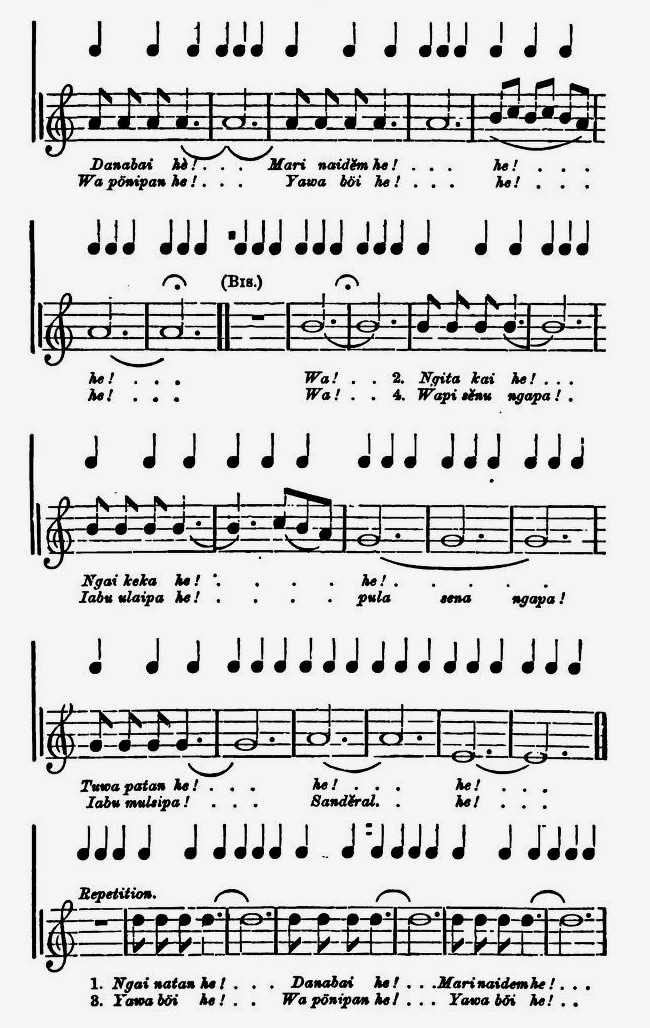
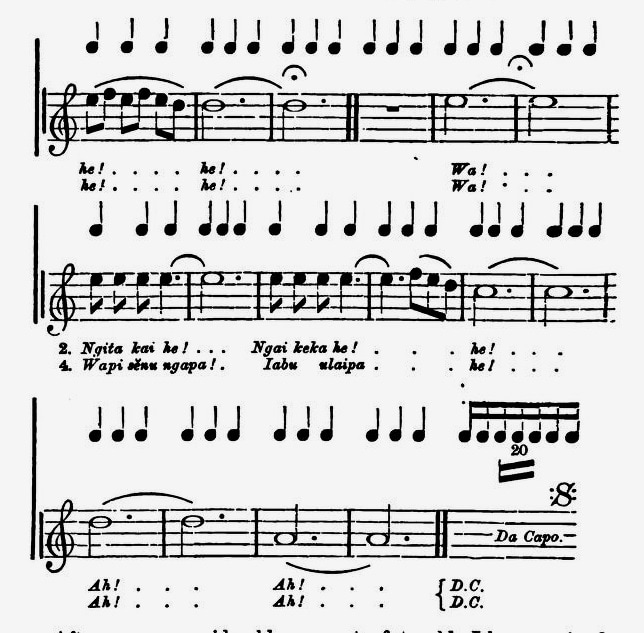
WAIITUTU KAP KUDU
1. Ngai natan he! Danabi he! Mari naidĕm he! he, he, wa!
2. Ngita kai he! Ngai keka he! - he - ! Tuwa patan he! He - he!
3. Yawa bōi he! Wa pōnipan he! Yawa bōi he! he, he, wa!
4. Wapi sĕnu ngapa! Iaubu ulaipa he! Pula sena ngapa. Iabu mulsipa! Sandĕral he!
COUPLETS OF THE SAW-FISH DANCE, or Song of the North-West Monsoon
1. Now I can see myself reflected in the pools on the reef as in a mirror.
2. You cut the shoot of the coco palm for me.
3. Farewell dead coco palm leaves. Ho! there's the lightning.
4. Fish now approach the shore, and we must build fish-weirs in their route.
A. C. Haddon, "The secular and ceremonial dances of Torres Straits", Internationales Archiv für Ethnographie 6 (1893), 131-62
https://archive.org/stream/bub_gb_inBGAAAAMAAJ#page/n137/mode/2up (DIGITISED)
Especially 146-49
https://archive.org/stream/bub_gb_inBGAAAAMAAJ#page/n153/mode/2up (DIGITISED)
And plates
https://archive.org/stream/bub_gb_inBGAAAAMAAJ#page/n255/mode/2up (DIGITISED)
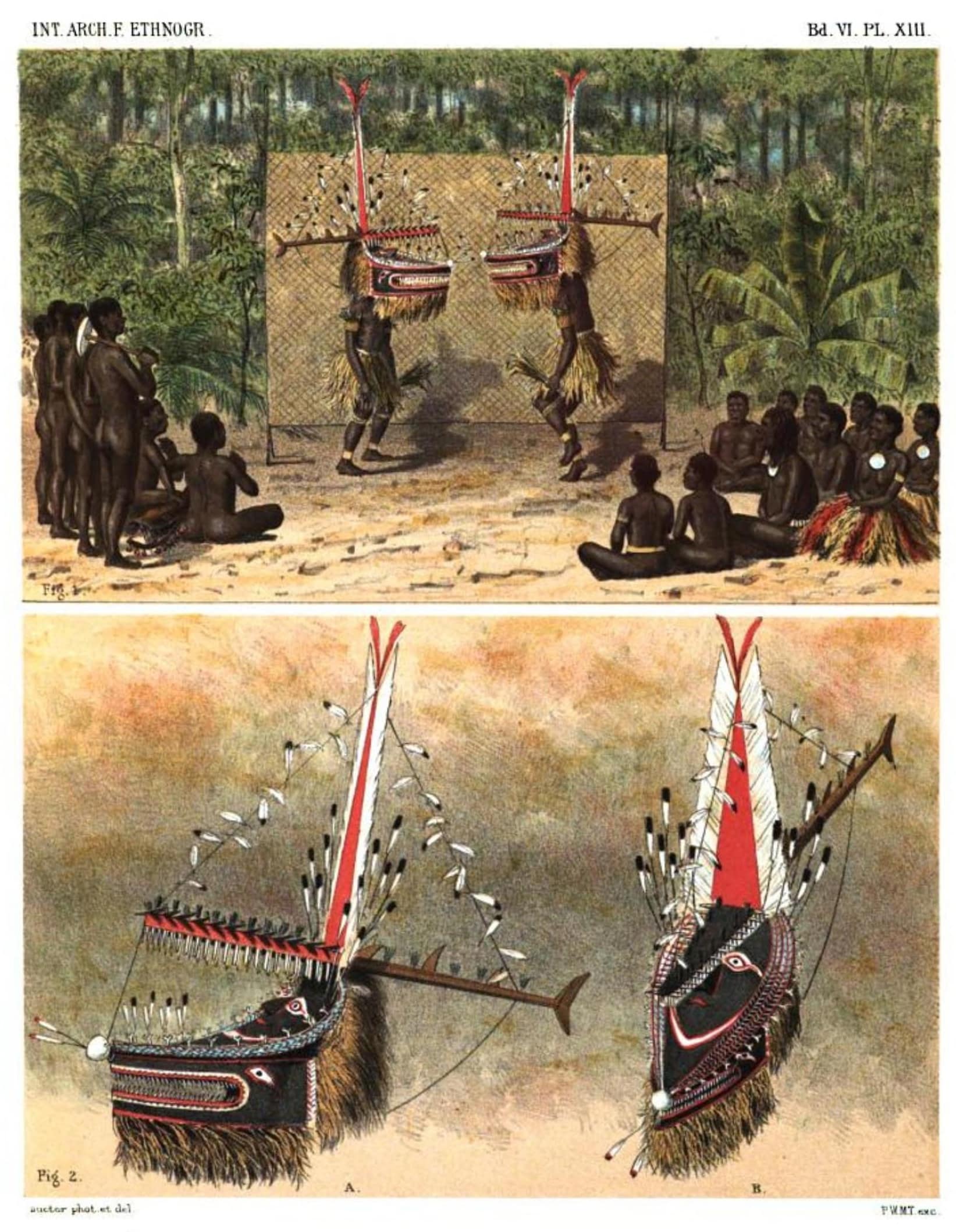
A. C. Haddon et al., "Magic and religion", in Haddon (ed.), Reports of the Cambridge Anthropological Expedition to Torres Straits (1898), volume 5: sociology, magic and religion of the western islanders (Cambridge: The University Press, 1904), 343
https://archive.org/stream/reportsofcambrid05hadd#page/342/mode/2up (DIGITISED)
Bibliography:
Alice Bertha Gomme, The traditional games of England, Scotland and Ireland: with tunes, singing rhymes and methods of playing according to the variants extant and recorded in different parts of the kingdom . . . volume 2, Oats and beans - Would you know (London: David Nutt, 1898), 519-20
https://archive.org/stream/traditionalgames02gommuoft#page/519/mode/2up (DIGITISED)
Skinner and Wafer 2017
c. 1890-1900
27 5 songs
Maric, Maranoa and Warrego districts, NSW/QLD border
Music and words transcribed and translated by Harold Octavius Lethbridge (1880-1944) and his sister Flora Josepha Lethbridge (1873/4-1956; Mrs. Murphy - see 27.7), from various singers including Boss Davey (d. 1916), Forest Vale Station, near Mitchell, c.1890-1900; published 1937
https://sydney.edu.au/paradisec/australharmony/checklist-indigenous-music-1.php#027 (shareable link to this entry)
Source:
H. O. Lethbridge and Arthur S. Loam, Australian aboriginal songs: melodies, rhythm and words truly and authentically aboriginal collected and translated . . . accompaniments arranged . . . (Melbourne: Allan & Co., 1937)
https://trove.nla.gov.au/work/12854463
http://nla.gov.au/nla.obj-172234124 (DIGITISED)
[2] In this set of songs from the Maranoa District, Queensland, we have adhered strictly to the melody, rhythm and words of the original songs. We believe that any attempt to alter in the slightest degree the aboriginal composition would rob the series of their fascinating interest. The translation is free but true.
27.1 Mumma warrunno
27.1 "I. Maranoa lullaby"
text: Mumma warrunno murra wathunno [repeat]
gloss: "To this song the mother rocked her baby to sleep in the bark cradle, using her foot to avoid stooping."
analytics: Maranoa district, NSW/QLD border (region); YCA (music region); Northern PN/ Maric/ ? Gunggari (language)
[2] A MARANOA LULLABY. To this song the mother rocked her baby to sleep in the bark cradle, using her feet to avoid stooping.
Lethbridge and Loam, Australian aboriginal songs, 4-5 (music and words):
http://nla.gov.au/nla.obj-172234124/view#page/n4/mode/1up (DIGITISED)
The complete musical and linguistic content of the source song appears in the 8 bars of the vocal line only (bars 3-10) in the pictured extract below
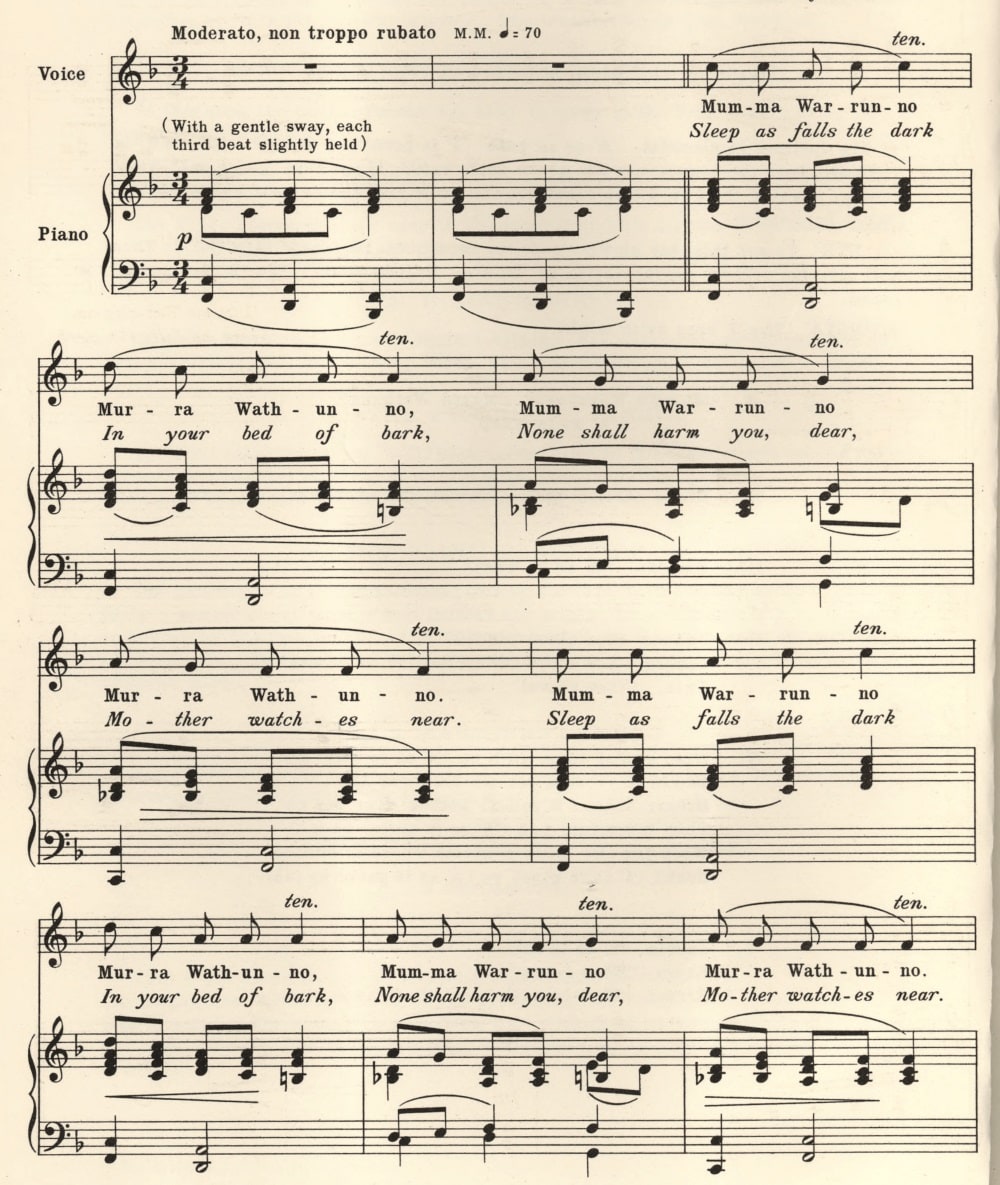
[2] A MARANOA LULLABY. To this song the mother rocked her baby to sleep in the bark cradle, using her feet to avoid stooping.
[2] Mumma Warrunno Murra Wathunno
Mumma Warrunno Murra Wathunno
Mumma Warrunno Murra Wathunno
Mumma Warrunno Murra Wathunno
Sleep as falls the dark in your bed of bark,
none shall harm you dear, Mother watches near.
Sleep as falls the dark in your bed of bark,
none shall harm you dear, Mother watches near.
Other resources:
Harold Blair singing Maranoa Lullaby on an unreleased recording from 1950, opening only (National Film and Sound Archive)
http://aso.gov.au/titles/music/maranoa-lullaby/clip1 (STREAMED SOUND)
Ethel Munn - Maranoa Lullaby, First Languages Australia, posted 29 June 2014
https://vimeo.com/99494828 (STREAMED VIDEO & SOUND)
http://www.qilac.org.au/film/maranoa-lullaby (STREAMED VIDEO & SOUND)
27.2 a, b, c Bingo corroborees
[2] THE BINGO SERIES. The Bingo Series were all sung to the same air. This air was composed by Boss Davey of the Maranoa about 1900.
[6] Words and melodies by BOSS DAVEY (Maranoa River)
[6] Boss Davey, the author of the Bingo Series, had an aboriginal name MUNDÂLO (the a as in calm).
27.2a "II. Bingo corroborees: (a) Bingo bingo"
text: Bingo bingo carmoo curree . . . cowal cowal cowal cowal . . .
gloss: "This is a warning to a youth against bathing in a water-hole at the junction of Bailey's Creek with the Maranoa River. This water-hole was inhabited by a Bunyip."
analytics: As for 27.1
Lethbridge and Loam, Australian aboriginal songs, 6-7
http://nla.gov.au/nla.obj-172234124/view#page/n6/mode/1up (DIGITISED)
The complete musical and linguistic content of the source song appears in the 12 bars of the vocal line only in the pictured extract below. The words of the other two songs are fitted to the same melody.
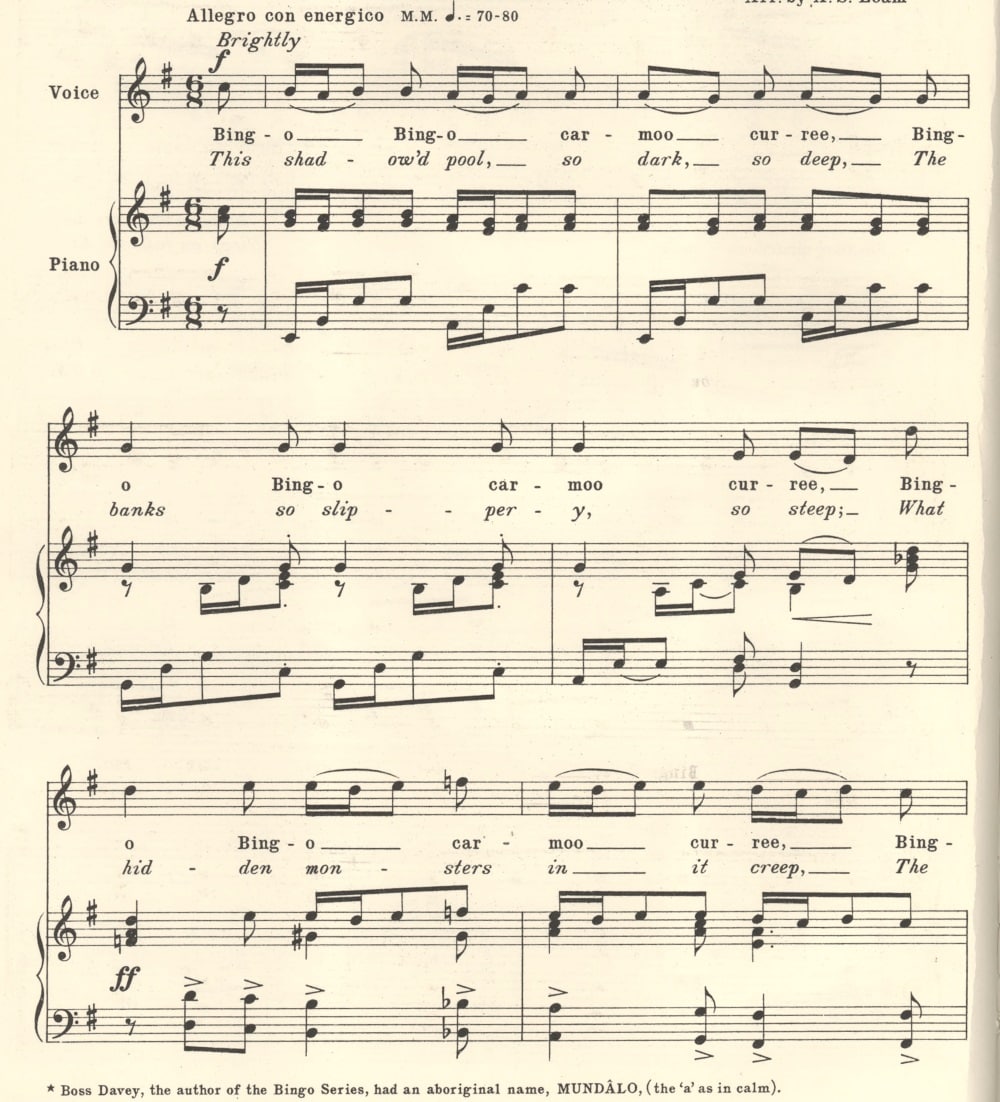
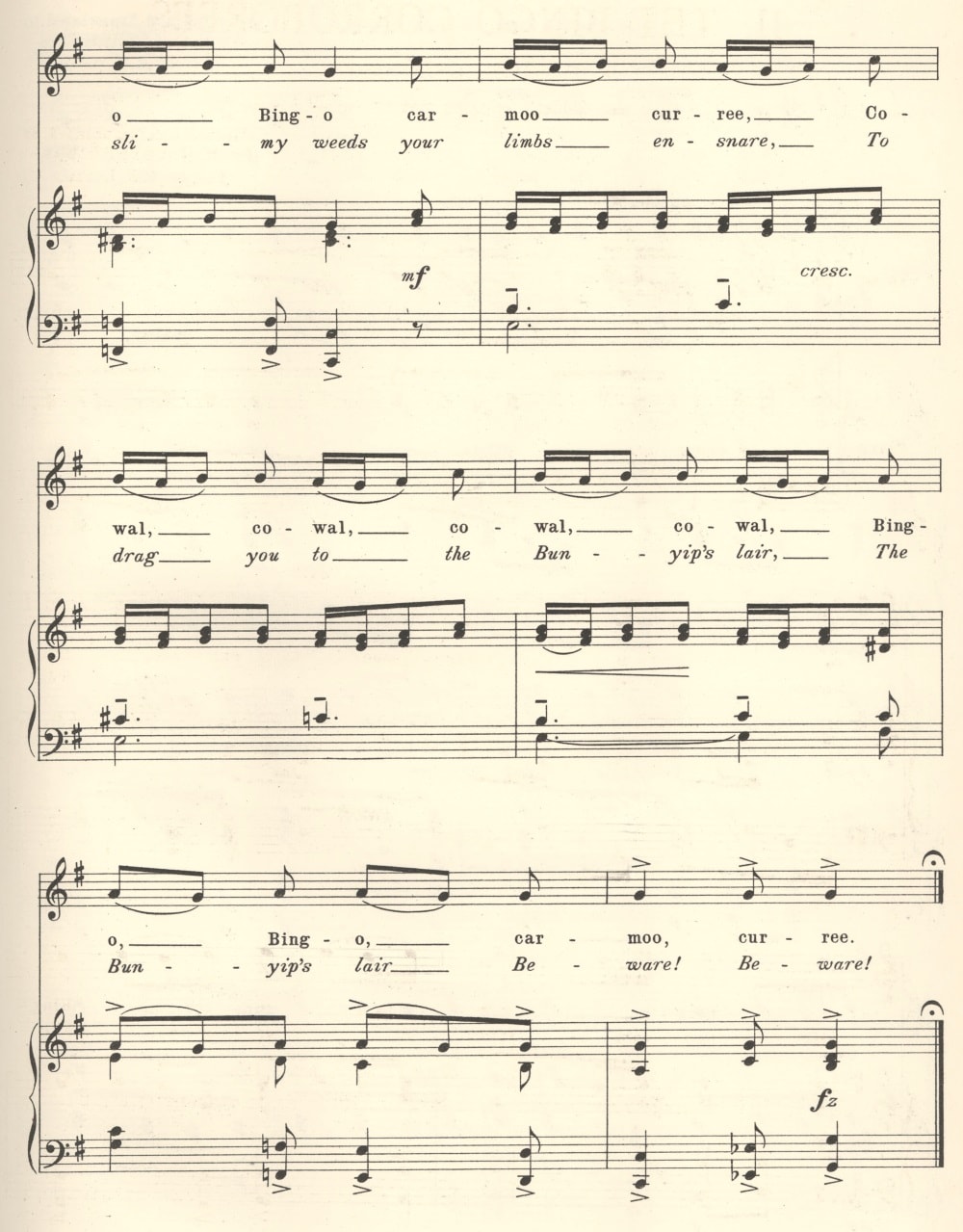
[2] (a) BINGO-BINGO. This is a warning to a youth against bathing in a water-hole at the junction of Bailey's Creek with the Maranoa River. This water-hole was inhabited by a Bunyip.
[4] Bingo bingo carmoo curree
Bingo carmoo curree
Bingo carmoo curree
Bingo carmoo curree
Cowal cowal cowal cowal
Bingo carmoo curree.
This shadow'd pool, so dark, so deep,
The banks so slippery, so steep;
What hidden monsters in it creep,
The slimy weeds your limbs ensnare,
To drag you to the Bunyip's lair,
The Bunyip's lair, Beware! Beware!
27.2b "II. Bingo corroborees: (b) The porcupine song"
text: Wangur dthunnee dthunee dthunee . . . Goolgoo boora goolgoo boora goolgoo boora . . .
gloss: "The droll behaviour of the [ECHIDNA] never failed to fill these simple-minded and altogether delightful children of nature with uncontrollable laughter. Wai! and Yakai! are words of exclamation."
analytics: As for 27.1
[2] (b) THE PORCUPINE SONG. The droll behaviour of the ECHIDNA never failed to fill these simple-minded and altogether delightful children of nature with uncontrollable laughter. Wai! and Yakai! are words of exclamation.
Lethbridge and Loam, Australian aboriginal songs, 8-9
http://nla.gov.au/nla.obj-172234124/view#page/n8/mode/1up (DIGITISED)
[8] Wangur dthunnee dthunee dthunee
Wangur dthunnee dthunee dthunee
Wangur dthunnee dthunee dthunee
Goolgoo boora goolgoo boora goolgoo boora
Wangur dthunnee dthunee dthunee
Old porcupine with stately stride
Is out to see where ants may hide,
To know his track you cannot fail,
The toe-holes deep, the dragging tail,
We touch with him our Yamstick, wai!
He's now a spiky ball, Yakai!
27.2c "II. Bingo corroborees: (c) The blind blackfellow"
text: Ngunee ngunee dthara goon doo . . . Ngia ngia ngian ngia . . .
gloss: "A blind blackfellow finding his way back to camp" ("The performers in this Corroboree, coming forward to the cleared ground (stage) lit by a semicircle of fires, would imitate the movements of a blind man endeavouring to cross a gully. The orchestra - gins, piccaninnies and non-performers would sing the melody whilst the performers would maintain perfect rhythm and graceful poise.")
analytics: (as for 27.1)
[2] (c) THE BLIND BLACKFELLOW. The performers in this Corroboree, coming forward to the cleared ground (Stage) lit by a semicircle of fires, would imitate the hesitating movements of a blind man endeavouring to cross a gully. The orchestra - gins, piccaninies and non-performers would sing the melody, whilst the performers would maintain perfect rhythm and graceful poise.
Lethbridge and Loam, Australian aboriginal songs, 9
http://nla.gov.au/nla.obj-172234124/view#page/n9/mode/1up (DIGITISED)
[9] Ngunee ngunee dthara goon doo
Ngunee ngunee dthara goon doo
Ngunee ngunee dthara goon doo
Ngunee ngunee dthara goon doo
Ngia ngia ngian ngia
Ngunee ngunee dthara goon doo
I left the camp so brave today
Now home I cannot find my way
I'm blind, I'm blind my poor old eyes,
A swollen stream before me lies
I hear the torrent dark and deep,
Ya-kai! In darkness must I leap.
27.3 Meen guttee galina
27.3 "III. A Warrego lament"
text: Meen gutte meen galina yarin ja ya reen yer mo dtharrbinga buthee marber go thun bin a yun ga ween jin ah! ween jin ah! been a guttee booki yaka!
gloss: "It is the anguished cry of a doomed race - stricken by disease brought by the invading white man." ("Introduced from the Warrego Tribe.")
analytics: Warrego district, south central QLD (region); YCA (music region); Northern PN/ Maric/ ? Pirriya (language)
[2] A WARREGO LAMENT. Introduced from the Warrego Tribe. It is the anguished cry of a doomed race - stricken by disease brought by the invading white man.
Lethbridge and Loam, Australian aboriginal songs, 10-11
http://nla.gov.au/nla.obj-172234124/view#page/n10/mode/1up (DIGITISED)
The complete musical and linguistic content of the source song appears in the 15 bars of the vocal line only in the pictured extract below.
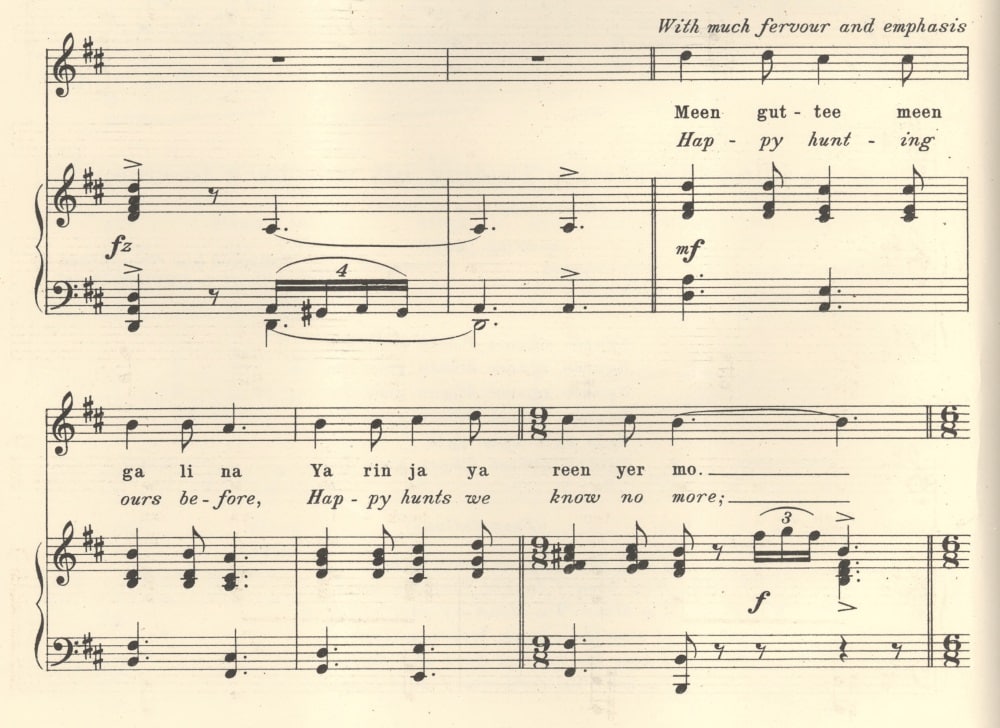
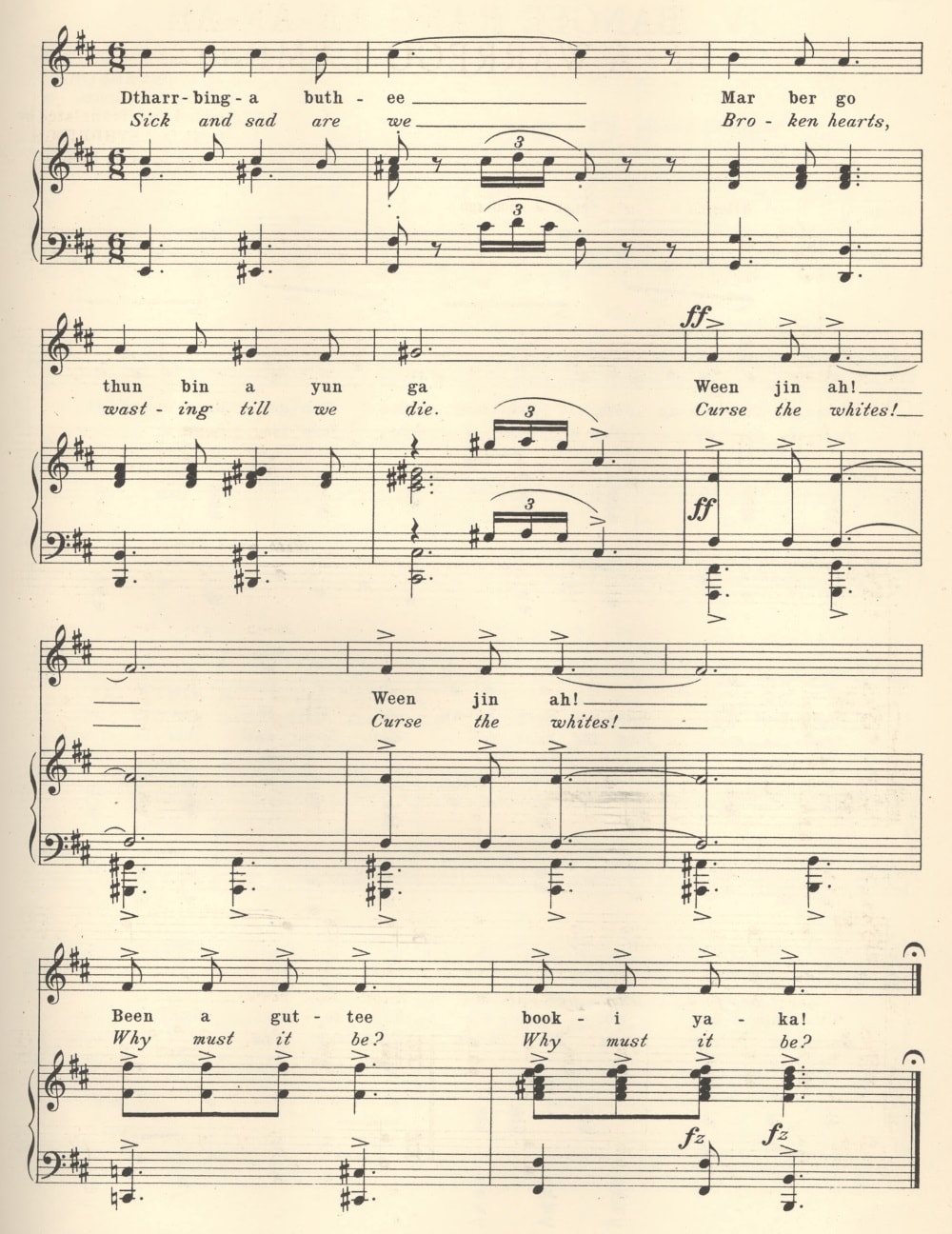
[10] Meen gutte meen galina
Yarin ja ya reen yer mo.
Dtharrbinga buthee
Marber go thun bin a yun ga
Ween jin ah! Ween jin ah!
Been a guttee booki yaka!
Happy hunting ours before,
Happy hunts we know no more:
Sick and sad are we
Broken hearts wasting till we die,
Curse the whites! Curse the whites!
Why must it be? Why must it be?
27.4 Bangee rang ananah
27.4 "IV. Bangee rang ananah"
text: Bangee rang anan-ah dthiblurrah bangee rang anan-ah dthiblurrah bangee rang anan-ah willy nurry no urmunday wowowo injiaco mookooloo dthoorroo wookoonin
gloss: "A Hunting Song"
analytics: As for 27.1
[2] IV. BANGEE RANG AN-AH-AH (the G is soft). A Hunting Song
Lethbridge and Loam, Australian aboriginal songs, 12-13
http://nla.gov.au/nla.obj-172234124/view#page/n12/mode/1up (DIGITISED)
The complete musical and linguistic content of the source song appears in the first 14 bars of the vocal line only in the pictured extract below.
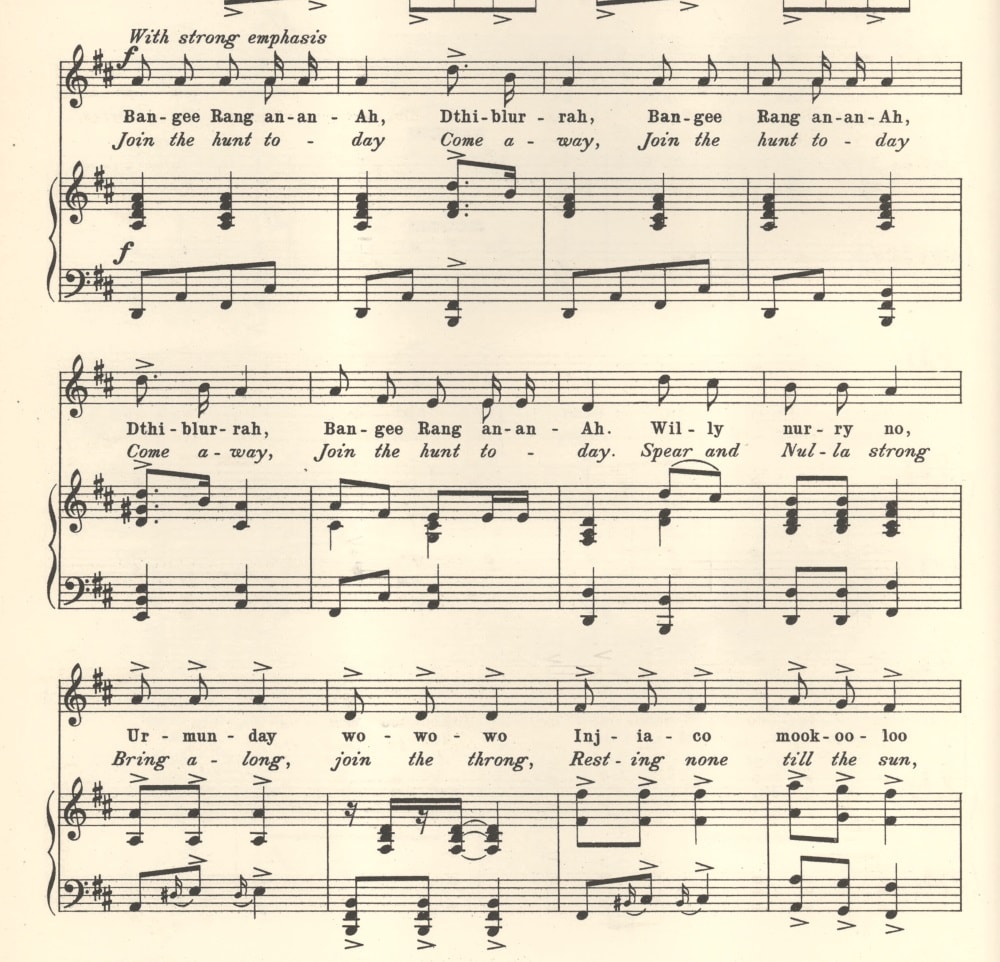

[12] Bangee Rang anan-Ah Dthiblurrah
Bangee Rang anan-Ah Dthiblurrah
Bangee Rang anan-Ah Willy nurry no
Urmunday wowowo injiaco mookooloo
Dthoorroo wookoonin.
Join the hunt today, Come away,
Join the hunt today, Come away,
Join the hunt today, Spear and Nulla strong,
Bring along, join the throng,
Resting none till the sun sleeps to end the day.
27.7 Jabbin jabbin
27.5 "V. Jabbin jabbin"
text: Jabbin jabbin kirroo kagla kurra kurra kirroo ka jabbin jabbin kirroo ka
gloss: "This is not a corroboree. It is a song sung round the camp fire."
analytics: As for 27.1
[2] JABBIN JABBIN. This is not a corroboree. It is a song sung round the camp fire. The aborigines would be sitting on the ground and one would start. They would all join in singing the melody only, beating time with their hands or with boomerangs and even, at times, the infant's tummy would serve as an impromptu drum beaten p not ff.
Lethbridge and Loam, Australian aboriginal songs, 14-15
http://nla.gov.au/nla.obj-172234124/view#page/n15/mode/1up (DIGITISED)
The complete musical and linguistic content of the source song appears in the first 12 bars of the vocal line only in the pictured extract below.
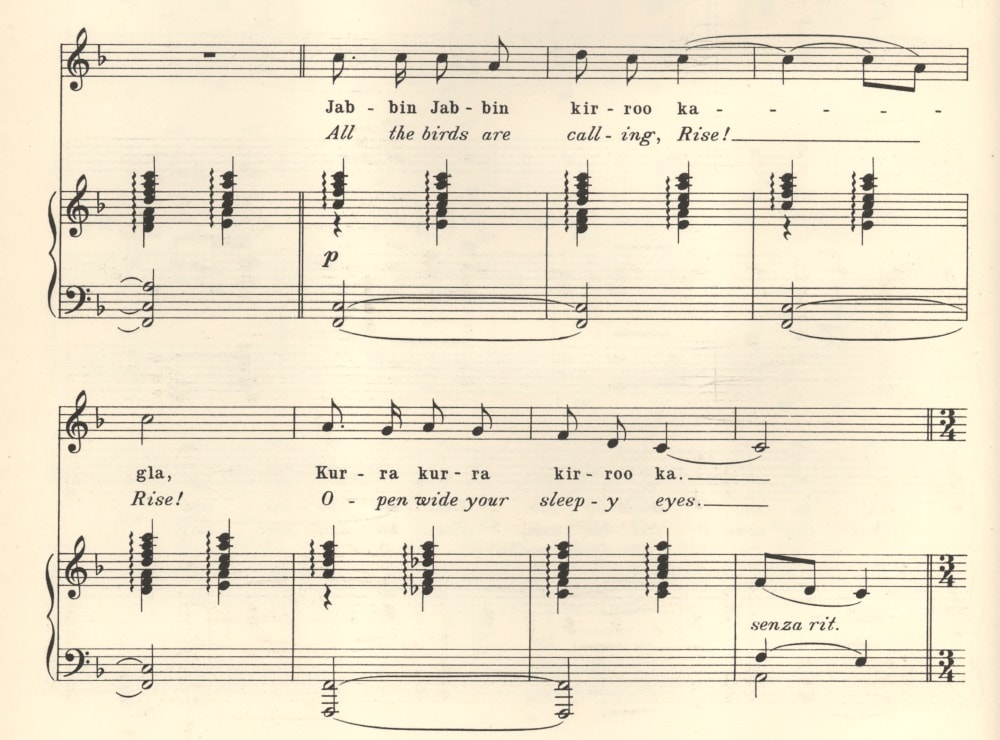

[14] Jabbin Jabbin kirroo kagla
Kurra kurra kirroo ka.
Jabbin Jabbin kirroo ka.
All the birds are calling, Rise!
Rise, open wide your sleepy eyes.
All the birds are calling, Rise!
Documentation:
"Aboriginal Songs", Narandera Argus and Riverina Advertiser (6 April 1937), 1
http://nla.gov.au/nla.news-article100804453
"ABORIGINAL SONGS", The Independent (9 April 1937), 3
http://nla.gov.au/nla.news-article130217175
ABORIGINAL SONGS. DR. LETHBRIDGE'S COLLECTION. We reprint the folowing from the Sun News-Pictorial, Melbourne, of April 3.:
One night not so long ago Dr. H. O. Lethbridge, of Narandera, played a little tune on the piano, and his friend, Mr. A. S. Loam, who teaches music, said "I like that very much. What is it!" It was an aborigines' song that Dr. Lethbridge had heard the Maranoa natives sing in the days when he played, and hunted with them on his father's station in western Queensland, about 50 years ago. And now that song, with others, is said to be the first collection of genuine aboriginal music in the Empire.
There have been other collections, but they have hot been the untouched native tunes. They have been changed and elaborated. But Dr. Lethbridge and Mr. Loam have left the aborigines' songs just as Dr. Lethbridge heard them sung - and sung them with the natives - in the eighties.
"I remember them all very clearly." Dr. Lethbridge said when he was in Melbourne the other day. "Even most of the words. I have translated the words to give the spirit and the sense of the songs. Some of the songs were handed down among the blacks from generation to generation. They were so old that even those who sung them could not translate them literally into the language of their tribe."
"Miss Essie Ackland sang one of them over the air from Brisbane the other night, and will probably sing more of them. She has said she likes them very much.
The collection includes a lullaby which native mothers must have chanted to their babies over hundreds of years ago as they rocked the bark cradles with their feet. There is a lament, the anguished cry of a race stricken with disease, brought by the white man; and the Bangee Rang, a hunting song, which the blacks used to sing to the beat of clashing boomerangs.
There is also a series of corroboree songs, composed in the eighties, Dr. Lethbridge said, by a black called Boss Davey. And finally, there is the jabin jabin, a sort of reveille. This was the one Miss Ackland sang the other night.
"The words, rhythm, melody and tempo of the songs are just as the natives sang them," said Dr. Lethbridge. They have been given accompaniments by Mr. Loam. Perhaps they will form the beginning of an Australian folk music. - J. D.
"Native Song by Essie Ackland", Narandera Argus and Riverina Advertiser (18 June 1937), 2
http://nla.gov.au/nla.news-article100806925
An Australian aboriginal song called "Jabbin Jabbin," was sung by Miss Essie Ackland, the noted Australian contralto, during her recital from 3AR on Tuesday night The songs of aborigines do not usually attract the interest of distinguished artists, but Miss Ackland sang "Jabbin Jabbin" in Western Australia recently, and while travelling eastward on the transcontinental train had a unique opportunity to test her powers as an interpreter. The train pulled up for a short while, and several blacks approached. Miss Ackland sang to them "Jabbin Jabbin" and there was a happy response, though the song did not originate in their tribe. "Jabbin Jabbin" was collected by Mrs. F. J. Murphy, in the Maranoa district of Queensland, translated by Dr. H. O. Lethbridge, and arranged by Mr. A. S. Loam. It begins with the words, "All the Birds are calling, rise!"
"ABORIGINAL SONGS. A Valuable Collection", "Aboriginal songs explained (By H. O. Lethbridge)", The Australian Musical News (1 July 1937), 22
Very little indeed has been done by those engaged in music in Australia to collect and preserve the songs of the Aborigines.
. . . Aboriginal Songs Explained (By H.O. Lethbridge)
Station life in Western Queensland in the 80's was very different from present conditions. No wireless - no cars, we lived a life centred round our own home. My father always liked the blacks and they would do anything for him. As boys they were our playmates - we used to hunt with them and eat witchetty grubs with them. We knew their language and sang their songs and even learnt their corroborees.
A love of music and a retentive memory have given me the opportunity of knowing these songs still. I can therefore speak truth when I say the words, rhythm, melody and tempo of these songs is as they sang them and absolutely unaltered. Therein lies their value. Arthur Loam, my "Digger" friend and the pianist and conductor of our small orchestra, has brought back some corroborees and their songs from Alice Springs. These he had cleverly orchestrated and we played them with great success. This gave me the idea of collecting those I knew before it was too late. Arthur Loam has written the accompaniments and we have adhered strictly to the original songs.
The translation is free but correct as far as one's memory can go. Some of these songs have been handed down for such a length of time that even the singers did not know the literal translation, although they knew what they were about. How many readers know their own English in "widu wintrum geong wordum maelde" or
"Awe bleteth after lomb
Lhouth after calve cu;
Bullock sterteth, bucke verteth,
Murie sing, cuccu." ?
l. Maranoa Lullaby. I cannot tell how old this is. The mothers, for probably generations, had rocked their babies by pushing on the bark cradle with their feet.
2. The Warrego Lament. Is the anguished cry of a race who finds itself stricken with disease introduced by the invading white man.
3. Bangee Rang. This is a very old song and although I know it is a hunting song I cannot vouch for the literal translation.
4. The Bingo Series. These I know well. They were the result of a renaissance in music that occurred among the Maranoa Tribe in the 80's. I knew the composer, one Boss Davey. I saw these corroborees night after night and we sang them with ' the blacks. The translation is quite correct in meaning.
5. Jabbin Jabbin. My sister, Mrs. Murphy, who now lives at Gregory Springs in the Gulf Country, North Queensland, has recently been staying with me at Narrandera. She reminded me of this one which I had forgotten. She asked me whether I could remember sitting on the "wood-heap" with the blacks singing this. To her I am indebted for the rescue from oblivion of this altogether delightful melody. Although we cannot vouch for the literal translation, yet we believe it to be a reveille.
Bibliography:
Bill Casey, "Modernity denied: the case of Harold Blair's 1956 EP, Australian Aboriginal Songs", in Robert Dixon and Veronica Kelly (eds), Impact of the modern: vernacular modernities in Australia 1870s-1960s (Sydney: Sydney University Press, 2008), 52-61
https://books.google.com.au/books?id=tB5VcdRYu8oC&pg=PA52 (PREVIEW)
Skinner 2017
Skinner and Wafer 2017
References:
Mitchell Police Letterbook 1889-1921; QS 636/1 (3) and (11), Queensland State Archives
http://www.cifhs.com/qldrecords/qldmitchell.html
[undated, c.1904] List of Aborigines at Forest Vale
Davey, Male, 50years, F/B, [works at] Scalping
30 September 1914. The following two old Aborigines are camped near Forest Vale Station, namely Boss Davey [and] Possum Peter
23 October 1914. The following are to be removed to Taroom Aboriginal Settlement from Forest Vale Stn. Boss Davey [and] Possum Peter
Chief Protector of Aborigines, Register of Aboriginal Deaths 1910-1928, A/58973, Queensland State Archives
http://www.cifhs.com/qldrecords/A58973_Qld_Deaths_1910_1928.html
25 March 1916, Boss Davey, Full blood, Senile decay, Taroom
"BIRTHS", Australian Town and Country Journal (14 February 1880), 42
http://nla.gov.au/nla.news-article70941016
Harold Octavius Lethbridge, Brisbane, c.1898 (State Library of Queensland)
http://hdl.handle.net/10462/deriv/112964 (IMAGE)
[Advertisement], The Argus (12 June 1937), 26 Supplement
http://nla.gov.au/nla.news-article11071509
"THE BEAUTIES OF MUSIC", The Murrumbidgee Irrigator (1 July 1938), 5
http://nla.gov.au/nla.news-article156146819
"ENTERTAINMENT AT LEETON", Daily Advertiser (8 November 1938), 5
http://nla.gov.au/nla.news-article143854786
"DEATHS", The Sydney Morning Herald (6 November 1944), 10
http://nla.gov.au/nla.news-article17926614
"OBITUARY", Narandera Argus and Riverina Advertiser (7 November 1944), 2
http://nla.gov.au/nla.news-article101537718
https://trove.nla.gov.au/search/category/newspapers?l-publictag=Harold+Octavius+Lethbridge (TROVE public tag)
https://trove.nla.gov.au/search?l-publictag=Australian+Aboriginal+Songs (TROVE public tag)
http://www.austlit.edu.au/austlit/page/A119520 (Austlit)
Other resources:
Arthur S. Loam, Maranoa fantasy for piano on an Australian Aboriginal theme (Melbourne: Allan & Co., 1938)
https://trove.nla.gov.au/version/22674289
http://nla.gov.au/nla.obj-171328261 (DIGITISED)
c.1893
28 4 songs
Nyungar, Gingin and South-west region, WA
Music and words transcribed and sent to A. F. Calvert (1872-1946) by an unidentified reporter, by c.1893; published 1894
https://sydney.edu.au/paradisec/australharmony/checklist-indigenous-music-1.php#028 (shareable link to this entry)
Source:
Albert F. Calvert, The Aborigines of Western Australia (London: W. Milligan and Co., 1894), 34-38
https://archive.org/stream/aboriginesofwest00calv#page/35/mode/2up (DIGITISED)
28.1 Wilbeniah
28.1 "During the ceremony of presentation . . . song" [Calvert 1]
text: Wilbeniah yandiwirrie . . . [words repeated and alternated]
gloss: "Some time ago . . . one of the white colonists, held in high esteem by one of the native tribes near Guigin, was presented by them with what may be best described as 'tribal rights' (corresponding to citizenship) over certain lands. During the ceremony of presentation was sung the following song, and it may be explained that 'Wilbeniah' was the name of the land, and 'Yandiwirrie' the name by which the natives knew their friend. When they sand the first word they pointed to the land, and when they sang the second they pointed to the adopted tribesman, indicating by this probably that the land was his, and that he belonged to the land" (Calvert 1892, 34-35)
analytics: South-west region, WA (region); CA (music region); Western PN/ Nyungar/ Nyungar (language)
Calvert 1894, 34-35 (music and commentary)
https://archive.org/stream/aboriginesofwest00calv#page/35/mode/2up (DIGITISED)
[34] But while it is difficult to describe the music so as to convey anything like an adequate idea of its effect, especially as many of their songs are simply deep guttural unmusical notes, it is within my power to give to the public the "words and music" of several of their more melodious songs. These have been supplied to me by a resident in Western Australia, who has also appended to each a few remarks as to the circumstances under which they were sung.
"Some time ago," he says, "one of the white colonists, held in high esteem by one of the native tribes near Guigin [recte ? Gingin], was presented by them with what may be best described as "tribal rights" (corresponding to citizenship) over certain lands. During the ceremony of presentation was sung the following song, and it may be explained that "Wilbeniah" was the name of the land [35] and "Yandiwirrie" the name by which the natives knew their friend. When they sang the first word they pointed to the land, and when they sang the second they pointed to the adopted tribesman, indicating by this probably, that the land was his, and that he belonged to the land."
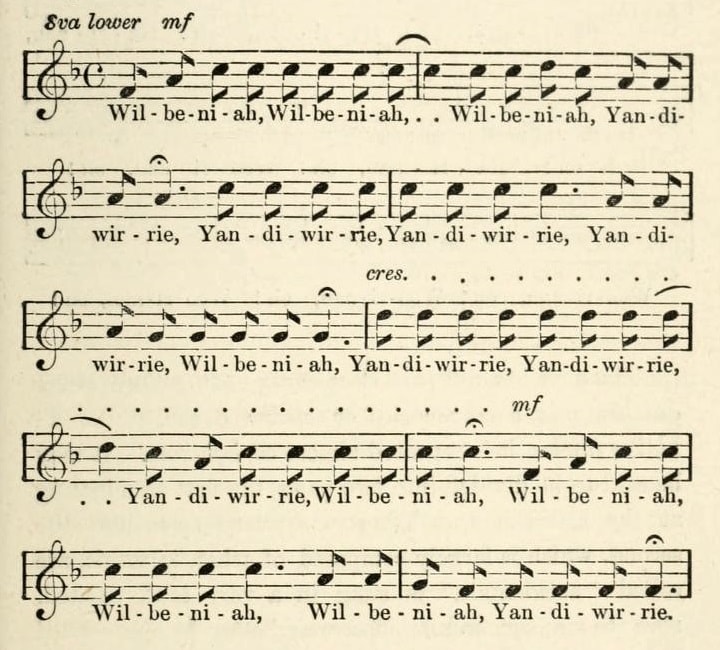
Wilbeniah, Wilbeniah, Wilbeniah, Yandi-
wirrie, yandiwirrie, Yandiwirrie, Yandi-
wirrie, Wilbeniah, Yandiwirrie, Yandiwirrie,
Yandiwirrie, Wilbeniah, Wilbeniah,
Wilbeniah, Wilbeniah, Yandiwirrie.
28.2 Harinan oh!
28.2 "After the marriage . . . [song]" [Calvert 2]
text: Harinan oh! harinan oh! . . . woorinan oh! woorinan oh! . . .
gloss: "Two natives were married . . . After the marriage, a party of natives, male and female, belonging to their tribe gathered round the fire in front of their hut and sang the following measure, scores of times: 'Harinan' was the name of the Benedict, and 'Woorinan' that of his Beatrice" (Calvert 1892, 35-36)
analytics: As for 28.1
Calvert 1894, 35-36 (music and commentary)
https://archive.org/stream/aboriginesofwest00calv#page/35/mode/2up (DIGITISED)
Two natives were married, and, which is not always the case, both parties were great favourites, and wonderful to relate very young. After the marriage, a party of natives, male and female, belonging to their tribe gathered round the fire in front of their hut and sang the following measure, scores of times: "Harinan" was the name of the Benedict, and "Woorinan" that of his Beatrice. The air is not unmusical, and the men's voices blended with those of the women very effectively."
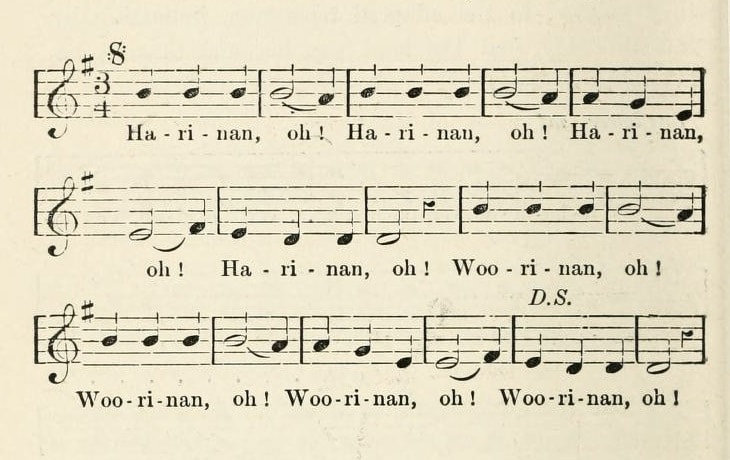
Harinan, oh! Harinan, oh! Harinan,
oh! Harinan, oh! Woorinan, oh! Woorinan, oh!
Woorinan, oh! Woorinan, oh! Woorinan, oh!
28.3 Ah barrabahndidurrah
28.3 "Corroborie" [Calvert 3]
text: Ah barrabahnddurrah birrin goorah ah [repeated six times] barrabahndidurrah birringoorah ah, barrabahndidurrah! ah barrabahndidurrah! ah, barrabahndidurrah! birringoorah ah! [Da capo]
gloss: "sung at a corroborie, or native dance . . . What the words mean I was never able to learn" Calvert 1892, 36)
analytics: As for 28.1
Calvert 1894, 36-37 (music and commentary)
https://archive.org/stream/aboriginesofwest00calv#page/36/mode/2up (DIGITISED)
The next is a different class of song altogether, being one sung at a corroborie, or native dance. Like all native ditties, it is repeated almost ad infinitum. It may be said to be divided into two parts, the first terminating at the asterisk, and being sung very smoothly - the second, which is largely composed of what, in music, are called "accidentals," is sung in a very loud excited, staccato manner, and its effect may better be appreciated by the singer speaking the notes rather than singing them. What the words mean I was never able to learn. No inducement was potent enough to win from my black friends even the faintest hint as to the meaning of the song. They merely laughed, and said, "nothing tell 'em." I am, therefore, unable to furnish a translation."
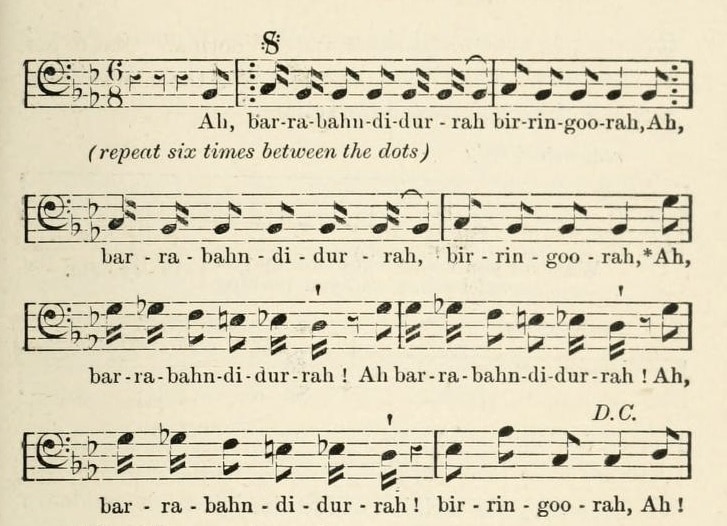
Ah, barrabahnddurrah birrin goorah, Ah,
(repeat six times between the dots)
barrabahndidurrah, birringoorah, * ah,
barrabahndidurrah! Ah barrabahndidurrah! Ah,
barrabahndidurrah! birringoorah. Ah! D.C. [Da capo]
28.4 What for you white fellow wongy
28.4 "Recitative" [Calvert 4]
text: What for your white fellow wongy you gib'em chickpence and you nothing giberem poor old debbil me poor granny me me nothing nalgo and want'em bread and you big fellow lie tell'em
gloss: "'Wongy' means 'say' or 'promise,' and that I had promised her something was one of her pleasant little fictions" Calvert 1892, 38)
analytics: As for 28.1
Calvert 1894, 37-38 (music and commentary)
https://archive.org/stream/aboriginesofwest00calv#page/36/mode/2up (DIGITISED)
The Western Australian aboriginal does not sing in his own language only, nor does he sing only when he is pleased. I have seen two native women fight with their long, thick, hard wood staffs, accompanying their thwackings with songs in which they alternately cursed and derided each other in the choicest English and native Billingsgate. Indeed, it may be said that whatever passion or feeling seizes them, the black fellow must express it in song, and this leads, of course, to the improvising of such as the following recitative which was the result of a refusal to give a notoriously drunken, lazy native woman sixpence to enable her to indulge her propensity by drinking. She professed to be hungry and to want nalgo (food), but she had at that time sufficient food in the bag slung at her back to feed her for a week. Finding her entreaties were unavailing, she sang the [38] following to me several times - "Wongy" means "say" or "promise," and that I had promised her something was one of her pleasant little fictions."
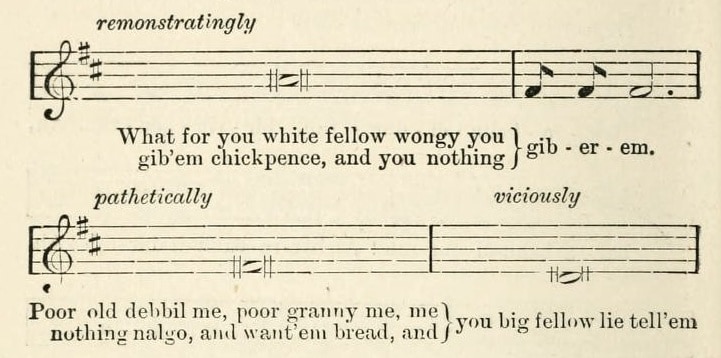
What for your white fellow wongy you gib'em chickpence, and you nothing giberem.
Poor old debbil me, poor granny me, me nothing nalgo, and want'em bread, and you big fellow lie tell'em.
Bibliography:
Albert F. Calvert, The Aborigines of Western Australia (London: W. Milligan and Co., 1892)
https://archive.org/details/aboriginesofwest00calvuoft
Earlier version of Calvert 1894, without reference to the songs
Robyn Ryan, "Peoples of the southwest" (in "Aboriginal traditions"), in John Whiteoak and Aline Scott-Maxwell (eds), Currency companion to music and dance in Australia (Sydney: Currency House, 2003), 32
https://trove.nla.gov.au/work/22233842
Clint Bracknell, "Kooral Dwonk-katitjiny (listening to the past): Aboriginal language, songs and history in south-western Australia", Aboriginal History 38 (2014), 1-19
http://press.anu.edu.au/apps/bookworm/view/Aboriginal+History,+Volume+38,+2014/11431/Text/ch01.xhtml (DIGITISED)
Skinner and Wafer 2017
c. 1895 (possibly much earlier)
29 1 song
Waka-Kabic, Burnett River, QLD
Music transcription only, ? collected and transcribed by or for Charles Handley, possibly much earlier than the publication date of 1897
https://sydney.edu.au/paradisec/australharmony/checklist-indigenous-music-1.php#029 (shareable link to this entry)
Burnett River corroboree
29 Burnett River corroboree
text/gloss: music only
analytics: Burnett River, QLD (region); YCA (music region); South-eastern PN/ Waka-Kabic/ ? Gureng Gureng (language)
Source:
[Communication], The Journal of the Anthropological Institute of Great Britain and Ireland 26 (1897), 436
http://www.jstor.org/stable/2842015 (DIGITISED)
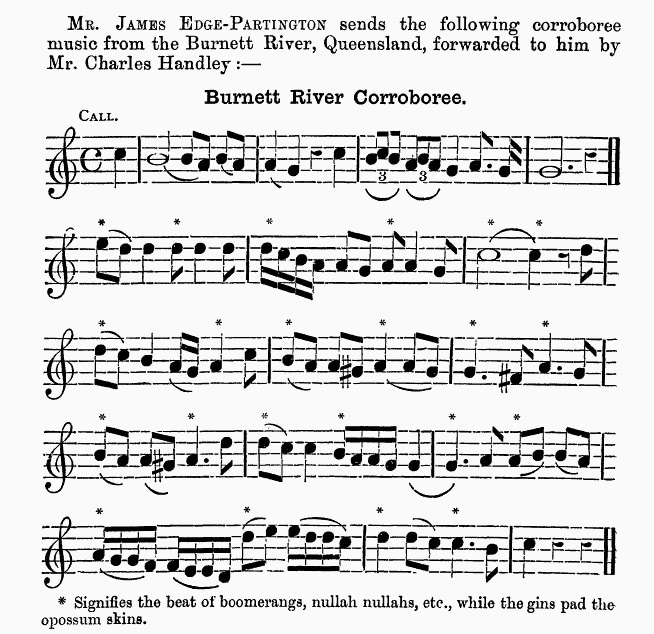
MR. JAMES EDGE-PARTINGTON sends the following corroboree music from the Burnett River, Queensland, forwarded to him by Mr. Charles Handley:
[MUSIC]
* Signifies the beat of boomerangs, nullah nullahs, etc., while the gins pad the opossum skins.
Select bibliography:
Nicole Saintilan, "Music - if so it may be called": perception and response in the documentation of Aboriginal music in nineteenth century Australia (M.Mus thesis, University of New South Wales, 1993), 78-79
http://hdl.handle.net/1959.4/50383 (DIGITISED)
Skinner and Wafer 2017
1898
30 28 songs
Meriam Mir (and possibly Torres Strait Creole), Murray Island (Eastern Torres Strait)
Sound recordings by Charles Samuel Myers (1873-1946), collected 1898
Text transcriptions by Alfred Cort Haddon (1855-1940) and Sidney Herbert Ray (1858-1939)
Musical transcriptions by Charles Myers; first published 1908 and 1912
Western Torres Strait dialects ("Mabuiagic"), such as Kala Lagaw Ya, Western Torres Strait Islands (Mabuiag, Yam, and Saibai)
Sound recordings and text transcriptions and glosses by Sidney Ray, 1898
Musical transcriptions by Charles Myers, published 1912
https://sydney.edu.au/paradisec/australharmony/checklist-indigenous-music-1.php#029 (shareable link to this entry)
We were working on the revised and updated version of this entry on 29 June 2016, which would have been the 80th birthday of Eddie Mabo (1936-1992), to whose memory we respectfully dedicate it.

A screenshot of the Google search doodle for 29 June 2016 depicting Torres Strait Islander Eddie Mabo on what would have been his 80th birthday. Photograph: Google
18 Eastern Islands songs
30.1-4A 4 Malu songs
The recordings appear to correspond to the transcriptions as follows (Moyle 1985, 54-55; updated 2016)
I Malu
= A11 (C80/1020) and
= C109 (C80/1020) = 30.1
II Malu = A5, A9, C108 [unstreamed] = 30.2
III Malu = A3 [unstreamed],
= C106 (C80/1099),
= C107 [unstreamed], and
= C113 (C80/1105) = 30.3
IV Malu IV = [unidentified]
IVA = A7 (C80/1016),
= C104 (C80/1096),
= A4, A10, C14, C103, C105, C105A [unstreamed] = 30.4
30.1 Malu song (1) (Funeral song 1)
30.1 "Malu songs I"
text: Wau aka o adet Maluet e padet emarar
gloss: Yea why O holy one Malu at the creek sways
analytics: Murray Island, Eastern Torres Strait (region); TSI (music region); Papuan/ Miriamic/ Meriam Mir (language)
Torres Strait cylinder A11 (Frazer No. 45), C80/1020 (recordist Charles Myers); Myers Song I Malu; 1 male vocal solo, accompanied by percussion; inscription on cylinder insert notes (now no longer available): "Emarer A" (streamed by British Library)
http://sounds.bl.uk/World-and-traditional-music/Ethnographic-wax-cylinders/025M-C0080X1020XX-0100V0 (STREAMED SOUND)
Torres Strait, cylinder C109, C80/1103; Myers Song 1 Mala (Funeral Song 1); male vocal solo (probably voice of Charles Myers), with percussion accompaniment; inscription on insert notes (now no longer available): "Murray I / Emarer / OV [own voice]" (streamed by British Library)
http://sounds.bl.uk/World-and-traditional-music/Ethnographic-wax-cylinders/025M-C0080X1103XX-0100V0 (STREAMED SOUND)
Myers and Haddon, "Funeral ceremonies", in Haddon 1901-35, volume 6 (1908), 150-51 (music and words)
https://archive.org/stream/reports190806cambuoft#page/150/mode/2up (DIGITISED)
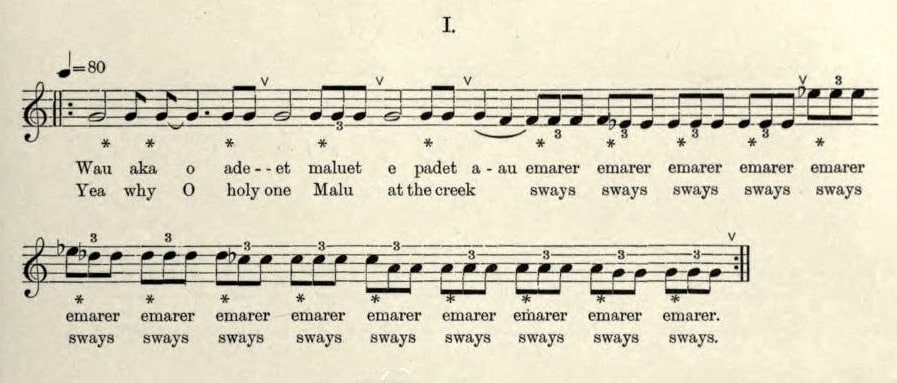
Myers, "Music", in Haddon 1901-35, volume 4 (1912), 244 (music)
https://archive.org/stream/reports191204cambuoft#page/244/mode/2up (DIGITISED)

Myers, "Music", in Haddon 1901-35, volume 4 (1912), 266 (words)
https://archive.org/stream/reports191204cambuoft#page/266/mode/2up (DIGITISED)
Myers, "Music", in Haddon 1901-35, volume 4 (1912), 247 (commentary)
https://archive.org/stream/reports191204cambuoft#page/247/mode/2up (DIGITISED)
C. S. Myers, "The study of primitive music", The Musical Antiquary 3 (1912), 124 (music and words)
https://babel.hathitrust.org/cgi/pt?id=hvd.32044043850981;view=1up;seq=132 (DIGITISED)

30.2 Malu song (2) (Funeral song 2)
30.2 "Malu songs II"
text: Wau o weluba o lewerlewer o meriba tamera
gloss: Yea O pigeon's feather O food our Malu's club
analytics: As for 30.1
Myers and Haddon, "Funeral ceremonies", in Haddon 1901-35, volume 6 (1908), 151 (music and words)
https://archive.org/stream/reports190806cambuoft#page/151/mode/2up (DIGITISED)
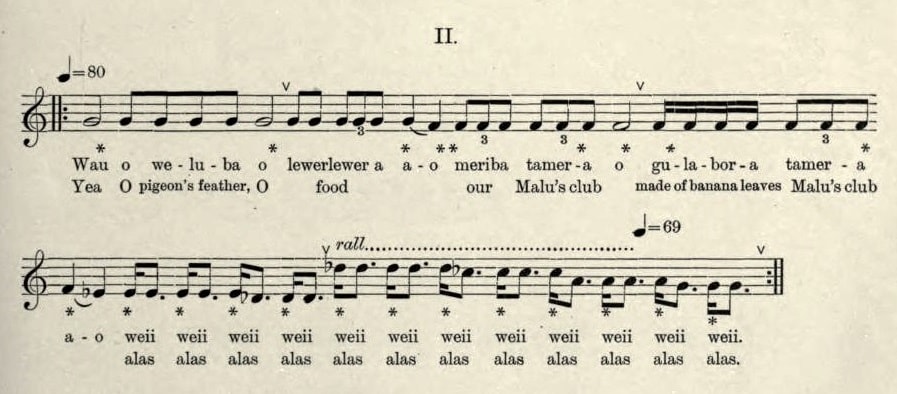
Myers, "Music", in Haddon 1901-35, volume 4 (1912), 244 (music)
https://archive.org/stream/reports191204cambuoft#page/244/mode/2up (DIGITISED)

Myers, "Music", in Haddon 1901-35, volume 4 (1912), 266 (words)
https://archive.org/stream/reports191204cambuoft#page/266/mode/2up (DIGITISED)
Myers, "Music", in Haddon 1901-35, volume 4 (1912), 247-48 (commentary)
https://archive.org/stream/reports191204cambuoft#page/247/mode/2up (DIGITISED)
Myers, "The study of primitive music", 124 (music and words)
https://babel.hathitrust.org/cgi/pt?id=hvd.32044043850981;view=1up;seq=132 (DIGITISED)

30.3 Malu song (3) (Funeral song 3)
30.3 "Malu songs III"
text: Wau Izib eiriam, wau Izibe dirker ewatur
gloss: Yea Izib ye two drink, Yea Izib he sinks it pulls him down
analytics: As for 30.1
Torres Strait cylinder C106, C80/1099; Myers Song III Malu; unaccompanied male vocal solo; transcription on cylinder insert notes (now no longer available): "Izib A" (streamed at British Library)
http://sounds.bl.uk/World-and-traditional-music/Ethnographic-wax-cylinders/025M-C0080X1099XX-0100V0 (STREAMED SOUND)
Torres Strait cylinder C113 (Frazer No. 113), C80/1105; male vocal solo (probably the voice of Charles Myers), unaccompanied; inscription on insert notes (now no longer available): "Song III: Malu / Iriam / own [probably meaning own voice]" (streamed at British Library)
http://sounds.bl.uk/World-and-traditional-music/Ethnographic-wax-cylinders/025M-C0080X1105XX-0100V0 (STREAMED SOUND)
Myers and Haddon, "Funeral ceremonies", in Haddon 1901-35, volume 6 (1908), 151 (music and words)
https://archive.org/stream/reports190806cambuoft#page/151/mode/2up (DIGITISED)
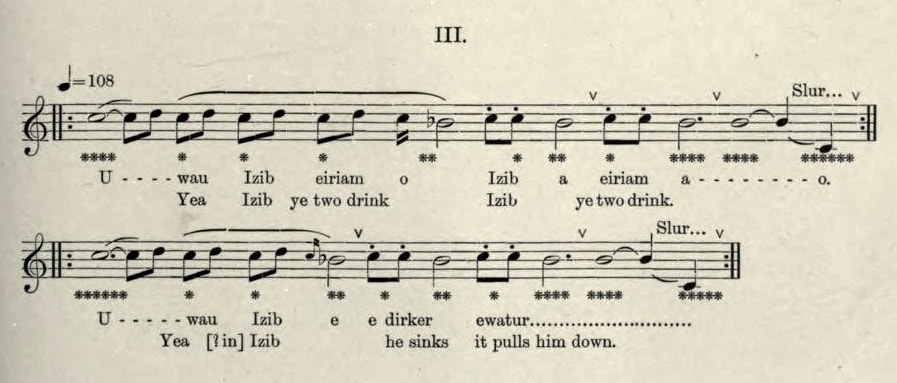
Myers, "Music", in Haddon 1901-35, volume 4 (1912), 244 (music)
https://archive.org/stream/reports191204cambuoft#page/244/mode/2up (DIGITISED)

Myers, "Music", in Haddon 1901-35, volume 4 (1912), 267 (words)
https://archive.org/stream/reports191204cambuoft#page/267/mode/2up (DIGITISED)
Myers, "Music", in Haddon 1901-35, volume 4 (1912), 249 (commentary)
https://archive.org/stream/reports191204cambuoft#page/249/mode/2up (DIGITISED)
Myers, "The study of primitive music", 124 (music and words)
https://babel.hathitrust.org/cgi/pt?id=hvd.32044043850981;view=1up;seq=132 (DIGITISED)

30.4 Malu song (4 and 4A) (Funeral song 4 and 4A)
30.4 "Malu song IV"
text: Ib' abara lewer kerim abara lewer (see source for additional words, not sung)
gloss: Jaw his food head his food
analytics: As for 30.1
30.4A "Malu song IVA"
text: Wau aka Maluet au adud leluti adud tereget (see source for alternative texts to same music)
gloss: Yea why Malu very bad man bad teeth
analytics: As for 30.1
Torres Strait Expedition, cylinder A7, C80/1016; = Myers: Song IVA Malu; transcription on cylinder insert notes (now no longer available): 'Adud leluti / B Ulai / (Malu kupa isauado neukarik leluti a) / Bo: Bu: / Wau goi wakoi goi ko eidrariei goi / baugem (streamed by British Library)
http://sounds.bl.uk/World-and-traditional-music/Ethnographic-wax-cylinders/025M-C0080X1016XX-0100V0 (STREAMED SOUND)
Torres Strait Expedition, cylinder C104, C80/1096; Frazer No. 104; recording of Charles Myers singing Adud leluti; Myers Song IVA Malu
http://sounds.bl.uk/World-and-traditional-music/Ethnographic-wax-cylinders/025M-C0080X1096XX-0100V0 (STREAMED SOUND)
Myers and Haddon, "Funeral ceremonies", in Haddon 1901-35, volume 6 (1908), 152
https://archive.org/stream/reports190806cambuoft#page/152/mode/2up (DIGITISED)

Myers, "Music", in Haddon 1901-35, volume 4 (1912), 244-45 (music)
https://archive.org/stream/reports191204cambuoft#page/244/mode/2up (DIGITISED)
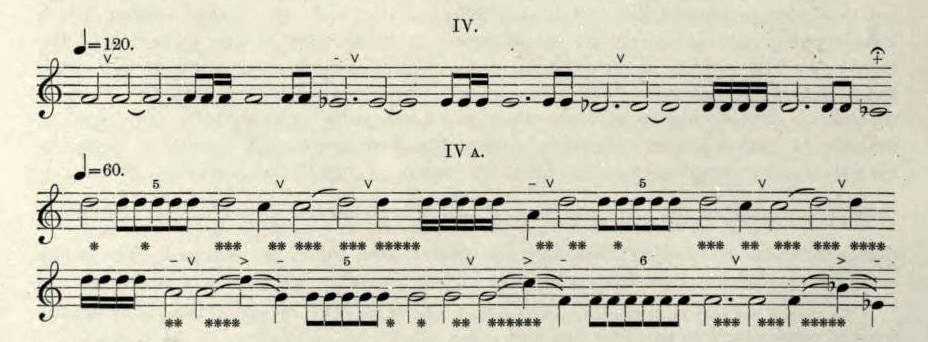

Myers, "Music", in Haddon 1901-35, volume 4 (1912), 267 (words)
https://archive.org/stream/reports191204cambuoft#page/267/mode/2up (DIGITISED)
Myers, "Music", in Haddon 1901-35, volume 4 (1912), 249-51 (commentary)
https://archive.org/stream/reports191204cambuoft#page/249/mode/2up (DIGITISED)
Myers, "The study of primitive music", 125 (music and words) (see also Moyle 1985, 56)
https://babel.hathitrust.org/cgi/pt?id=hvd.32044043850981;view=1up;seq=133 (DIGITISED)
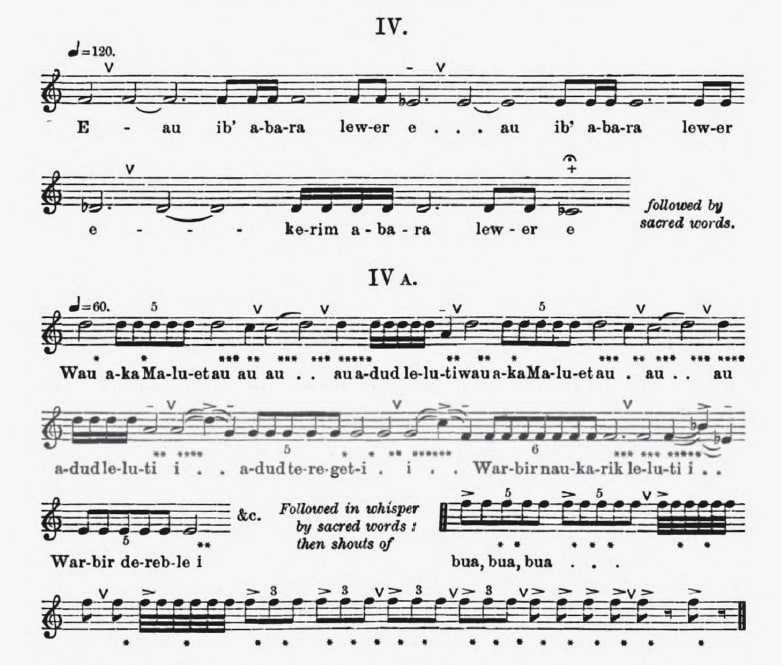
30.5-13A 9 Keber songs
The recordings appear to correspond to the transcriptions as follows (Moyle 1985, 55; updated 2016)
Keber songs V = B3 [unstreamed] = 30.5
Keber songs VI = B10 (C80/1031) streamed = 30.6
Keber songs VII = A2 [unstreamed] = 30.7
Keber songs VIII = B4 (C80/1025) streamed = 30.8
Keber songs IX = B1 [unstreamed] = 30.9
Keber songs X = [unidentified] = 30.10
Keber songs XI = B5 (C80/1026) streamed = 30.11
Keber songs XII = [unidentified] = 30.12
Keber songs XIII (? XIIIA) = A8 [unstreamed] = 30.13
30.5 Keber song (5) (Funeral song 5)
30.5 "Keber songs V"
text: Kodiaba kodiaba moiaba dagaba lagiaba sigapa
gloss: To the ring to the ring to fire to place to there
analytics: Murray Island, Eastern Torres Strait (region); TSI (music region); Papuan/ Miriamic/ Meriam Mir and ? Torres Strait Creole (language)
Myers and Haddon, "Funeral ceremonies", in Haddon 1901-35, volume 6 (1908), 152
https://archive.org/stream/reports190806cambuoft#page/152/mode/2up (DIGITISED)
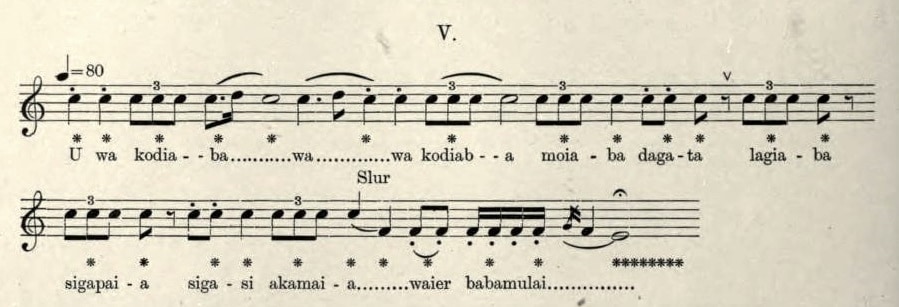
Myers, "Music", in Haddon 1901-35, volume 4 (1912), 245 (music)
https://archive.org/stream/reports191204cambuoft#page/245/mode/2up (DIGITISED)

Myers, "Music", in Haddon 1901-35, volume 4 (1912), 268 (words)
https://archive.org/stream/reports191204cambuoft#page/268/mode/2up (DIGITISED)
Myers, "Music", in Haddon 1901-35, volume 4 (1912), 251 (commentary)
https://archive.org/stream/reports191204cambuoft#page/251/mode/2up (DIGITISED)
Myers, "The study of primitive music", 127 (music and words)
https://babel.hathitrust.org/cgi/pt?id=hvd.32044043850981;view=1up;seq=135 (DIGITISED)
30.6 Keber song (6) (Funeral song 6)
30.6 "Keber songs VI"
text: (music only)
analytics: As for 30.5
Torres Strait cylinder B10 (Frazer No. 87), C80/1031; Myers Song VI Keber; 1-2 male vocal solo; inscription on insert notes (now no longer available): "Song / Dz Aa / Joe Brown / Ulai / zera markai" (streamed by British Library)
http://sounds.bl.uk/World-and-traditional-music/Ethnographic-wax-cylinders/025M-C0080X1031XX-0100V0 (STREAMED SOUND)
Myers and Haddon, "Funeral ceremonies", in Haddon 1901-35, volume 6 (1908), 152 (music)
https://archive.org/stream/reports190806cambuoft#page/152/mode/2up (DIGITISED)

Myers, "Music", in Haddon 1901-35, volume 4 (1912), 245 (music)
https://archive.org/stream/reports191204cambuoft#page/245/mode/2up (DIGITISED)

Myers, "Music", in Haddon 1901-35, volume 4 (1912), 251-52 (commentary)
https://archive.org/stream/reports191204cambuoft#page/251/mode/2up (DIGITISED)
Myers, "The study of primitive music", 127 (music)
https://babel.hathitrust.org/cgi/pt?id=hvd.32044043850981;view=1up;seq=135 (DIGITISED)
30.7 Keber song (7) (Funeral song 7)
30.7 "Keber songs VII"
text: Wau kubi uti sa baibai ita . . . (see source for additional words sung in monotone)
gloss: Yea dark sleep now eyebrows cover
analytics: As for 30.5
Myers and Haddon, "Funeral ceremonies", in Haddon 1901-35, volume 6 (1908), 152 (music and words)
https://archive.org/stream/reports190806cambuoft#page/152/mode/2up (DIGITISED)

Myers, "Music", in Haddon 1901-35, volume 4 (1912), 245 (music)
https://archive.org/stream/reports191204cambuoft#page/245/mode/2up (DIGITISED)

Myers, "Music", in Haddon 1901-35, volume 4 (1912), 268 (words)
https://archive.org/stream/reports191204cambuoft#page/268/mode/2up (DIGITISED)
Myers, "Music", in Haddon 1901-35, volume 4 (1912), 252 (commentary)
https://archive.org/stream/reports191204cambuoft#page/252/mode/2up (DIGITISED)
Myers, "The study of primitive music", 127 (music)
https://babel.hathitrust.org/cgi/pt?id=hvd.32044043850981;view=1up;seq=135 (DIGITISED)
30.8 Keber song (8) (Funeral song 8)
30.8 "Keber songs VIII"
text: O meluba Dudiie
gloss: ? along Daudai
analytics: As for 30.5
Torres Strait cylinder B4 (Frazer No. 89), C80/1025; Myers Song VIII Keber; 1 unaccompanied male vocal solo; inscription on insert notes (now no longer available): "meket siriam / Wanu / meluba Dudiie / Dz Ca VIII" (streamed by British Library)
http://sounds.bl.uk/World-and-traditional-music/Ethnographic-wax-cylinders/025M-C0080X1025XX-0100V0 (STREAMED SOUND)
Myers and Haddon, "Funeral ceremonies", in Haddon 1901-35, volume 6 (1908), 152 (music and words)
https://archive.org/stream/reports190806cambuoft#page/152/mode/2up (DIGITISED)

Myers, "Music", in Haddon 1901-35, volume 4 (1912), 245 (music)
https://archive.org/stream/reports191204cambuoft#page/245/mode/2up (DIGITISED)

Myers, "Music", in Haddon 1901-35, volume 4 (1912), 268 (words)
https://archive.org/stream/reports191204cambuoft#page/268/mode/2up (DIGITISED)
Myers, "Music", in Haddon 1901-35, volume 4 (1912), 252 (commentary)
https://archive.org/stream/reports191204cambuoft#page/252/mode/2up (DIGITISED)
Myers, "The study of primitive music", 128 (music)
https://babel.hathitrust.org/cgi/pt?id=hvd.32044043850981;view=1up;seq=136 (DIGITISED)
30.9 Keber song (9) (Funeral song 9)
30.9 "Keber songs IX"
text: (music only)
analytics: As for 30.5
Myers and Haddon, "Funeral ceremonies", in Haddon 1901-35, volume 6 (1908), 152
https://archive.org/stream/reports190806cambuoft#page/152/mode/2up (DIGITISED)

Myers, "Music", in Haddon 1901-35, volume 4 (1912), 245 (music)
https://archive.org/stream/reports191204cambuoft#page/245/mode/2up (DIGITISED)

Myers, "Music", in Haddon 1901-35, volume 4 (1912), 252 (commentary)
https://archive.org/stream/reports191204cambuoft#page/252/mode/2up (DIGITISED)
Myers, "The study of primitive music", 128 (music)
https://babel.hathitrust.org/cgi/pt?id=hvd.32044043850981;view=1up;seq=136 (DIGITISED)
30.10 Keber song (10) (Funeral song 10)
30.10 "Keber songs X"
text: (music only)
analytics: As for 30.5
Myers and Haddon, "Funeral ceremonies", in Haddon 1901-35, volume 6 (1908), 152 (music)
https://archive.org/stream/reports190806cambuoft#page/152/mode/2up (DIGITISED)

Myers, "Music", in Haddon 1901-35, volume 4 (1912), 245 (music)
https://archive.org/stream/reports191204cambuoft#page/245/mode/2up (DIGITISED)

Myers, "Music", in Haddon 1901-35, volume 4 (1912), 252 (commentary)
https://archive.org/stream/reports191204cambuoft#page/252/mode/2up (DIGITISED)
Myers, "The study of primitive music", 128 (music)
https://babel.hathitrust.org/cgi/pt?id=hvd.32044043850981;view=1up;seq=136 (DIGITISED)
30.11 Keber song (11) (Funeral song 11)
30.11 "Keber songs XI"
text: O obarasa gainau teir dimer
gloss: recognize pigeon ornament sew/tie on
analytics: As for 30.5
Torres Strait cylinder B5 (Frazer No. 84), C80/1026; Myers Song XI Keber; 1 unaccompanied male vocal solo; inscription on insert notes (now no longer available): "Dimer / Dz Ga / Joe Brown and Ulai" (streamed by British Library)
http://sounds.bl.uk/World-and-traditional-music/Ethnographic-wax-cylinders/025M-C0080X1026XX-0100V0 (STREAMED SOUND)
Myers and Haddon, "Funeral ceremonies", in Haddon 1901-35, volume 6 (1908), 152 (music and words)
https://archive.org/stream/reports190806cambuoft#page/152/mode/2up (DIGITISED)

Myers, "Music", in Haddon 1901-35, volume 4 (1912), 245 (music)
https://archive.org/stream/reports191204cambuoft#page/245/mode/2up (DIGITISED)

Myers, "Music", in Haddon 1901-35, volume 4 (1912), 268 (words)
https://archive.org/stream/reports191204cambuoft#page/268/mode/2up (DIGITISED)
Myers, "Music", in Haddon 1901-35, volume 4 (1912), 252-53 (commentary)
https://archive.org/stream/reports191204cambuoft#page/252/mode/2up (DIGITISED)
Myers, "The study of primitive music", 128 (music)
https://babel.hathitrust.org/cgi/pt?id=hvd.32044043850981;view=1up;seq=136 (DIGITISED)
30.12 Keber song (12) (Funeral song 12)
30.12 "Keber songs XII"
text: O Dudiaba. . .Gebariaba Mukeriaba tatarmauke Amiaba
gloss: to Daudai to Gebar to Mukwa comes between to Yam
analytics: As for 30.5
Myers and Haddon, "Funeral ceremonies", in Haddon 1901-35, volume 6 (1908), 152 (music and words)
https://archive.org/stream/reports190806cambuoft#page/152/mode/2up (DIGITISED)

Myers, "Music", in Haddon 1901-35, volume 4 (1912), 246 (music)
https://archive.org/stream/reports191204cambuoft#page/246/mode/2up (DIGITISED)

Myers, "Music", in Haddon 1901-35, volume 4 (1912), 268 (words)
https://archive.org/stream/reports191204cambuoft#page/268/mode/2up (DIGITISED)
Myers, "Music", in Haddon 1901-35, volume 4 (1912), 253 (commentary)
https://archive.org/stream/reports191204cambuoft#page/253/mode/2up (DIGITISED)
Myers, "The study of primitive music", 128 (music)
https://babel.hathitrust.org/cgi/pt?id=hvd.32044043850981;view=1up;seq=136 (DIGITISED)
30.13 Keber song (13 and 13A)
30.13 "Keber song XIII"
text: Pua pua. . .er pua. . .er etc., tokaiba namiedra (? namiadaba) wer a wer
gloss: (no gloss)
analytics: As for 30.5
30.13A "Keber song XIIIA"
text: O dia. . .ina wara si kalapudema wa waia tanu abu wali guba gol mina
gloss: this other there put on back along coconut they ? fishing line club canoe mark
analytics: As for 30.5
Myers, "Music", in Haddon 1901-35, volume 4 (1912), 246 (music)
https://archive.org/stream/reports191204cambuoft#page/246/mode/2up (DIGITISED)
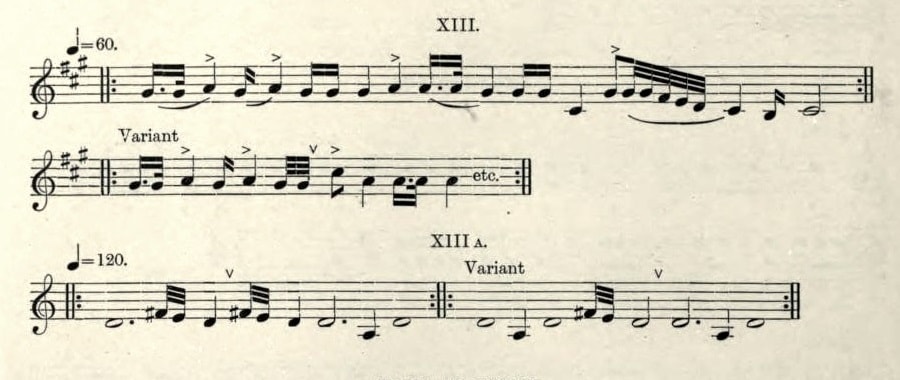
Myers, "Music", in Haddon 1901-35, volume 4 (1912), 268 (words)
https://archive.org/stream/reports191204cambuoft#page/268/mode/2up (DIGITISED)
Myers, "Music", in Haddon 1901-35, volume 4 (1912), 253 (commentary)
https://archive.org/stream/reports191204cambuoft#page/253/mode/2up (DIGITISED)
Myers, "The study of primitive music", 128 (music)
https://babel.hathitrust.org/cgi/pt?id=hvd.32044043850981;view=1up;seq=136 (DIGITISED)
30.14-18 5 secular songs
The recordings appear to correspond with the transcriptions as follows (Moyle 1985, 55, updated 2016)
Secular songs XIV = B11 [unstreamed] = 30.14
Secular songs XV = B2 [unstreamed] = 30.15
Secular songs XVI = B9 (C80/1030) streamed = 30.16
Secular songs XVII = B12 (C80/1033) streamed = 30.17
Secular songs XVIIISecular songs = B6 (C80/1027) streamed = 30.18
30.14 Secular song (14)
30.14 "Secular songs XIV"
text: Isia ba ba walsika O. . .umuru (see source for other versions)
gloss: name of plant for a basket plait
analytics: Murray Island, Eastern Torres Strait (region); TSI (music region); Papuan/ Miriamic/ Meriam Mir and ? Torres Strait Creole (language)
Myers, "Music", in Haddon 1901-35, volume 4 (1912), 246 (music)
https://archive.org/stream/reports191204cambuoft#page/246/mode/2up (DIGITISED)

Myers, "Music", in Haddon 1901-35, volume 4 (1912), 268 (words)
https://archive.org/stream/reports191204cambuoft#page/268/mode/2up (DIGITISED)
Myers, "Music", in Haddon 1901-35, volume 4 (1912), 253 (commentary)
https://archive.org/stream/reports191204cambuoft#page/253/mode/2up (DIGITISED)
Myers, "The study of primitive music", 129 (music)
https://babel.hathitrust.org/cgi/pt?id=hvd.32044043850981;view=1up;seq=137 (DIGITISED)
30.15 Secular song (15)
30.15 "Secular songs XV"
text: Kolap nab ulai kolap pogaipa kolap nino wagel (? walgen) pogaipa
gloss: Spinning top this go along top fails top yours after fails
analytics: As for 30.14
Myers, "Music", in Haddon 1901-35, volume 4 (1912), 246 (music)
https://archive.org/stream/reports191204cambuoft#page/246/mode/2up (DIGITISED)

Myers, "Music", in Haddon 1901-35, volume 4 (1912), 268 (words)
https://archive.org/stream/reports191204cambuoft#page/268/mode/2up (DIGITISED)
Myers, "Music", in Haddon 1901-35, volume 4 (1912), 254 (commentary)
https://archive.org/stream/reports191204cambuoft#page/254/mode/2up (DIGITISED)
Myers, "The study of primitive music", 129 (music and words))
https://babel.hathitrust.org/cgi/pt?id=hvd.32044043850981;view=1up;seq=137 (DIGITISED)

30.16 Secular songs (16)
30.16 "Secular song XVI"
text: Babim mena taiseda
gloss: to father always brought back
analytics: As for 30.14
Torres Strait cylinder B9, C80/1030; Myers Song XVI ". . . / Agoko. . . / Las (Babim mena Taiseda); 2 e o wa / Secular song; made Akoko / of Las" (streamed by British Library
http://sounds.bl.uk/World-and-traditional-music/Ethnographic-wax-cylinders/025M-C0080X1030XX-0100V0 (STREAMED SOUND)
Myers, "Music", in Haddon 1901-35, volume 4 (1912), 246
https://archive.org/stream/reports191204cambuoft#page/246/mode/2up (DIGITISED)

Myers, "Music", in Haddon 1901-35, volume 4 (1912), 268 (words)
https://archive.org/stream/reports191204cambuoft#page/268/mode/2up (DIGITISED)
Myers, "Music", in Haddon 1901-35, volume 4 (1912), 254 (commentary)
https://archive.org/stream/reports191204cambuoft#page/254/mode/2up (DIGITISED)
Myers, "The study of primitive music", 129 (music)
https://babel.hathitrust.org/cgi/pt?id=hvd.32044043850981;view=1up;seq=137 (DIGITISED)
30.17 Secular song (17) (Joe Brown's song)
30.17 "Secular song XVII"
text: Saiba ala mitge we mitge
gloss: on lip on lip
analytics: As for 30.14
Torres Strait cylinder B12 (Frazer No. 79), C80/1033; Myer Song XVII secular; 1-3 unaccompanied male vocal solo; inscription on insert notes: "Joe Brown's song" (streamed at British Library)
http://sounds.bl.uk/World-and-traditional-music/Ethnographic-wax-cylinders/025M-C0080X1033XX-0100V0 (STREAMED SOUND)
Myers, "Music", in Haddon 1901-35, volume 4 (1912), 246 (music)
https://archive.org/stream/reports191204cambuoft#page/246/mode/2up (DIGITISED)

Myers, "Music", in Haddon 1901-35, volume 4 (1912), 268 (words)
https://archive.org/stream/reports191204cambuoft#page/268/mode/2up (DIGITISED)
Myers, "Music", in Haddon 1901-35, volume 4 (1912), 254 (commentary)
https://archive.org/stream/reports191204cambuoft#page/254/mode/2up (DIGITISED)
Myers, "The study of primitive music", 130 (music)
https://babel.hathitrust.org/cgi/pt?id=hvd.32044043850981;view=1up;seq=138 (DIGITISED)
30.18 Secular song (18)
30.18 "Secular song XVIII"
text: Iriboa kukia iriboa
gloss: along N.W.
analytics: As for 30.14
Torres Strait cylinder B6, C80/1027; Myers Song XVIII secular; 1-2, unaccompanied male vocal solo, inscription on insert notes (now no longer available): 'XVIII / Boi-Grass song / known at Tud / Iriboa New Song / Murray Is (streamed by British Library)
http://sounds.bl.uk/World-and-traditional-music/Ethnographic-wax-cylinders/025M-C0080X1027XX-0100V0 (STREAMED SOUND)
Myers, "Music", in Haddon 1901-35, volume 4 (1912), 247 (music)
https://archive.org/stream/reports191204cambuoft#page/247/mode/2up (DIGITISED)

Myers, "Music", in Haddon 1901-35, volume 4 (1912), 268 (words)
https://archive.org/stream/reports191204cambuoft#page/268/mode/2up (DIGITISED)
Myers, "Music", in Haddon 1901-35, volume 4 (1912), 254-55 (commentary)
https://archive.org/stream/reports191204cambuoft#page/254/mode/2up (DIGITISED)
Myers, "The study of primitive music", 130 (music)
https://babel.hathitrust.org/cgi/pt?id=hvd.32044043850981;view=1up;seq=138 (DIGITISED)
10 Western Islands songs
30.19-24 6 Mabuiag songs
Myers numbered 14 Mabuiag songs, but only published transcriptions of six.
On the basis of container labels and inserts, the cylinders correspond to Myers's songs numbers and transcriptions as follows (Moyle 1985, 55, updated 2016)
Mabuiag III = C53 (C80/1069) Ngata kaba nau puidaik pita = 30.19
Mabuiag IV = C54 (C80/1070) 4 Mabuiag / Gaba Sagalad Nau / Womin man out = 30.20
Mabuiag IX = C65 (C80/1081) = 30.21
Mabuiag XI = C56 (C80/1072) Mabuiag 11 / Waiatana nga puidaik / Dance of Dead Men = 30.22
Mabuiag XIII = C55 (C80/1071) Songs Kwoiam ur kawar-bo C32 + 13 Mabuiag ur kawar = 30.23
Mabuiag XIV = C58 Mabuiag 14 = 30.24
3 ? unmatched/untranscribed recordings streamed by the British Library are listed after the 6 catalogued Mabuiag songs/transcriptions below.
30.19 Mabuiag song (3)
30.19 "Mabuiag III"
text: Ngata kaba nau puidaik
gloss: I dance song sing
analytics: Mabuiag Island, Western Torres Strait (region); TSI (music region); Northern PN/ Western Torres Strait/ Kala Lagaw Ya (language)
Torres Strait cylinder C53 (also D25), C80/1069; Myers Song III Mabuiag; 1 announcement: "Ngata kbaunau pidaiki, sung by Pita, Mabuiag"; 2 unaccompanied male vocal solo; inscription on insert notes: "Ngata kabaunau pudaiki / Pita / 53 T.S. [i.e. cylinder C53]" (streamed at British Library)
http://sounds.bl.uk/World-and-traditional-music/Ethnographic-wax-cylinders/025M-C0080X1069XX-0100V0 (STREAMED SOUND)
Myers, "Music", in Haddon 1901-35, volume 4 (1912), 262
https://archive.org/stream/reports191204cambuoft#page/262/mode/2up (DIGITISED)

Myers, "Music", in Haddon 1901-35, volume 4 (1912), 269 (words)
https://archive.org/stream/reports191204cambuoft#page/269/mode/2up (DIGITISED)
30.20 Mabuiag song (4)
30.20 "Mabuiag IV"
text: Gana sagulau nau
gloss: Ga's play's song
analytics: As for 30.19
Torres Strait, cylinder C54 (or D27), C80/1070; Myers Song IV Mabuiag; 1 announcement: "Gana Sagalau Nau, sung by Pita [?], Mabuiag"; 2 unaccompanied male vocal solo; inscription on insert notes: "Gana Sagulau Nau / Wom in man out / 54 T.S. [i.e. cylinder C54]" (streamed by British Library)
http://sounds.bl.uk/World-and-traditional-music/Ethnographic-wax-cylinders/025M-C0080X1070XX-0100V0 (STREAMED SOUND)
Myers, "Music", in Haddon 1901-35, volume 4 (1912), 262
https://archive.org/stream/reports191204cambuoft#page/262/mode/2up (DIGITISED)

Myers, "Music", in Haddon 1901-35, volume 4 (1912), 269 (words)
https://archive.org/stream/reports191204cambuoft#page/269/mode/2up (DIGITISED)
30.21 Mabuiag song (9)
30.21 "Mabuiag IX"
text: Korara kwiku puidaik
gloss: ? crocodile head sing
analytics: As for 30.19
Torres Strait cylinder C65 (also D38), C80/1081; 1 announcement: "Korara kwiku puidaik, sung by [indec]"; 2 unaccompanied male vocal solo; 3 "Karara kwiku puidaik, sung by [indec]"; 4 unaccompanied male vocal solo [? retake of 2]; inscription on insert notes: "Korara kwiku puidaik / by Gizu Mariget. / 65 T. S. [i.e. cylinder C65]" (streamed at British Library)
http://sounds.bl.uk/World-and-traditional-music/Ethnographic-wax-cylinders/025M-C0080X1081XX-0100V0 (STREAMED SOUND)
Myers, "Music", in Haddon 1901-35, volume 4 (1912), 262
https://archive.org/stream/reports191204cambuoft#page/262/mode/2up (DIGITISED)

Myers, "Music", in Haddon 1901-35, volume 4 (1912), 269 (words)
https://archive.org/stream/reports191204cambuoft#page/269/mode/2up (DIGITISED)
30.22 Mabuiag song (11)
30.22 "Mabuiag XI"
text: Waiatana na puidaik
gloss: Waiat's song
analytics: As for 30.19
Torres Strait, cylinder C56 (also D29), C80/1072; Myers Song XI Mabuiag; 1 indecipherable announcement; 2 unaccompanied male vocal solo; inscription on insert notes: "Waitana nga puikaik / Dance of Dead man / 56 T.S. [i.e. cylinder C56]" (streamed by British Library)
http://sounds.bl.uk/World-and-traditional-music/Ethnographic-wax-cylinders/025M-C0080X1072XX-0100V0 (STREAMED SOUND)
Myers, "Music", in Haddon 1901-35, volume 4 (1912), 262
https://archive.org/stream/reports191204cambuoft#page/262/mode/2up (DIGITISED)

Myers, "Music", in Haddon 1901-35, volume 4 (1912), 269 (words)
https://archive.org/stream/reports191204cambuoft#page/269/mode/2up (DIGITISED)
30.23 Mabuiag song (13)
30.23 "Mabuiag XIII"
text: Ur kawa
gloss: Sea [and] island
analytics: As for 30.19
Torres Strait cylinder C55 (also D29), C80/1071; Myers Song XIII Mabuiag; 1 announcement: "[indec.] . . . songs of Kwoiam . . . [indec]"; 2 unaccompanied male vocal solo; inscription on insert notes: "Ur kawar. / 55 T.S. [i.e. cylinder C55]" (streamed at British Library)
http://sounds.bl.uk/World-and-traditional-music/Ethnographic-wax-cylinders/025M-C0080X1071XX-0100V0 (STREAMED SOUND)
Myers, "Music", in Haddon 1901-35, volume 4 (1912), 262
https://archive.org/stream/reports191204cambuoft#page/262/mode/2up (DIGITISED)

Myers, "Music", in Haddon 1901-35, volume 4 (1912), 269 (words)
https://archive.org/stream/reports191204cambuoft#page/269/mode/2up (DIGITISED)
30.24 Mabuiag song (14)
30.24 "Mabuiag XIV"
text: Ngato madubau nau puidaik
gloss: I madub's (= charm's) song sing
analytics: As for 30.19
Myers, "Music", in Haddon 1901-35, volume 4 (1912), 263
https://archive.org/stream/reports191204cambuoft#page/263/mode/2up (DIGITISED)

Myers, "Music", in Haddon 1901-35, volume 4 (1912), 269 (words)
https://archive.org/stream/reports191204cambuoft#page/269/mode/2up (DIGITISED)
Other streamed Mabuiag song recordings:
Torres Strait Cylinder C57 (also D30), C80/1073; 1 Announcement "Crying at death [?], Mabuiag"; 2 unaccompanied male vocal solo; inscription on insert notes: "Death Crying - Mabuiag / 57 T.S. [i.e. cylinder C57]" (streamed by British Library)
http://sounds.bl.uk/World-and-traditional-music/Ethnographic-wax-cylinders/025M-C0080X1073XX-0100V0 (STREAMED SOUND)
Torres Strait cylinder C7 (also D69), C80/1040; ? Mabuiag Song (streamed by British Library)
http://sounds.bl.uk/World-and-traditional-music/Ethnographic-wax-cylinders/025M-C0080X1040XX-0100V0 (STREAMED SOUND)
Torres Strait cylinder C52 (also D25), C80/1068; 1 announcement: "Crying at death. Mabuiag"; 2 unaccompanied male vocal solo; inscription on insert notes: "Wail at Death / Mabuiag" (streamed by British Library)
http://sounds.bl.uk/World-and-traditional-music/Ethnographic-wax-cylinders/025M-C0080X1068XX-0100V0 (STREAMED SOUND)
30.25-26 2 Yam songs
On the basis of container labels and inserts, the cylinders correspond to Myers's songs numbers and transcriptions as follows (Moyle 1985, 55, updated 2016)
Yam I = C76 (C80/1092) Yam I = 30.25
Yam II = C77 (C80/1093) Yamaz Sibared Sung by Maina of Yam = 30.26
30.25 Yam song 1
30.25 "Yam I"
text: Awaia gulabwi kabutan
gloss: pelican in canoe put
analytics: Yam Island, Western Torres Strait (region); TSI (music region); Northern PN/ Western Torres Strait/ Kulkalgaw Ya (language)
Torres Strait cylinder 76, D49 ("76 T.S."), C80/1092 (recordist Sidney Ray); 1 "[indec.], sung by [indec.]"; 2 unaccompanied male vocal solo; on box: "Waino's kamul" crossed out. A.M - c.f. Myers Yam I (streamed at British Library)
http://sounds.bl.uk/World-and-traditional-music/Ethnographic-wax-cylinders/025M-C0080X1092XX-0100V0 (STREAMED SOUND)
Myers, "Music", in Haddon 1901-35, volume 4 (1912), 263
https://archive.org/stream/reports191204cambuoft#page/263/mode/2up (DIGITISED)

Myers, "Music", in Haddon 1901-35, volume 4 (1912), 269 (words)
https://archive.org/stream/reports191204cambuoft#page/269/mode/2up (DIGITISED)
30.26 Yam song 2
30.26 "Yam II"
text: Yamazi barid
gloss: along Yam Id. cuscus
analytics: As for 30.25
Torres Strait cylinder C77 ("77 T.S."), C80/1093; 1 announcement: "Yamaz Sibarud, sung by Maino of Yam"; 2 unaccompanied male vocal solo; no further information available (streamed by British Library)
http://sounds.bl.uk/World-and-traditional-music/Ethnographic-wax-cylinders/025M-C0080X1093XX-0100V0 (STREAMED SOUND)
Yam II, original recording, as above (streamed by the National Film and Sound Archive)
http://aso.gov.au/titles/music/1898-torres-strait-recordings/clip1 (STREAMED SOUND)
http://videomedia.aso.gov.au/titles/torstsoa/torstsoa1_bb.mp3 (STREAMED SOUND)
Myers, "Music", in Haddon 1901-35, volume 4 (1912), 263
https://archive.org/stream/reports191204cambuoft#page/263/mode/2up (DIGITISED)

Myers, "Music", in Haddon 1901-35, volume 4 (1912), 269 (words)
https://archive.org/stream/reports191204cambuoft#page/269/mode/2up (DIGITISED)
30.6.1-2 2 Saibai songs
The recordings appear to correspond to Myers's songs numbers and transcriptions as follows (Moyle 1985, 55, updated 2016)
Saibai IA and IB
= [unidentified] and
= C63 (C80/1078) Saibai II a-b Mawa na puidam Sung by Gemetu, Saibai = 30.27
Saibai II
= C61 [unstreamed] (announcement: "Maduba na puiadam, sung by Gemetu, Saibai"),
= C62 (C80/1078) = 30.28
2 ? unmatched/untranscribed recordings streamed by the British Library are listed after the 2 catalogued Mabuiag songs/transcriptions below.
30.27 Saibai song 1A and 1B
30.27A "Saibai IA"
text: Mawa na puidam
gloss: Mawa [ceremony] song sung
analytics: Saibai Island, Western Torres Strait (region); TSI (music region); Northern PN/ Western Torres Strait/ Kalaw Kawaw Ya (language)
30.27B "Saibai IB"
text/gloss: Unclear if the text for Saibai I (Haddon 1912, 269) applies to the music for Saibai IA, Saibai IB or both (Haddon 1912, 263).
analytics: As for 30.27A
Torres Strait cylinder C63 (also D36), C80/1079; 1 announcement: "Mawau na puidam, sung by Gemetu, Saibai"; 2 unaccompanied male vocal solo; 3 "Na puidam"; 4 Unaccompanied male vocal solo (streamed at British Library)
http://sounds.bl.uk/World-and-traditional-music/Ethnographic-wax-cylinders/025M-C0080X1079XX-0100V0 (STREAMED SOUND)
Myers, "Music", in Haddon 1901-35, volume 4 (1912), 263
https://archive.org/stream/reports191204cambuoft#page/263/mode/2up (DIGITISED)

Myers, "Music", in Haddon 1901-35, volume 4 (1912), 269 (words)
https://archive.org/stream/reports191204cambuoft#page/269/mode/2up (DIGITISED)
30.28 Saibai song 2
30.28 "Saibai II"
text: Madub na puidam
gloss: Charm song sung
analytics: As for 30.27A
Torres Strait cylinder C62 (also D35), C80/1078; 1 announcement: "Mawa na puidam, sung by Kunau, Saibai"; 2 unaccompanied male vocal solo; inscription on insert notes: "Mawa na puikam / sung by Kunau - / Saibai / 62 T.S. [i.e. cylinder C62]" (streamed at British Library)
http://sounds.bl.uk/World-and-traditional-music/Ethnographic-wax-cylinders/025M-C0080X1078XX-0100V0 (STREAMED SOUND)
Myers, "Music", in Haddon 1901-35, volume 4 (1912), 263
https://archive.org/stream/reports191204cambuoft#page/263/mode/2up (DIGITISED)

Myers, "Music", in Haddon 1901-35, volume 4 (1912), 269 (words)
https://archive.org/stream/reports191204cambuoft#page/269/mode/2up (DIGITISED)
Other streamed Saibai song recordings:
Torres Strait cylinder C60 (also D33); C80/1076 (recordist Sidney Ray); 1 announcement: "Na puidam purda, sung by Wap, Saibai"; 2 Unaccompanied male vocal solo; inscription on insert notes: "Na puidam 30 / Sung by Wap / Saibai / 60 T.S. [i.e. cylinder C60]" (streamed at British Library)
http://sounds.bl.uk/World-and-traditional-music/Ethnographic-wax-cylinders/025M-C0080X1076XX-0100V0 (STREAMED SOUND)
Torres Strait cylinder C64 (also D37), C80/1080; 1 announcement: "Nau poida 6, sung by Aimab, Saibai"; 2 unaccompanied male vocal solo; inscription on insert notes: "Nau poida 6 / Sung by Aimab[?] / Saibai / 64 T.S. [i.e. cylinder C64]" (streamed at British Library)
http://sounds.bl.uk/World-and-traditional-music/Ethnographic-wax-cylinders/025M-C0080X1080XX-0100V0 (STREAMED SOUND)
*
Other streamed 1898 song recordings:
Torres Strait cylinder D61 ('T.S. 111'), C80/1104; 1 unaccompanied vocal group; no further information available (streamed by British Library)
http://sounds.bl.uk/World-and-traditional-music/Ethnographic-wax-cylinders/025M-C0080X1104XX-0100V0 (STREAMED SOUND)
Unnumbered Torres Strait cylinder, C80/1483; 1 "Home Sweet Home, [indec.]"; 2 male vocal group, unaccompanied (streamed by British Library)
http://sounds.bl.uk/World-and-traditional-music/Ethnographic-wax-cylinders/025M-C0080X1483XX-0100V0 (STREAMED SOUND)
Torres Strait cylinder C17 (also D79), C80/1050; 1 announcement: "Hunting song, Kariudo uta, by S. Minami"; 2 unaccompanied male vocal solo; inscription on insert notes: "C17 / Hunting Song / Kariudo uta / by S. Minami" (streamed by British Library)
http://sounds.bl.uk/World-and-traditional-music/Ethnographic-wax-cylinders/025M-C0080X1050XX-0100V0 (STREAMED SOUND)
Torres Strait cylinder (16), C80/1497; 1 truncated indecipherable announcement; 2 unaccompanied mixed voice choir; on box is written "Naval Brigade" (streamed by British Library)
http://sounds.bl.uk/World-and-traditional-music/Ethnographic-wax-cylinders/025M-C0080X1497XX-0100V0 (STREAMED SOUND)
Torres Strait (or possibly New Guinea) cylinder, C80/816; 1 unaccompanied mixed vocal group, singing at parallel pitches; no further information available (streamed by British Library)
http://sounds.bl.uk/World-and-traditional-music/Ethnographic-wax-cylinders/025M-C0080X0816XX-0100V0 (STREAMED SOUND)
Torres Strait cylinder C18 (also D80), C80/1051; 1 indecipherable announcement; 2 unaccompanied male vocal solo; 3 indec. announcement; 4 unaccompanied male vocal solo; inserted in the cylinder were four notes: 1) Music for [danan?] cliffs / 2 ?. . . / came from / HMS Sheldrake / pearls; 2) workman's song / Dokata Busii[?]; 3) Tud [male sign] / Murray I? / -- child / -- Bamba / [illeg] / Murray I 1845 fly / 1889 Mission, / Tut [illeg] / Saibai -- / Murray --'; 4) Ahodaiakia / Fools' sermon / by K. Fujita (streamed by British Library)
http://sounds.bl.uk/World-and-traditional-music/Ethnographic-wax-cylinders/025M-C0080X1051XX-0100V0 (STREAMED SOUND)
Other sources and documentation:
A. C. Haddon, "Ethnography of the western tribes of Torres Straits", The Journal of the Anthropological Institute of Great Britain and Ireland 19 (1890), 376-80
https://archive.org/stream/journalanthropo08irelgoog#page/n411/mode/2up
A. C. Haddon, "The secular and ceremonial dances of Torres Straits", Internationales Archiv für Ethnographie 6 (1893), 131-62
Sidney H. Ray, Reports of the Cambridge Anthropological Expedition to Torres Straits (1898), volume 3: Linguistics (Cambridge: Cambridge University Press 1907);
https://archive.org/details/reportsofcambrid03hadd (DIGITISED)
Sidney H. Ray, Dictionary of Torres Strait languages, edited by Ron Edwards (2nd edn., Kuranda QLD: Rams Skull Press, 2003)
Video (1898):
Mer Island ceremonial dance (Cambridge Expedition, 1898) (streamed by Torres Strait Islanders' On-line Television)
http://tsitv.atsiphj.com.au/index.php?option=com_videoflow&task=play&id=134 (STREAMED VIDEO)
Torres Strait Islanders dances (Cambridge Expedition, 1898) (streamed by National and Film and Sound Archive)
http://aso.gov.au/titles/historical/torres-strait-islanders/clip1 (STREAMED VIDEO)
http://aso.gov.au/titles/historical/torres-strait-islanders/clip3 (STREAMED VIDEO)
Bibliography:
Alice Moyle, "The Torres Strait phonograph recordings: a preliminary listing of contents", Australian Aboriginal Studies (1985, issue 2), 53-57
Roberta Wells, "Sidney Herbert Ray: linguist and educationalist", The Cambridge Journal of Anthropology 21/1 (1999), 79-99
Helen Reeves Lawrence, "'The great traffic in tunes': agents of religious and musical change in eastern Torres Strait", in Richard Davis (ed.), Woven histories, dancing lives: Torres Strait Islander identity, culture and history (Canberra: Aboriginal Studies Press, 2004), 46-72
Bennett Zon, Representing mon-western music in nineteenth-century Britain (Rochester, NY: University of Rochester Press, 2007), 218-32
Fairweather, Matthias and Whaleboat 2016 (forthcoming)
Skinner 2017
Skinner and Wafer 2017
1899 (published; recorded 1857)
31 1 song
Yuin (? "Dharumba"), "Yatte Yattah", Milton, South Coast, NSW
Music and words transcribed by Percy Hale Sheaffe (1832-1913), from the singing of Jimmy Woodbury, 1857, published 1900
https://sydney.edu.au/paradisec/australharmony/checklist-indigenous-music-1.php#031 (shareable link to this entry)
Tshemer burra (djinaburra)
31 "All about whale ship"
text: Tshemer burra buna ny toonaoo na [repeat ad lib.] parn wate
gloss: "all about whale ship"
analytics: Milton, South Coast, NSW (region); ECA (music region); South-eastern PN/ Yuin/ ? Dharumba (language)
Sources:
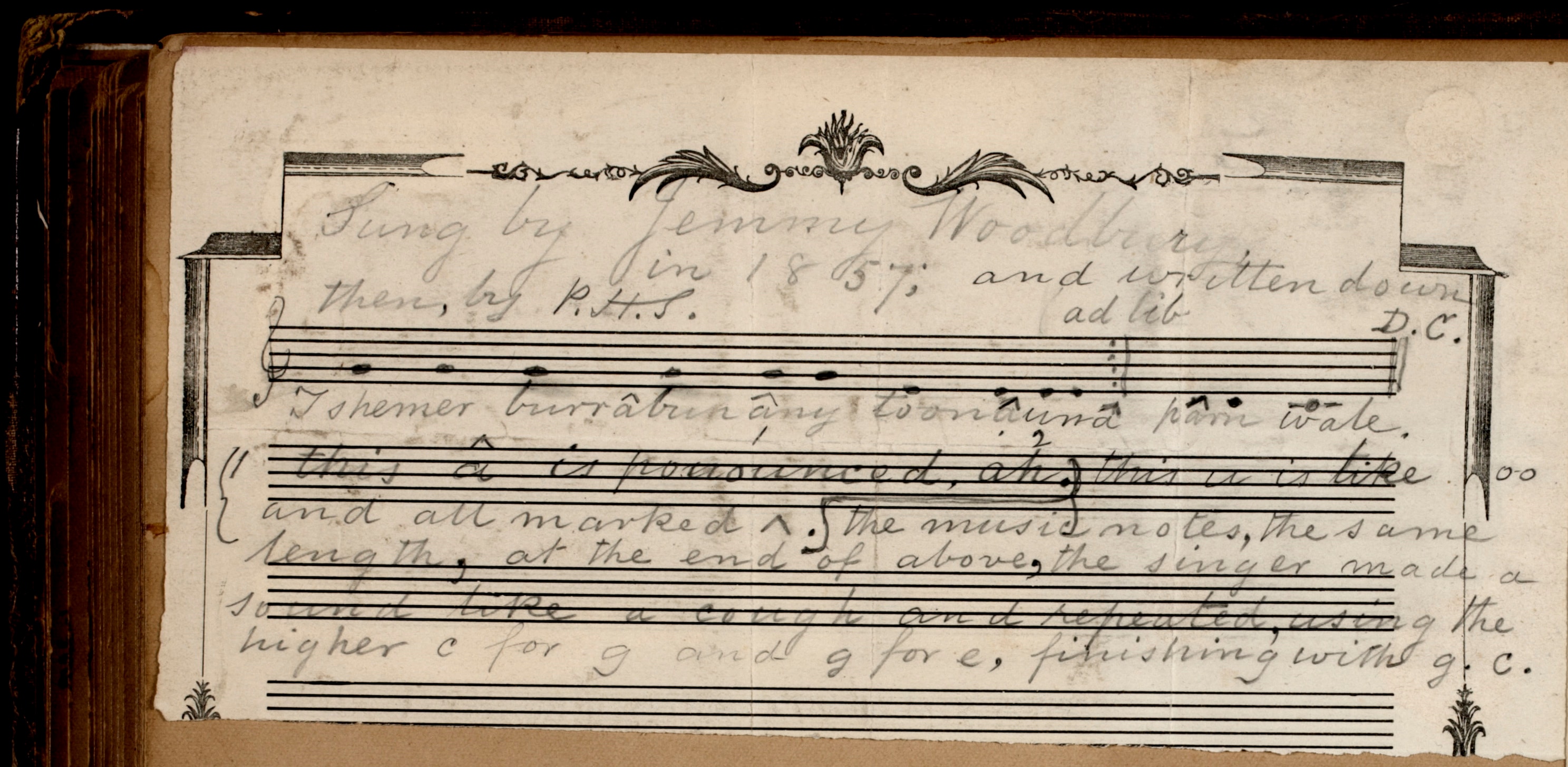
P. H. S. [Percy Hale Sheaffe], Tshemer burrâbun, undated manuscript (in Sheaffe's handwriting), pasted into scrapbook and photograph album compiled by Edmund Milne (1861-1917); National Museum of Australia, Canberra, 1985.0059.0426
https://www.nma.gov.au/exhibitions/glorious-days/first-peoples/edmund-milne
Sung by Jemmy Woodbury in 1857; and written down then, by P.H.S.
Tshemer burrâbun âny toonâunâ pârn wale.
This â is pronounced, ah. and all marked ˆ.
this is like the music notes, the same length, at the end of above, the singer made a sound like a cough and repeated,
using the higher c for g and g for e, finishing with g. c.

Percy Hale Sheaffe, letter to Robert Waddell (District Registrar, Milton, NSW), 30 October 1899; in correspondence attached to Waddell's completed return of a questionnaire sent out by W. Wentworth-Bucknell, on behalf of the Anthropological Society of Australasia, "Collection of native names of places with their meanings"; Royal Anthropological Society of Australasia - Records, 1885-1914, with additional material, 1921-1926, ca. 1991, and papers of Alan Carroll, 1886-1892, State Library of New South Wales, MLMSS 7603/Box 4/Folder 3, 209a [a9821010]
https://collection.sl.nsw.gov.au/record/1wN2jDjn (COLLECTION RECORD)
https://collection.sl.nsw.gov.au/record/9NaA7d7Y (IMAGE SET)
https://collection.sl.nsw.gov.au/record/9NaA7d7Y/rwojvaOd58LWN (IMAGE 10)
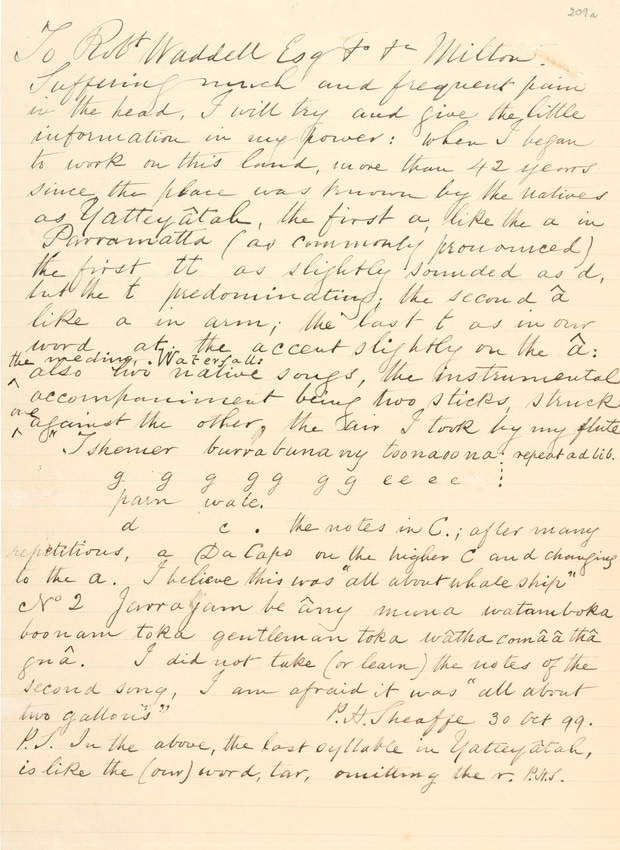
. . . When I began to work in this [?], some [?] 42 years since, the place was known by the natives as Yatteyâtah. The first a, like the a in Parramatta . . .
also two native songs, the instrumental accompaniment being two sticks, struck one against the other, the [?] I took by my flute.
Tshemer burra buna ny toonaoo na : repeat ad lib.
g g g g g g g e e e e :
parn wate.
d c .
the notes in C.; after many repetitions, a Da Capo on the higher C and changing
to the a. I believe this was "all about whale ship"
No 2 . . . .
. . . I did not take (or learn) the notes of the second song, I am afraid it was "all about two gallows [?]" . . .
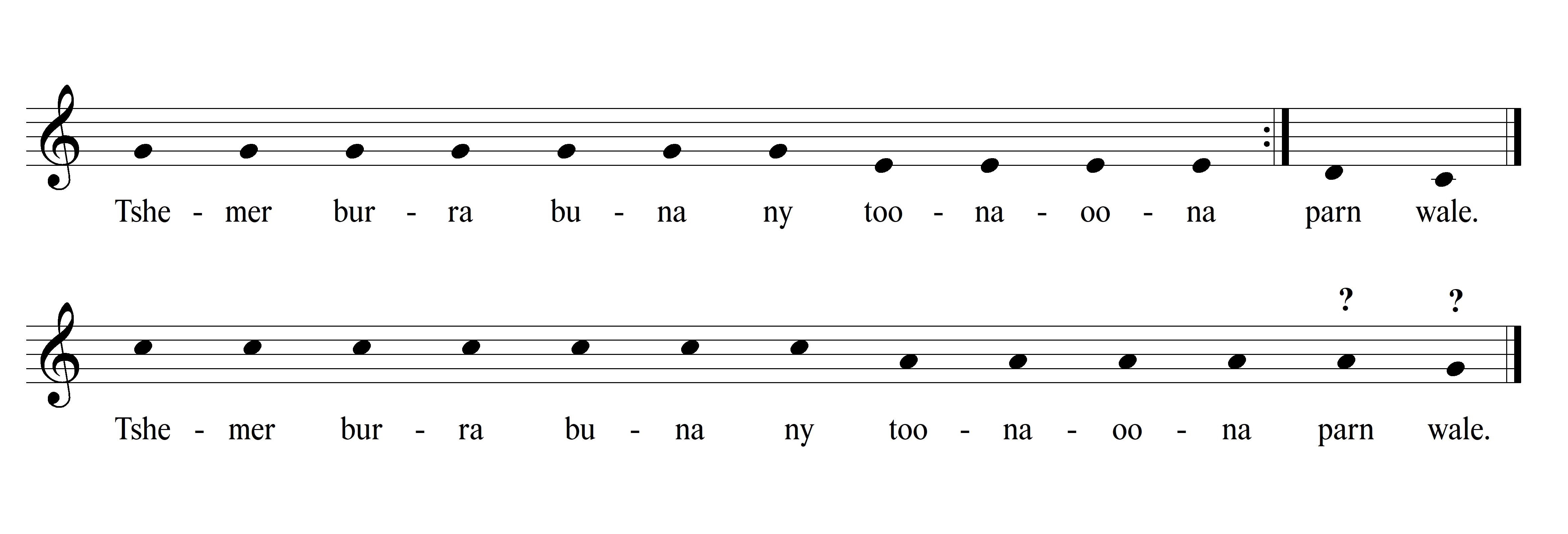
Captain Sheafe [Percy Sheaffe], "Two native songs", Science of man and journal of the Royal Anthropological Society of Australasia 2/12 (January 1900), 227
https://nla.gov.au/nla.obj-522116146/view?partId=nla.obj-522165700#page/n11/mode/1up (DIGITISED)
Printed from the MS above, with some errors
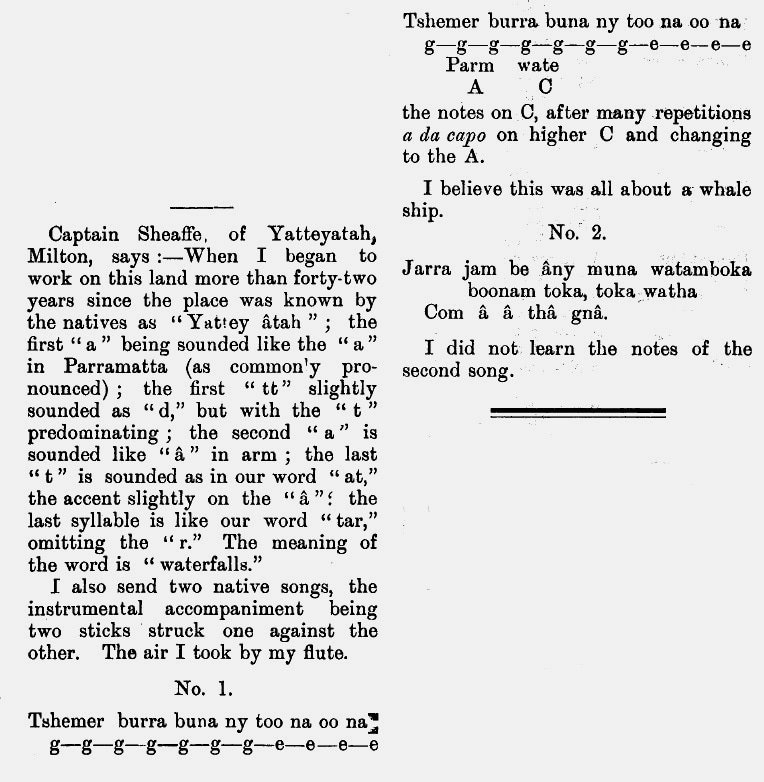
Bibliography:
Nicole Saintilan, "Music - if so it may be called": perception and response in the documentation of Aboriginal music in nineteenth century Australia (M.Mus thesis, University of New South Wales, 1993), 78
http://hdl.handle.net/1959.4/50383 (DIGITISED)
Graeme Skinner, "Recovering musical data from colonial era transcriptions of Indigenous songs: some practical considerations", in Jim Wafer and Myfany Turpin (eds), Recirculating songs: revitalising the singing practices of Indigenous Australia (Canberra: Asia-Pacific Linguistics, 2017), 352
http://hdl.handle.net/1885/132161
https://openresearch-repository.anu.edu.au/bitstream/1885/132161/25/16_skinner.pdf (FREE DOWNLOAD)
Graeme Skinner and Jim Wafer, "A checklist of colonial era musical transcriptions of Australian Indigenous songs", in Jim Wafer and Myfany Turpin (eds), Recirculating songs: revitalising the singing practices of Indigenous Australia (Canberra: Asia-Pacific Linguistics, 2017), 398-99
http://hdl.handle.net/1885/132161
https://openresearch-repository.anu.edu.au/bitstream/1885/132161/25/16_skinner.pdf (FREE DOWNLOAD)
Commentary:
Sheaffe (1899) gives the text only for the second song, which was "all about two gallons". He also says, "I began to work on this land, more than 42 years since", and there is a strong suggestion that the songs are being remembered from an earlier period in his life. Sheaffe was already sitting as a Justice of the Peace at Milton Petty Sessions in December 1859.
References:
"MARRIAGES", The Sydney Morning Herald (28 April 1859), 1
http://nla.gov.au/nla.news-article13024238
On the 25th of April, at Trinity Church, by the Rev. E. Rogers, Percy Hale, second son of Captain Sheaffe, of Stream Hill, Illawarra, formerly of her Majesty's 50th Regiment, to Hannah Maria, only daughter of the late Captain Ashmore.
"ULLADULLA", Examiner (17 December 1859), 3
http://nla.gov.au/nla.news-article102523025
. . . A Court of Petty Sessions was held on the 9th, before Messrs. P. Sheaffe, James Warden, Robert Ritchie, and R. Seccombe, J.P.s . . .
"Yatteyattah Recreation Ground", The Ulladulla and Milton Times (13 November 1897), 5
http://nla.gov.au/nla.news-article161103461
. . . [The speaker] very much regretted the absence of his most esteemed friend Captain Sheaffe, as it was he who preserved the name of Yatte yattah, which he got from the oldest aboriginals when he (Mr. Sheaffe) first came to the district a half century ago. The aboriginal interpretation for Yatteyattah was, "Water tumble down."
"SOUTH COAST ITEMS", Northern Star (17 June 1913), 8
http://nla.gov.au/nla.news-article72413723
Percy Sheaffe obituary
Percy Hale Sheaffe (1832-1913), WikiTree
http://www.wikitree.com/wiki/Sheaffe-26
1899 & 1903
32 3 songs
Tasmanian language, Hobart, TAS
Sung by Fanny Cochrane Smith (1834-1905), daughter of Tangnarootoora (Tanganuturra), sound recordings by Horace Watson (1862-1930)
Royal Society Room, Tasmanian Museum, Hobart, TAS, 5 August 1899
Barton Hall (Watson's home), Sandy Bay, TAS, 8 and 10 October 1903
See also entry 9 above
https://sydney.edu.au/paradisec/australharmony/checklist-indigenous-music-1.php#032 (shareable link to this entry)
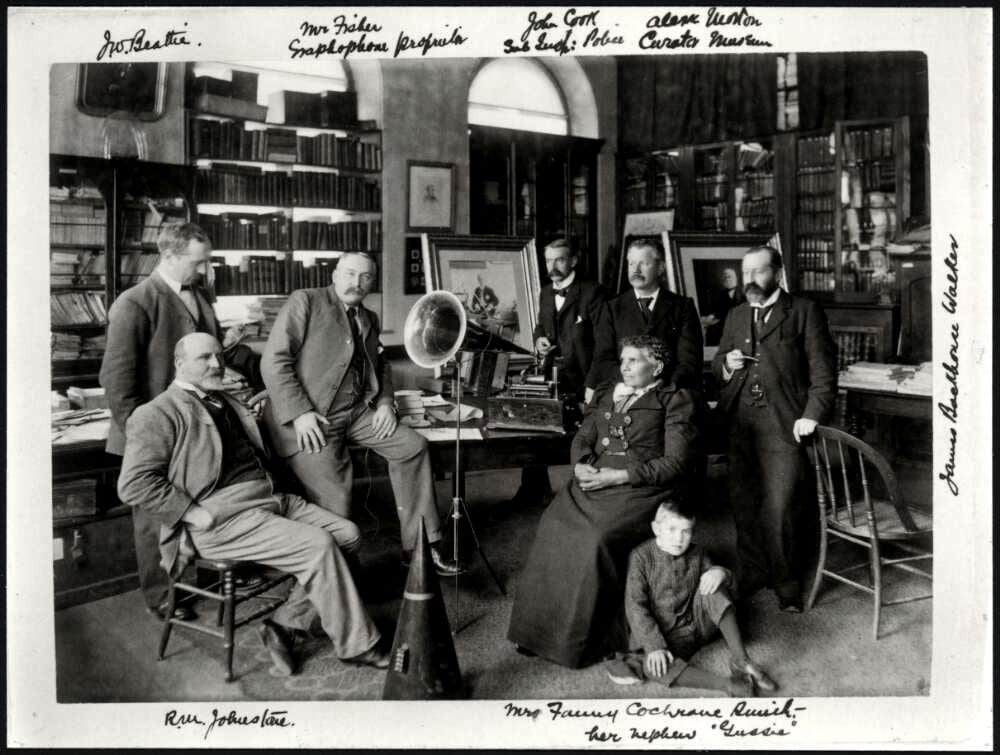
Fanny Smith and members of the Royal Society of Tasmania, Royal Society Room, Tasmanian Museum, Hobart, TAS, 5 August 1899 (National Library of Australia)
http://nla.gov.au/nla.obj-137164649 (DIGITISED)
32.1 Popela
Longman 1960, 82-83
http://eprints.utas.edu.au/14096 (DIGITISED)
Text, in parallel with the 1899 and 1903 versions, the text as earlier transcribed by J. W. Walker (1832), Maria Logan (1836), R. Davis (1846), J. Milligan (1859) [but not as twice by George Augustus Robinson]; see also 9 above
Longman 1960, 84
Text and gloss (without repetitions)
Pappela rayna ngonyna,
fast run fire,
The camp fire burns fast,
Taka mengha leah, Lugha mengha leah,
Heel toe behind, Foot toe behind,
Heel, toe behind, Foot, toe behind
Nena taypa rayna poonyaYou come run bird,
You come and run like a bird.
Nena nawra pewyllah, Pallah nawra pewylla, Pellawah, Pellawah,
You very man, Man very man, great man, great man
You are a brave man, a brave man, a great man, a great man.
32.1 "Popela" ("popeller") ("Corroboree song")
text: Poppyla (wala wala pawalawa)
Poppyla (wala wala pawalawa)
Nyna tepe rene pogana
Nyna tepe rene pogana
Nyna tepe re' pogana
Tepe nara pewilly
Para nara pewilly
Pallawoo
a Nyna nara pewilly
Para nara pewilly
Pallawoo pallawoo (version A, from Moyle 1968, 3)
gloss: As for 9 above
analytics: Tasmania (region); TAS (music region); Tasmanian (language)
Popela version A
Sung by Fanny Cochrane Smith, recorded by Horace Watson, Hobart, TAS, 5 August 1899; cylinder 1 (Tasmanian Museum and Art Gallery, 15685/M3317) (restored and streamed by the National Film and Sound Archive)
http://aso.gov.au/titles/music/fanny-cochrane-smith-songs/clip1 (SOUND FILE)
The contents of only the first of the original cylinders (Tasmanian Museum 15685/M 3317) as recorded by Horace Watson, in the rooms of the Royal Society of Tasmania, on 5 August 1899, is now freely streamed in its entirety (approx.. 2 minutes 23 seconds) in this sound clip on the National Film and Sound Archive's website (http://aso.gov.au/titles/music/fanny-cochrane-smith-songs).
0:00 - The first minute and a half consists of an introduction in English, declaimed into the recording horn by Mrs. Smith:
I'm Fanny Smith. I was born on Flinders Island. I'm the last of the Tasmanians. I'll (put this morning) a very long story about it. I'll tell you the truth, to let you know a little about us. My mother's name was Tanganitara. I - we are some true born sisters from Flinders Island, where we were for seven years. And I'm here speaking to-day. [? in answer to a question] have we got for mother and my father? My father [? family] Noona. Noona (nitara-noota). (Sing a song. Noota, mother and me). My father Noona. My father was a (whaler). Lose-a my mother, all gone. [? in answer to a question] . . . My family? I'm married. Goodbye. My father [? family] no more.
1:49 - Mrs. Smith begins the first of her three recorded renditions of the song, Popela, this one - the shortest - only 33 seconds.
Below, transcription of above recording, Australharmony 2016
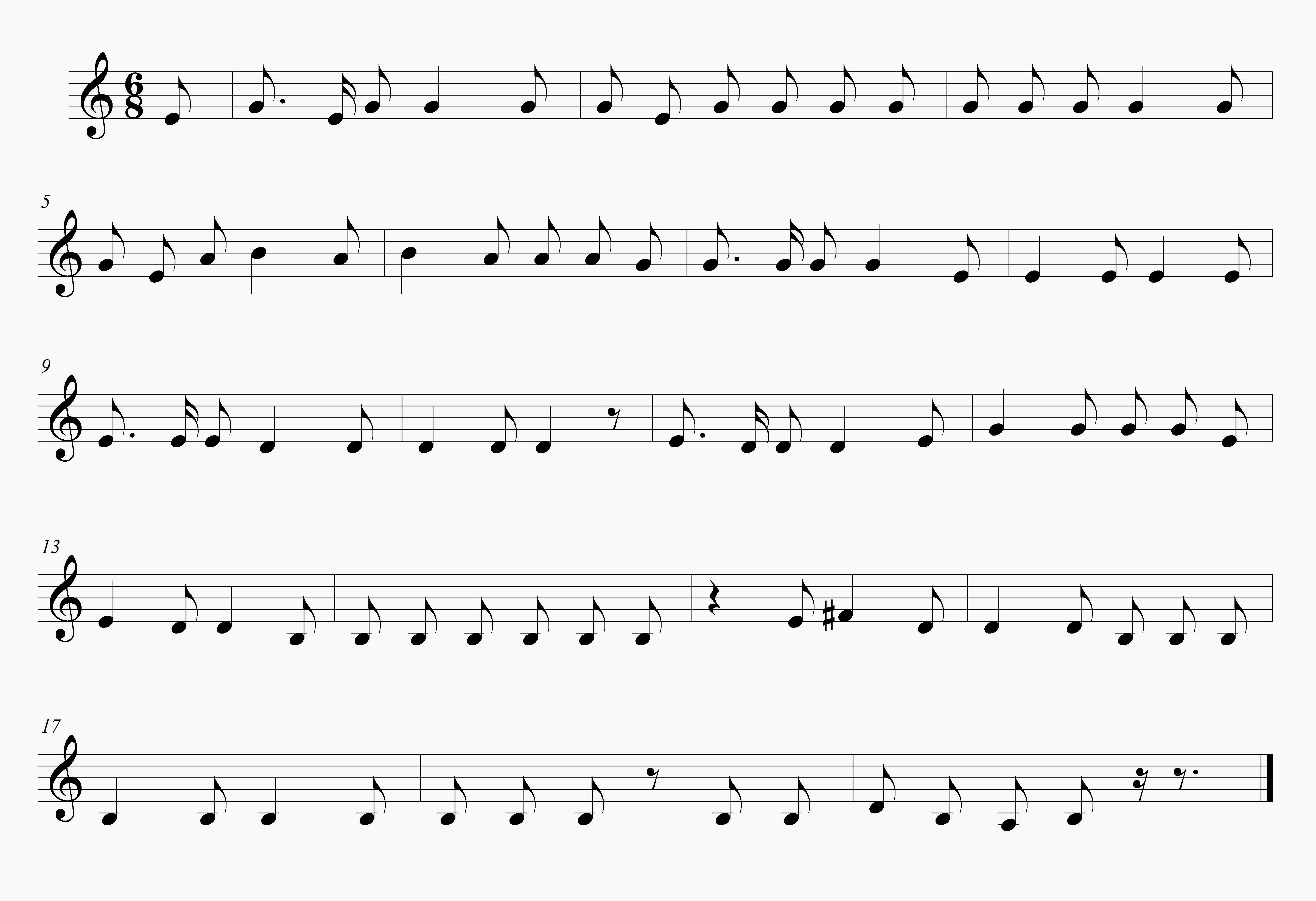
Longman 1960, 80
http://eprints.utas.edu.au/14096 (DIGITISED)
This cylinder which was unbroken but in poor condition, consists of an introduction and song by Mrs. Fanny Smith. She speaks in English, answers several questions and concludes by singing her version of the "Corroboree Song" in the Tasmanian language . . .
Pāpĕla rene nūena ne rene ne pāpĕ ne rene nūena ne rene
Löga menxa leā
Tóka menxa menxa leā
Tóka menxa menxa leā
Tóka menxa nára pewylā pālā nára pewylā pálawā
Nina nára pewyla pālā nára pewylā
Pálawā pálawā.
Moyle 1960, 76
http://eprints.utas.edu.au/14095 (DIGITISED)
Moyle gives musical transcriptions (page 76) of two Popela version A, 1899 (Cylinder 1) and Popela version B, 1903 (Cylinder 4), pictured below:
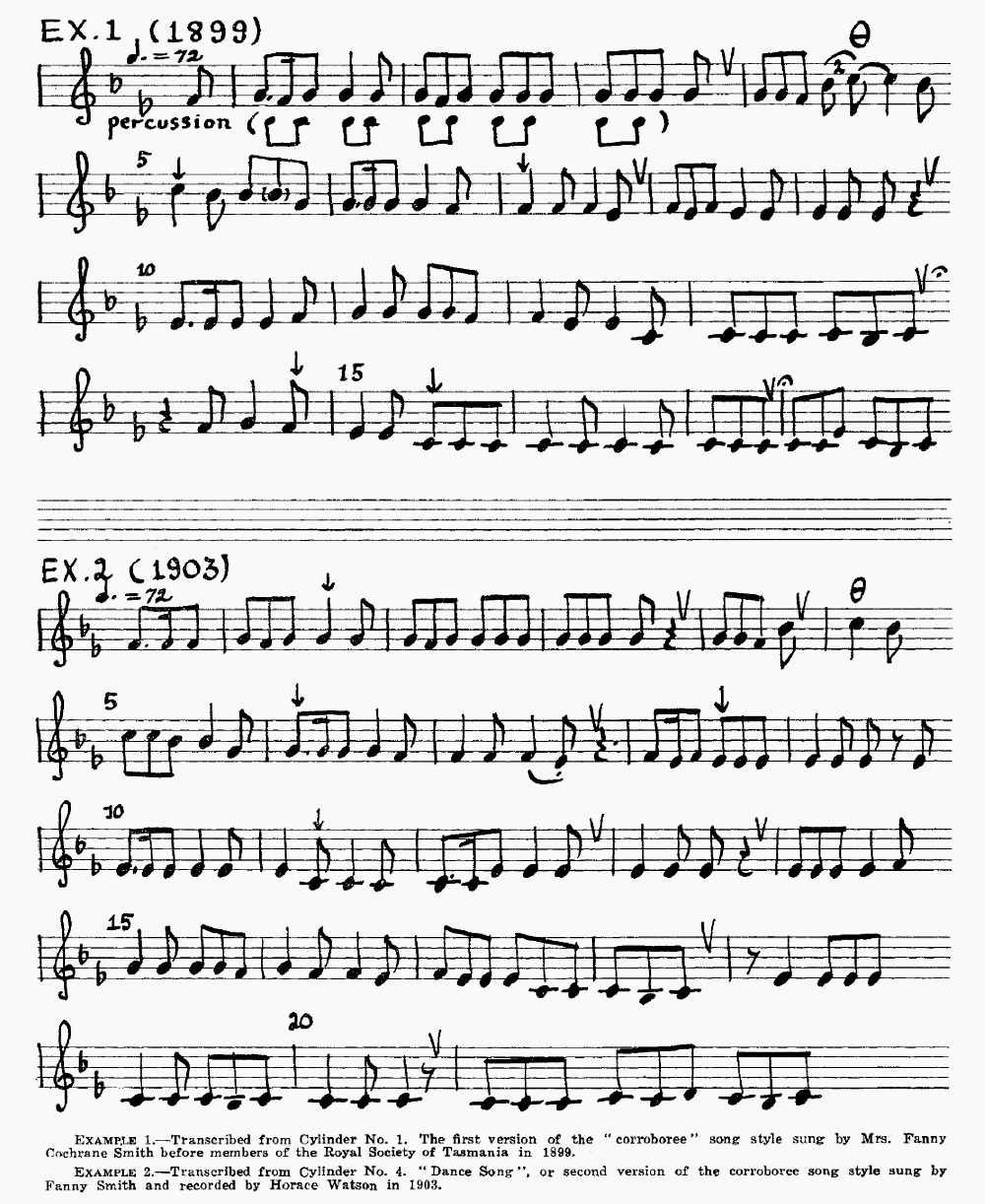
Above, Alice Moyle's transcriptions of Popela version A from cylinder 1 (1899) and version B from cylinder 4 (1903), first published in Moyle 1960, 76
http://eprints.utas.edu.au/14095 (DIGITISED)
Reproduced here by kind permission of her estate © 1960, 2016
See also Canberra, AIATSIS, Alice Moyle Collection, MS 3501
http://aiatsis.gov.au/sites/default/files/catalogue_resources/MS3501.htm
Moyle also prints (example 3, page 77) the melody line of one of the copies of the Maria Logan (1836) transcription.
Moyle 1968, 11
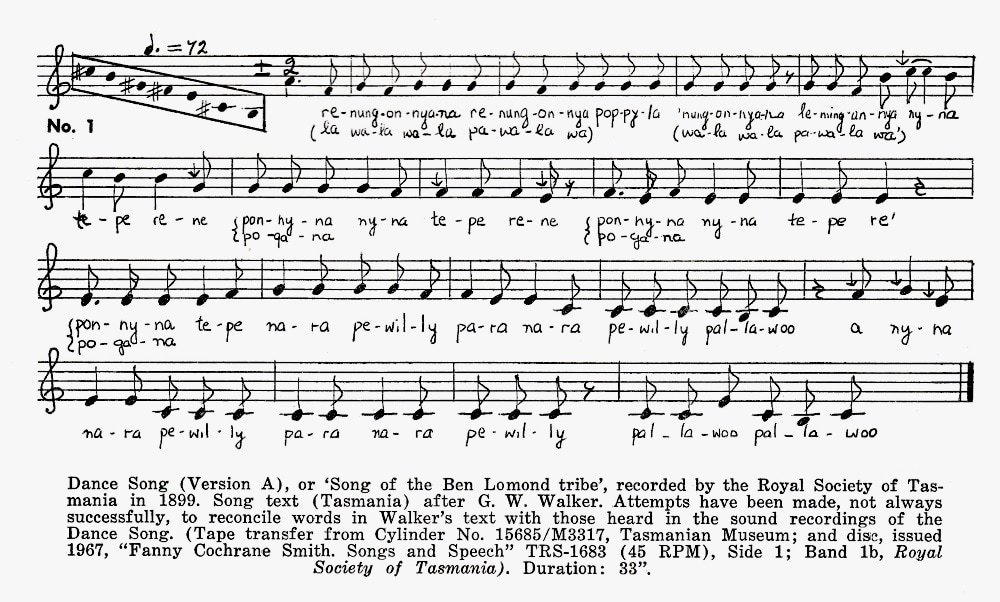
Above, Alice Moyle's 1968 transcription of Popela version A from cylinder 1 (1899), first published in Moyle 1968, 11
Reproduced here by kind permission of her estate © 1968, 2016
See also Canberra, AIATSIS, Alice Moyle Collection, MS 3501
http://aiatsis.gov.au/sites/default/files/catalogue_resources/MS3501.htm
Popela version B
Sung by Fanny Cochrane Smith, recorded by Horace Watson, Barton Hall, Sandy Bay, Hobart, TAS, 10 October 1903
Cylinder 4 (Tasmanian Museum and Art Gallery, 15688/M3320)
Longman 1960, 81
http://eprints.utas.edu.au/14096 (DIGITISED)
This cylinder is complete and in fair condition. Fanny Smith, introduced by Horace Watson, sings the "Corroboree Song". Particulars of the recording are given by Horace Watson and Fanny Smith makes a final statement.
"This record by Fanny Smith, daughter of Tangnarootoora, presents the song of the natives, when holding their corroboree, who endeavour to sing with all their might, accompanied by the beating of sticks and skins. This is a dance song by Fanny Smith."
Fanny Smith now sings the "Corroboree Song" in the Tasmanian language.
Pāpĕla rene nūena ne rene ne pāpĕla rene nūena ne rene ne
Löga menxa leā
Tóka menxa menxa leā
Tóka menxa menxa leā
Tóka menxa menxa leā
Tóka menxa menxa leā
Tóka menxa nára pewylā pālā nára pewylā pálawā pálawā
Nina nára pewyla pālā nára pewylā pálawā pálawā.
Horace Watson continues with details of the recording.
"This record was taken on October the tenth, 1903, by Horace Watson, Sandy Bay, Hobart, Tasmania".
Fanny Smith concludes by stating:--
"I am the last of the race, a Tasmanian. I am, I am the daughter of Tangnarootoora, of the East Coast Tribe. I am just seventy years of age".
Moyle 1960, 76
See Moyle's 1960 transcription of version B in image above with version A
Moyle 1968, 12
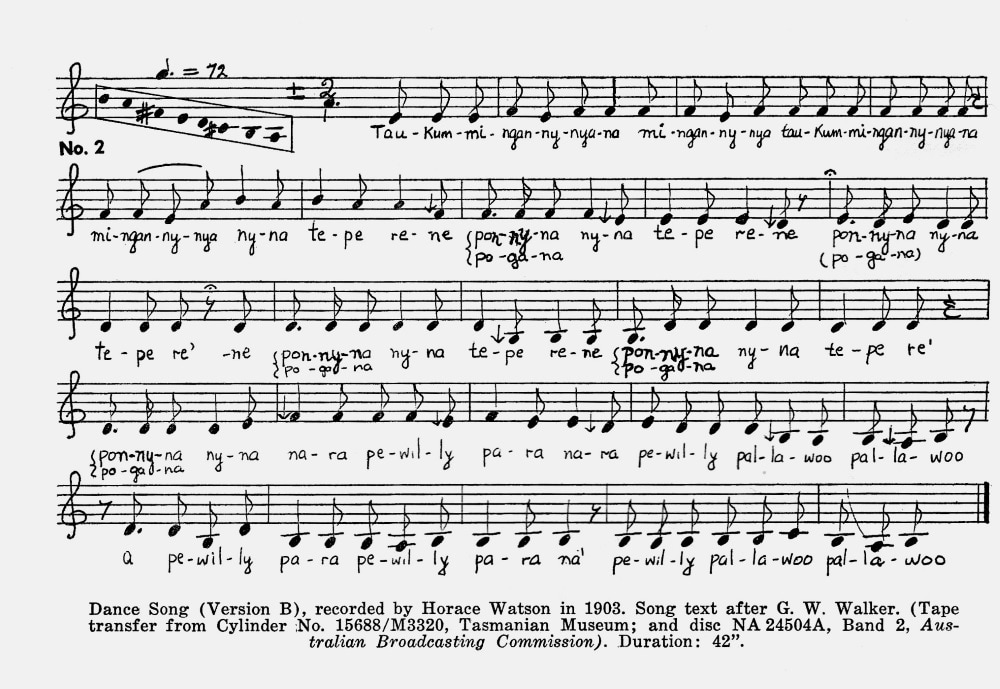
Above, Alice Moyle's 1968 transcription of Popela version B from cylinder 4 (1903), first published in Moyle 1968, 12
Reproduced here by kind permission of her estate © 1968, 2016
See also Canberra, AIATSIS, Alice Moyle Collection, MS 3501
http://aiatsis.gov.au/sites/default/files/catalogue_resources/MS3501.htm
Popela version C
Sung by Fanny Cochrane Smith, recorded by Horace Watson, Barton Hall, Sandy Bay, Hobart, TAS, 8 or 10 October 1903
Cylinder 6 (Tasmanian Museum and Art Gallery, 15690/M3322)
Longman 1960, 81
http://eprints.utas.edu.au/14096 (DIGITISED)
This cylinder, which was shattered into six large pieces and many small fragments, is a recording of abbreviated forms of the" Corroboree" and "Spring Songs". Each song is introduced by Horace Watson. As the repaired cylinder could only be played once, no correction for speed could be applied, and so the speech is distorted. The numerous cracks make interpretation even more difficult and only a few phrases can be distinguished.
"This record by Mrs. Fanny Smith, daughter of Tangnarootoora presents the song of the natives, when holding their corroboree, who endeavour to sing with all their might accompanied by the beating of sticks and skins."
Fanny Smith sings the "Corroboree Song"
Horace Watson introduces the second song.
". . . . daughter of Tangnarootoora . . . . song of the . . . . welcoming the advent of birds and flowers".
Fanny Smith now sings the" Spring Song".
Moyle 1968
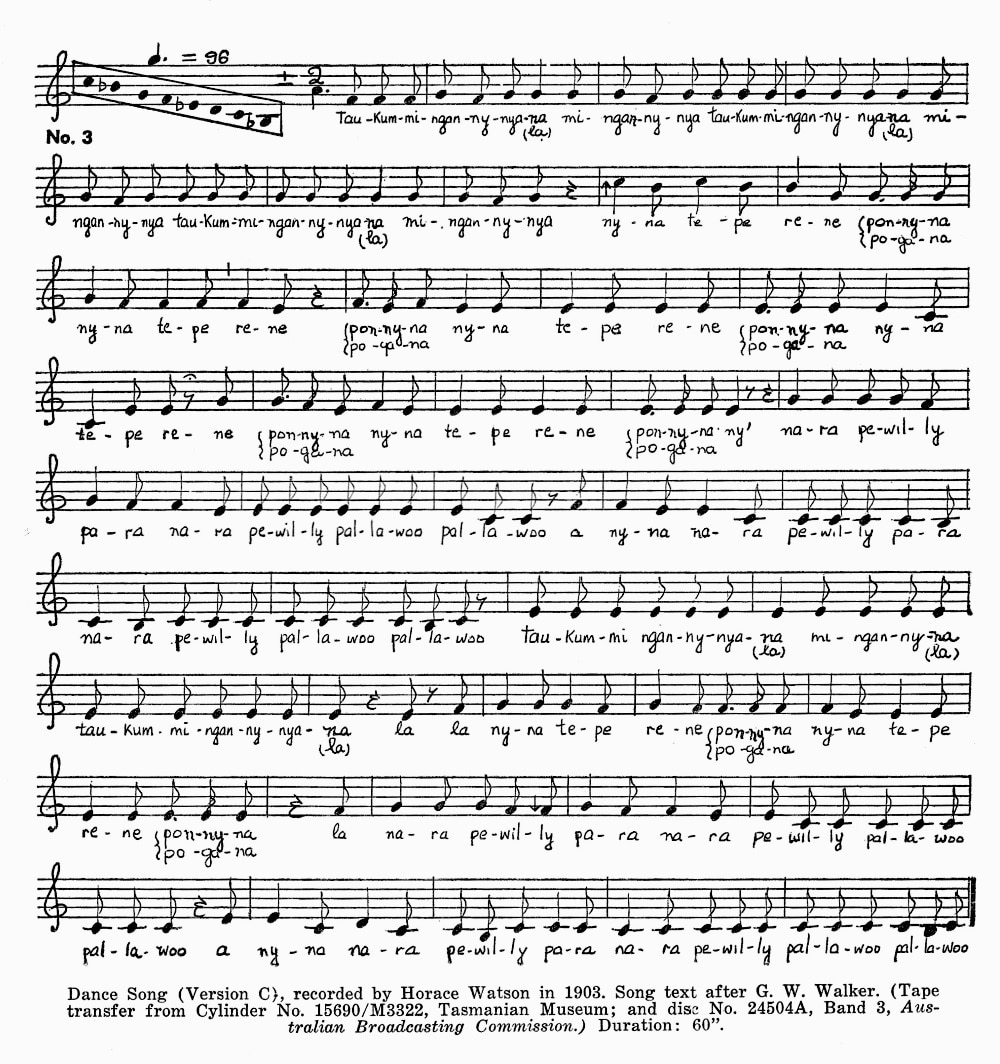
Above, Alice Moyle's 1968 transcription of Popela version C from cylinder 6 (1903), first published in Moyle 1968, 13
Reproduced here by kind permission of her estate © 1968, 2016
See also Canberra, AIATSIS, Alice Moyle Collection, MS 3501
http://aiatsis.gov.au/sites/default/files/catalogue_resources/MS3501.htm
32.2 Spring song
Text and gloss (without repetitions)
Longman 1960, 84
http://eprints.utas.edu.au/14096 (DIGITISED)
Niggur luggamto pawê,
It wattle blossom time
It's spring-time,
Punnamunnakanna,
bird whistle
The birds are whistling,
Luggarato pawê tutta watta,
spring come
Spring has come,
Warrena pallunubranah,
cloud sun
The clouds are all sunny,
. . . .
The Fuschia is out at the top,
Punna munnakanna,
bird whistle
The birds are whistling,
. . . . rialangana,
. . . . dance
Everything is dancing,
. . . . luggarato pawe
. . . . spring-time
Because it's spring-time,
. . . . rialanganna,
. . . . dance
Everything is dancing,
Luggarato luggarato luggarato,
spring spring spring
Because it's spring-time.
32.2 "Spring song"
text: A le di:-- gu:-- la:-- ga a da-ŋa
mi-a pa-la a mi-e- -a mi:-e-a lu:-- pa-du-da ŋa
a mi: mi-e-a ŋu: lu:-- da-ŋa a la mi:-a mi-a ŋu-ma
a da-ŋa a ga:-- mi-a-a lu:-- gu-la-ŋa a-a
a da mi-a du mi: a gu:-la a la mi-e-a ma
a mi: za-li-a-gu-la a ga-li-a ma-na (transcription from Moyle 1968, 14)
gloss: Spoken by Mrs. Fanny Cochrane Smith (from Moyle 1968, 8):
It's Spring time,
The birds is whistling,
The spring is come,
The flowers are all budding,
The (red) fuschia is on the top,
Birds are whistling,
Everything is pretty
'cause it's spring,
(The birds are still dancing)
For the springtime
analytics: As for 32.1
Spring song version A
Sung by Fanny Cochrane Smith, recorded by Horace Watson, Hobart, TAS, 5 August 1899
Cylinder 2 (Tasmanian Museum and Art Gallery, 15686/M3318)
Longman 1960, 80
http://eprints.utas.edu.au/14096 (DIGITISED)
There are frequent repetitions and omissions caused by the large cracks in this record interfering with the correct tracking of the stylus. The cylinder is broken into three large pieces and numerous small fragments.
Fanny Smith translates the "Spring Song" and concludes by singing this song in the Tasmanian language.
"It's spring time,
The birds is whistling,
The spring is come,
The clouds are all sunny,
The fuchsia is out at the top,
The birds are whistling,
Everything is dancing,
Because it's springtime,
Everything is dancing,
Because it's springtime".
Fanny Smith now sings:
Niggur luggarato pawê,
Punna mannakanna,
Luggarato pawê tutta watta,
Warrena pallanubranah,
. . . . ,
Punna munnakanna,
. . . . rialangana,
. . . . luggarato pawê,
. . . . rialangana,
Luggarato luggarato luggarato.
Mary Miliano, "A description of the cylinder recordings of Fanny Cochrane Smith established from papers in the Alice Moyle Collection (AIATSIS MS 3501) and audition of copies of recordings held at the National Film and Sound Archive (unpublished checklist: Canberra: NFSA, 2007)
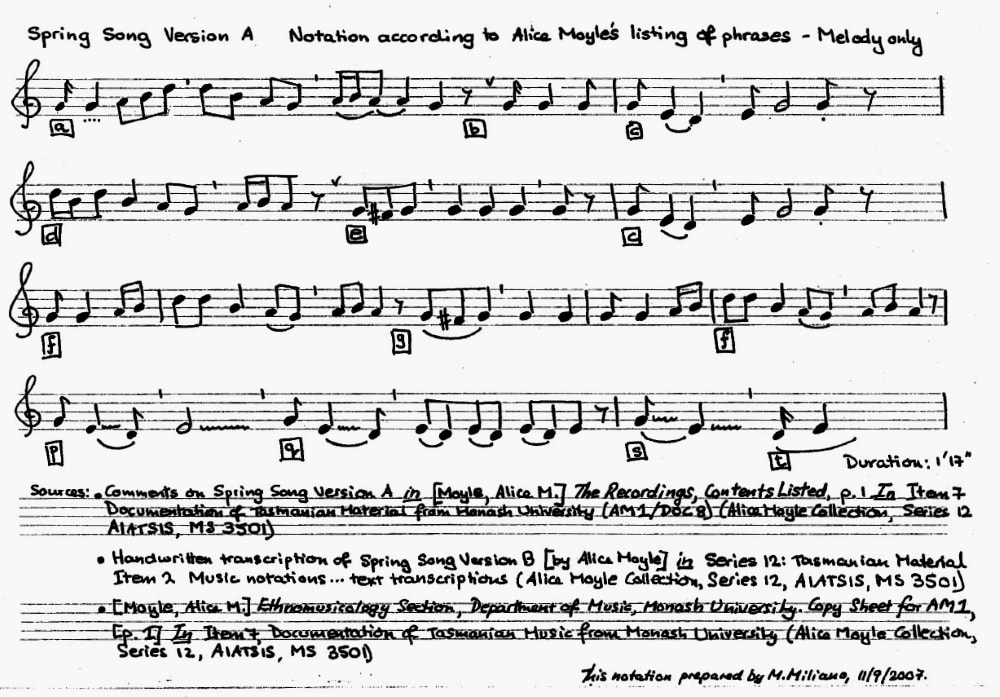
Above, Mary Miliano's reconstruction from Alice Moyle's papers, of her transcription of Spring Song version A from cylinder 2 (1899)
Reproduced here by kind permission of Alice Moyle's estate © 1960, 1968, 2007, 2016; Mary Miliano; National Film and Sound Archive
See also Canberra, AIATSIS, Alice Moyle Collection, MS 3501
http://aiatsis.gov.au/sites/default/files/catalogue_resources/MS3501.htm
Spring song version B
Sung by Fanny Cochrane Smith, recorded by Horace Watson, Barton Hall, Sandy Bay, Hobart, TAS, 8 October 1903; Cylinder 5 (Tasmanian Museum and Art Gallery, 15689/M3321); streamed on Vimeo
https://vimeo.com/58494880 (STREAMED)
Longman 1960, 81
http://eprints.utas.edu.au/14096 (DIGITISED)
After an introduction by Horace Watson Fanny Smith sings the Spring Song". About twelve words from the end of the song are missing, because a large piece, broken off the cylinder has been lost.
"This record of Mrs. Fanny Smith, sister of Mary-Ann, wife of Walter Arthur and daughter of Tangnarootoora, presents the song of the aborigines at the time of the spring, welcoming the advent of the birds and flowers".
Fanny Smith now sings the "Spring Song" in the Tasmanian language.
Niggur luggarato pawê,
Punna munnakanna,
Luggarato pawê tutta watta,
Warrena pallanubranah . . . .
The record is broken at this point.
Cylinder 7 (Tasmanian Museum and Art Gallery, 15691/M3323), a re-recording from cylinder 5 above made by Watson for Robert Hall, curator of the Tasmanian Museum
Longman 1960, 84
http://eprints.utas.edu.au/14096 (DIGITISED)
Made from hard black material similar to commercial records, this cylinder is complete and in good condition. Horace Watson introduces Fanny Smith, who sings the" Spring Song" and he concludes by giving details of the recording.
"This record of Mrs. Fanny Smith, sister of Mary Ann, wife of Walter Arthur and daughter of Tangnarootoora presents the song of the aborigines at the time of the spring welcoming the advent of birds and flowers."
Fanny Smith now sings the complete version of the "Spring Song".
Niggur luggarato pawê,
Punna munnakanna,
Luggarato pawê tutta watta,
Warrena pallanubranah,
. . . .,
Punna munnakanna,
. rialangana,
. luggarato pawê,
. . . . rialangana,
Luggarato luggarato luggarato.
Horace Watson now states the details of the recording:
"This record was taken on October the eighth, 1903, by Watson, Barton Hall, Sandy Bay, Tasmania. This record was taken off the original . . . ."
Moyle 1960, 78
http://eprints.utas.edu.au/14095 (DIGITISED)
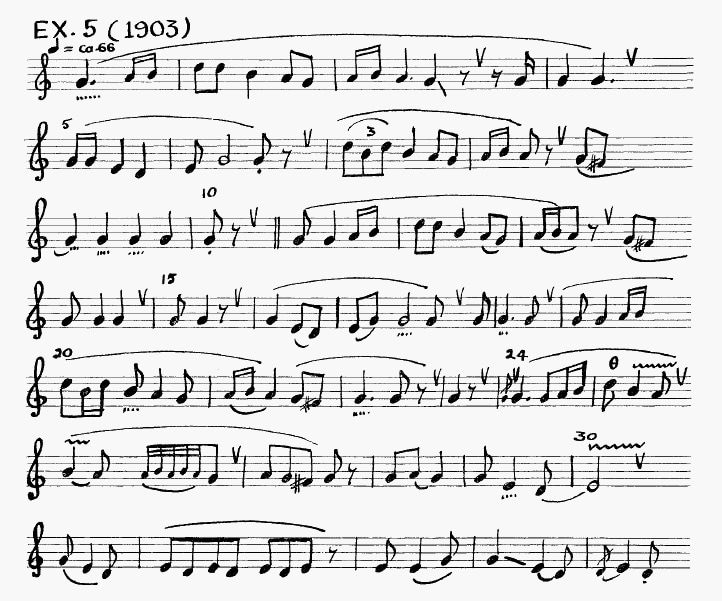
Above, Alice Moyle's 1960 transcription of Spring song version B from cylinder 7, first published in Moyle 1960, 78
http://eprints.utas.edu.au/14095 (DIGITISED)
Reproduced here by kind permission of her estate © 1960, 2016
See also Canberra, AIATSIS, Alice Moyle Collection, MS 3501
http://aiatsis.gov.au/sites/default/files/catalogue_resources/MS3501.htm
Moyle 1968, 14
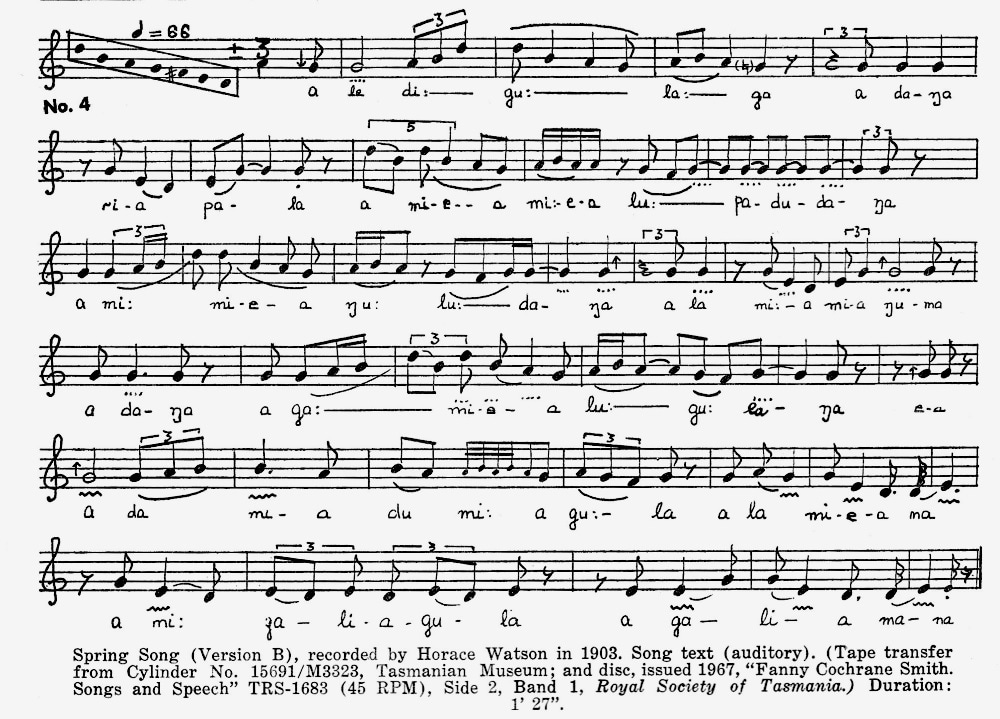
Above, Alice Moyle's 1968 transcription of Spring Song version B from cylinder 7 (1903)
Reproduced here by kind permission of her estate © 1968, 2016
See also Canberra, AIATSIS, Alice Moyle Collection, MS 3501
http://aiatsis.gov.au/sites/default/files/catalogue_resources/MS3501.htm
Spring song ? version C
Sung by Fanny Cochrane Smith, recorded by Horace Watson, Barton Hall, Sandy Bay, Hobart, TAS, 8 or 10 October 1903
Cylinder 6 (Tasmanian Museum and Art Gallery, 15690/M3322)
Longman 1960, 81
http://eprints.utas.edu.au/14096 (DIGITISED)
This cylinder, which was shattered into six large pieces and many small fragments, is a recording of abbreviated forms of the "Corroboree" and "Spring Songs". Each song is introduced by Horace Watson. As the repaired cylinder could only be played once, no correction for speed could be applied, and so the speech is distorted. The numerous cracks make interpretation even more difficult and only a few phrases can be distinguished.
This record by Mrs. Fanny Smith, daughter of Tangnarootoora presents the song of the natives, when holding their corroboree, who endeavour to sing with all their might accompanied by the beating of sticks and skins.
Fanny Smith sings the "Corroboree Song"
Horace Watson introduces the second song.
. . . . daughter of Tangnarootoora . . . . song of the . . . . welcoming the advent of birds and flowers.
Fanny Smith now sings the "Spring Song".
32.3 Hymn
32.3 "Hymn - Praise the Lord"
text: Praise the Lord, / Hail the Lord, / Abide in Heaven above.
analytics: As for 32.1
Cylinder 8 (Tasmanina Museum and Art Gallery, 15692/M3324)
Copy of original cylinder (8 October 1903, ? lost), made by Watson for Robert Hall, 6 May 1909
Longman 1960, 84
http://eprints.utas.edu.au/14096 (DIGITISED)
This cylinder has one crack along its entire length and another at the beginning. The condition is very poor and many words are completely distorted because of the larger crack. Fanny Smith introduced by Horace Watson, commences to sing a hymn, but after the first few phrases reverts to the aboriginal style of singing. Details of the recording are given at the end by Horace Watson.
This record, sung by Mrs. Fanny Smith, the daughter of Tangnarootoora of the East Coast Tribe.
"Praise the Lord,
Hail the Lord,
Abide in Heaven above."
Fanny Smith now commences to sing this hymn. but quickly reverts to the aboriginal style of singing. The only recognisable phrase is "Praise the Lord". Horace Watson now concludes:
"This record was made for me by Fanny Smith in 1903. We had a real excellent time here. You will see the photograph taken in the very action of singing. This record was taken from the original on May the sixth, 1909, for Mr. Robert Hall, Curator of the Tasmanian Museum by Horace Watson Sandy Bay."
Moyle 1968, 14
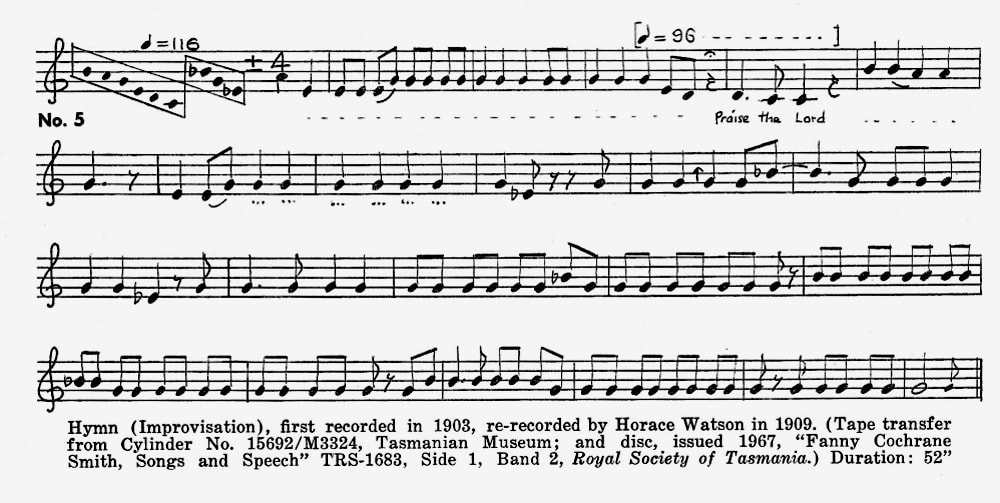
Above, Alice Moyle's 1968 transcription of Hymn from cylinder 8 (1903)
Reproduced here by kind permission of her estate © 1968, 2016
See also Canberra, AIATSIS, Alice Moyle Collection, MS 3501
http://aiatsis.gov.au/sites/default/files/catalogue_resources/MS3501.htm
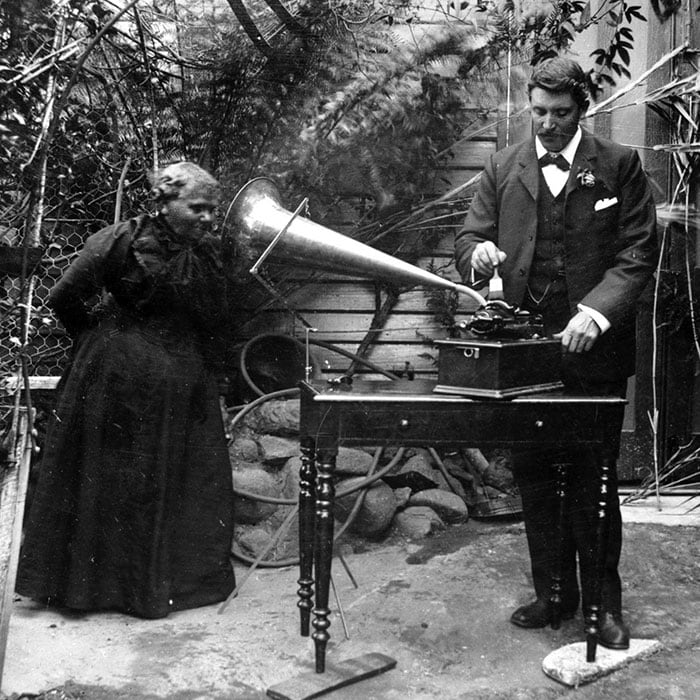
Fanny Cochrane Smith and Horace Watson, 1903 recording session (Tasmanian Museum and Art Gallery)
Documentation:
James Barnard, "Notes on the last living Aboriginal of Tasmania" [paper read 9 September 1889], Papers & Proceedings of the Royal Society of Tasmania (1889), 60-64
http://eprints.utas.edu.au/15729 (DIGITISED)
http://handle.slv.vic.gov.au/10381/168361 (DIGITISED)
"LOVETT", Tasmanian News (7 April 1899), 3
http://nla.gov.au/nla.news-article176605899
In Harvey's Hall, on the same evening [3 April], the members of the local Wesleyan Church tendered a farewell social to their departing pastor and his wife . . . During the evening there was some good music, and amongst the items was a Tasmanian aboriginal song, sung in the native dialect by Mrs. Smith, sen., of Irish Town, which was very amusing . . .
"THE LAST OF HER RACE", Tasmanian News (25 October 1899), 2
http://nla.gov.au/nla.news-article185227025
Andrew Kirk, [Letter to the editor], "THE LAST OF THE TASMANIANS", Tasmanian News (1 November 1899), 3
http://nla.gov.au/nla.news-article185227458
"ABORIGINAL SONGS", Daily Post (21 November 1908), 10
http://nla.gov.au/nla.news-article181621319
"Aboriginal Recordings. VOICE OF EXTINCT PEOPLE LIVES ON IN MEMORY AND WAX", The Mercury (23 March 1949), 5
http://nla.gov.au/nla.news-article26511589
See also:
https://trove.nla.gov.au/search?l-publictag=Fanny+Cochrane+Smith (TROVE public tag)
Bibliography:
Murray Longman, "Songs of the Tasmanian aborigines as recorded by Mrs. Fanny Cochrane Smith", Papers and Proceedings of the Royal Society of Tasmania 94 (1960), 79-86
http://eprints.utas.edu.au/14096 (DIGITISED)
Alice Moyle, "Two native song-styles recorded in Tasmania", Papers and Proceedings of the Royal Society of Tasmania 94 (1960), 73-78
http://eprints.utas.edu.au/14095 (DIGITISED)
Alice M. Moyle, "Tasmanian music, an impasse?", Records of the Queen Victoria Museum, Launceston 26 (May 1968), 1-10
http://www.qvmag.tas.gov.au/qvmag/index.php?c=160
J. Clark, "Smith, Fanny Cochrane (1834-1905)", Australian dictionary of biography 11 (1988)
http://adb.anu.edu.au/biography/smith-fanny-cochrane-8466
Cassandra Pybus, "Oyster Cove 1988" [Aboriginal history associated with Oyster Cove], Meanjin 47/4 (Summer 1988), 583
https://search.informit.org/doi/abs/10.3316/informit.582082056939065 (PAYWALL)
Graeme Skinner, Toward a general history of Australian musical composition: first national music, 1788-c.1860 (Ph.D thesis, Sydney Conservatorium of Music, University of Sydney, 2011), 127, 442
http://hdl.handle.net/2123/7264 (DIGITISED)
Martin Thomas, "The rush to record: transmitting the sound of Aboriginal culture", Journal of Australian Studies 90 (2007), 107-21
https://doi.org/10.1080/14443050709388114 (PAYWALL)
Graeme Skinner, "Recovering musical data from colonial era transcriptions of Indigenous songs: some practical considerations", in Jim Wafer and Myfany Turpin (eds), Recirculating songs: revitalising the singing practices of Indigenous Australia (Canberra: Asia-Pacific Linguistics, 2017), 354-61
http://hdl.handle.net/1885/132161
https://openresearch-repository.anu.edu.au/bitstream/1885/132161/25/16_skinner.pdf (DIGITISED)
Graeme Skinner and Jim Wafer, "A checklist of colonial era musical transcriptions of Australian Indigenous songs", in Jim Wafer and Myfany Turpin (eds), Recirculating songs: revitalising the singing practices of Indigenous Australia (Canberra: Asia-Pacific Linguistics, 2017), 388-89, 413-15
http://hdl.handle.net/1885/132161
https://openresearch-repository.anu.edu.au/bitstream/1885/132161/26/17_skinner_wafer.pdf (FREE DOWNLOAD)
"Fanny Cochrane Smith", Wikipedia
https://en.wikipedia.org/wiki/Fanny_Cochrane_Smith
Other sources:
Cylinder recordings of Fanny Cochrane Smith; The Alice Moyle Collection, papers; AIATSIS
https://trove.nla.gov.au/work/32185927
Norman Tindale, papers, documentation for speech and sound recordings; SA Museum
https://www.samuseum.sa.gov.au/collection/archives/provenances/series/aa338-12
Video and other online resources:
The Tasmanian magazine, no. 5 (1960) (streamed by Libraries Tasmania on Youtube), segment on Smith recordings from 2:22
https://youtu.be/rbOS3pW3VWM?t=142 (STREAMED)
[Australia] "#53. Fanny Cochrane Smith wax cylinder recordings", Memory of the world, UNESCO National Committee of Australia (2017)
http://www.amw.org.au/register/listings/fanny-cochrane-smith-wax-cylinder-recordings
Tasmanian Heritage on UNESCO Register, Tasmanian Museum & Art Gallery
https://www.tmag.tas.gov.au/whats_on/newsselect/2017articles/tasmanian_heritage_on_unesco_register
Rhainnon Shine, "Fanny Cochrane Smith's Tasmanian Aboriginal songs and language preserved forever", ABC NEWS (9 February 2017)
No. 39, Fanny Cochrane Smith recordings - songs of survival, Shaping Tasmania: a journey in 100 objects; Tasmanian Museum & Art Gallery
https://shapingtasmania.tmag.tas.gov.au/object.aspx?ID=39
1901
33 7 songs
Lower Arrernte ("Arunta"), Stevenson's Creek, SA, and Charlotte Waters, NT
Sound recordings made by Baldwin Spencer, March-April 1901
Music only transcriptions of 33.1-3 made from recordings by Percy Grainger in Melbourne in 1909, versions of 2 of these, 33.3 and 33.1, published by Spencer and F. J. Gillen 1912
https://sydney.edu.au/paradisec/australharmony/checklist-indigenous-music-1.php#033 (shareable link to this entry)
33.1 Song the Erkita corroboree (altharte aremaye)
33.1 "Song of the Erkita corroboree"
text: Tangaramba/ Ibitalbita (T. G. H. Strehlow transcription, published in Gibson 2015, 171)
gloss: "Bob Rubuntja confidently explained to Strehlow that the verse was part of the altharte Aremaye, a type of large sand goanna song series from a place in Warlpiri territory known as Puturlu (Mt. Theo) and although not being able to provide a meaning, claimed the verse was: angaramba/Ibitalbita" (Gibson 2015, 171).
analytics: Stevenson River, northern SA (region); CA (music region); Central PN/ Arandic/ Arrernte (language)
commentary: There is a manuscript (1909) musical transcription of this song by Percy Grainger, the first of two under the title "Native Australian tunes". Spencer and Gillen (1912 v.2, 502) subsequently published a version of Grainger's transcription (the second of two in their appendix to volume 2). Gibson (2015, 171) has traced the language of this song (and the next one) to Anmatyerr (an Arandic language that lies to the north-west of Central Arrernte).
33.2 Song of the Ilyarnpa corroboree
33.2 "Song of the Ilyarnpa corroboree"
analytics: As for 33.1
gloss: "Upon first hearing the recording Bob Rubuntja confidently attributed the verse to an Altharte Atnyemayte (witchetty grub dance) from the Anmatyerr estate of Arlekwarr ('Lukara' in Strehlow's spelling) (Gibson 2015, 171).
commentary: There is a manuscript (1909) musical transcription of this song by Percy Grainger, the second of two under the title "Native Australian tunes". Gibson (2015, 171) has traced the language of this song (and the previous one) to Anmatyerr.
Sources (33.1-2):
Recording by Baldwin Spencer, from an Arunta singer, Stevenson's Creek, SA, 22 March 1901 (Royal Geographical Society of South Australia, RGSSA01; streamed by Museum Victoria)
http://spencerandgillen.net/objects/4fac6982023fd704f475b5dc (SOUND FILE)
0:00 - Dub spoken identification
0:46 - Spencer's spoken identification
1:15 - 33.1
2.44 - Spencer's spoken introduction to
2:55 - 33.2
Music only transcription (MS) by Percy Grainger, Melbourne 1909 (Museum Victoria)
http://spencerandgillen.net/objects/50ce72f5023fd7358c8a957d (DIGITISED = image 2)
G1 = 33.1
G2 = 33.2
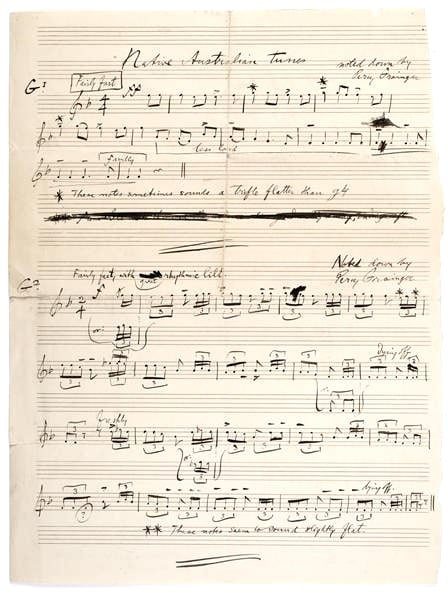
Baldwin Spencer and F. J. Gillen, Across Australia (London: Macmillan and Co., 1912), volume 2, 502
https://archive.org/stream/acrossaustralia02spen#page/n545/mode/2up (DIGITISED)
II = 33.1
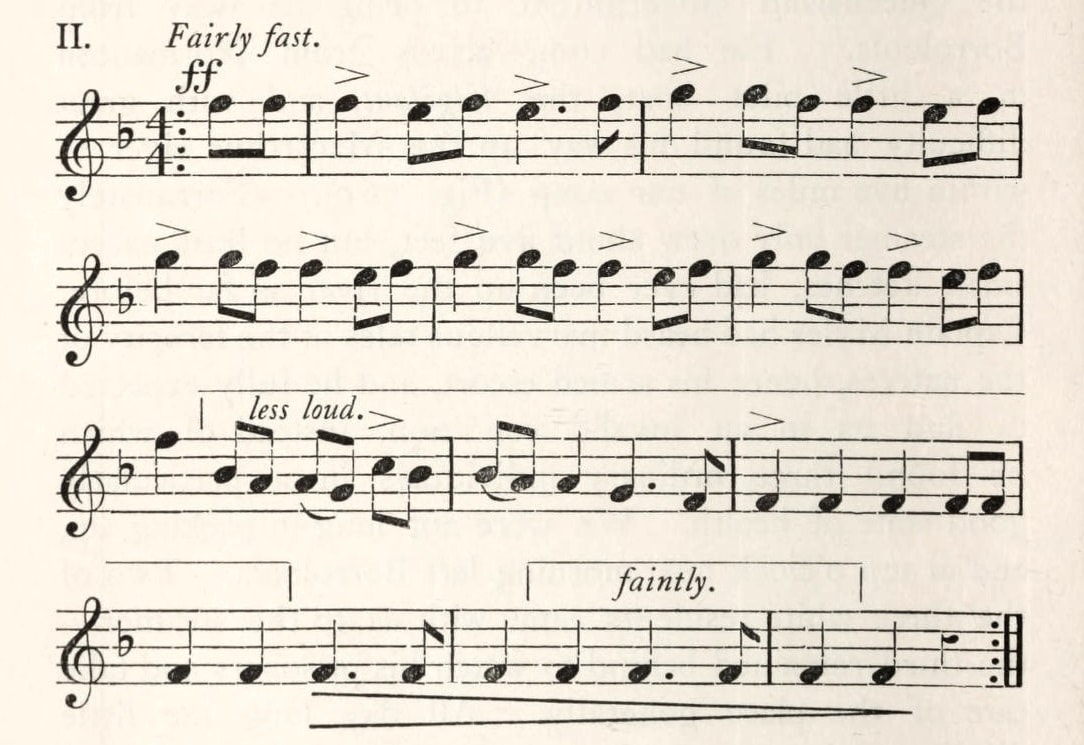
33.3 Song of the Chitchingalla (Tjitjingalla) corroboree (Molonga/Mudlunga)
33.3 "Song of the Chitchingalla corroboree"
text: Tjantjirtjantjirla/ walamburbmarei (T. G. H. Strehlow transcription, published in Gibson 2015, 170-171)
gloss: "The text of the recorded verse was, according to Strehlow antjirtjantjirla/walamburbmarei; however, none of his informants knew the meaning of the verse words as it originated from far to the north and was sung in a foreign language . . . All three of his main informants did however know this song and dance as the altharte 'molunga'" (Gibson 2015, 171) - that is, the "Molonga Set of Corrobborees", so named by Roth (1897, 120), who notes: "The meaning of the word Molonga (cf. Pitta-Pitta mo-ma) is difficult to interpret in European fashion. It hardly corresponds with our conception of the 'devil,' and yet at the same time it does signify an evil-doer from whom mischief may be expected" Roth (1897, 121). (See also Hercus 1980.)
analytics: As for 33.1
commentary: There is a manuscript (1909) musical transcription of this song by Percy Grainger, to which he has given the title "Dadji dadji" (possibly his interpretation of the opening words of the song); Spencer and Gillen (1912 v.2, 502) subsequently published a version of Grainger's transcription (the first of two in their in their appendix to volume 2); Gibson (2015, 170) has traced the language of this song to Wakaya or Wambaya
Sources:
Recording by Baldwin Spencer, from an Arunta singer, Stevenson's Creek, SA, 22 March 1901 (Royal Geographical Society of South Australia, RGSSA02; streamed by Museum Victoria)
http://spencerandgillen.net/objects/4fac699d023fd704f475b641 (SOUND FILE)
0:00 Spencer's announcement:
This corroboree, the Tjitjingalla corroboree, was first described by Dr. Roth in north central Queensland. Subsequently was performed by the natives of central Australia [?] the Arrernte tribe at Alice Springs. This corroboree was sung on the Stevenson River on March the 22nd, 1901.
0:40 Song
Music only transcription (MS) by Percy Grainger, Melbourne 1909 (Museum Victoria)
http://spencerandgillen.net/objects/50ce72f5023fd7358c8a957d (DIGITISED = image 1)
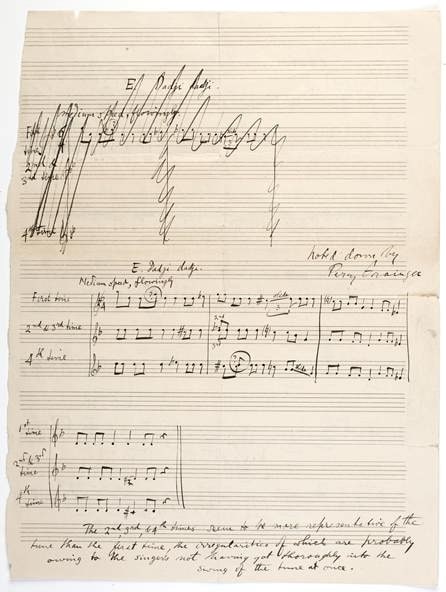
Dadji dadji - Medium speed, flowingly . . . The 2nd, 3rd, & 4th times seem to be more representative of the tune than the first times, the singularities of which are probably owing to the singer's not having got thoroughly into the swing of the tune at once.
Spencer and Gillen 1912, volume 2, 502
https://archive.org/stream/acrossaustralia02spen#page/n545/mode/2up (DIGITISED)
I = 33.3
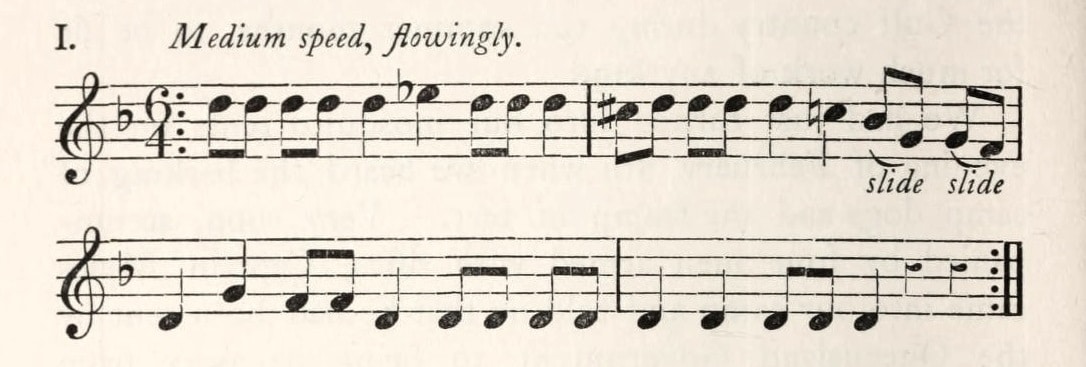
33.4-5 2 songs
Two songs sung by women at Charlotte Waters, NT
33.4 "2 songs sung by women [1]"
text: Maljatatjeire/ tambirrkula (T. G. H. Strehlow transcription, published in Gibson 2015, 174; unclear which of the two women's songs this text relates to)
analytics: Charlotte Waters, southern NT (region); CA (music region); Central PN/ Arandic/ Arrernte (language)
commentary: Gibson (2015, 174) has traced the language of these 2 songs to Warumungu
33.5 "2 songs sung by women [2]"
analytics: As for 33.4
commentary: As for 33.4
Source:
Recording by Baldwin Spencer, Charlotte Waters, NT, 29 March 1901 (Royal Geographical Society of South Australia, RGSSA07; streamed by Museum Victoria)
http://spencerandgillen.net/objects/4fac699f023fd704f475b64d (SOUND FILE)
33.6 Another song
Another song sung by the same women on the same occasion, Charlotte Waters, NT, 29th March 1901
33.6 "Another song sung by the same women on the same occasion"
analytics: As for 33.4
Source:
Recording by Baldwin Spencer, Charlotte Waters, NT, 29 March 1901 (Royal Geographical Society of South Australia, RGSSA28; streamed by Museum Victoria)
http://spencerandgillen.net/objects/4fac6984023fd704f475b5ec (SOUND FILE)
33.7 Corroboree song (Arrernte)
No. 2 Corroboree song Arrernte tribe. Recorded at Charlotte Waters April 3rd 1901
33.7 "Corroboree song" (Arrernte)
analytics: As for 33.1
commentary: Unclear which corroboree this song comes from; if it is one of the two "totemic" verses (Gibson 2015, 174) recorded at Charlotte Waters on this date (3 April 1901), then the identities of the singers are available from Spencer's journal (Gibson 2015, 175-176)
Source:
Recording by Baldwin Spencer, Charlotte Waters, 3 April 1901 (Royal Geographical Society of South Australia, RGSSA46; streamed by Museum Victoria)
http://spencerandgillen.net/objects/4fac69a6023fd704f475b655 (SOUND FILE)
* * *
Bibliography:
W. E. Roth, Ethnological studies among the north-west-central Queensland Aborigines (Brisbane: E. Gregory, Government Printer, 1898), 120-25
https://archive.org/stream/cu31924029890328#page/n143/mode/2up (DIGITISED)
Baldwin Spencer, diary, 19 March to 30 June 1901 (State Library of New South Wales; streamed by Museum Victoria)
http://spencerandgillen.net/objects/4fac6ade023fd704f475bf21 (DIGITISED)
The above edited and transcribed by Jason Gibson and Heather Milton, Walter Baldwin Spencer's diary from the Spencer and Gillen expedition 1901-1902 ([Melbourne: Museum Victoria, n.d.])
http://spencerandgillen.net/files/Spencers%20Expedition%20Diary.pdf (DIGITISED)
[22 March 1901, page 57] At dusk 5 or 6 old natives came in and so we got our phonograph out and got them to sing corrobboree songs into it. They were very much excited and interested especially as we let them hear the instrument repeating what they had said. The phonograph is a beauty: it was given to us in Adelaide and we can both take records with it and repeat them as soon as they are taken . . . Gillen & myself felt quite happy to be amongst the blacks again & to hear the old corroboree songs once more and I don't know whether we or the natives were the more excited.
But, at this point in his edition of the expedition diaries (8, note 21), Jason Gibson pointed out that Spencer later passed on a quite different recollection of the playbacks that day to his daughter, Alline:
This nearly ended in disaster . . . my father played the songs back to the natives, who were horrified and ran for their lives. He never let them hear themselves again and I don't know how he calmed the fears of the first batch . . .
Baldwin Spencer, journal, March-April 1901 (Pitt Rivers Museum, Oxford; streamed by Museum Victoria)
http://spencerandgillen.net/objects/52af9d529821f4140411cfa0 (DIGITISED)
Spencer and Gillen, Tape copies of recordings of the 1901 expedition to Central Australia and accompanying correspondence, notes, etc. 1901-1980; University of Adelaide, Rare books and special collections, MSS 305.89915 S745A
https://www.adelaide.edu.au/library/special/mss/spencer_b/?m=tms (FINDING GUIDE)
Spencer and Gillen 1912, volume 2, 502
https://archive.org/stream/acrossaustralia02spen#page/n545/mode/2up (DIGITISED)
I = 33.3
II = 33.1
The above represent two airs of corrobboree songs noted down by Mr. Percy Grainger from phonograph records. They are indicated as correctly as it is possible to play them on a piano. The intervals are not strictly correct, as they can only be accurately produced by the human voice or a stringed instrument such as the violin. The same airs are repeated time after time.
Fred D. McCarthy, "Trade in Aboriginal Australia, and trade relationships with Torres Strait, New Guinea and Malaya" [part 2], Oceania 10/1 (September 1939), 83-85
http://www.jstor.org/stable/40327722 (PAYWALL)
Alice M. Moyle, "Sir Baldwin Spencer's recordings of Australian Aboriginal singing", Memoirs of the National Museum of Victoria 24 (1959), 9
http://www.biodiversitylibrary.org/item/120198#page/9/mode/1up (DIGITISED)
D. J. Mulvaney, '"The chain of connection": the material evidence', in Nicolas Peterson (ed.), Tribes and boundaries in Australia: ecology, spatial organisation and process in Aboriginal Australia (Canberra: Australian Institute of Aboriginal Studies, 1976), 90-92
Luise A. Hercus, '"How we danced the Mudlunga": memories of 1901 and 1902', Aboriginal History 4 (1980), 5-32:
http://press.anu.edu.au/wp-content/uploads/2016/01/article013.pdf (DIGITISED)
Tony Swain, "A new sky hero from a conquered land", History of Religions 29/3 (February 1990), 195-232, esp. 219, 229
http://www.jstor.org/stable/1062852 (PAYWALL)
Tony Swain, A place for strangers: towards a history of Australian Aboriginal being (Cambridge: Cambridge University Press, 1993), 219-33
AIATSIS, finding aid, BNA_03, Sound recordings collected by Baldwin Spencer, 1901 and 1912 (Prepared January 2010 by SL last updated 11 May 2010)
http://aiatsis.gov.au/sites/default/files/catalogue_resources/BNA_03_finding_aid.pdf (DIGITISED)
Dale Kerwin, Aboriginal dreaming paths and trading routes: the colonisation of the Australian economic landscape (Brighton: Sussex Academic Press, 2010), 104
Jason Gibson, Following the travelling Tjitjingalla, Museum Victoria, posted 9 September 2011; now only available at:
Jason Gibson, "Central Australian songs: a history and reinterpretation of their distribution through the earliest recordings", Oceania 85/2 (2015), 165-82
http://dx.doi.org/10.1002/ocea.5084 (PAYWALL)
Skinner 2017
Skinner and Wafer 2017
Other references (on Grainger's transcriptions):
Helen Griffiths [Helen Fairweather] (ed.), Percy Grainger and the arts of the Pacific [exhibition catalogue] (Melbourne: Grainger Museum, University of Melbourne, 1979), 28-30
https://trove.nla.gov.au/work/21339095
Kay Dreyfus (ed.), The farthest north of humanness: letters of Percy Grainger 1901-14 (Melbourne: Macmillan, 1985), 297-300
https://trove.nla.gov.au/work/17783706
https://books.google.com.au/books?id=gMWvCwAAQBAJ (PREVIEW)
Elinor Wrobel (ed.), Percy Grainger: the passionate folklorist and ethnomusicologist [exhibition catalogue] (Melbourne: Grainger Museum, University of Melbourne, [1994]), 51-52, 97
http://grainger.unimelb.edu.au/__data/assets/pdf_file/0004/2036659/PG_and_Folk_Music_catalogue.pdf
c.1900-01
34 6 songs
Dhurga ("Thoorga"), Ulladulla area, south coast NSW
Words transcribed by R. H. Mathews by 1900, first reported by Mathews and M. M. Everitt in a paper read in Sydney, 5 December 1900, published 1901
Music and words transcribed by R. H. Mathews by 1901, first reported by Mathews in a paper read in Brisbane, 28 November 1901, first published 1902
https://sydney.edu.au/paradisec/australharmony/checklist-indigenous-music-1.php#034 (shareable link to this entry)
Sources and documentation:
R. H. Mathews, The būnăn ceremony of New South Wales", The American Anthropologist 9/10 (October 1896), 327-44
http://onlinelibrary.wiley.com/doi/10.1111/aman.1896.A9.issue-10/issuetoc (DIGITISED)
Mathews 1902, 279 refers to the earlier descriptions of the ceremonies in this paper; no texts or music
R. H. Mathews and M. M. Everitt, "The organisation, language and initiation ceremonies of the Aborigines of the south-east coast of N. S. Wales", Journal and Proceedings of the Royal Society of New South Wales 34 (1900), 279-280
https://archive.org/stream/journalproceedi341900roya#page/279/mode/2up (DIGITISED)
Proceedings, printed in 1901, give the words of Dharamoolan's songs (279), 1 = 34.2, 2 perhaps = a variant or another verse of 34.1; 3 = 34.3; also words of two customary songs sung by the old women (280).
Early next day the boys are taken a little way from the bunnumbeal, and are shown a colossal horizontal image of Dharamoolan formed by heaping up the loose earth into human shape - his wife, on a smaller scale, lying near him. After that, one of the front upper incisors is punched out of each novice in succession. As the tooth is held up to public view, the men shout the names of remarkable places in the novice's country, and the totems of his family. The tooth is then handed to one of the boy's relatives who attaches it to his girdle. That evening at the camp, some of the old men, the bards of the tribe, chant Dharamoolan's songs, the words of which are as follows: -
1. Dhurram´ooloon gálay wir´rabroo gangá
Bágoon-bána goo-ranána mamarána.
2. Dhurram´oolunba nganboan´ya gówine mirreng´ga.
3. Ngalal'bo wallool'ma jil'ly jil'leen may ganga.
The following morning the bullroarers are shown to the novices, who are at the same time cautioned against revealing what they have seen and been taught, during their sojourn in the bush.
R. H. Mathews, "The Thoorga language", Queensland Geographical Journal 17 (1902), 61-63
https://archive.org/stream/queenslandgeogra15roya#page/n389/mode/2up (DIGITISED)
Music and words of 34.1-6
R. H. Mathews, "The Murawarri and other Australian languages", Queensland Geographical Journal 18 (1903), 64
https://archive.org/stream/queenslandgeogra15roya#page/n587/mode/2up (DIGITISED)
A Mystic or Secret Language.
. . . I wish to refer to a secret language, used by the men at the ceremonies of initiation, but which is never spoken in the presence of women, or in the presence of those youths who have not yet entered upon the prescribed course of instruction. Whilst the novitiates are away in the bush in charge of the elders of the tribe, they are taught a mystic name for surrounding objects, animals, parts of the human body, and short phrases of general utility. This language varies in different communities . . .
In an article on "Aboriginal Song's at Initiation Ceremonies" printed by this Society last year, I published several sacred songs in this secret tongue - the first songs of the kind ever set to music.
R. H. Mathews, Notes on the Aborigines of New South Wales (Sydney: Government Printer, 1907), 33-35 (music and words of nos 1-6)
https://archive.org/stream/notesonaborigine00math#page/33/mode/2up (DIGITISED)
Music and words of 34.1-6, with commentary, from Mathews 1902
34.1 Dharamooloon
34.1 "Dhurramooloon" ("Dharramooloon") [Bunân 1]
text: Dhurramooloon dhurramooloon binggilbee moondanuna gummerawarawa
gloss: "one of the songs chanted by the old men in the presence of the boys" at "the Bunân initiation ceremony" (Mathews 1902, 61)
analytics: Ulladulla area, south coast NSW (region); ECA (music region); South-eastern PN/ Yuin/ Dhurga (language)
Mathews 1902, 61
https://archive.org/stream/queenslandgeogra15roya#page/n389/mode/2up (DIGITISED)
Aboriginal Songs at Initiation Ceremonies.
In an article contributed to the Anthropological Society, of Washington, in 1896, I described the Bunân ceremony of initiation in force among the native tribes occupying the south-east coast of New South Wales from the Victorian boundary to Bulli, and extending inland from eighty to a hundred miles. Since then I have also described a preparatory inaugural rite, called the Kudsha, which is practised by the same people. This tract of territory includes the hunting grounds of all the tribes referred to in the present treatise.
In the papers referred to I have given the words of certain sacred songs used in the celebration of the ceremonies, but am now in a position to incorporate the music of some of them in this article. The words of one of the songs chanted by the old men in the presence of the boys are:-
Dhurramooloon, Dhurramooloon
Binggilbee moondanuna
Gummerâwarawâ
These words are droned monotonously ad libitum to the following music:

Mathews 1907, 33
https://archive.org/stream/notesonaborigine00math#page/33/mode/2up (DIGITISED)

34.2 Dharramooloonga
34.2 "Dhurramooloonga" ("Dharramooloonga") [Bunân 2]
text: Dharramooloonga gale wirrabroo ganga ngoorungga wirraleema
gloss: As for 34.1
analytics: As for 34.1
Mathews and Everitt 1900, 279
https://archive.org/stream/journalproceedi341900roya#page/279/mode/2up (DIGITISED)
1. Dhurram´ooloon gálay wir´rabroo gangá
Bágoon-bána goo-ranána mamarána.
Mathews 1902, 61
https://archive.org/stream/queenslandgeogra15roya#page/n389/mode/2up (DIGITISED)
Another song has the following words and music:
Dhurramooloonga gale wirrabroo ganga
Ngoorungga wirraleema.

Mathews 1907, 33
https://archive.org/stream/notesonaborigine00math#page/33/mode/2up (DIGITISED)

34.3 Ngalalbā
34.3 "Ngalalbā" [Bunân 3]
text: Ngalalbā walloolbā jilleejilleen
gloss: As for 34.1
analytics: As for 34.1
Mathews and Everitt 1900, 279
https://archive.org/stream/journalproceedi341900roya#page/279/mode/2up (DIGITISED)
3. Ngalal'bo wallool'ma jil'ly jil'leen may ganga.
Mathews 1902, 62
https://archive.org/stream/queenslandgeogra15roya#page/n391/mode/2up (DIGITISED)
The words and music of another song are:
Ngalalba walloolba jilleejilleen.
Text underlaying the music with diacritics:
Ngalalbā walloolbā jilleejilleen.

Mathews 1907, 34
https://archive.org/stream/notesonaborigine00math#page/34/mode/2up (DIGITISED)

34.4 Jilbarara
34.4 "Jilbarara" [Bunân 4]
text: Jil´barâra mur´ragadyah´ yam´ungad´yeenah´
gloss: "One of the songs used by the women in the morning during the time their sons are away with the chief men undergoing initiation" (Mathews 1902, 62)
analytics: As for 34.1
Mathews 1902, 62
https://archive.org/stream/queenslandgeogra15roya#page/n391/mode/2up (DIGITISED)
One of the songs used by the women in the morning during the time their sons are away with the chief men undergoing initiation is:-
Jil´barâra mur´ragadyah´
Yam´ungad´yeenah´
This song is sung to the following music:-
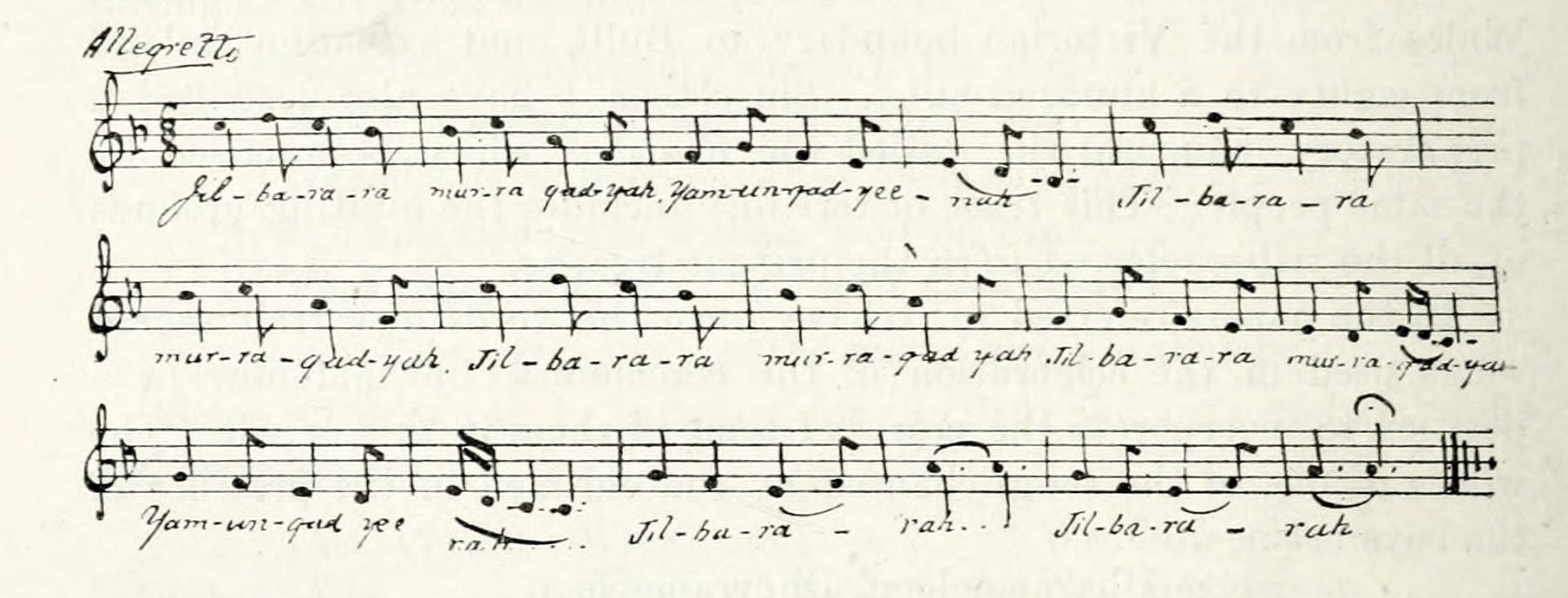
Mathews 1907, 34
https://archive.org/stream/notesonaborigine00math#page/34/mode/2up (DIGITISED)
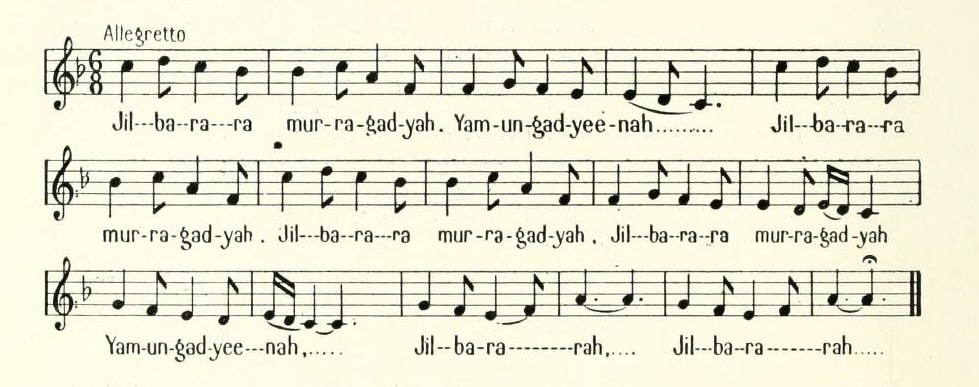
34.5 Ngulleejee
34.5 "Ngulleejee" [Bunân 5]
text: Ngul´leejee gâwinjee mullinda gunïlyee mong´gajee
gloss: "During the same period the mothers of the boys chant songs in the evening, of which the following is a specimen" (Mathews 1902, 62)
analytics: As for 34.1
Mathews 1902, 62
https://archive.org/stream/queenslandgeogra15roya#page/n391/mode/2up (DIGITISED)
During the same period the mothers of the boys chant songs in the evening, of which the following is a specimen:-
Ngul´leejee gâwinjee mullinda
Gunïlyee mong´gajee.
The music runs thus, repeated as long as required:-
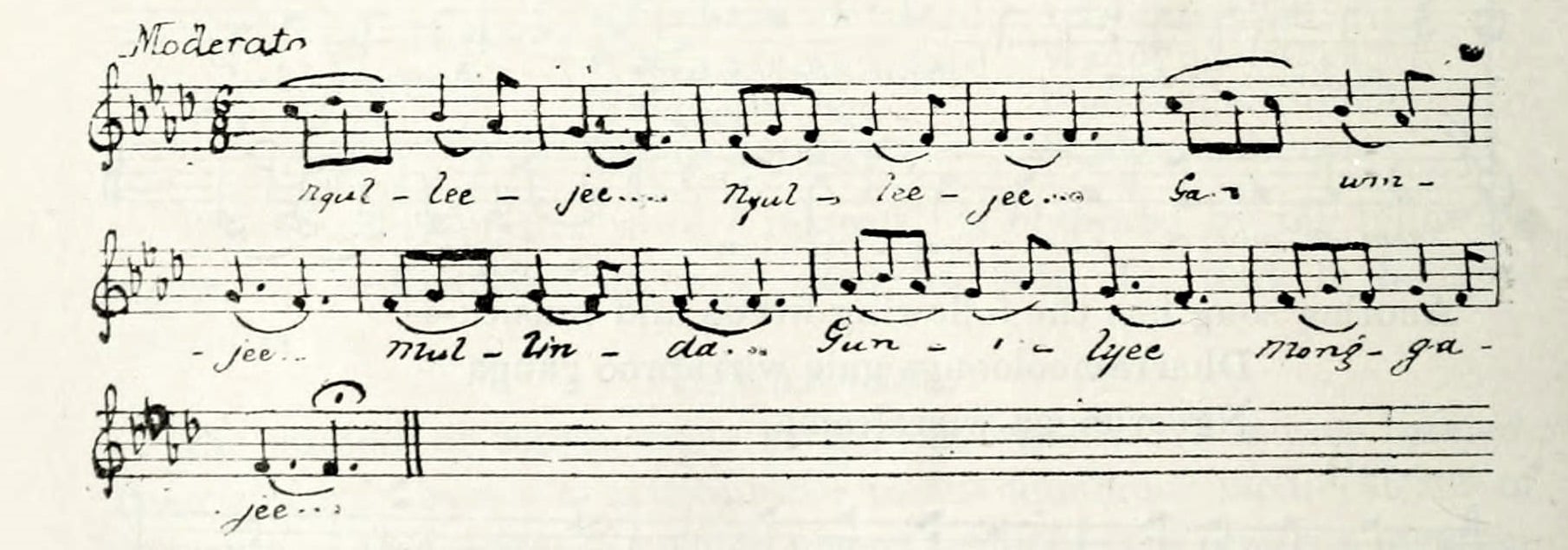
Mathews 1907, 34
https://archive.org/stream/notesonaborigine00math#page/34/mode/2up (DIGITISED)
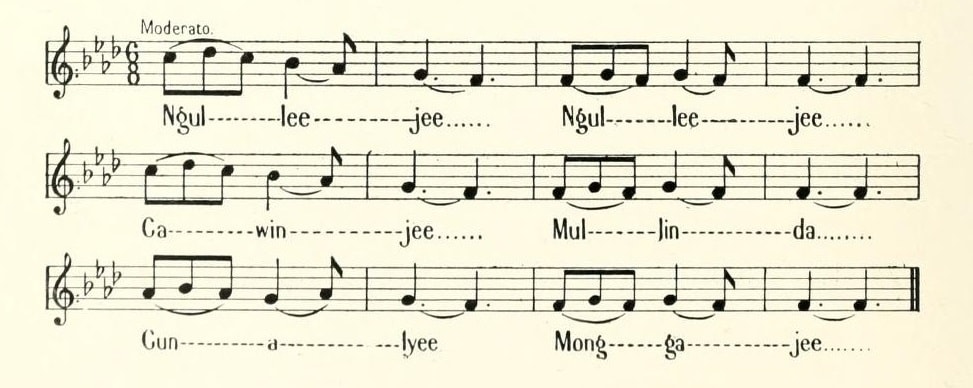
34.6 Millingalee
34.6 "Millingalee" [Bunân 6]
text: Millingalee kuberinya millingalee kuberinya bïnngandabee pambeeloonya mirrreewala pambeeloonya
gloss: "Another song sung by the boys' mothers" (Mathews 1902, 62)
analytics: As for 34.1
Mathews 1902, 62-63
https://archive.org/stream/queenslandgeogra15roya#page/n391/mode/2up (DIGITISED)
Another song sung by the boys' mothers, with the accompanying music, is as follows:-
Millingalee kuberinya, millingalee kuberinya
Bïnngandabee pambeeloonya
Mirrreewala pambeeloonya.

These are the first songs of the aborigines of this part of New South Wales which have ever been set to music. It may be mentioned that the words of these chants possess no meaning to the present natives, having been handed down from one generation to another. They were probably in the language of conquering tribes in the past. They are considered sacred, and are never used except at the initiation ceremonies, of which they constitute an important essential.
Mathews 1907, 35
https://archive.org/stream/notesonaborigine00math#page/35/mode/2up (DIGITISED)

Commentary as Mathews 1902 above, except for this new last sentence:
The words and the music of the foregoing six chants were taken down, after repeated trials, from the mouths of the native singers.
Bibliography:
Martin Thomas (ed.), Culture in translation: the anthropological legacy of R. H. Mathews (Aboriginal History Monograph 15) (Canberra: ANU Press, 2007)
http://press.anu.edu.au/?p=99461 (DIGITISED)
Martin Thomas, The many worlds of R. H. Mathews: in search of an Australian anthropologist (Sydney: Allen & Unwin, 2011)
Jutta Besold, Language recovery of the New South Wales south coast Aboriginal languages (Ph.D thesis, Australian National University, 2013)
http://hdl.handle.net/1885/10133 (DIGITISED)
Skinner and Wafer 2017
Commentary:
In 1900 Mathews first gave texts of 3 of "Dharamoolan's songs", his 1 corresponging to 34.2, 2 a possible variant of 34.1, and 3 closely similar to 34.3 (Mathews 1900, 279). In Mathews 1907, 63, he noted: "The words and the music of the foregoing six chants were taken down, after repeated trials, from the mouths of the native singers." His "Thurga and Jirringany notebook" (Canberra, NLA, MS 8006/3/5) lists the names of his Dhurga sources as Harry Walker, Annie Wood (Benson), Bill Chapman, James Walker, and Huggany (a Wandandian man); on page 153 of which he also transcribed three short lyrics headed "Annie's Songs" (Besold 2013, 19, 20).
c. 1900-04
35 3 songs
Dhurga ("Thoorga"), Ulladulla area, south coast NSW
Music and words transcribed by R. H. Mathews c. 1900-1904, first reported in paper read in Sydney, 5 October 1904, published 1904
https://sydney.edu.au/paradisec/australharmony/checklist-indigenous-music-1.php#035 (shareable link to this entry)
Sources:
R. H. Mathews, "Ethnological notes on the Aboriginal Tribes of New South Wales and Victoria", Journal and Proceedings of the Royal Society of New South Wales 38 (1904), 239-241
https://archive.org/stream/journalproceedi381904roya#page/240/mode/2up (DIGITISED)
The three transcriptions appear on page 240 (as pictured above), with commentary on 239-41
R. H. Mathews, Ethnological notes on the Aboriginal Tribes of New South Wales and Victoria (Sydney: Government Printer, 1905), 38
https://trove.nla.gov.au/work/26316209
Offprint/reprint of the above
35.1 Agh kunumbu
35.1 "Chant No. 1" ("dirge") [Pirrimbir 1]
text: Agh kunumbu kunumbu dyirri wanangunna Manganyingal wallagin ginahiya
gloss: The first of three songs that occur in the context of Mathews's discussion of the "Pirrimbir, or avenging expedition" in "Thoorga territory" (Mathews 1904, 240). This one is a "tribal dirge" sung by "two of the eldest men" (Mathews 1904, 239).
analytics: Ulladulla area, south coast NSW (region); ECA (music region); South-eastern PN/ Yuin/ Dhurga (language)
Mathews 1904, 239-40
https://archive.org/stream/journalproceedi381904roya#page/239/mode/2up (DIGITISED)
Pirrimbir, or Avenging Expedition.
Among the aborigines of the south-eastern districts of New South Wales, Pirrimbir is the name of a party organised for the purpose of revenge. As this custom has never been described, a short account of the manner of its execution is now given, prepared from details gathered by myself in the camps of the remnants of the native tribes.
When a man is killed by open violence by any of the people of a hostile tribe, the relatives and fellow-tribesmen of the deceased hold a council at the bambilli, at which all the old headmen and warriors assemble, painted with pipe-clay on the forehead, breast and shoulders. Two of the eldest men then sing one of their tribal dirges, the words and music of which are as shown in "Chant No. 1" hereunder:

Agh kunumbu kunumbu dyirri wanangunna
Manganyingal wallagin ginahiya.
When this song has been droned for some time, the warriors get small portions of hair which have been cut from the head of the deceased. Each man takes one of the fragments of hair and plaits opossum fur around it, making a small parcel about the thickness of a pencil, and a few inches in length, called 'muriir,' and puts it away in a little bag, called 'guraga,' which he uses for storing similar charms.
35.2 Yanawa berriga malah
35.2 "Chant No. 2" ("weeping song") [Pirrimbir 2]
text: Yanawa berriga malah . . .
gloss: The second of Mathews' "Pirrimbir" songs (see 35.1); "At the same time the women are also mustered in the camp . . . singing a 'nyūnggoan' or weeping song, of which 'Chant No. 2' . . . is an example" (Mathews 1904, 240).
analytics: As for 35.1
Mathews 1904, 240
https://archive.org/stream/journalproceedi381904roya#page/240/mode/2up (DIGITISED)

Yanawa berriga malah . . .
At the same time the women are also mustered in the camp, which is within sight of the bambilli, and sit down in a convenient place, singing a "nyunggoan" or weeping song, of which "Chant No. 2" above is an example.
35.3 Kunumbu kunumbu
35.3 "Chant No. 3" ("departure of the warriors") [Pirrimbir 3]
text: Kunumbu kunumbu ngodyiramba urarumba ngurgambawi
gloss: The third of Mathews' "Pirrimbir" songs (see 35.1), this one sung during the "departure of the warriors," who, while singing, "gesticulate with their weapons as if assaulting an enemy" (Mathews 1904, 241).
analytics: As for 35.1
Mathews 1904, 240-41
https://archive.org/stream/journalproceedi381904roya#page/240/mode/2up (DIGITISED)

Kunumbu kunumbu ngodyiramba urarumba ngungambawi.
After the above ceremonial has been gone through, the people patiently wait for a suitable opportunity to organize a party to punish the individual who has caused the death of their friend. Many months may pass over, or a year, or even a longer period, but the matter is not forgotten. When the time at length arrives, a party of warriors, accompanied by some old men, go away into the enemies' country. The chief features of the procedure in despatching such a hazardous expedition may be summarised as follows: -
The band of men who are to perform this important duty are selected from among the most active and fearless of the relatives and friends of the man whose death they are deputed to avenge. Some of them belong to the same totem as the deceased, and the totems of others are those with whom he could have intermarried. They are mustered on one side of the camp, accompanied by the men who are to lead them, and are decorated with red ochre and grease. The best spears and other weapons are chosen and well greased with human fat. They assume a crouching attitude, by bending their bodies at the haunches and knees, and form into single file. Each man produces one of the "mururs" already described, and holding it up in his hand, mutters yah ! yah ! They now march away in their bent position, in single file, till they get out of sight of the camp where the women are. They then straighten their bodies and walk on, every man joining in the song shown on the music-block as "Chant No. 3," which is repeated for a short time. While singing, they gesticulate with their weapons as if assaulting an enemy.
Bibliography (full details as for 34 above):
Thomas 2007
http://press.anu.edu.au/?p=99461 (DIGITISED)
Thomas 2011
Besold 2013
http://hdl.handle.net/1885/10133 (DIGITISED)
Skinner and Wafer 2017
Commentary:
On Mathews and his south coast sources, see commentary on the previous entry, 34.
© Graeme Skinner and Jim Wafer 2016 - 2026